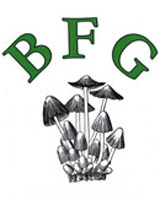T
|
|
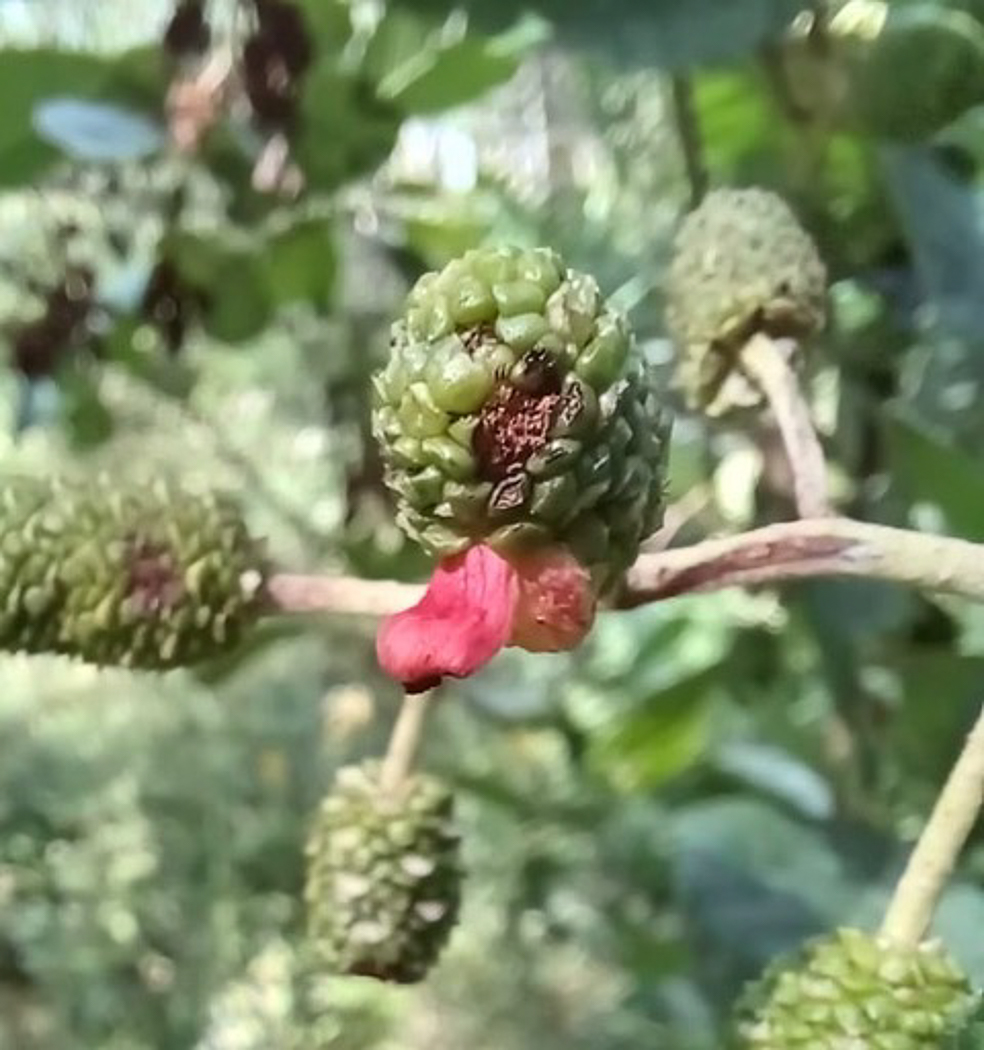
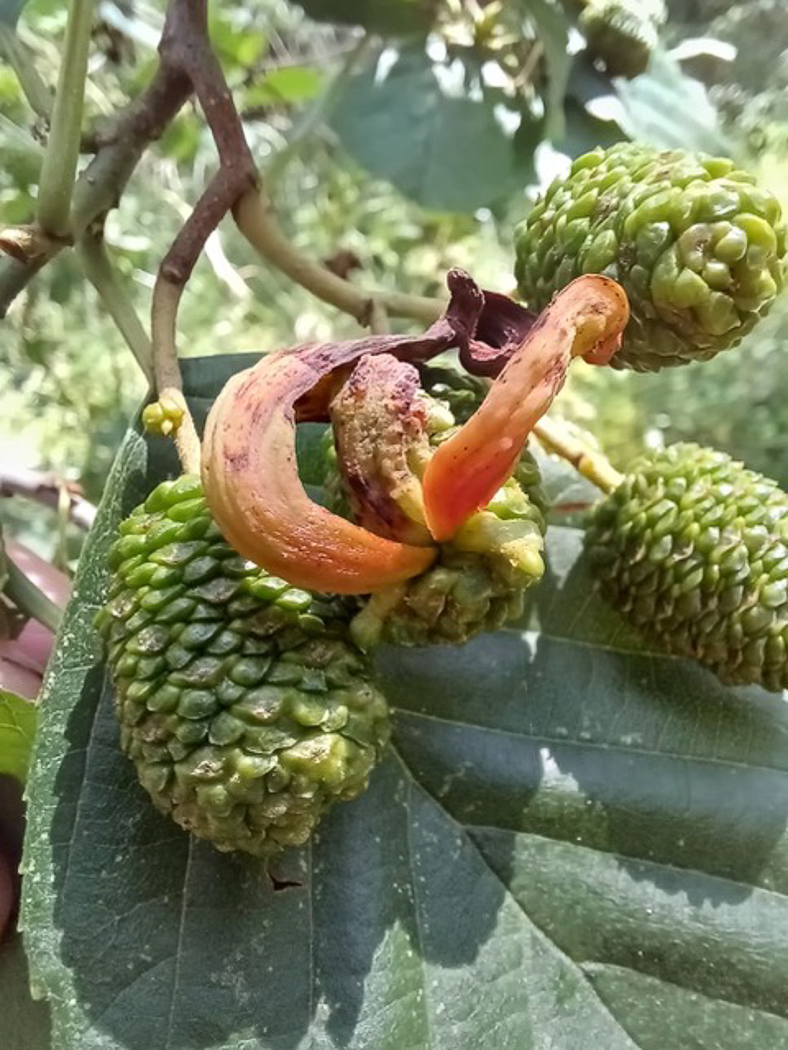
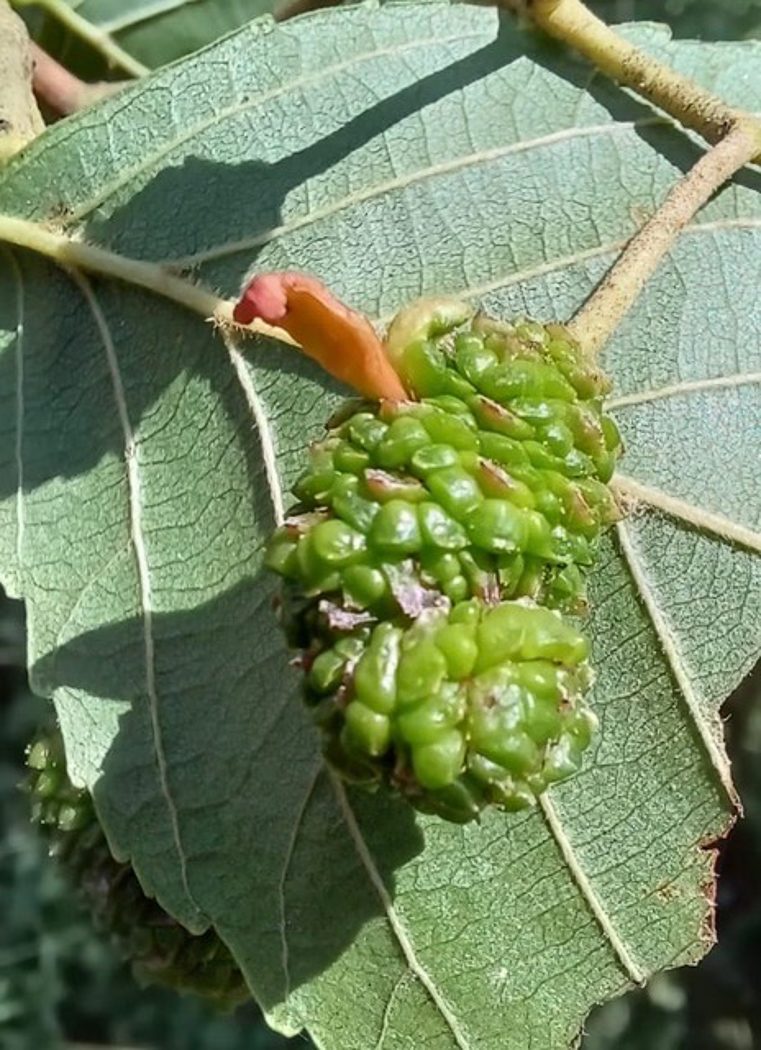 |
Taphrina alni (Alder Tongue)
Jul 19, 2024. On the dead (female) cones of an Italian Alder in Salden Wood Bob Simpson had noticed the 'tongues' of this unusual species emerging last year (and which are apparently still there). So he'd been keeping an eye out for their reappearance this year and noticed them a few days ago. The fungus is a pathogen which induces these long lasting galls on Alder, and what we see is apparently deformed plant material with the asci of the fungus contained within. Green at first, the tongues turn red as here (hence its English name) then yellowish and eventually black and gnarled. By no means rare, the species is apparently becoming much more common in the UK though this is a new record for the county.
|

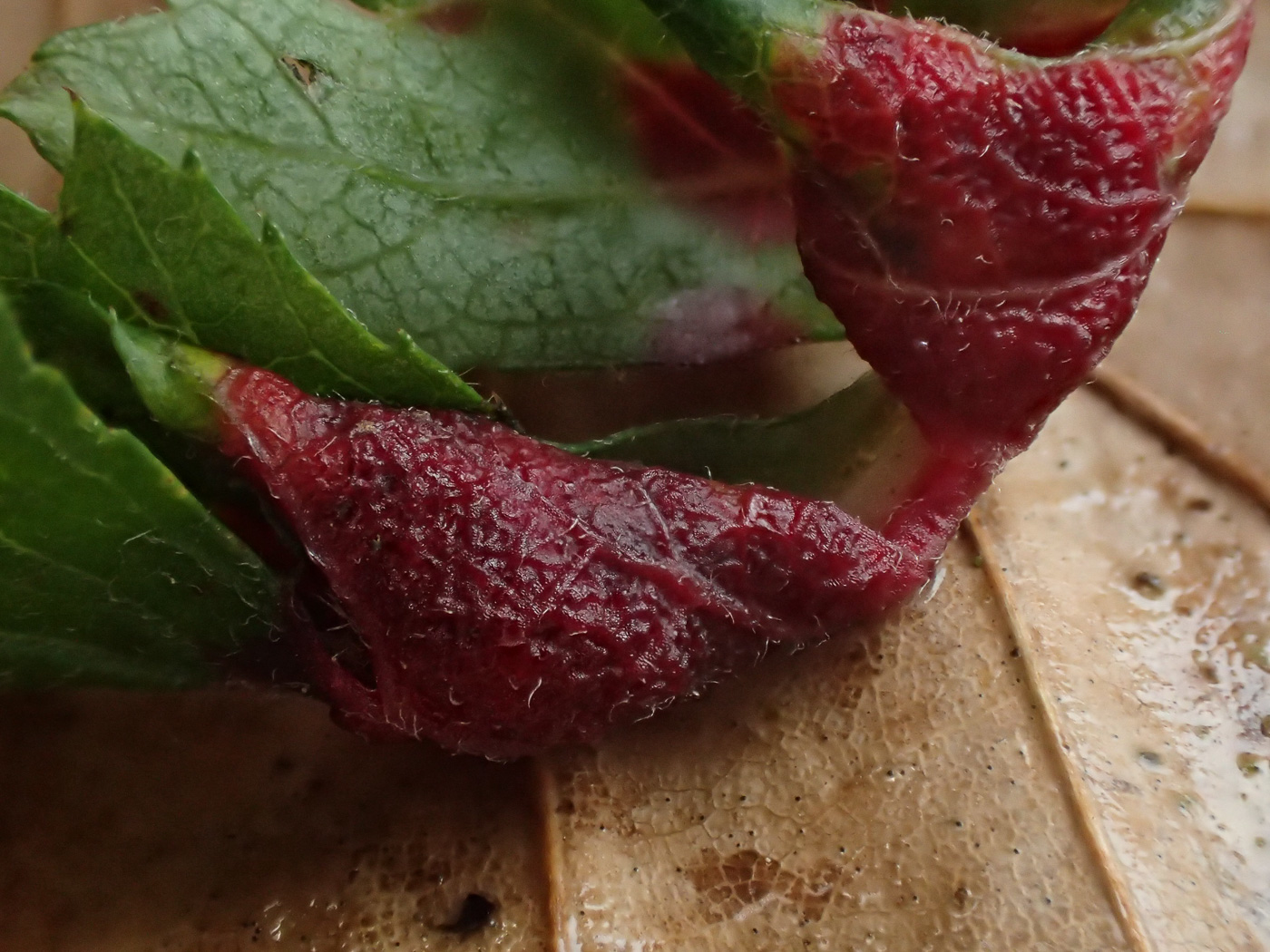
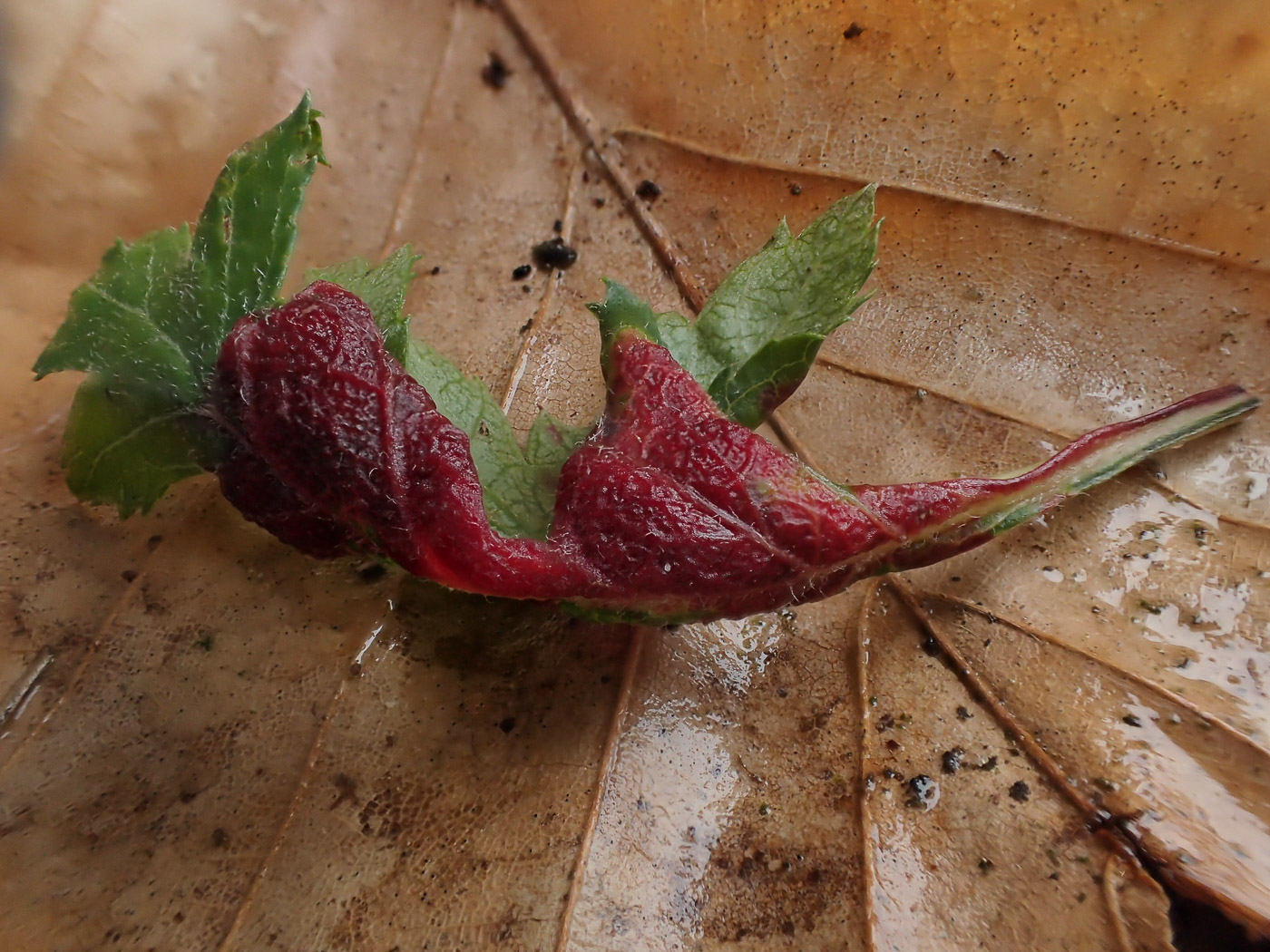 |
Taphrina crataegi (a species of Tongue with no common name) 
May 3, 2024. Sarah Ebdon has clearly got the bit between her teeth now she has a specialist book on Rusts and the like! Here's another one she's tracked down on Hawthorn leaves which causes these yellowish to purplish red gall blisters at this time of year. This is a new species for the county, no doubt one of many - not necessarily rare - which will now be found now we have someone out there looking for such species with dedication.
|

 |
Taphrina populina (Poplar Leaf Blister)
Jun 26, 2023. In Jordans Village, Jesper Launder noticed a few leaves on a sapling Black Poplar showing the telltale bright blisters of this species - not rare but with hardly any county records - none this century - no doubt due to the fact that few people look out for or would recognise such species at this time of year. This is therefore yet another new species for Finds.
|





 |
Taphrina pruni (Pocket Plum)
May 3, 2024. In a roadside verge near Hedgerley Jesper Launder spotted a Blackthorn bush with young sloes showing the typical elongated shape they develop when infected by this fungal pathogen (photo 1), and on closer inspection found an example of the further developed fungus (photo 2). Usually appearing in June, this species affects not only Blackthorn but can devastate Plum trees and is considered a difficult pest to get rid of - so not one you want to find in your garden if you have a plum tree!
Jun 8, 2023. In Salden Wood Bob Simpson found what he at first thought were some insect galls forming on Blackthorn, but on checking in his gall book he realised that this was in fact not a gall but an Ascomycete which quite commonly affects various Prunus species, destroying the stone within the immature sloe thus leaving a hollow (seen in photo 3). The spores then infect the stem ready for next year's fruit. It is found in Spring to Summer and we have just one previous county record dating back to 1998. Photo 4 showing a slightly later stage of development was sent in by Sarah Ebdon two weeks later who reported the whole Blackthorn bush to be covered in infected berries. This is a new entry for Finds.
|
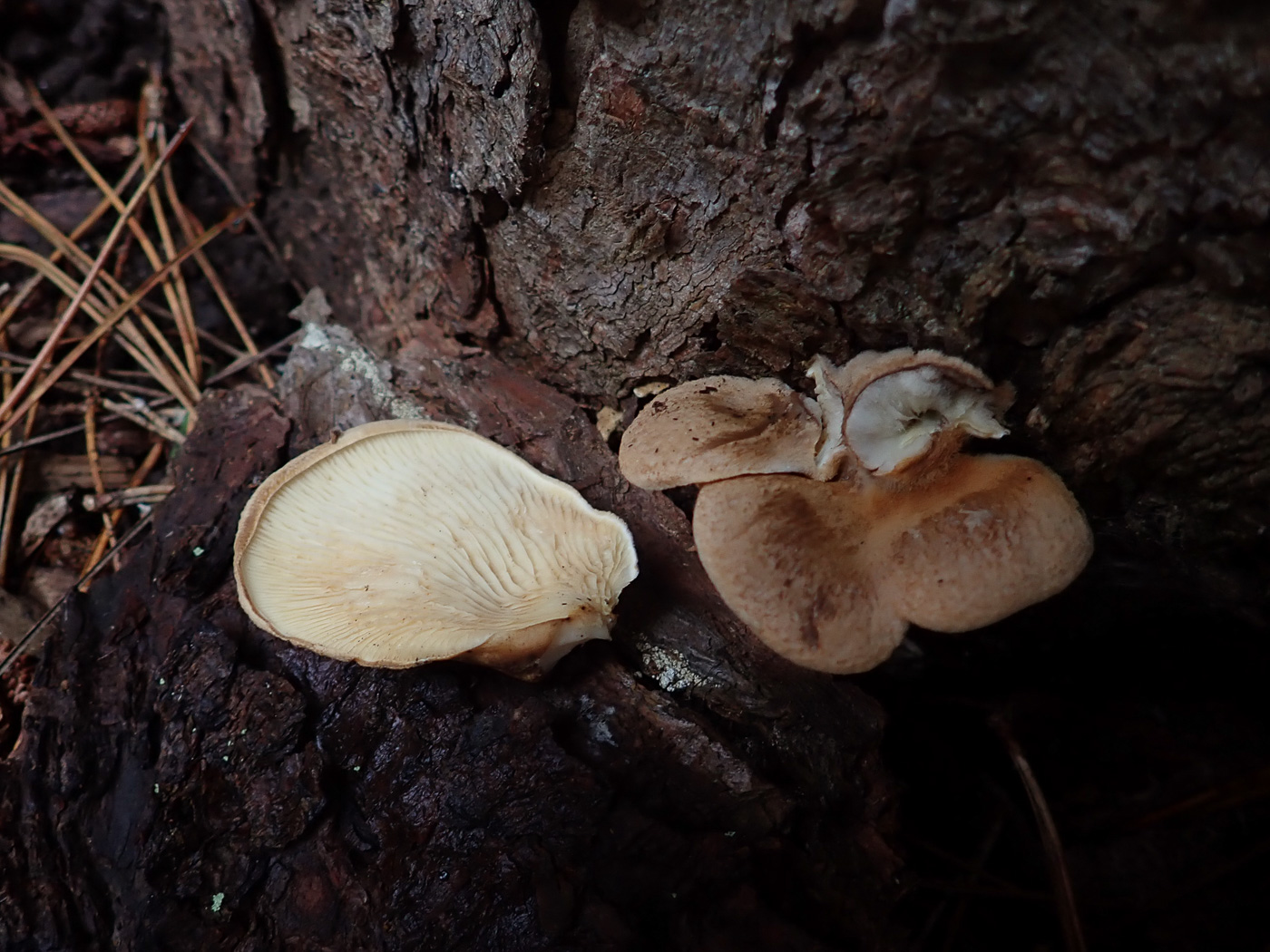
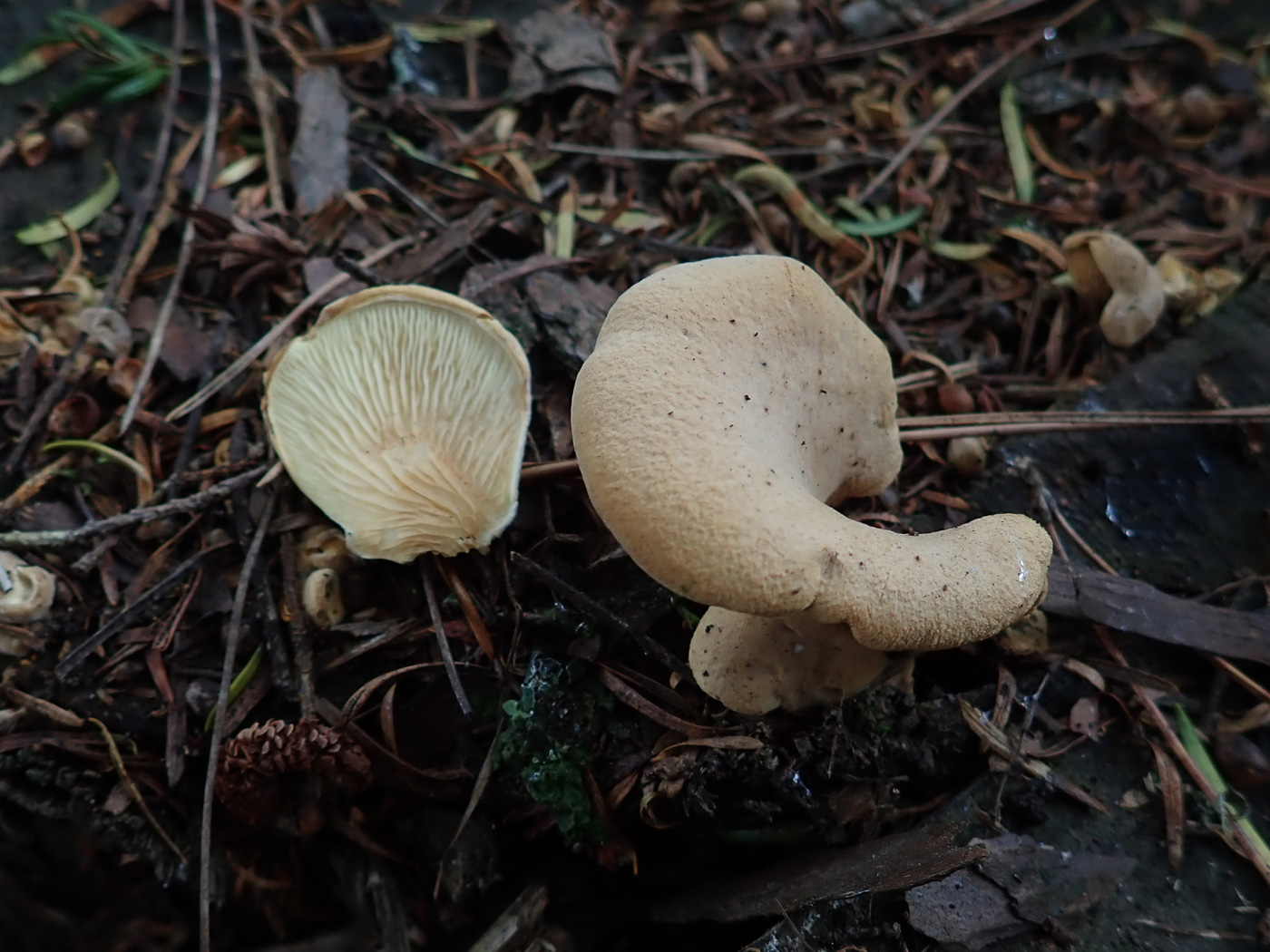
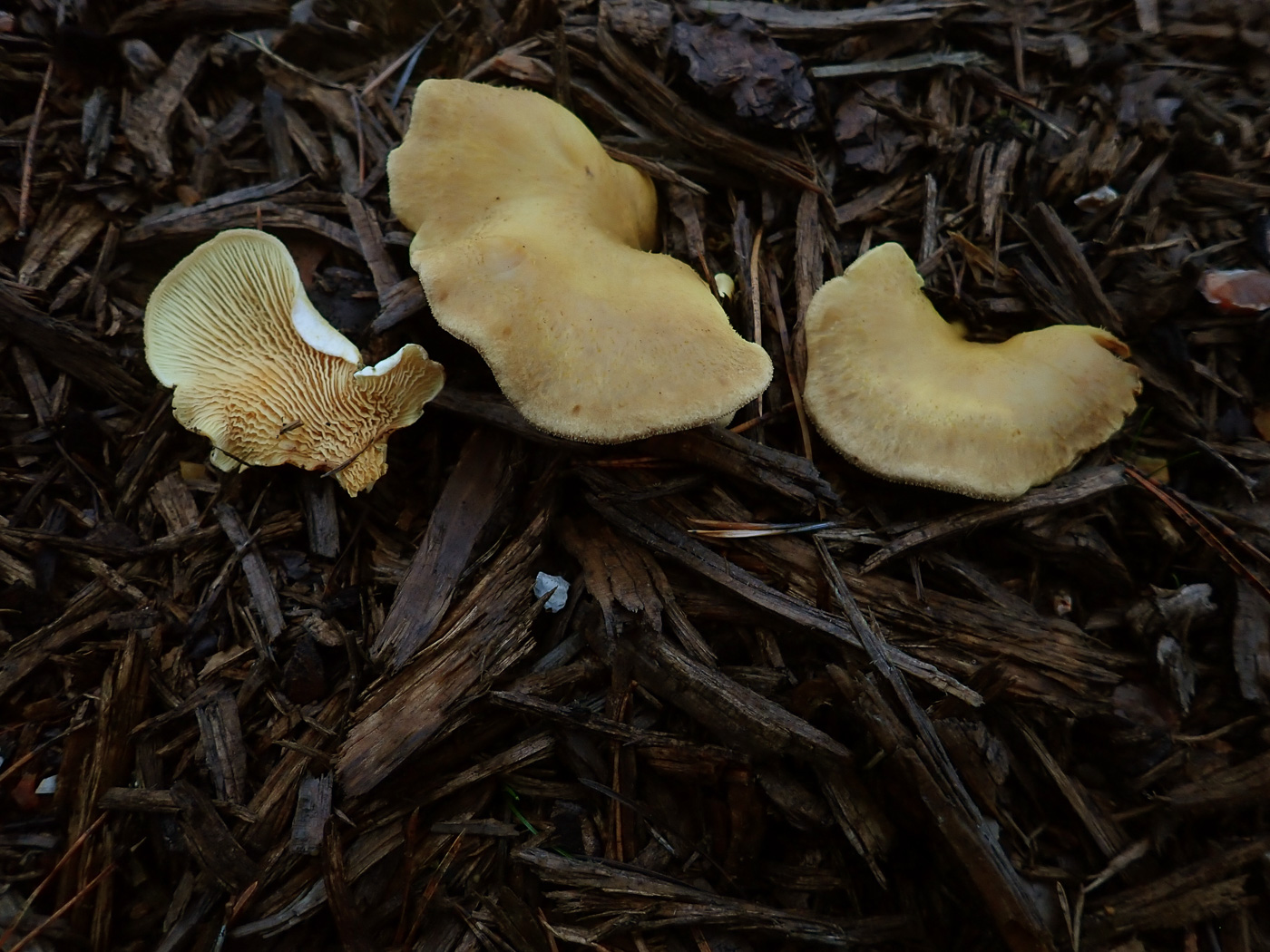
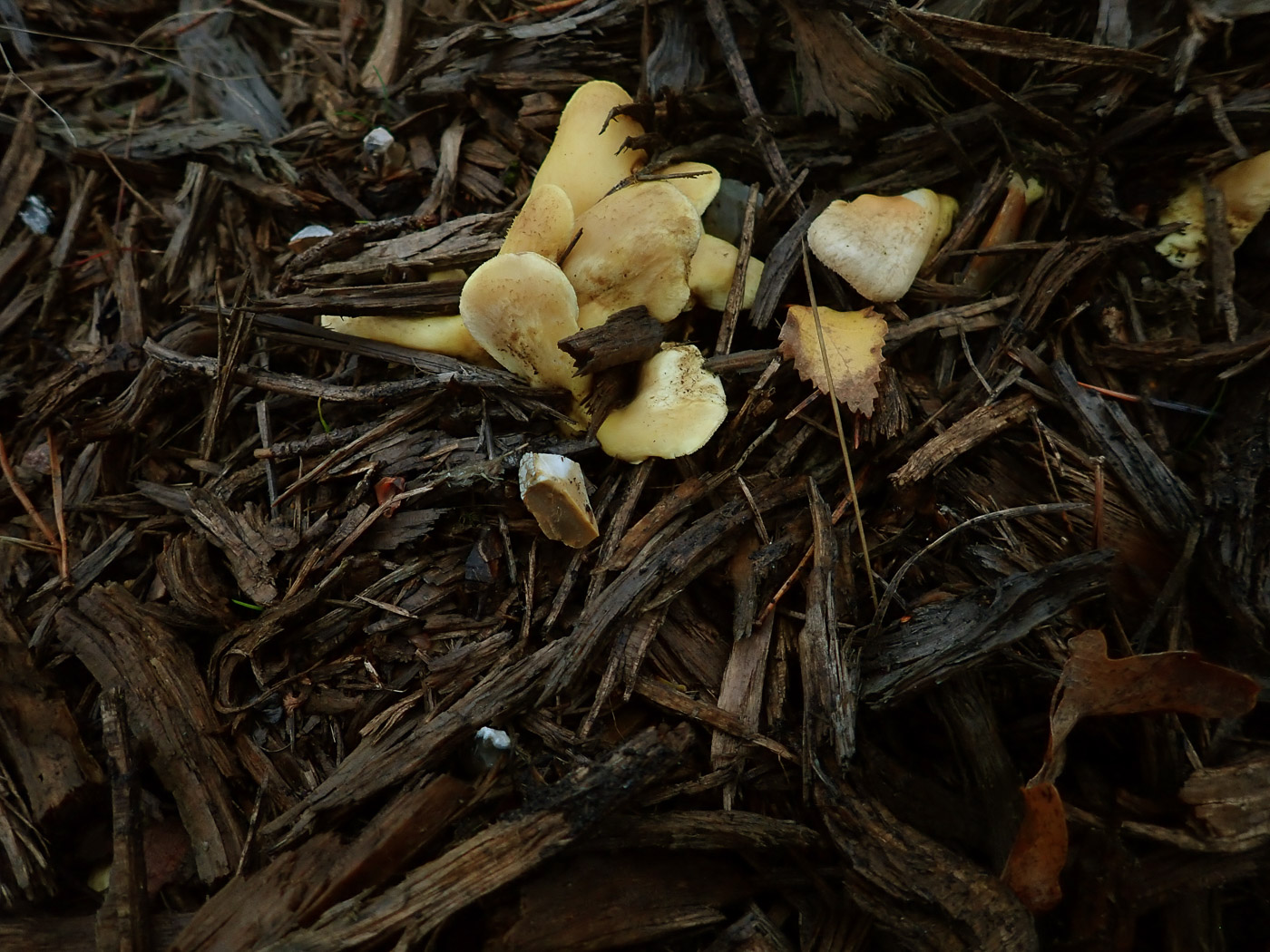

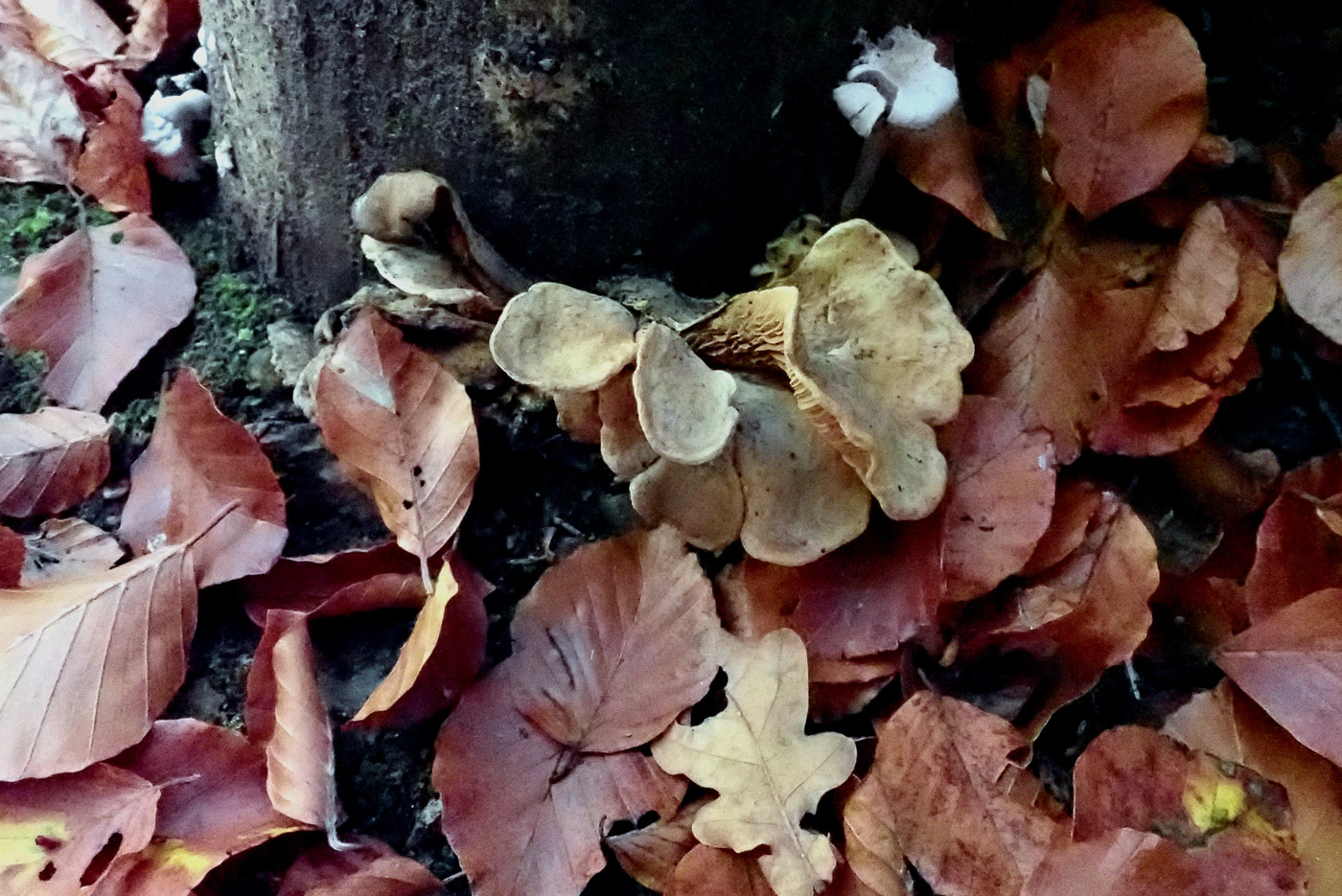
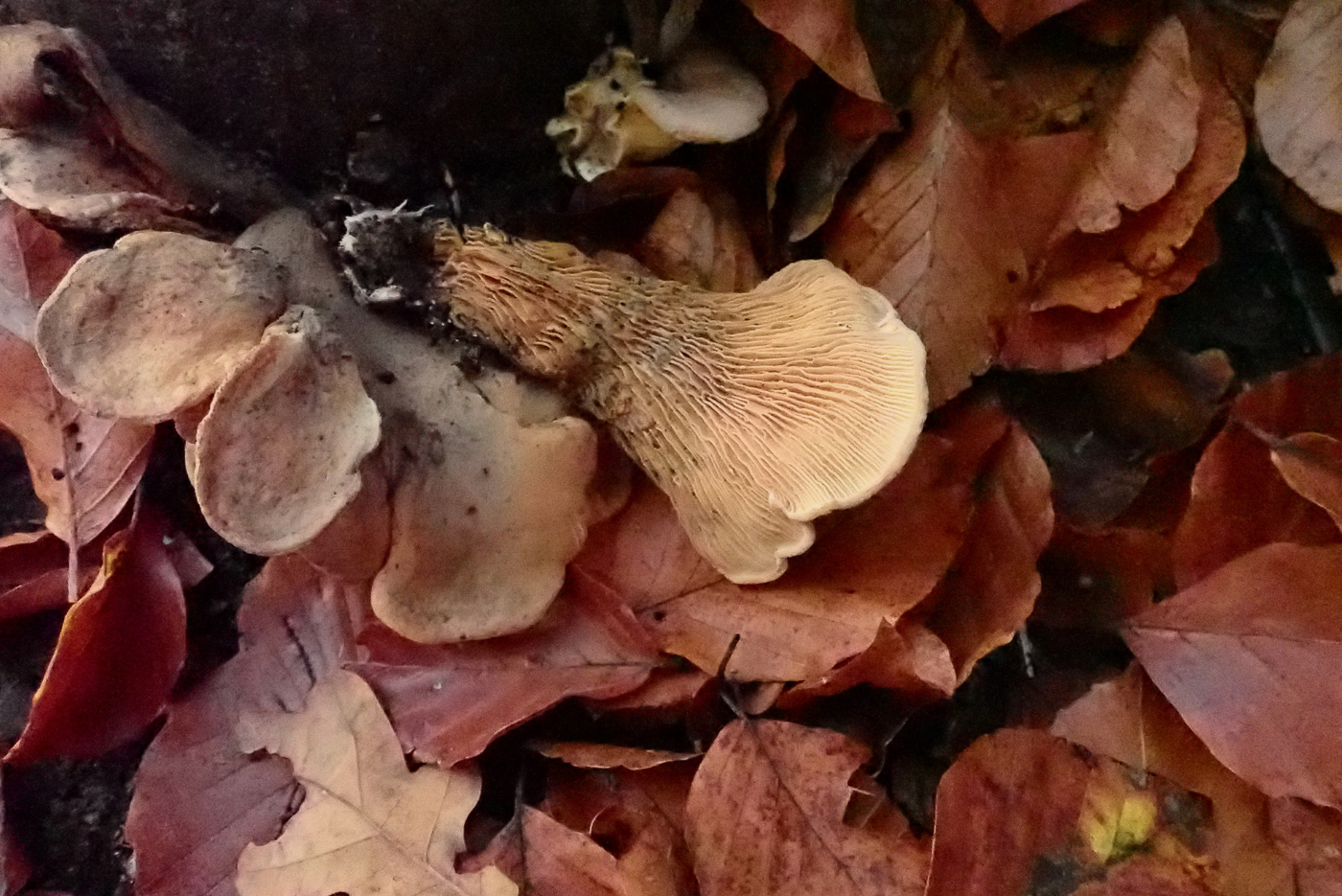
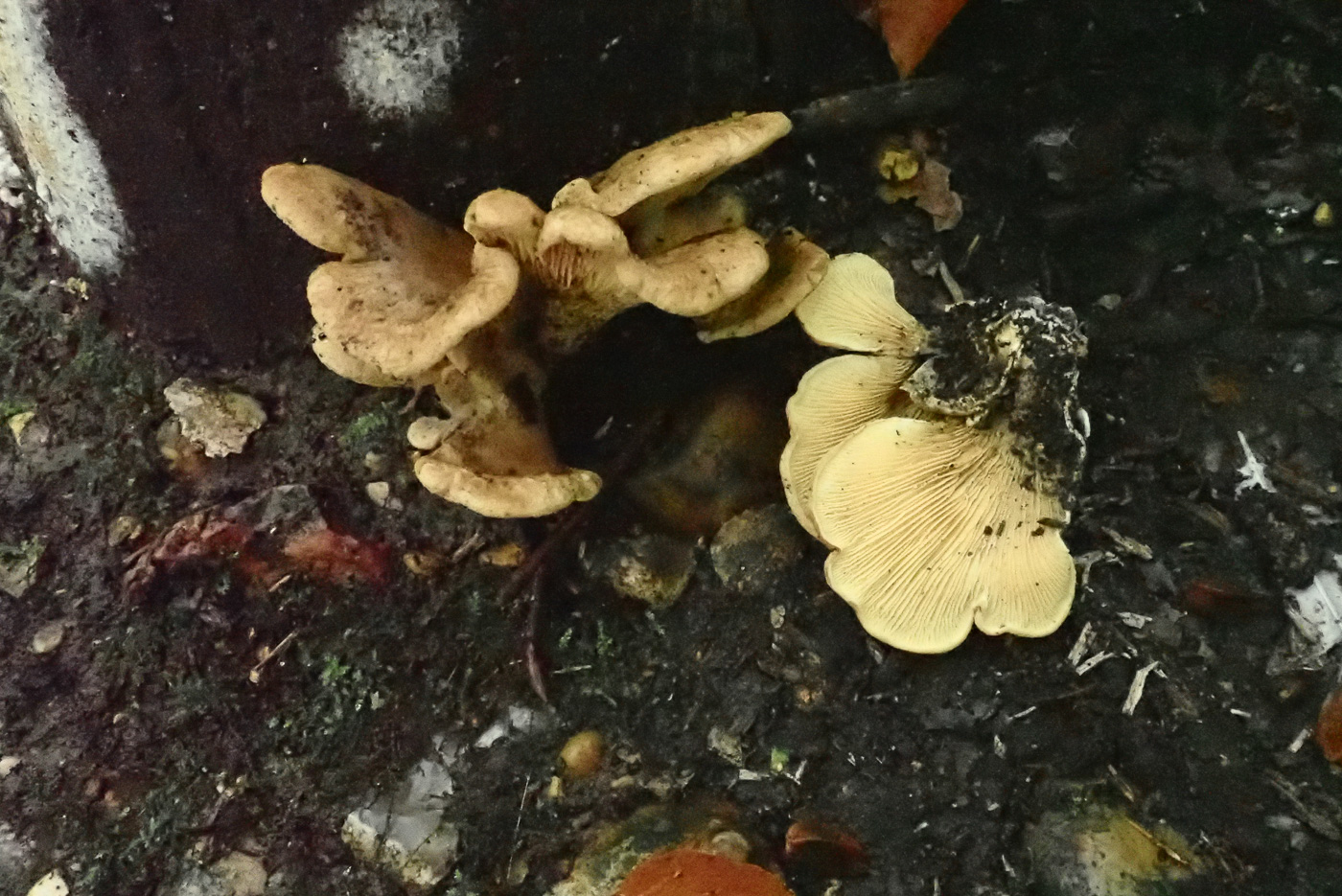
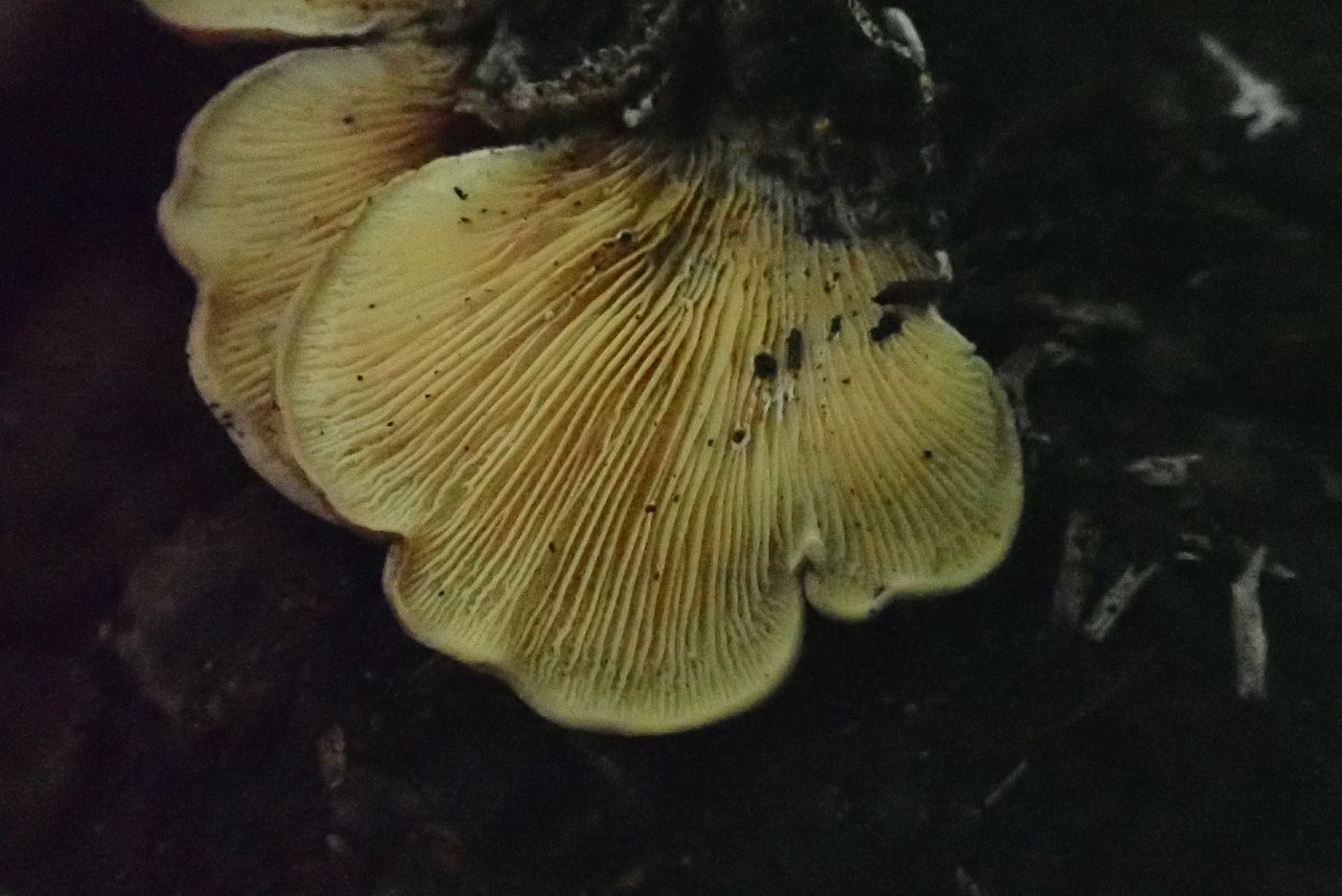 |
Tapinella panuoides (Oyster Rollrim) 
Nov 7, 2024. On some sawn off conifer stumps in Stoke Poges Memorial Gardens Penny spotted several small clusters of this quite unusual species, thought to be related to Paxillus (Rollrim) though in appearance rather similar to Pleurotus (Oyster) - hence its English name. It has a cap and gills with an orange peachy tinge and lacks a stem and favours fallen conifer wood.
Nov 29, 2022. At Stoke Common in a disturbed area with a lot of shredded Pine debris Penny noticed this cluster of ochre caps which looked unusual. Turning one over the lack of any stem and 'Pleurotoid' shape (like an Oyster Mushroom) then rang a bell and the ochre gills which are crowded, forking and also somewhat wavy all fitted with this quite unusual species. We have a handful of previous county sites for the species with one record from here in 2010.
Nov 17, 2021. In Pullingshill Wood Penny checked a stump near the parking spot where back in October she'd found this unusual species, and found it was still fruiting there though was now much more mature. (See also notes and photos dated Oct 15th). The common name is a good one, the species being closely related to Paxillus involutus (Brown Rollrim) but shaped like a Pleurotus (Oyster Mushroom).
Oct 15, 2021. At the base of an unidentifed stump in Pullingshill Wood Penny noticed this small tier of rusty ochre mushrooms and turning one over found orange crowded gills and no stem, so like an Oyster Mushroom but clearly the wrong colour. Not recognising it, she took a piece home and discovered its identity, it having a feature in common with the closely related Paxillus involutus (Brown Rollrim): the gills peel away from the cap flesh remarkably easily. This is not a common species and we have just two authenticated previous county records.
|
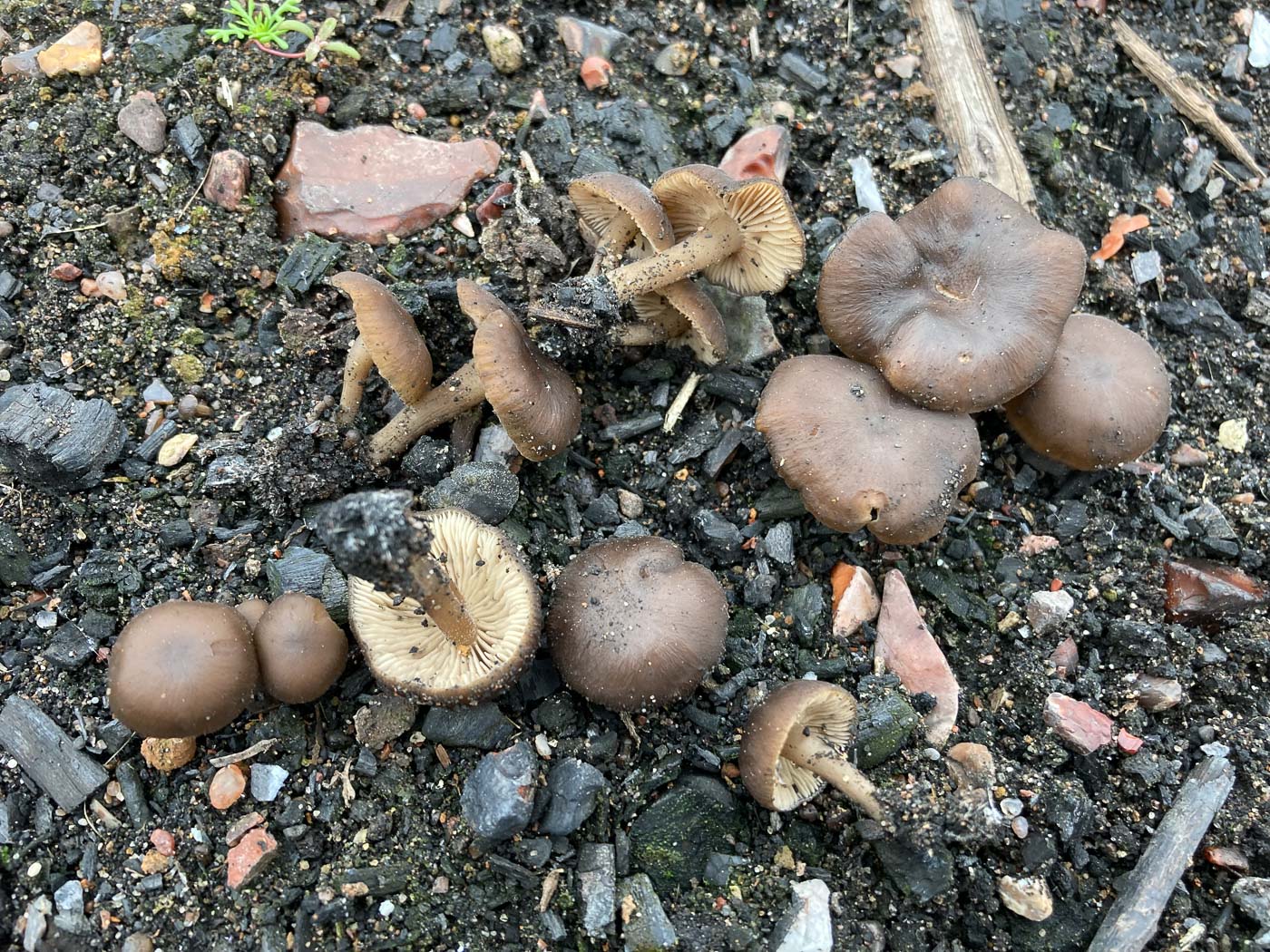
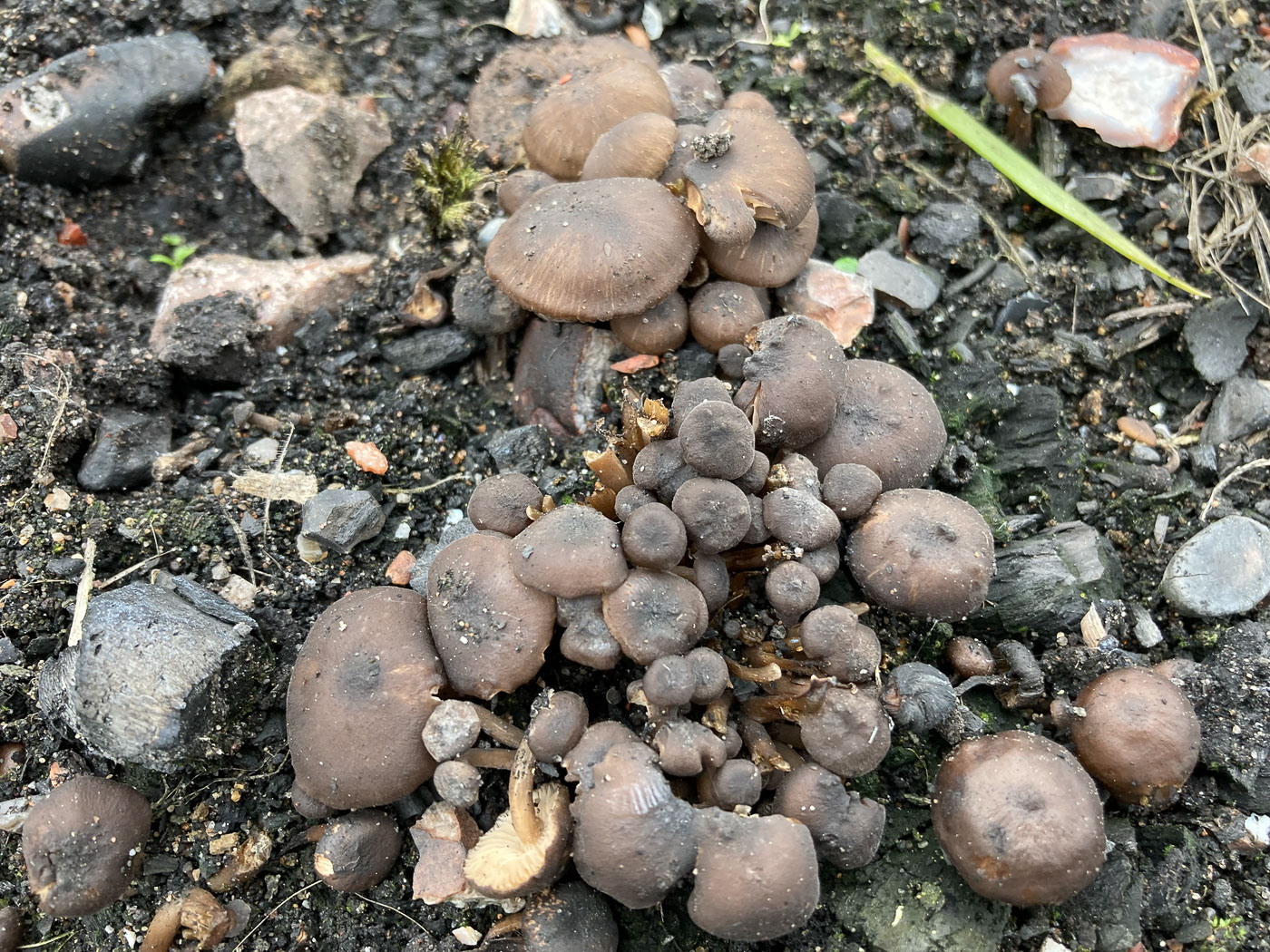 |
Tephrocybe ambusta (a Domecap with no common name) 
Nov 19, 2021. In Dorney Wetlands Russell Ness checked a large bonfire site in the hope of interesting fungi and was rewarded! Previously in the genus Lyophyllum, this is quite an unusual find - the rarer of two very similar species of burnt ground now in Tephrocybe, the other being T. anthracophila, there being quite a subtle difference in spore ornamentation between them and carefully observed here by Russell. We have just one previous county record for T. ambusta. Burnt ground is always worth a quick inspection and can be very productive for fungi, producing species not found in other habitats as well as some like Laccaria laccata which pop up anywhere.
|
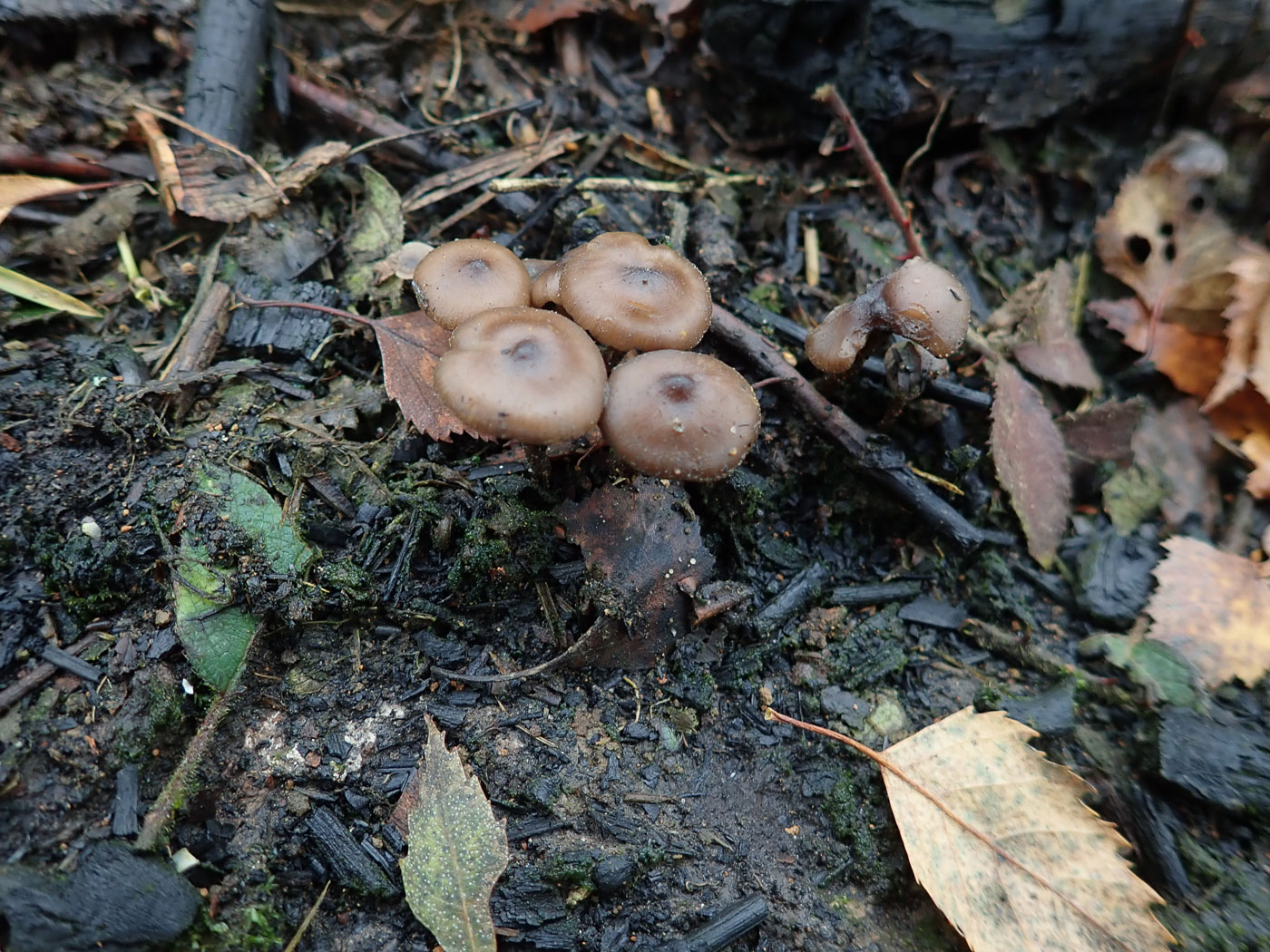
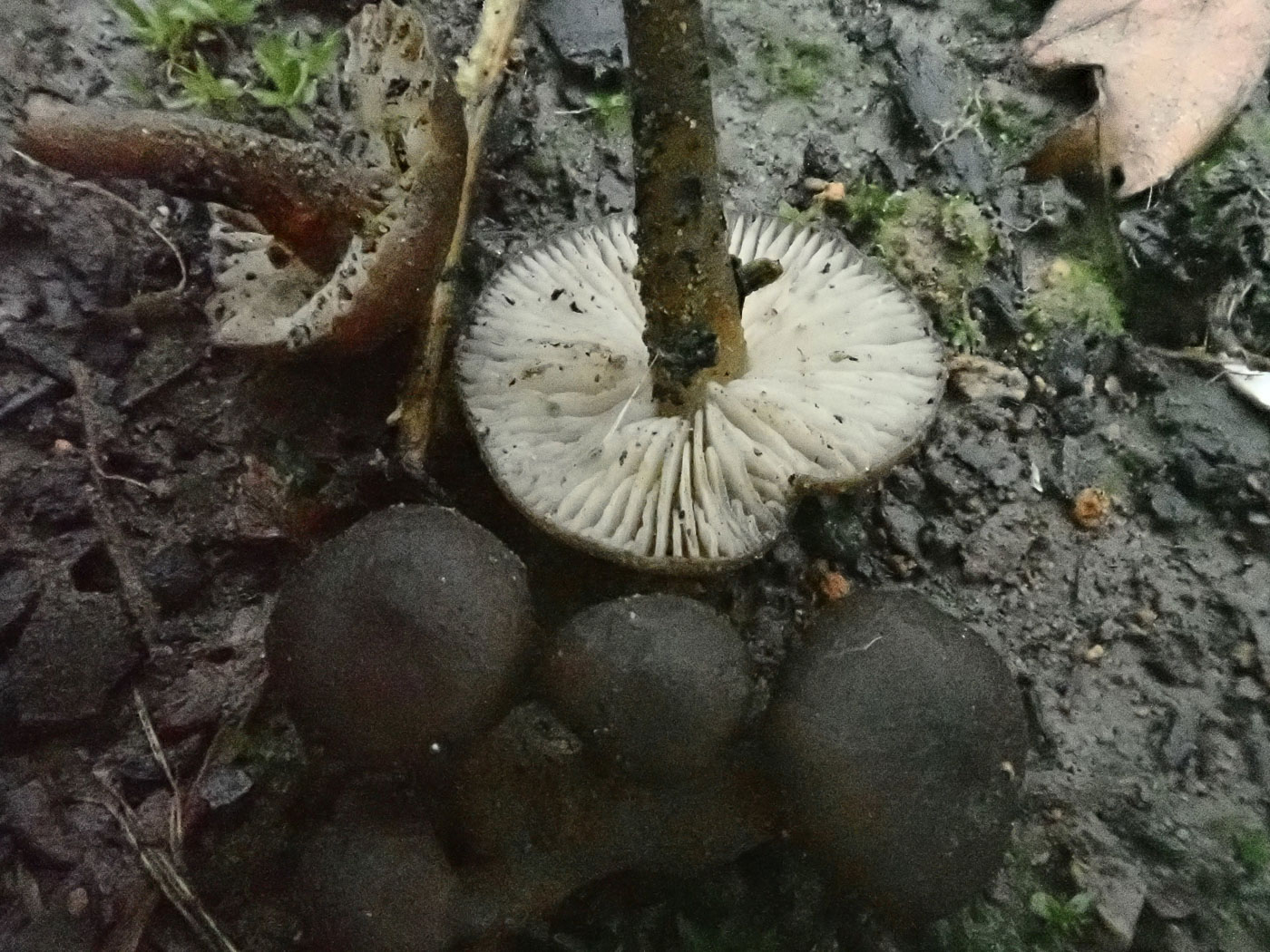 |
Tephrocybe atrata (a Greyling with no common name) 
Nov 27, 2022. Noticing a patch of burnt ground at Turville Heath Penny had a good search for anything coming up there and was rewarded! There was a small cluster of rather dark inconspicuous LBJs which she realised would probably be interesting. A scope revealed small ellipsoid smooth spores which separated it from the several other Greylings found on old bonfire sites which have either round or ornamented spores. We have just 4 previous county records though the species is not rare, and this is a new species for Finds.
|

 |
Tephrocybe ellisii (a Greyling with no common name) 
Oct 22, 2023. When Russell Ness found these in Burnham Beeches he was at a loss to place them in a genus though they looks not unalike a small Entoloma (Pinkgill). The white sporeprint the next day eliminated that genus and he eventually arrived at this species by flipping through Kibby vol 2, then checked the details which all fitted fine. Members of this genus (though soon possibly to move to Lyophyllum) are often rather nondescript LBJs with a distinct likeness to Entoloma but have few useful microscopic features beside their spores which are neither the shape nor colour of that genus. This particular species is rarely recorded with a limited number of national records and just one from Bucks from Bradenham Woods back in 2000. So another new Finds entry.
|
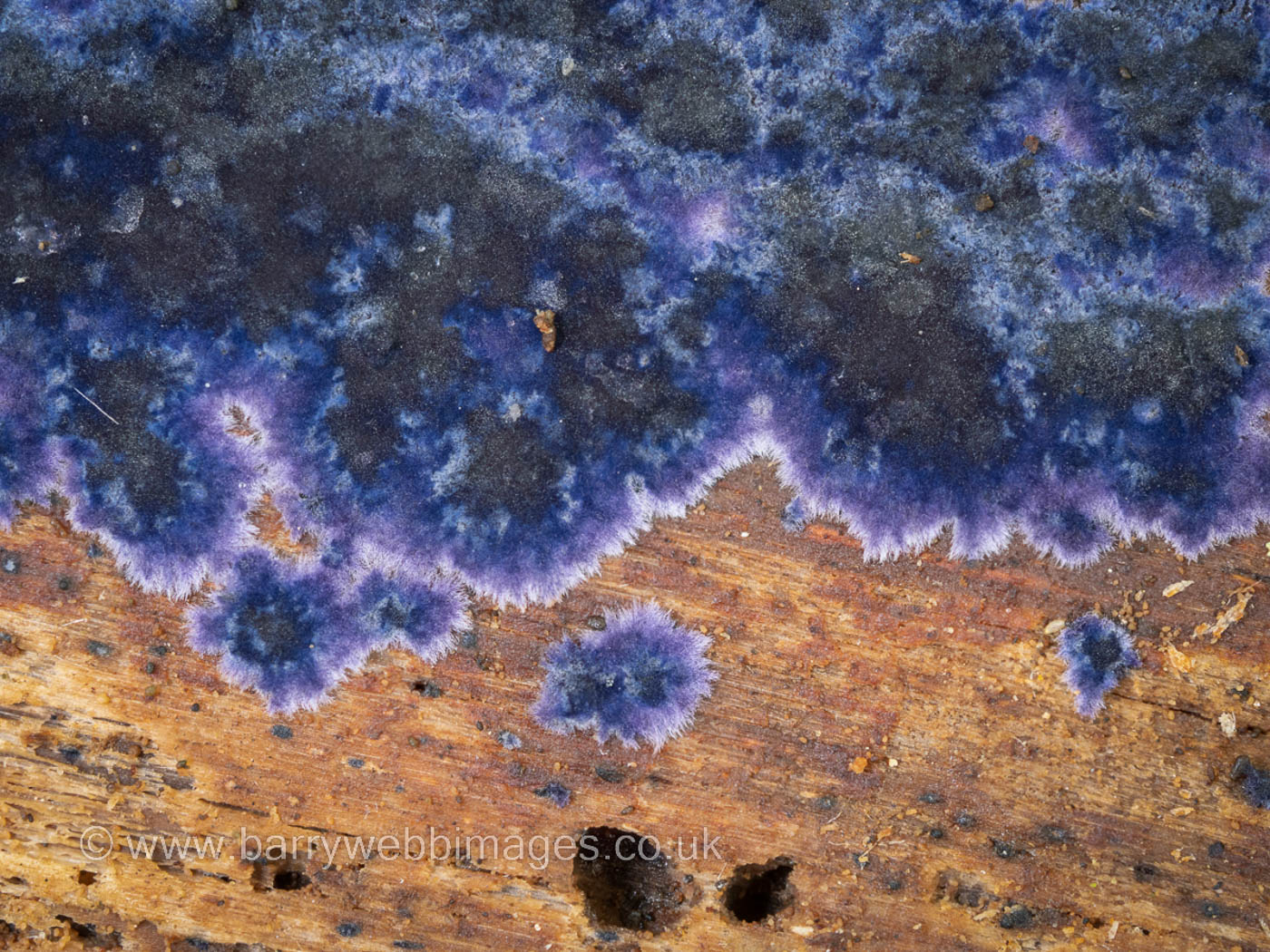
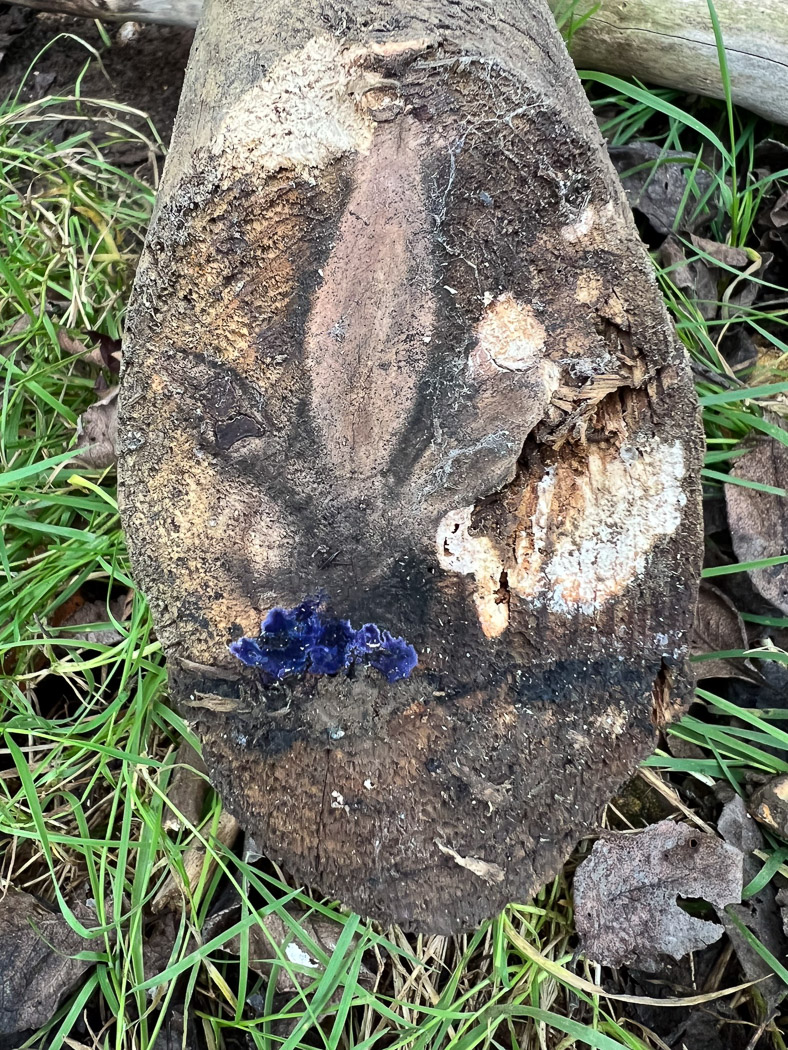
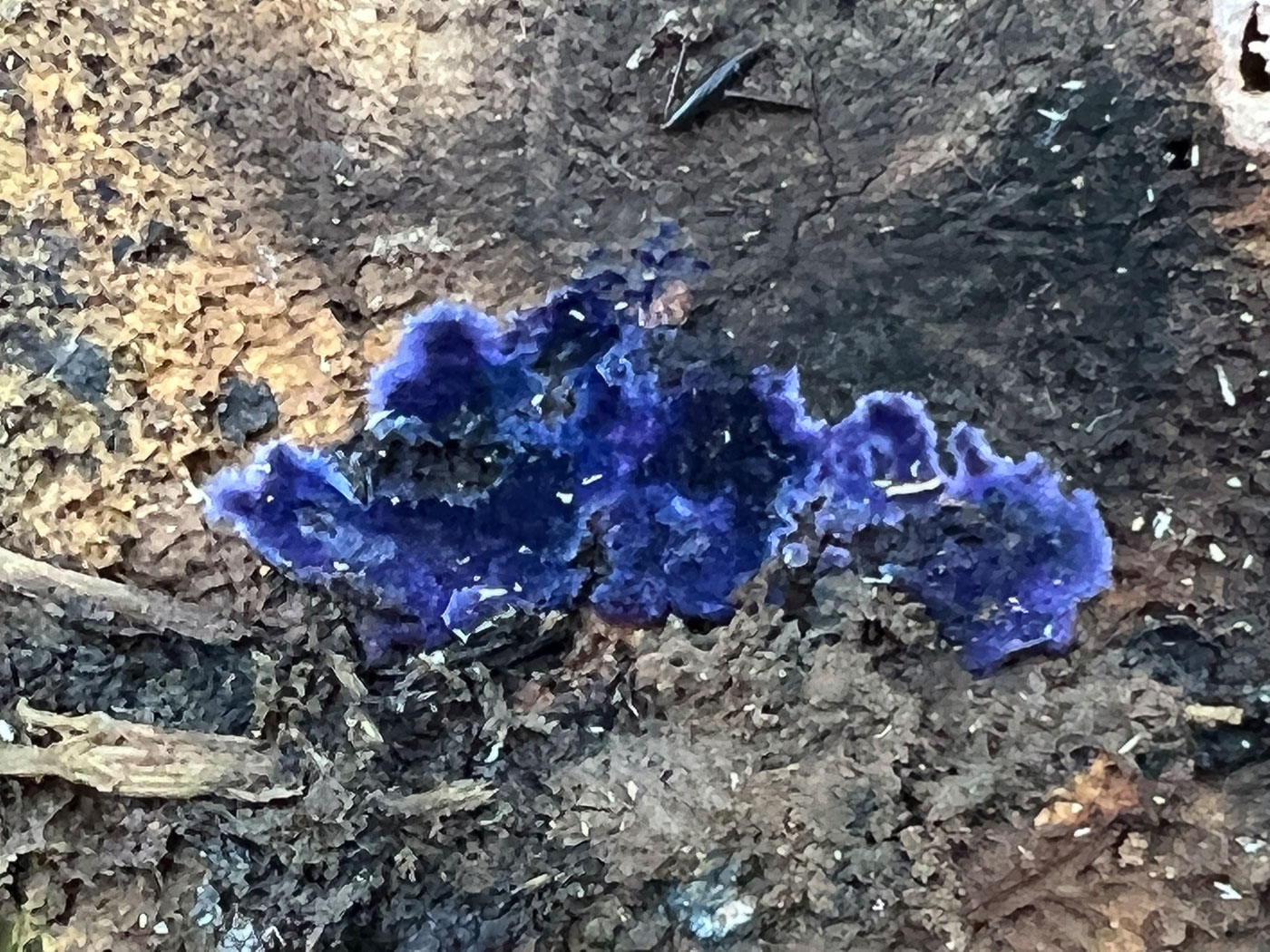
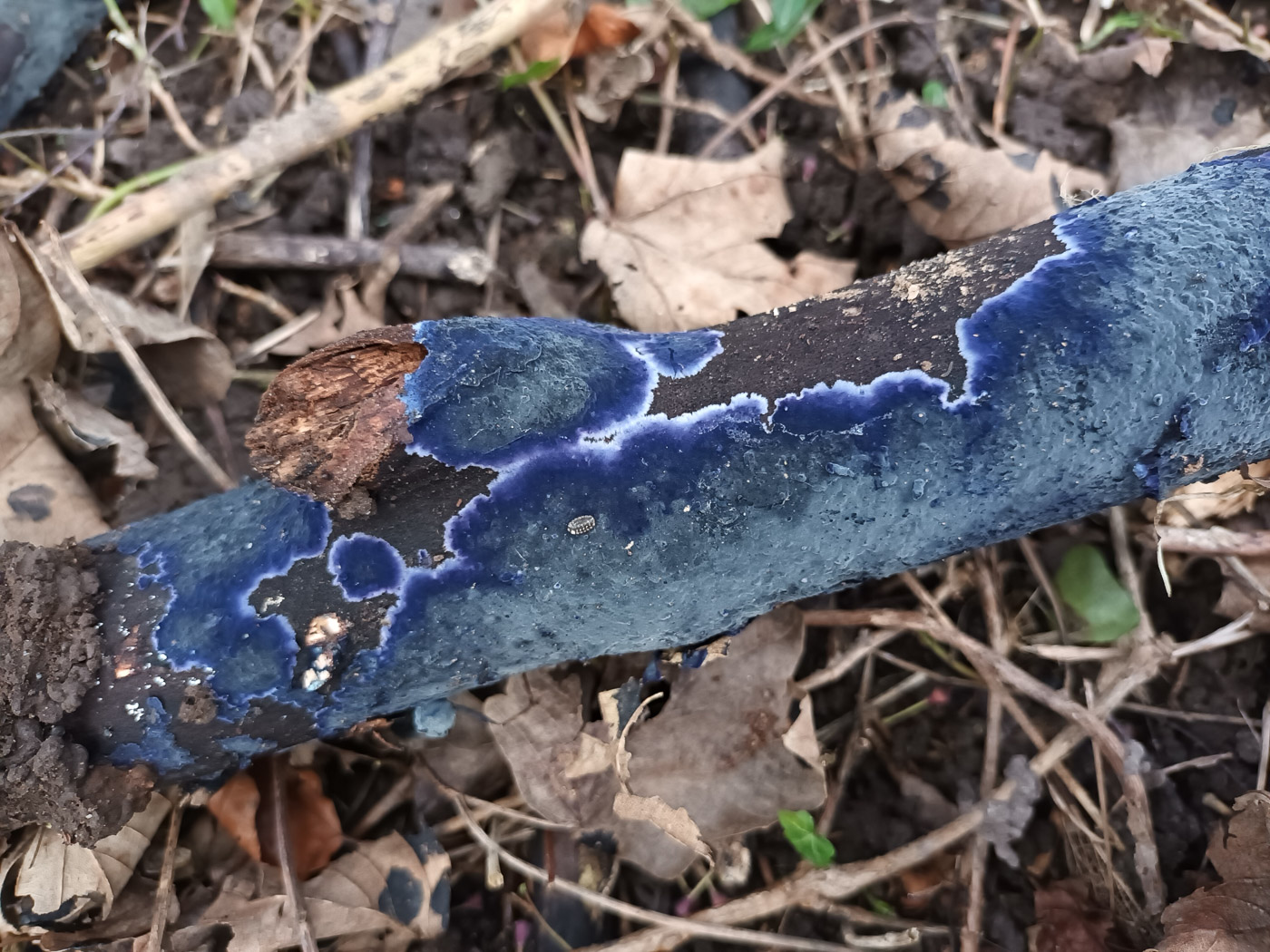 |
Terana caerulea (Cobalt Crust)
Nov 10, 2022. As we entered Round Spring Wood, Dancersend, one of the first things found was this beautiful and striking corticioid species with its unique deep blue colour. It occurs of various different deciduous woods, here probably on Beech, and is considered quite rare. We have a handful of sites where it has been recorded previously, Dancersend being one of them, but it is always a treat to see. For several today it was their first experience of it. The close-up photo today is Barry Webb's.
Jan 28, 2022. Whilst on his allotment in Walters Ash Neil Fletcher spotted a patch of bright blue on an old post in a pile of rotting wood. He soon realised this was not paint, as he wondered at first glance, but this rare but unmistakeable corticioid fungus for which we have just a handful of county records, mostly under the older name Pulcherricium caeruleum, and with just two in the last five years. This amazing colour is unique amongst resupinate species, and the whitish edge seen here is also typical. The fungus occurs on decaying deciduous wood and gradually spreads out, becoming flat and adhering tightly to the substrate. As so often happens, Jesper Launder then sent Penny his stunning photo (photo 3) taken the next day of the same species found on fallen Sycamore near Jordans Village.
|


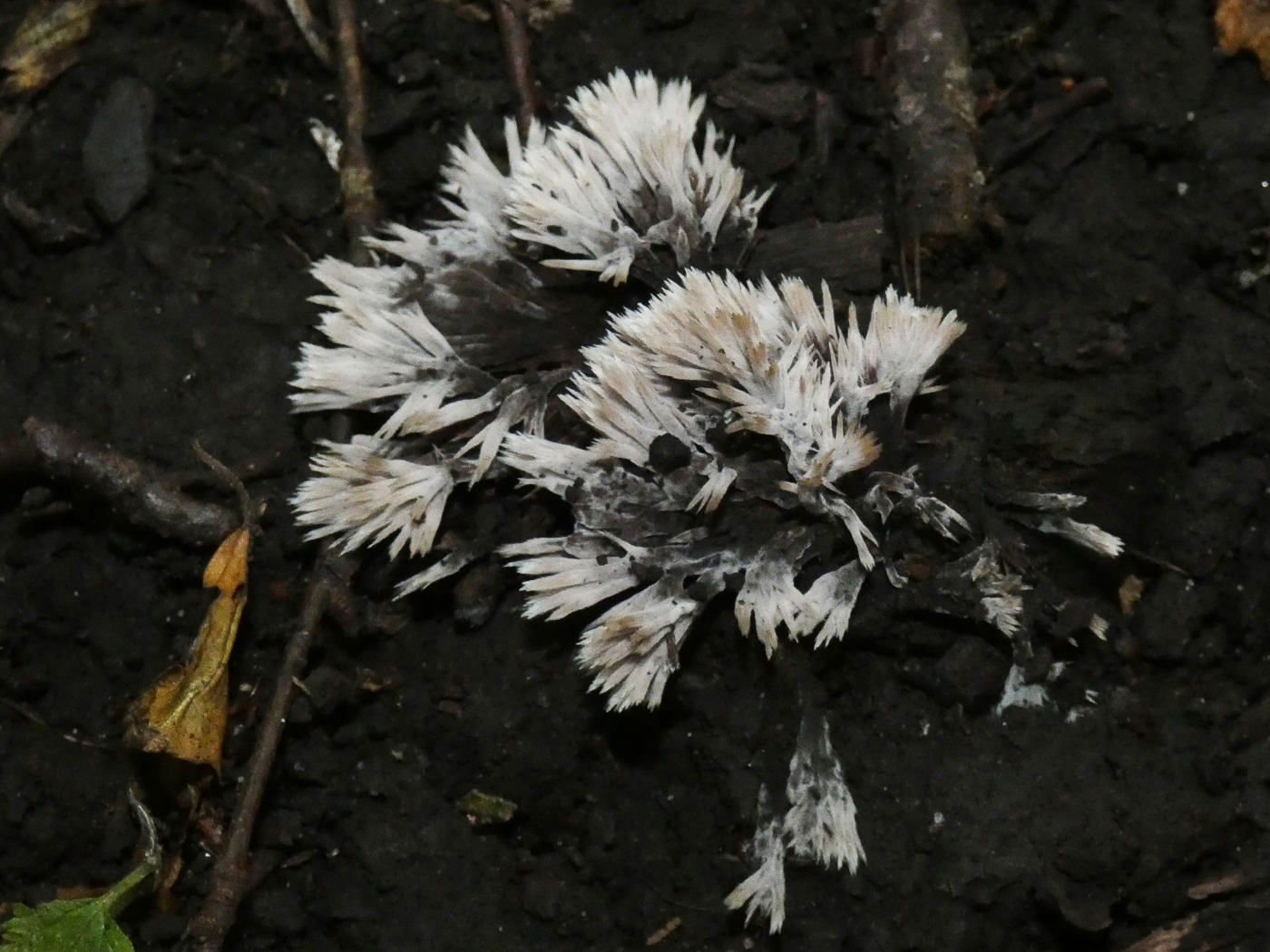 |
Thelephora penicillata (Urchin Earthfan)
Aug 4, 2023. In Hodgemoor Woods in mossy soil amongst deciduous litter Penny spotted two clumps of this uncommon and unusual looking species. Like a stubby coral fungus - though not related - it has soft feathery tufts, white at first then becoming dark grey at their base. We have a just handful of sites where it's been found previously, this being one of them.
Aug 3, 2021. A member of the public found several clumps of this unusual fungus in Howe Park Wood, Milton Keynes. It was then identified online before being sent to BFG for confirmation and recording. We have a handful of records but all from the south of the county, so this was a nice find. It can occur in deciduous woodland and typically forms flattened clusters having white frilly tips which darken towards the base.
|

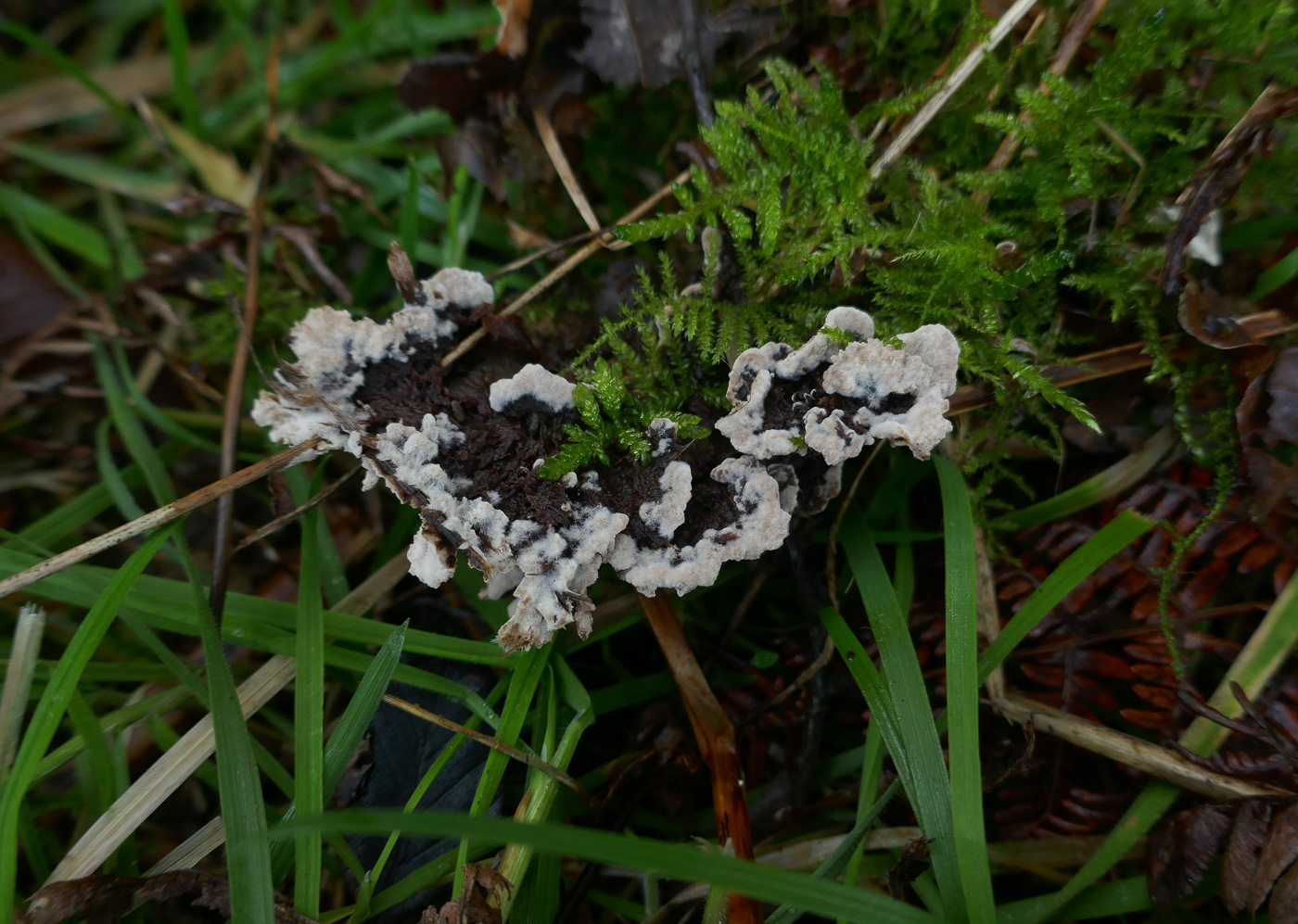

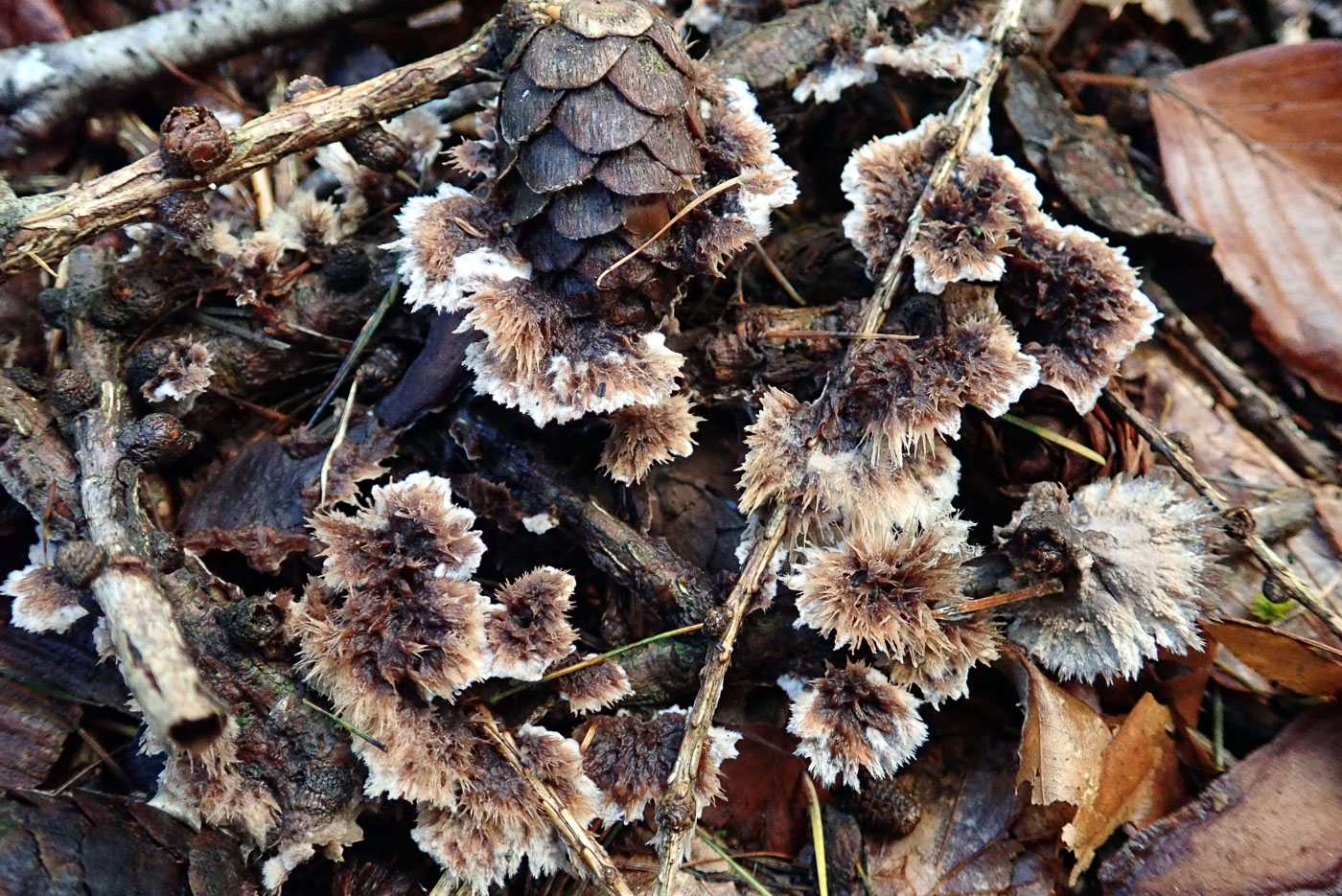
|
Thelephora terrestris (Earth Fan) 
Nov 1, 2023. At Stampwell Farm Jackie Ewan found this nice example in mossy heathy litter. When in woody litter it is easily missed, blending in well with its surroundings but here it was showing up against the green background.
Nov 12, 2022. At Stampwell Farm Jackie Ewan spotted this quite unusual species amongst rotting stems on the ground. It forms flattish patches and when actively growing as here it has a white rim which also shows on the underside (photo 2).
Oct 11, 2020. This unusual but not uncommon species was found by Penny Cullington in Pullingshill Wood in woody conifer litter. It tends to occur in heathland or sandy soils with conifer, so it was a bit of a surprise to come across it in typical Chiltern Beech woodland though it was in an area with Larch. The fan in the far right bottom corner of the photo shows the underside which is almost whitish and each piece of fan was about 2-3 cms across.
|





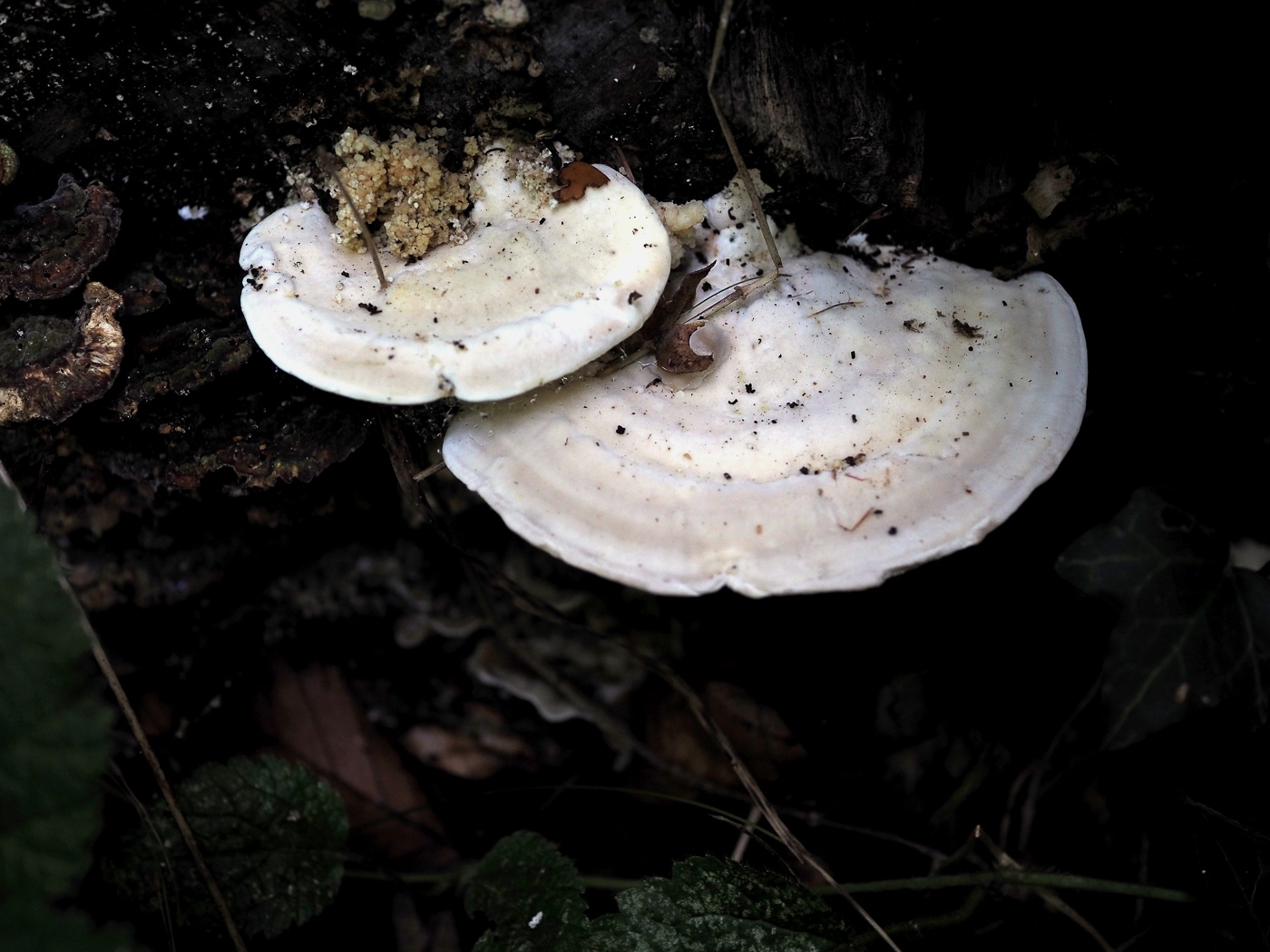
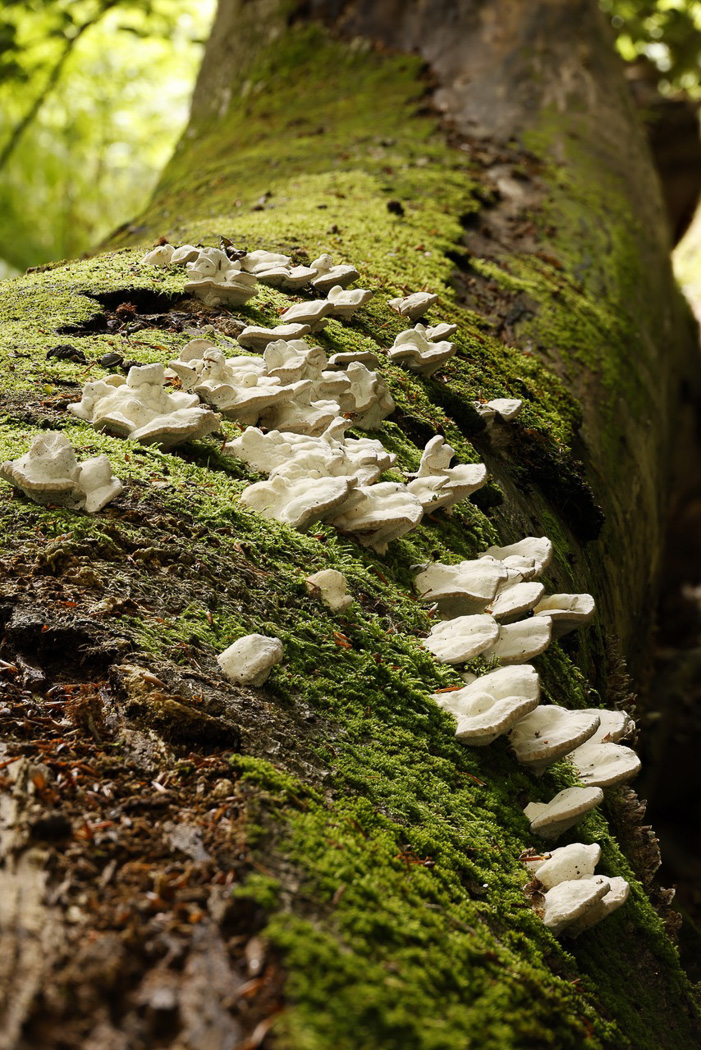
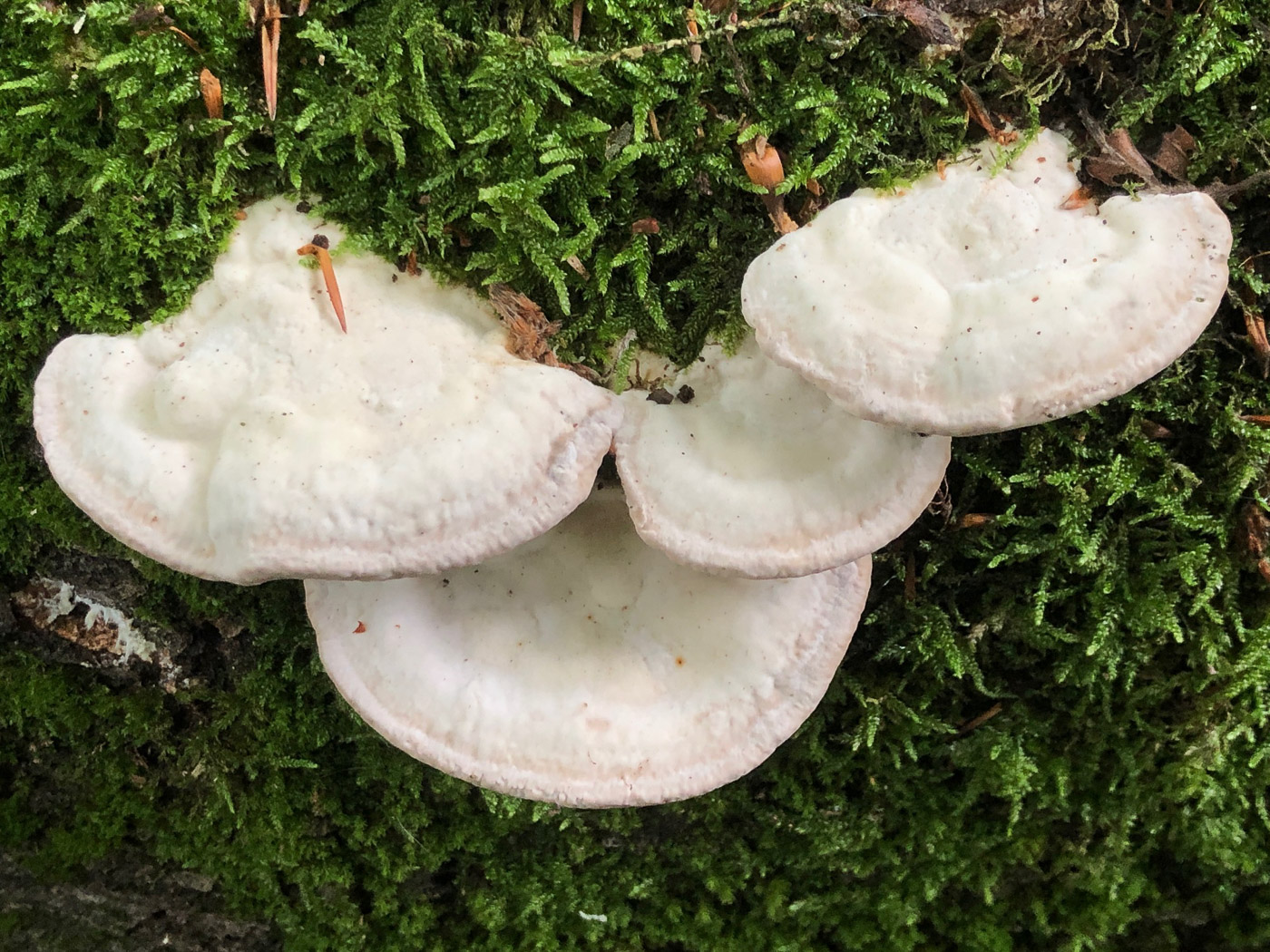
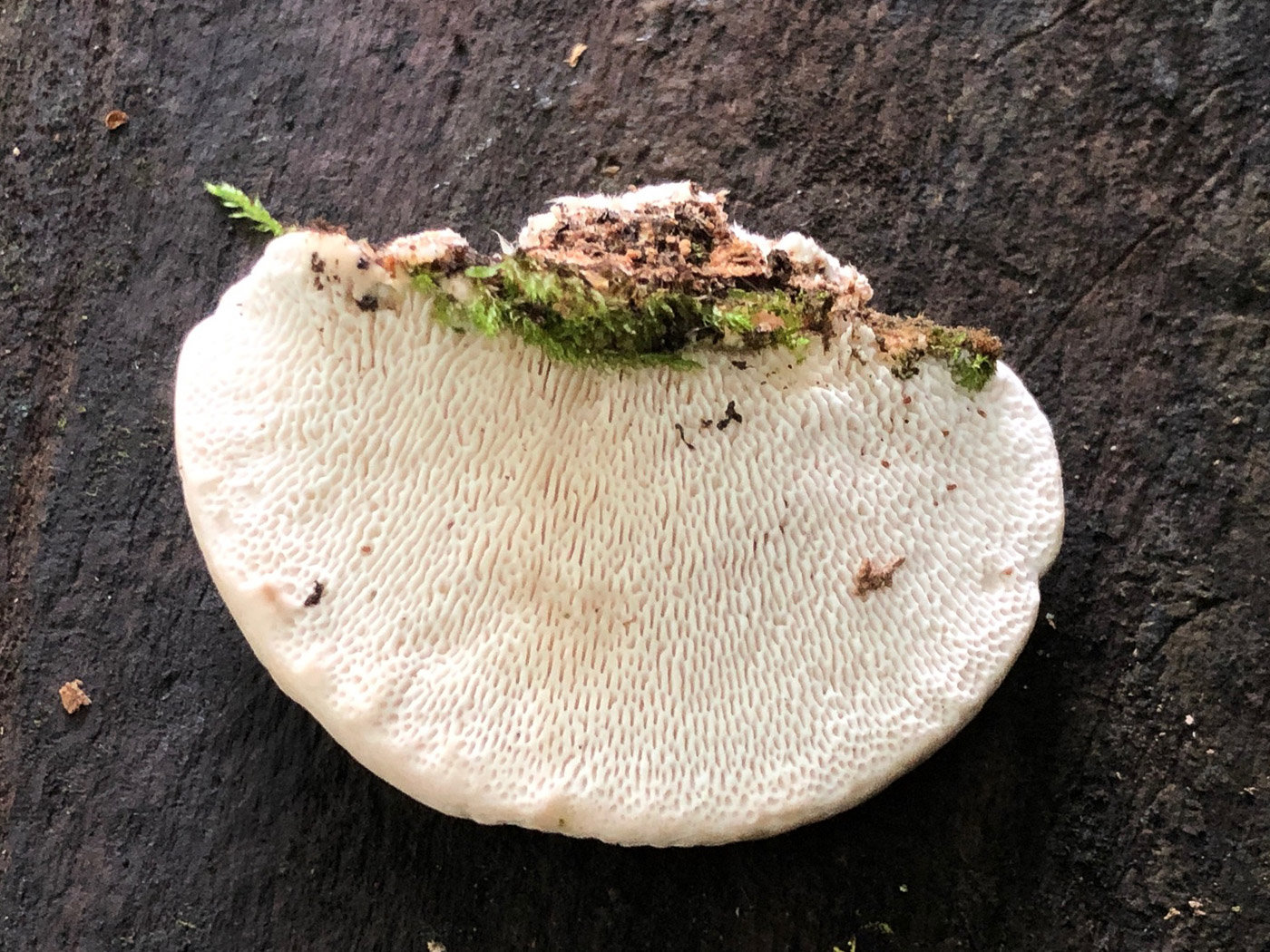
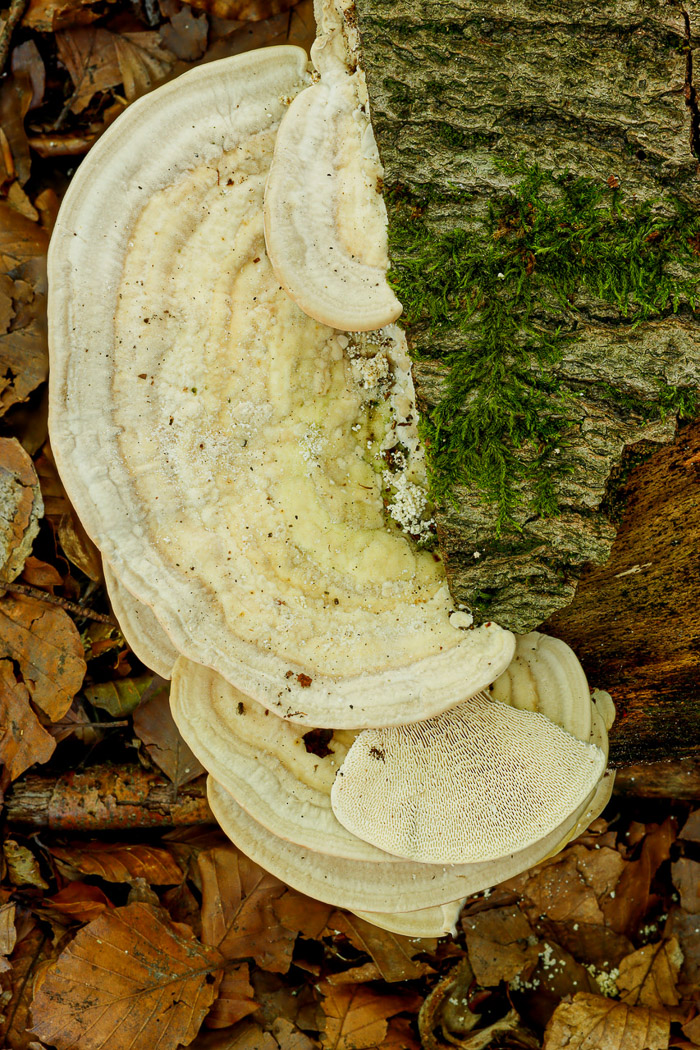
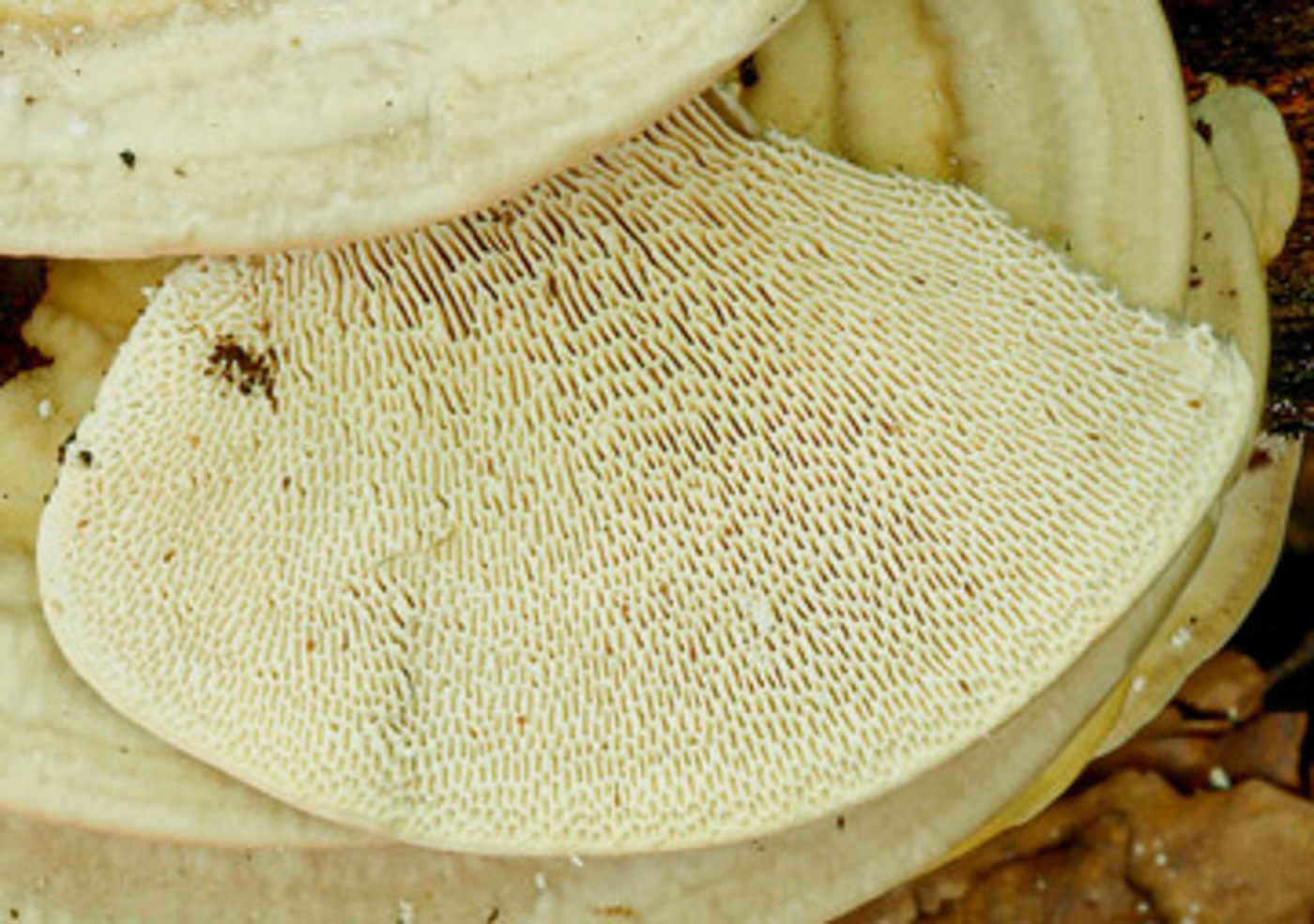
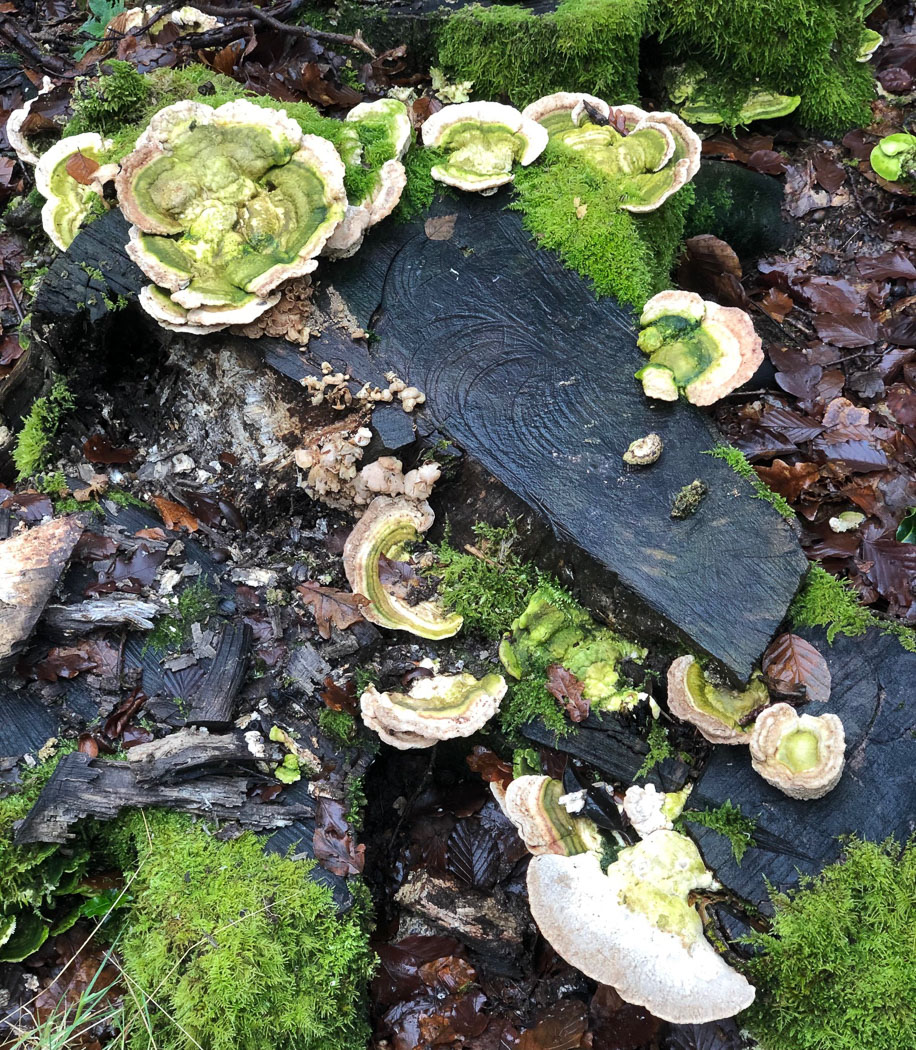
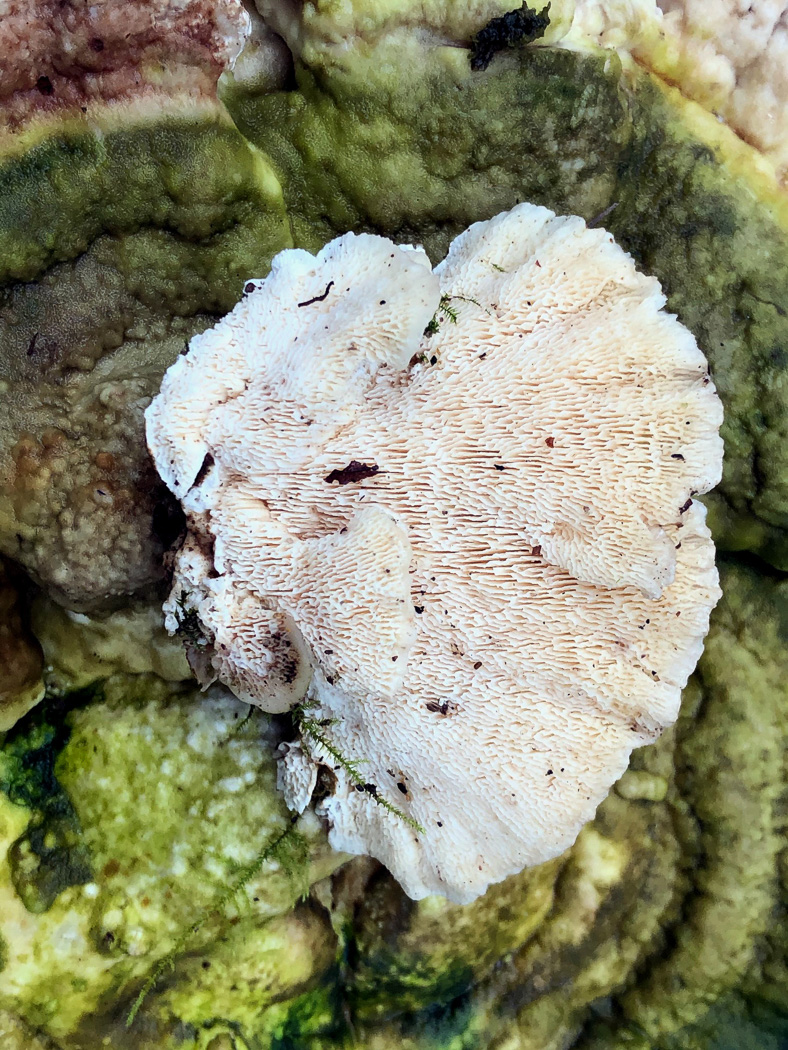
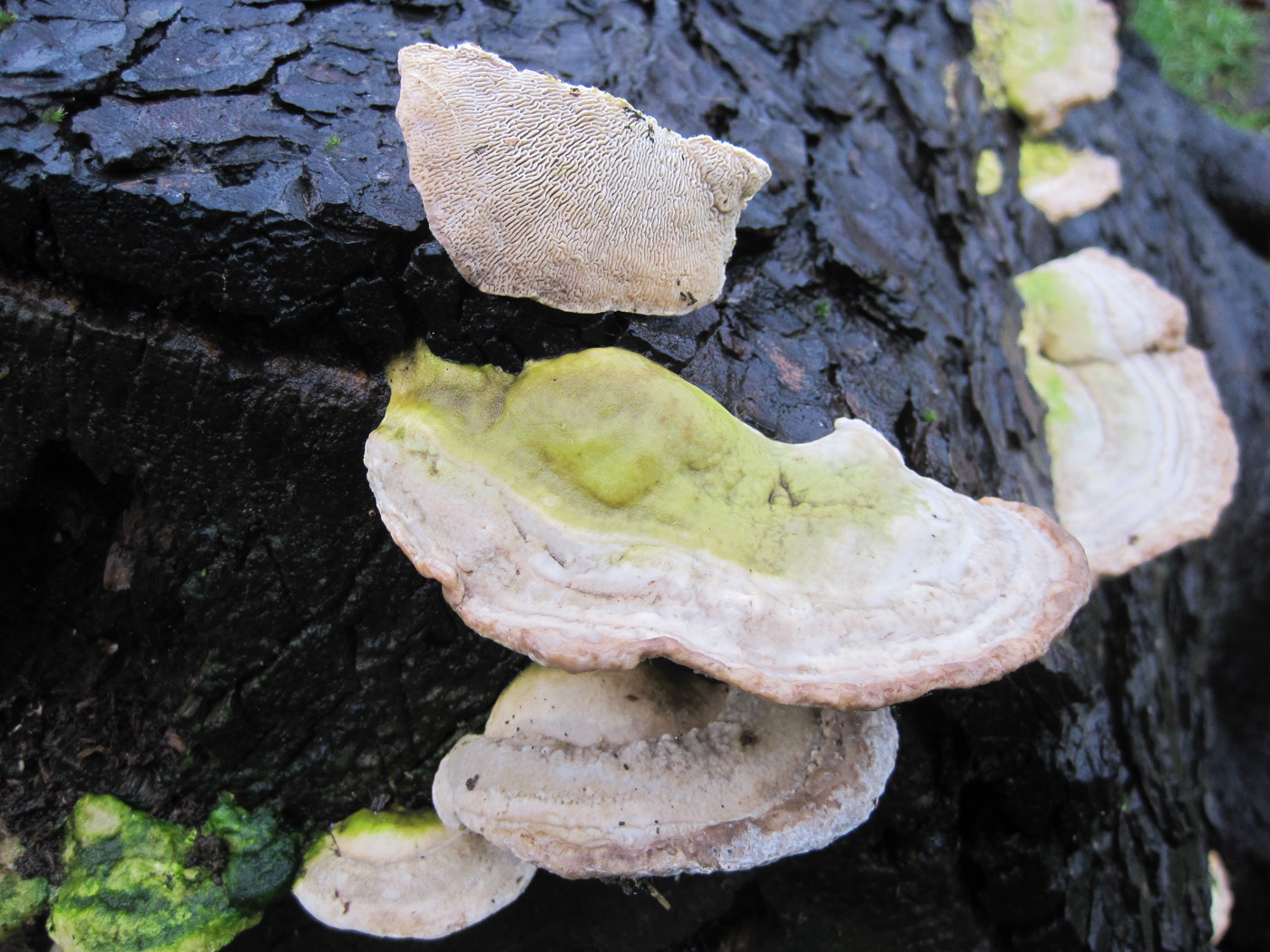
|
Trametes gibbosa (Lumpy Bracket)
Apr 23, 2024. Inspired by Sarah and Jesper's recent Truffle hunting success, Penny went searching in the Lime avenue at Turville Heath but found nothing! The only fungi of interest were this cluster of brackets on an Ash stump together with the entry above. Typical of the species is the green algal coating which often forms on its bumpy upper-surface, also the mazelike under-surface - all features showing nicely in photo 2. This is a very common bracket on fallen deciduous wood.
Jul 10, 2023. A visit by Penny to Gussett's Wood - typical Chiltern Beech woodland - proved unproductive apart from this display of fresh brackets and the Ganoderma shown above. The brackets were liberally covering a felled Beech trunk and only one (see photo 2) was showing the green algi which often adorns this species as it ages. Photo 3 shows the unusual labyrinthine under-surface which, together with the presence of green algi and the hard lumpy zoned pale upper-surface, is sufficient to allow it to be named in the field.
Aug 27, 2022. In Tinkers Wood John Catterson noticed this pair of brackets on a deciduous log. This solid and tough species is often to be found with green algi on its upper surface - a useful confirmation of its identity but missing here, possibly reflecting the dry hot conditions?
Aug 1, 2021. On a fallen Beech trunk in Naphill Common Paul Goby noticed this spread of brackets covering about a metre of the trunk, some up to 10 cms across. Often this particular species - common on various deciduous woods - becomes coated with green algae as it ages, being a useful diagnostic feature. Today's example, however, is young fresh material showing its typical lumpy upper surface, pale colour with labyrinthine almost gill-like under-surface (photo 3). It has tough thick flesh, the whole being flexible but very firmly attached to its substrate.
Feb 4, 2021. In Naphill Common Paul Goby found these substantial brackets on fallen Beech. This is our second find of this common fungus (see also photo dated Jan 14), also our third species of Trametes this month. Both larger and tougher in texture than both T. versicolor and T. ochracea, it is often liberally coated in green algi as seen clearly here and also has very obvious large pores underneath which are distinctly elongated rather than round to oval - almost mazelike.
Jan 14, 2021. Joanna Dodsworth noticed these brackets on fallen Horse Chestnut in Brill Common. Typical of this common species is the green algae growing on the upper surface and the maze-like almost semi-gills on the underside - both features visible in the photo.
Sep 15, 2020. Paul Goby found this common bracket on the end of a felled Beech trunk in Naphill Common. The pale zoning on the top is typical, also the green algi which is just beginning to develop (often a useful clue to identification). The flesh is extremely tough making it difficult to remove from the substrate and the pores below have a maze-like almost gill-like appearance, visible in the piece Paul cut off to show this diagnostic feature.
|
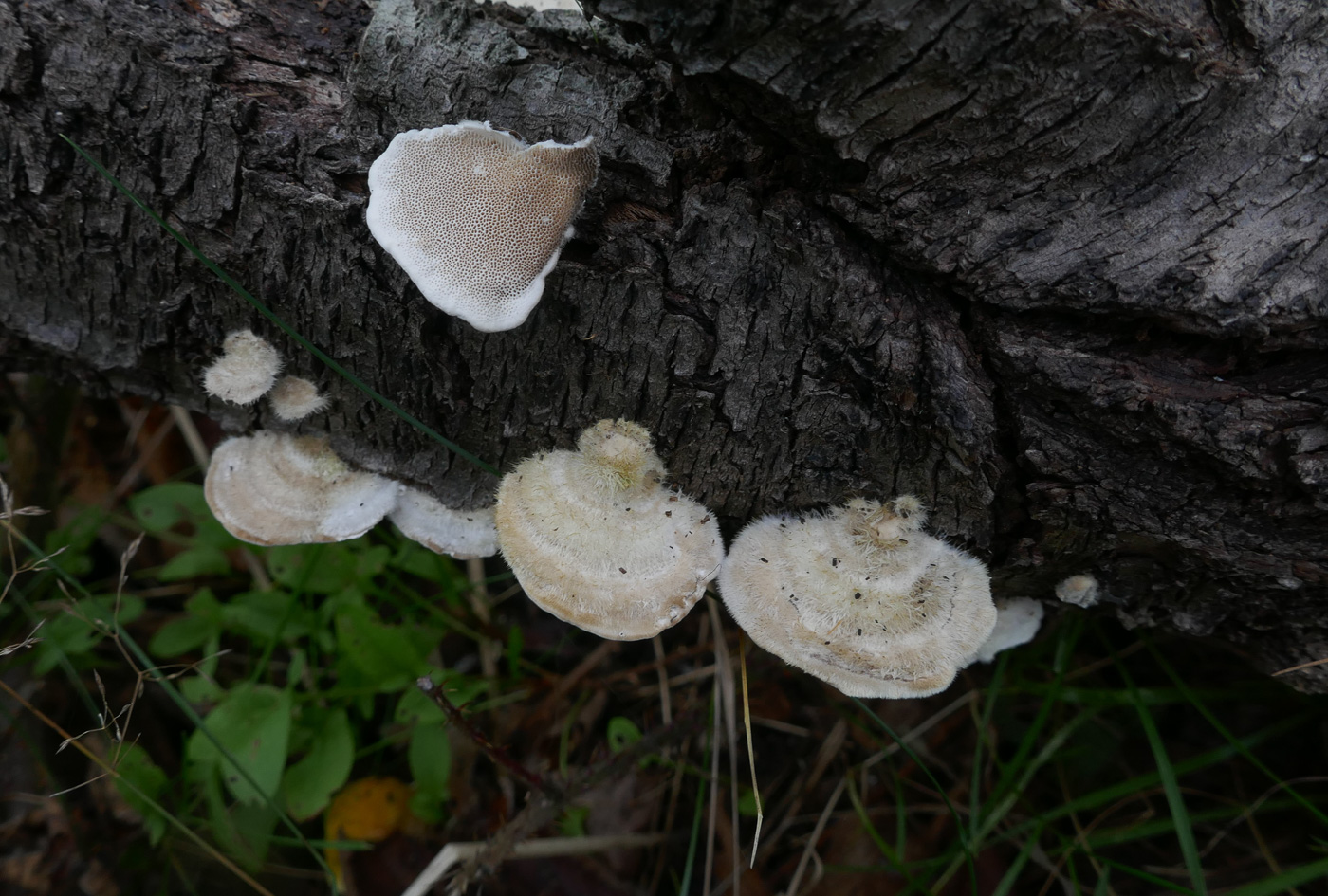




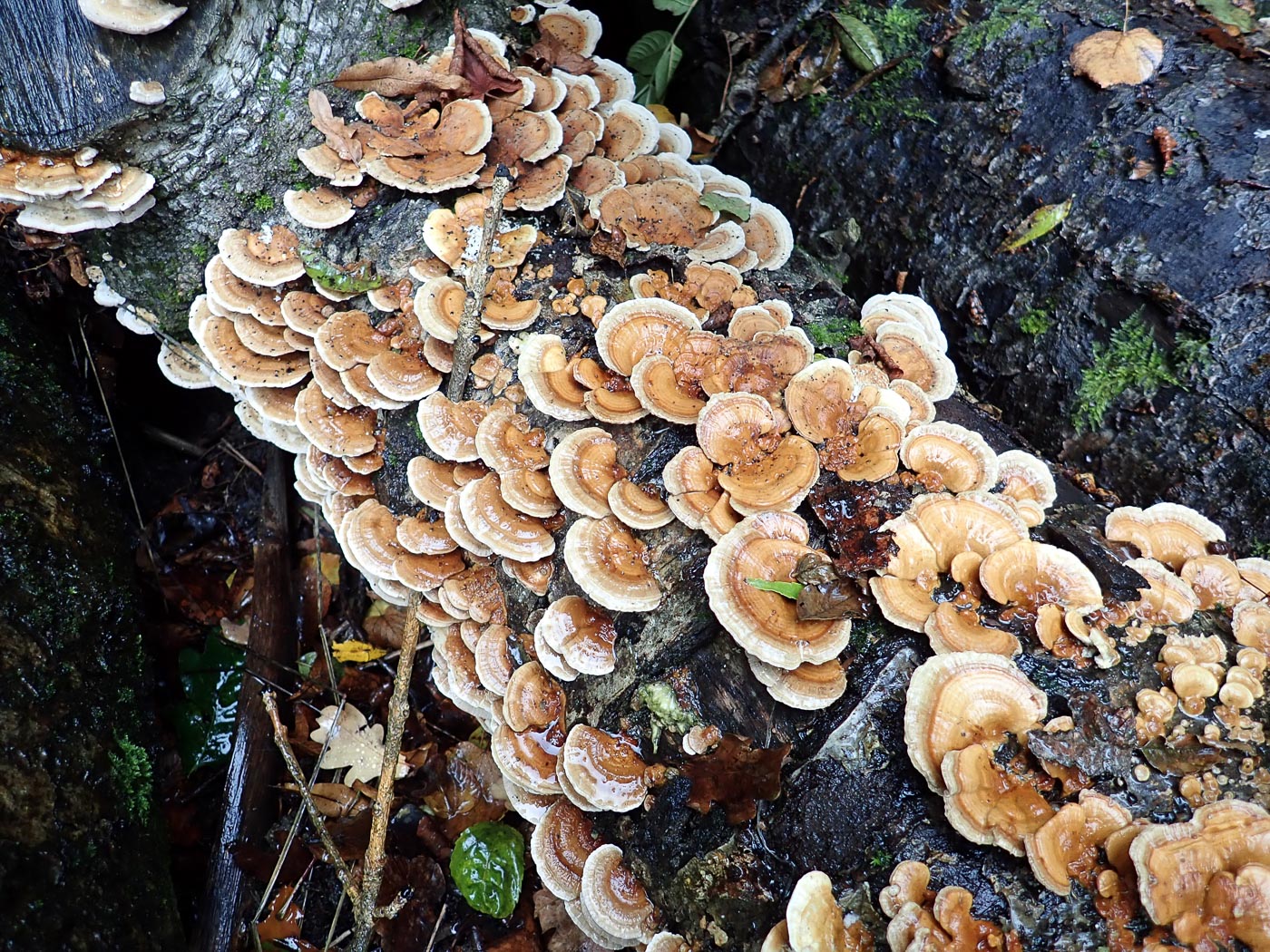
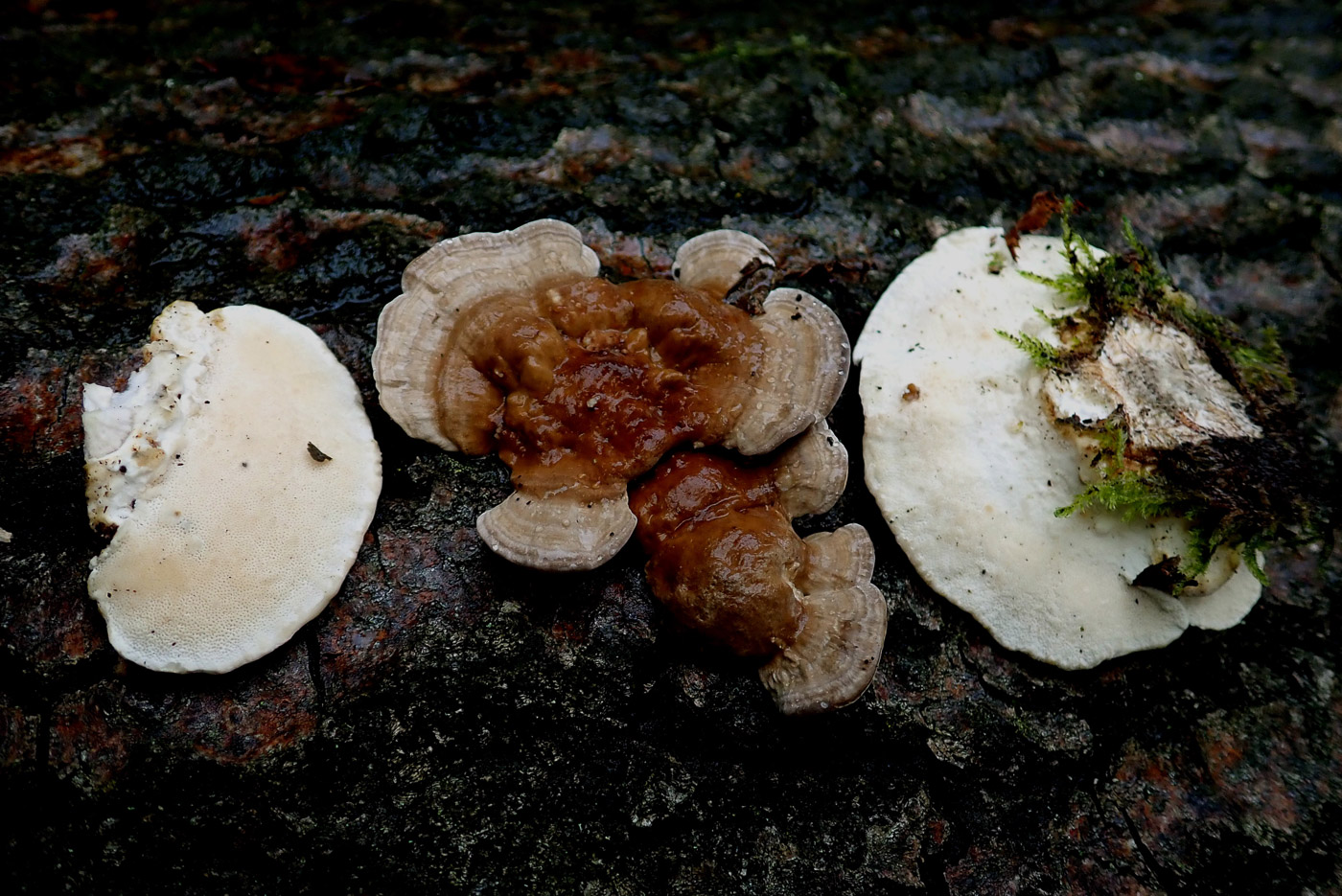
|
Trametes hirsuta (Hairy Bracket) 
Nov 8, 2024. On a fallen Plum branch at Stampwell Farm Jackie Ewan noticed these brackets and thought they were likely to be this species - similar to but much less common than T. versicolor (Turkeytail) with which many are familiar. Penny suggested she should ask Claudi Soler to check her photo and he was able to confirm her ID. The top specimen in her photo show the pores typical of the genus but the lower specimens wshow the pale somewhat hairy surface of this species.
Jun 24, 2023. On an unidentified log in Gerrards Cross, Jesper Launder found two different brackets, this being one - the other not yet identified satisfactorily. The species is typical of the genus having pale cream obvious pores underneath though is not nearly as common as T. versicolor (Turkeytail) or T. gibbosa (Lumpy Bracket). Very similar are T. ochracea and T. pubescens though the latter (also hairy!) can apparently (though not easily) be separated from today's species by observing the size of the pores and spores respectively: up to 3(4) pores per mm in T. hirsuta, spores 6-9 x 2-2.5 microns, but pores a bit smaller - up to 5 pores per mm in T. pubescens, spores 5-7 x 1.5-2 microns.
Jan 15, 2023. On a Beech log in Burnham Beeches Russell Ness found this bracket and by process of elimination suggested this name to Penny though was unsure. Penny, however, feels fairly happy that this is correct: it is clearly different from the two common and more familiar Trametes species and favours Beech whereas the quite similar T. pubescens favours Birch and is downy rather than hairy. Please note this ID is not definite but likely!
Oct 6, 2020. Joanna Dodsworth found this impressive spread of brackets on a pile of felled deciduous trunks in Wotton Park Estate (photos Penny Cullington). Much less common that the two better known Trametes species (see photos dated Sept 15 & 26), this species falls between the two both in size and in thickness and firmness. The zoned cap and white pores underneath are similar to the common Turkeytail, but the bumpy surface and general firmness make it more like a smaller version of Lumpy Bracket. Each bracket can be up to 10 cm across.
|
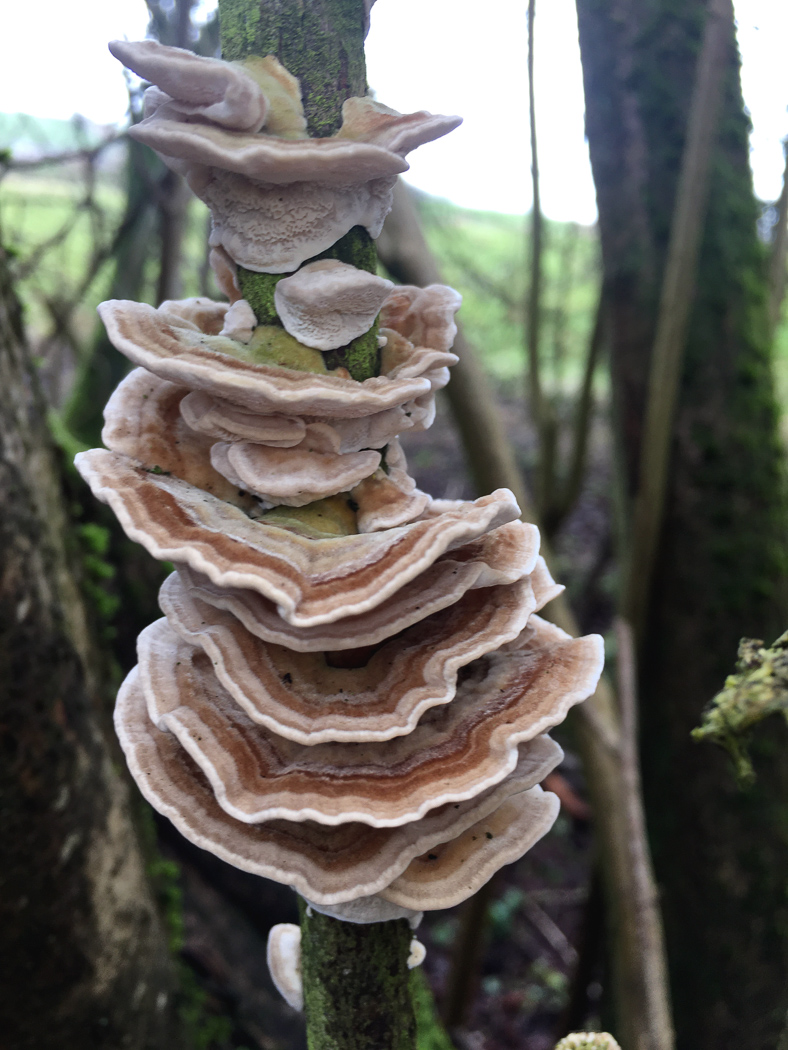 |
Trametes ochracea (a bracket with no common name) 
Jan 28, 2021. In Brill Common Joanna Dodsworth found this attractive tier of brackets on dead but standing Hazel. Similar to the much commoner Trametes versicolor (Turkeytail), it is thicker fleshed with slightly larger pores underneath and often has green algi on the upper surface (as also does the larger Trametes gibbosa (Lumpy Bracket).
|



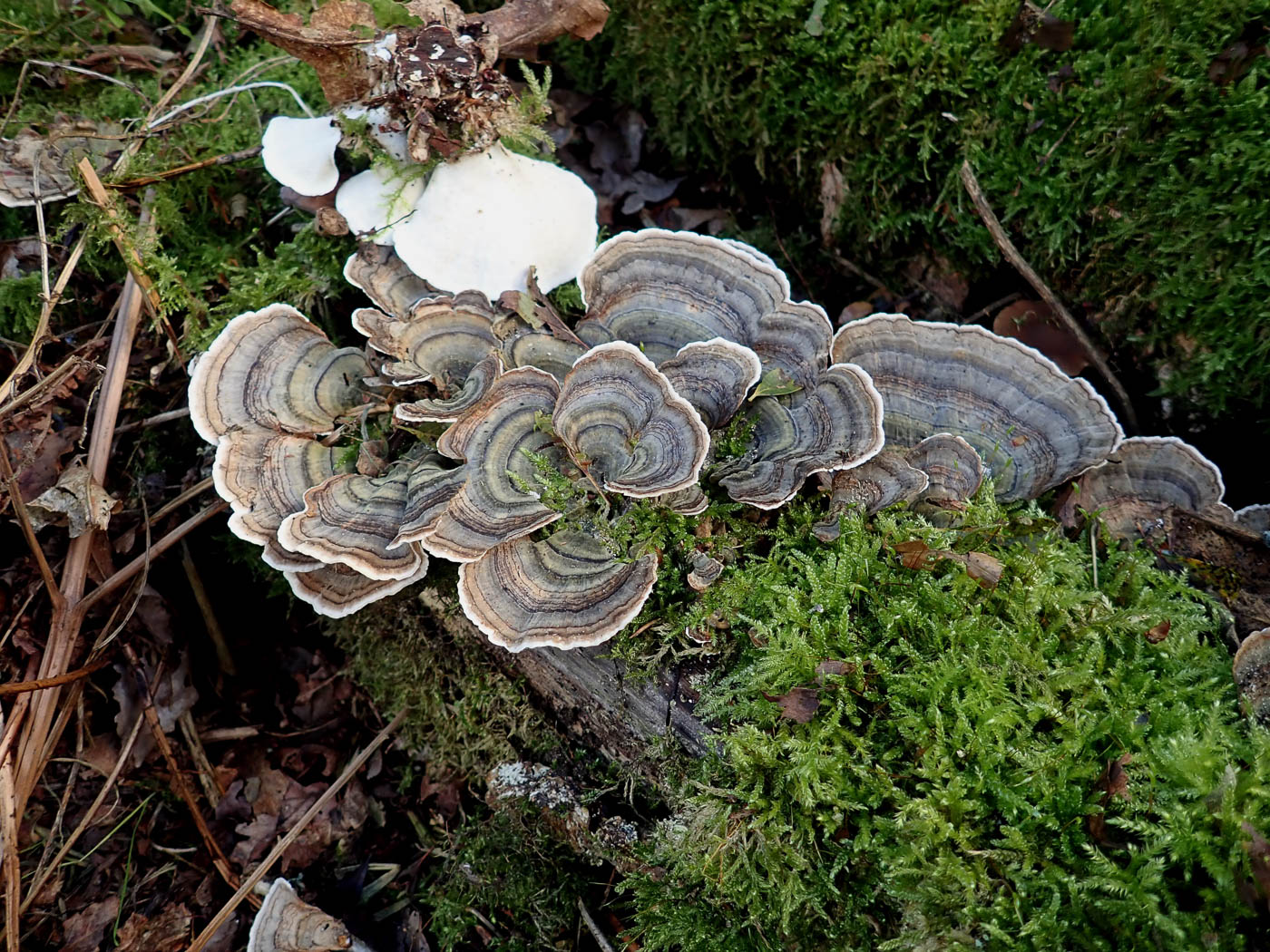
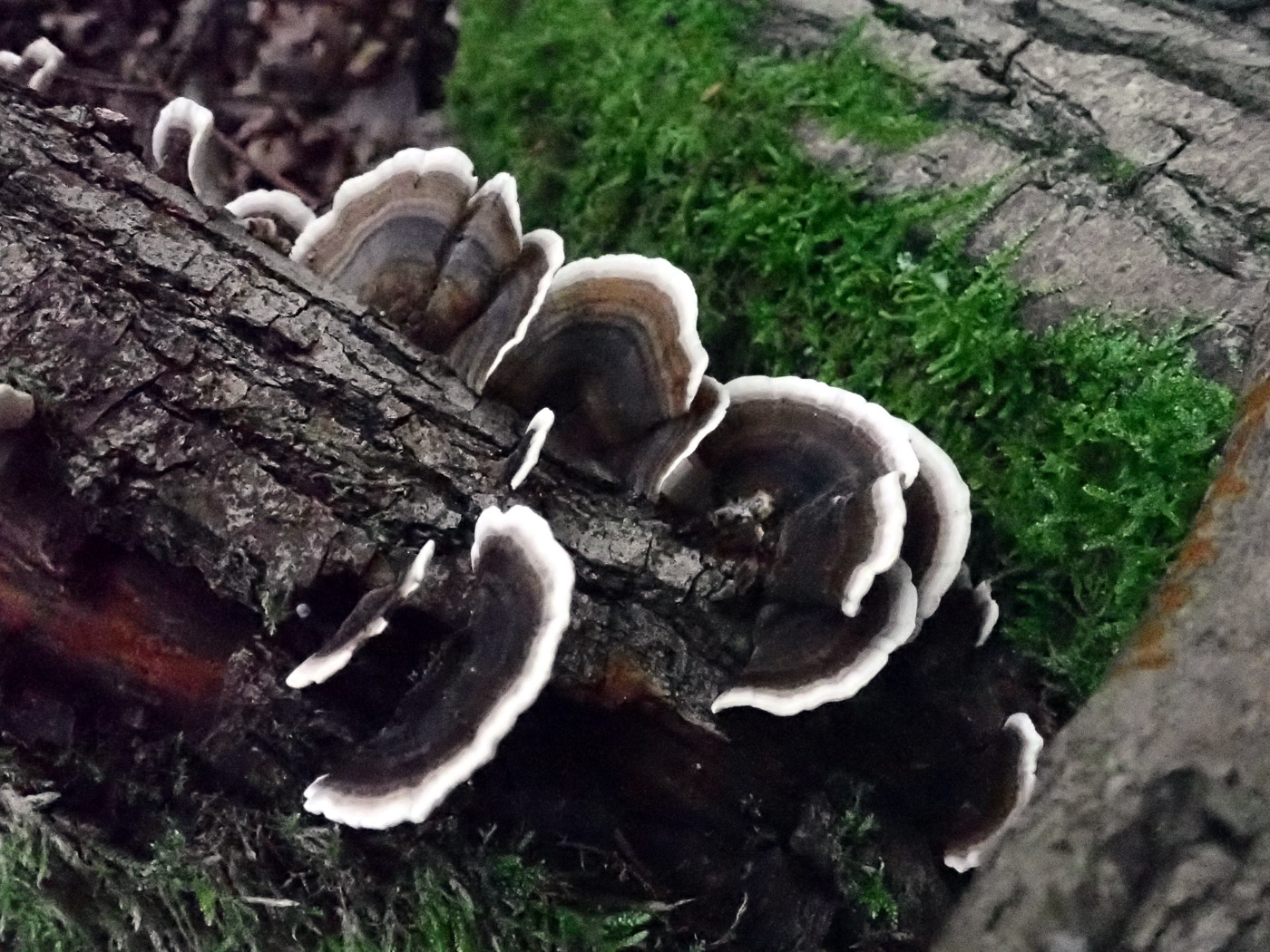
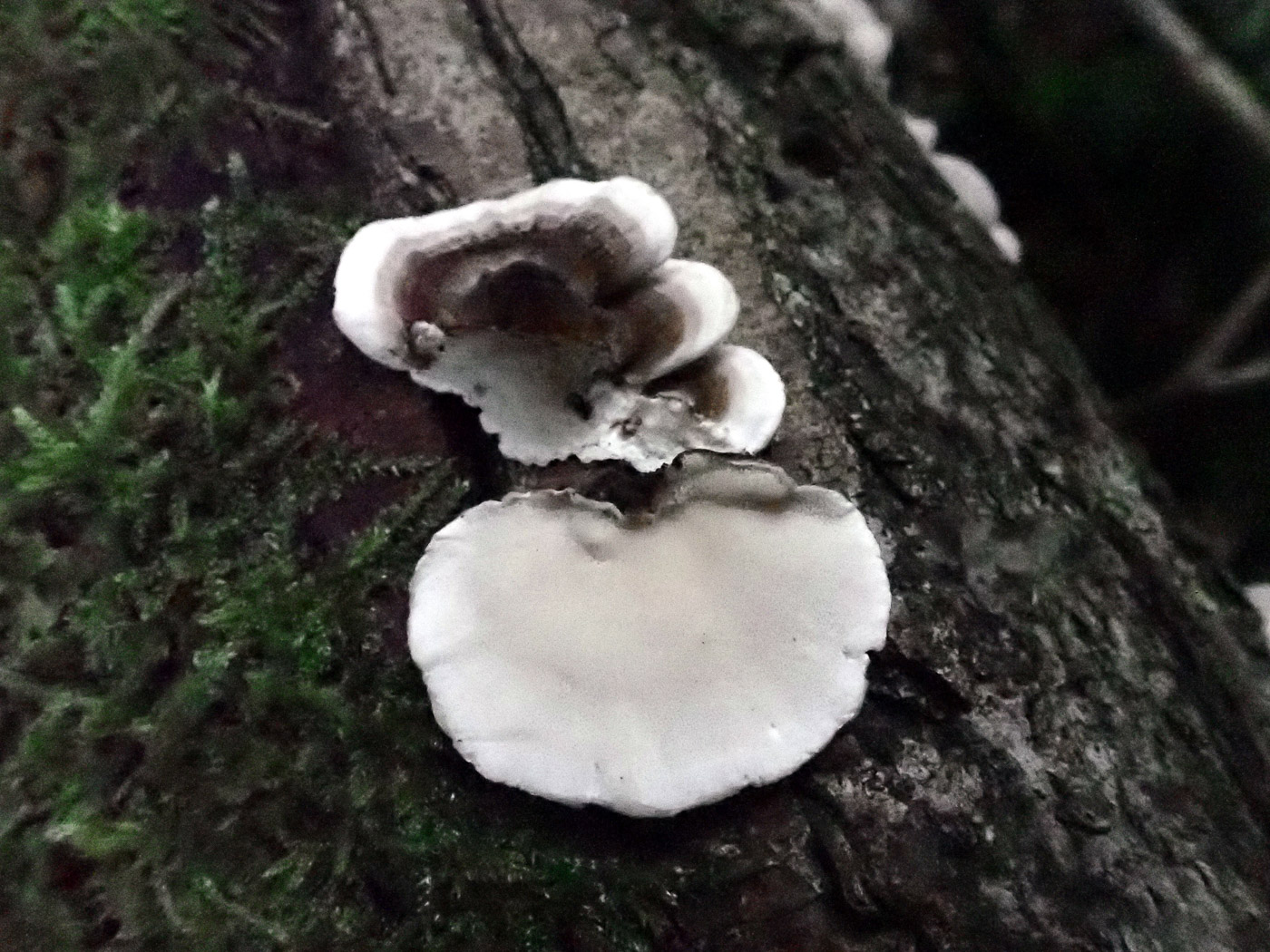
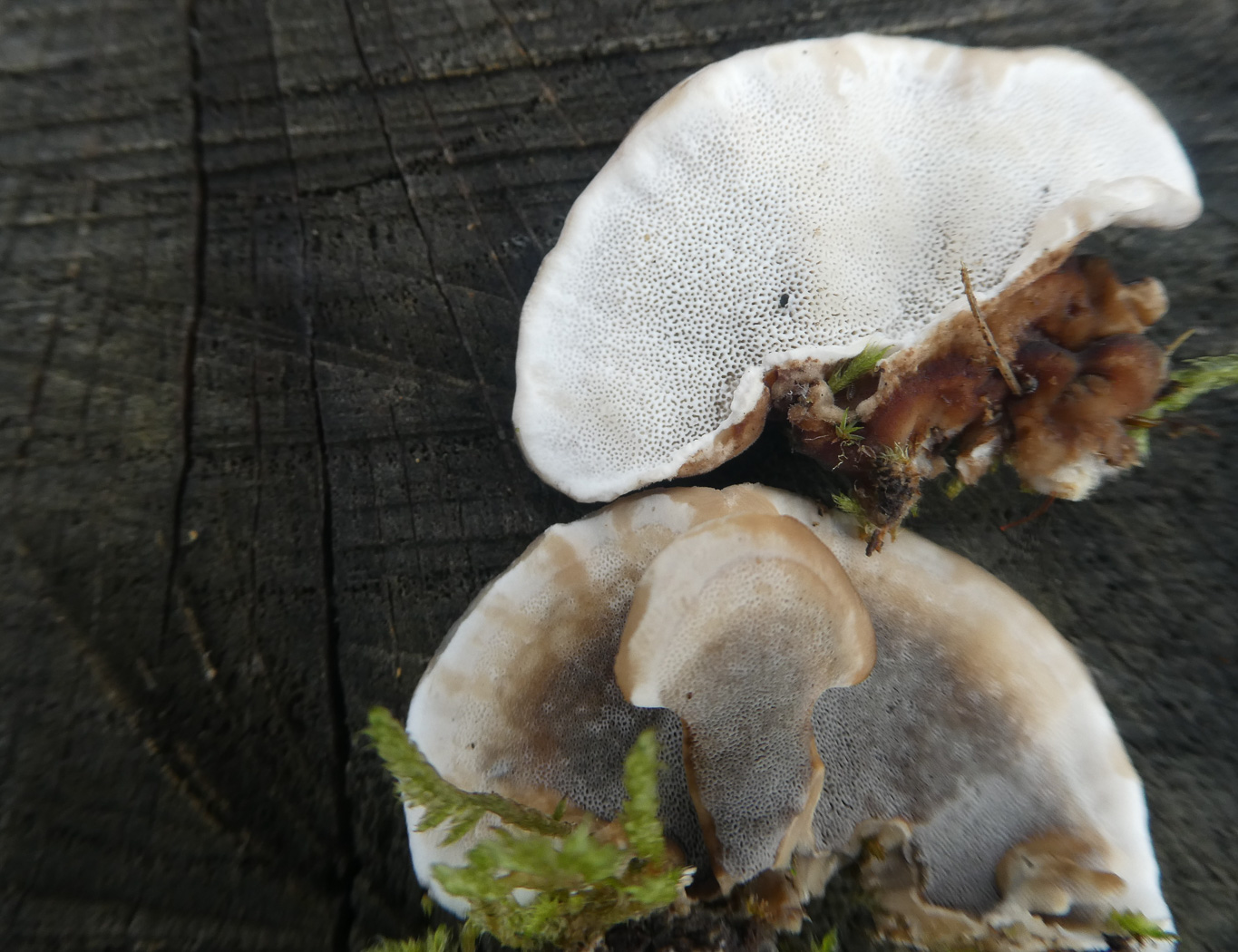
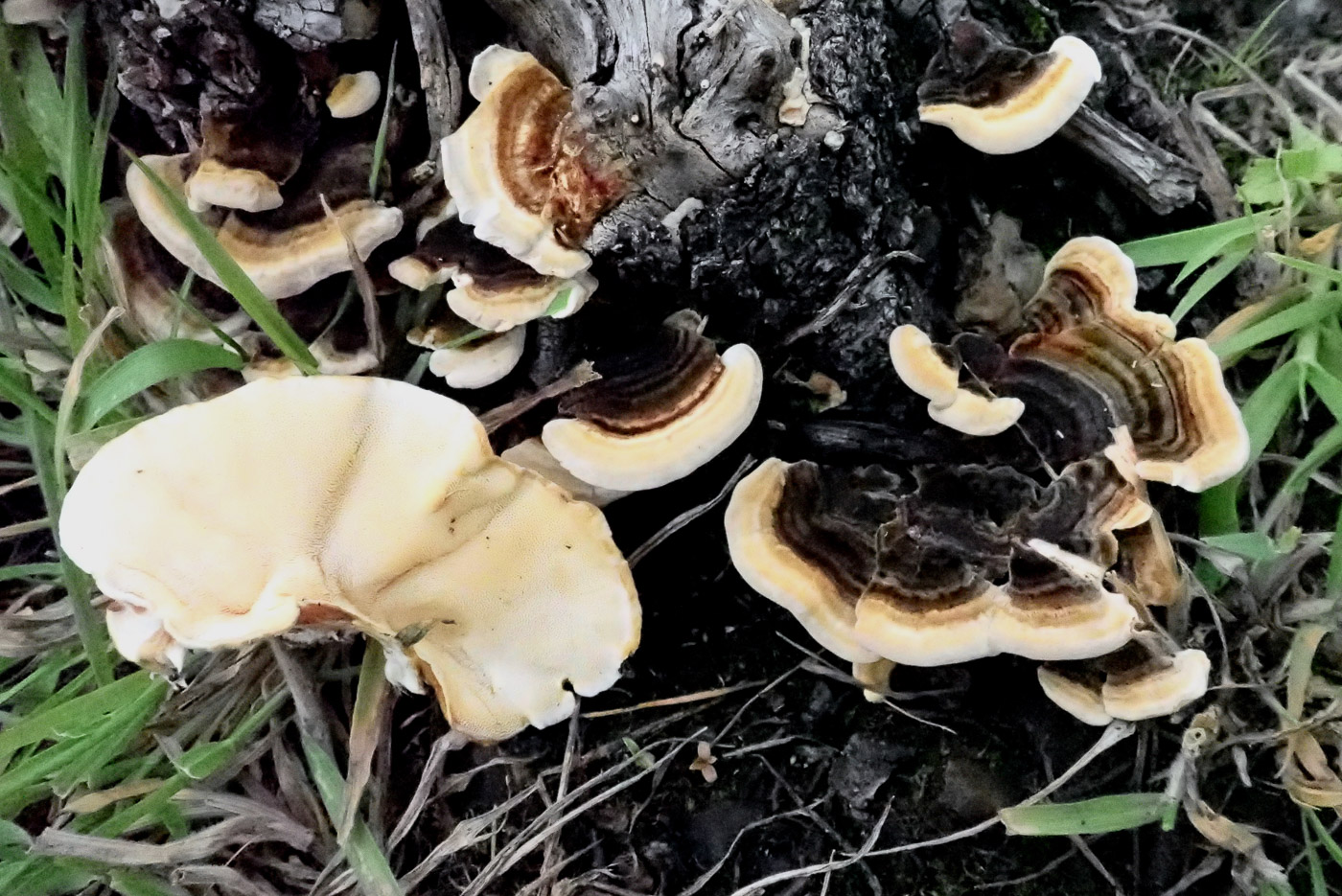

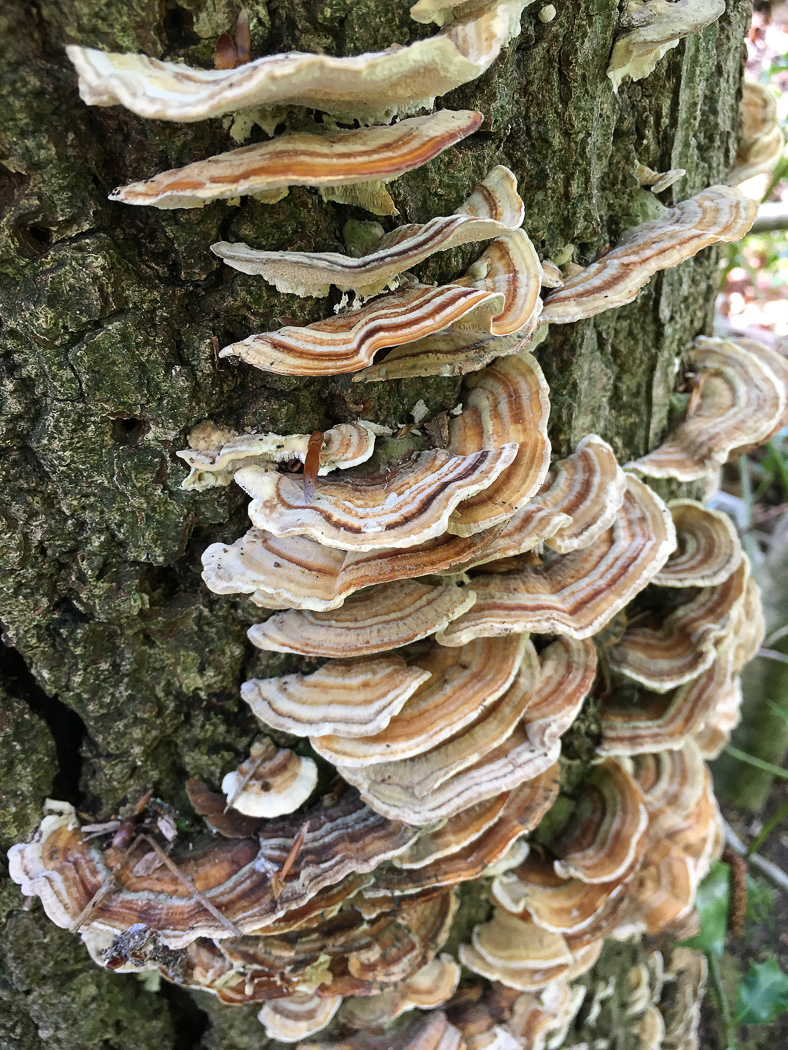
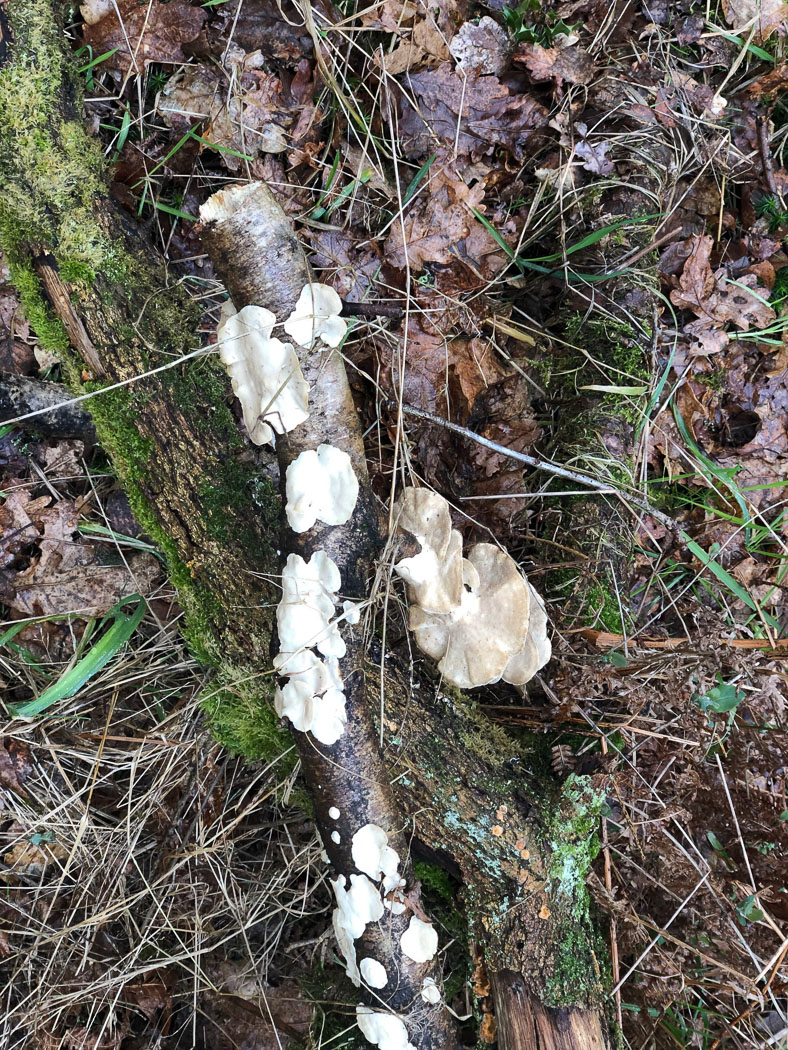
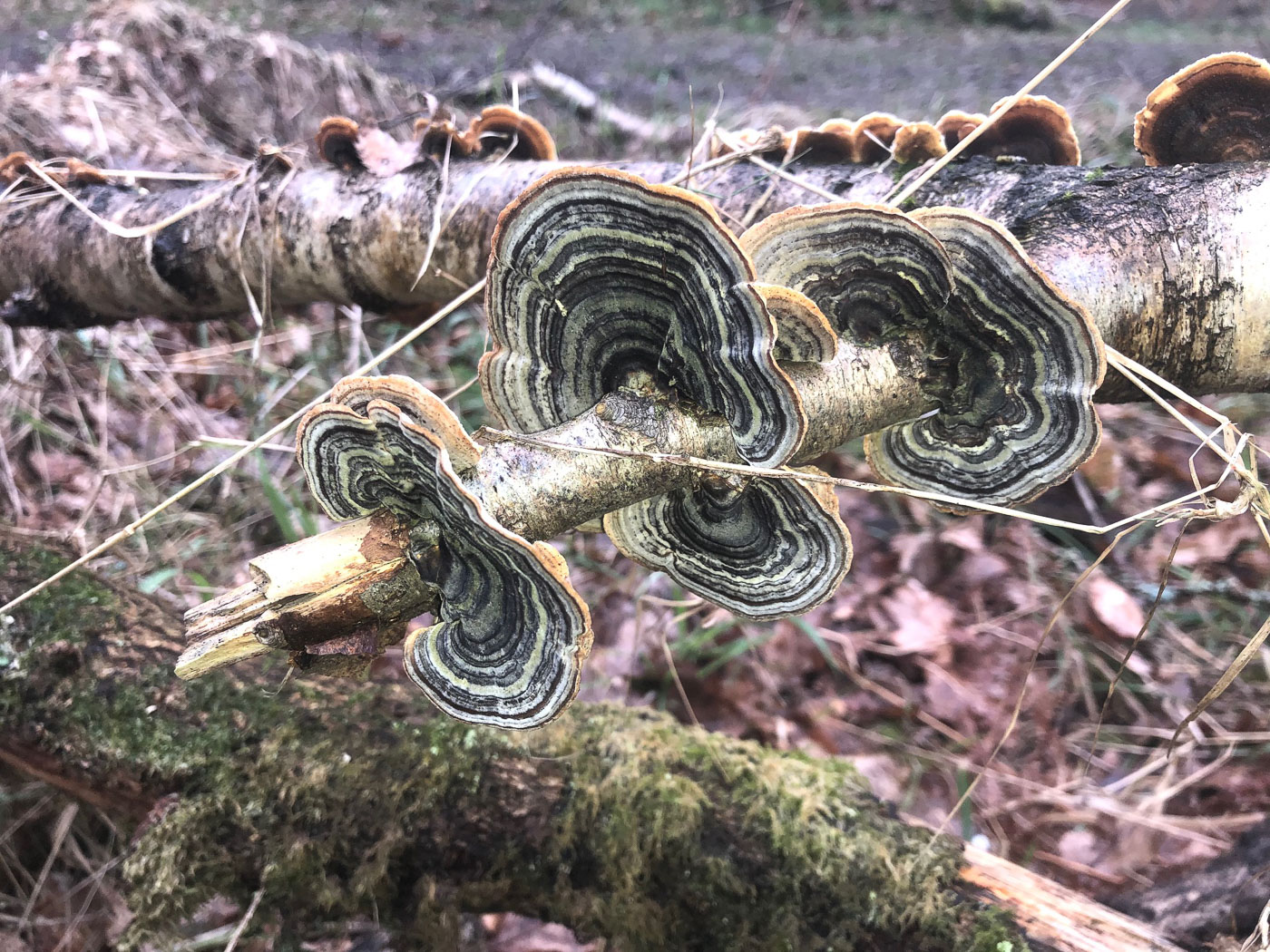
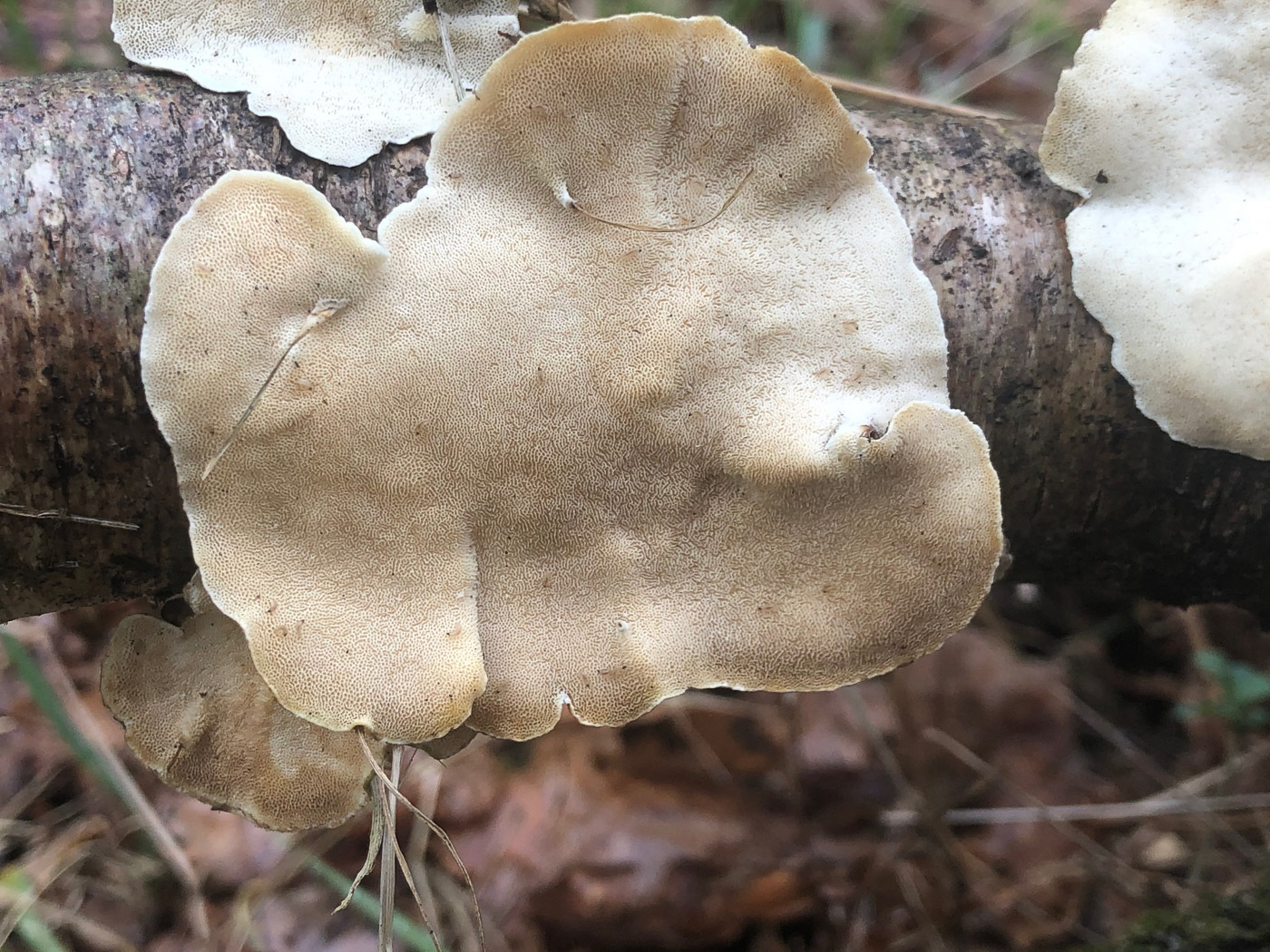
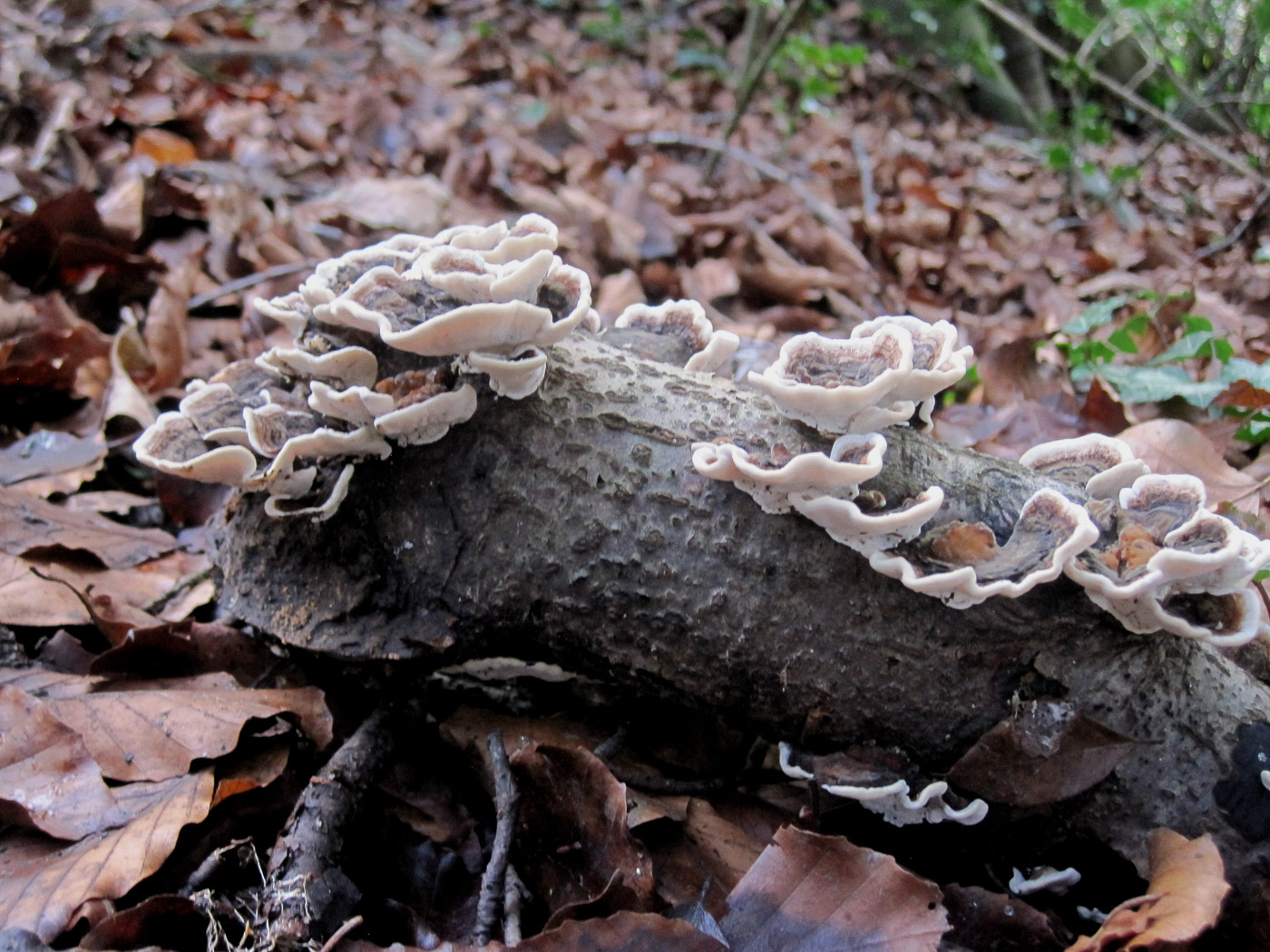
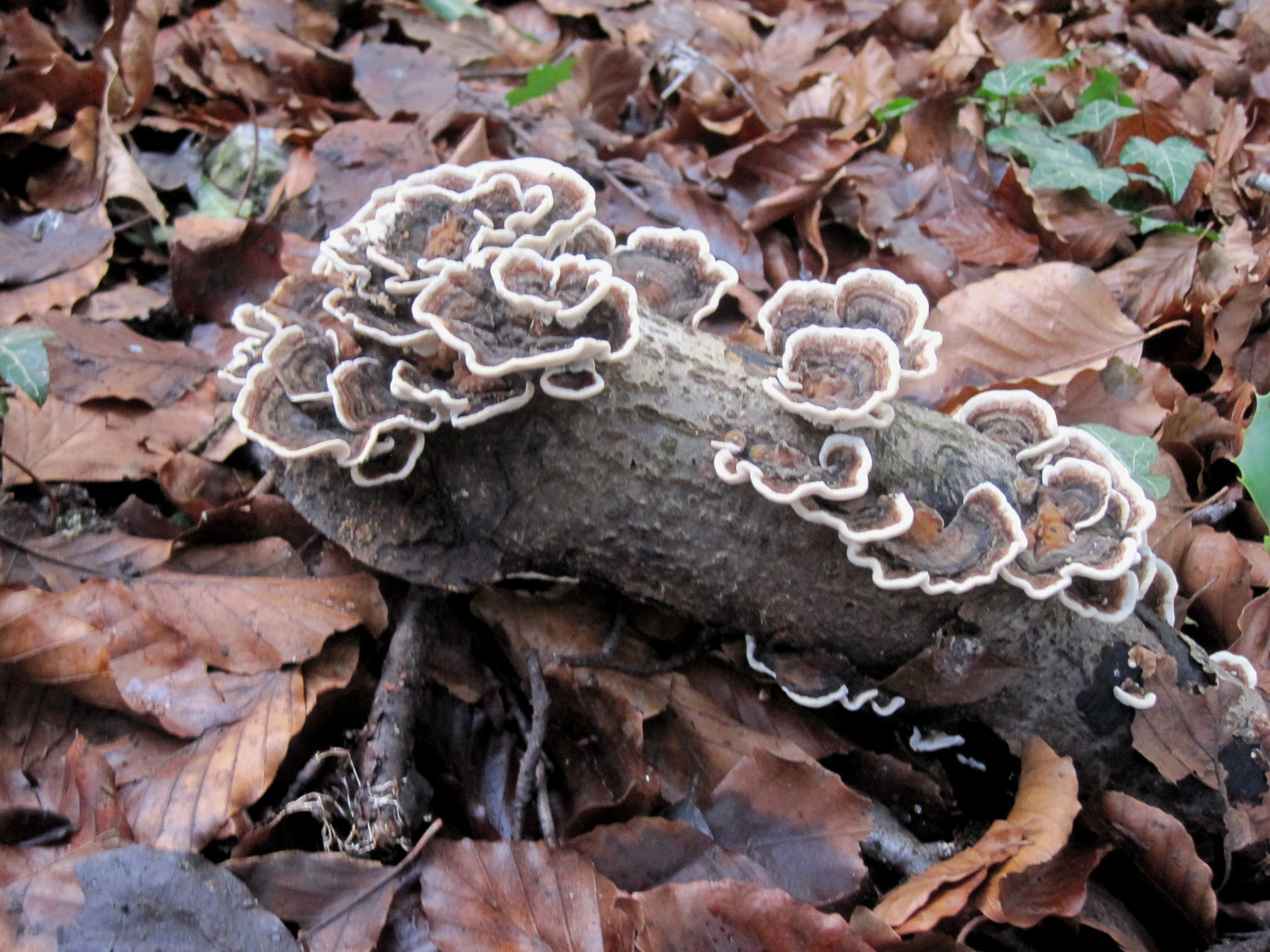
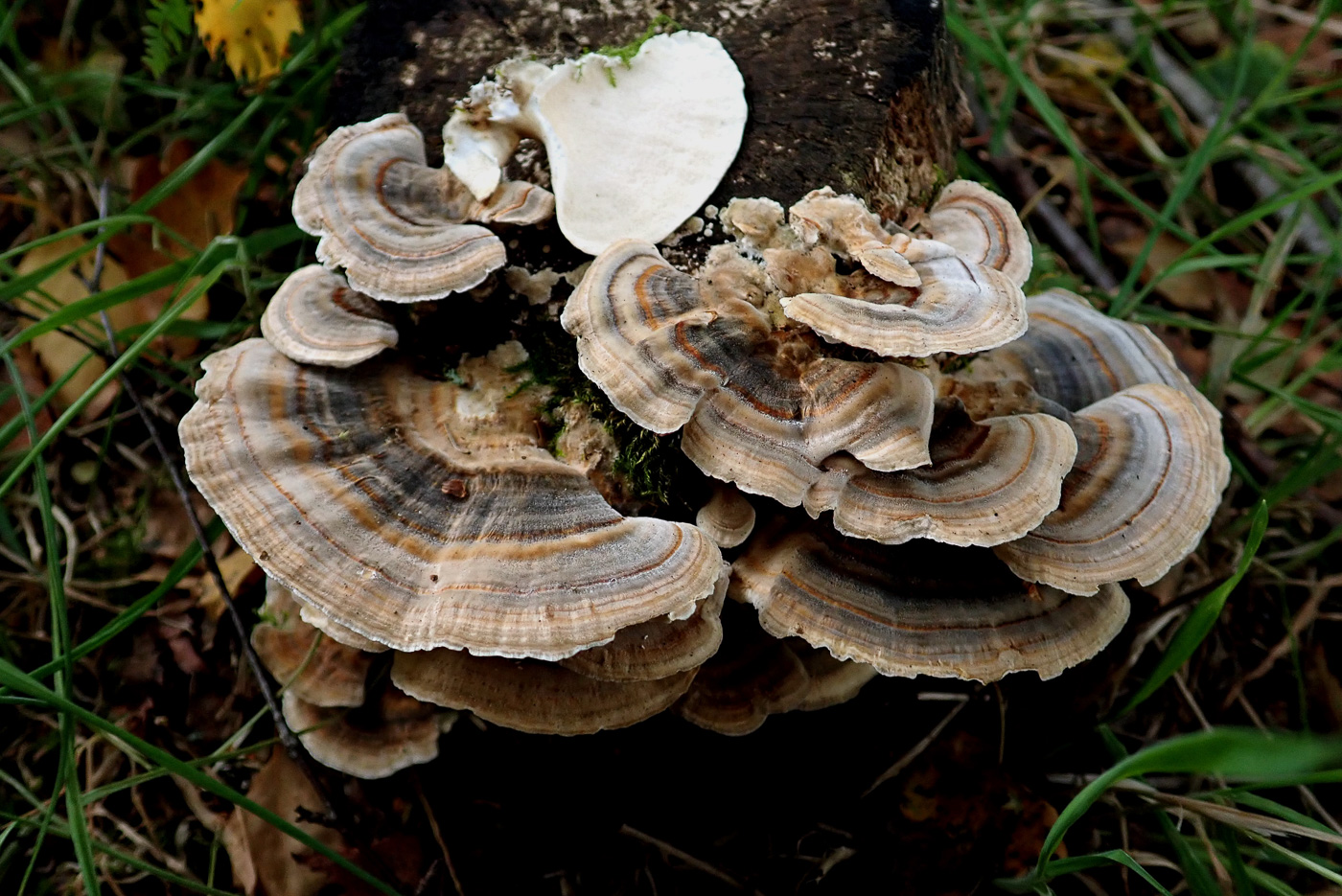
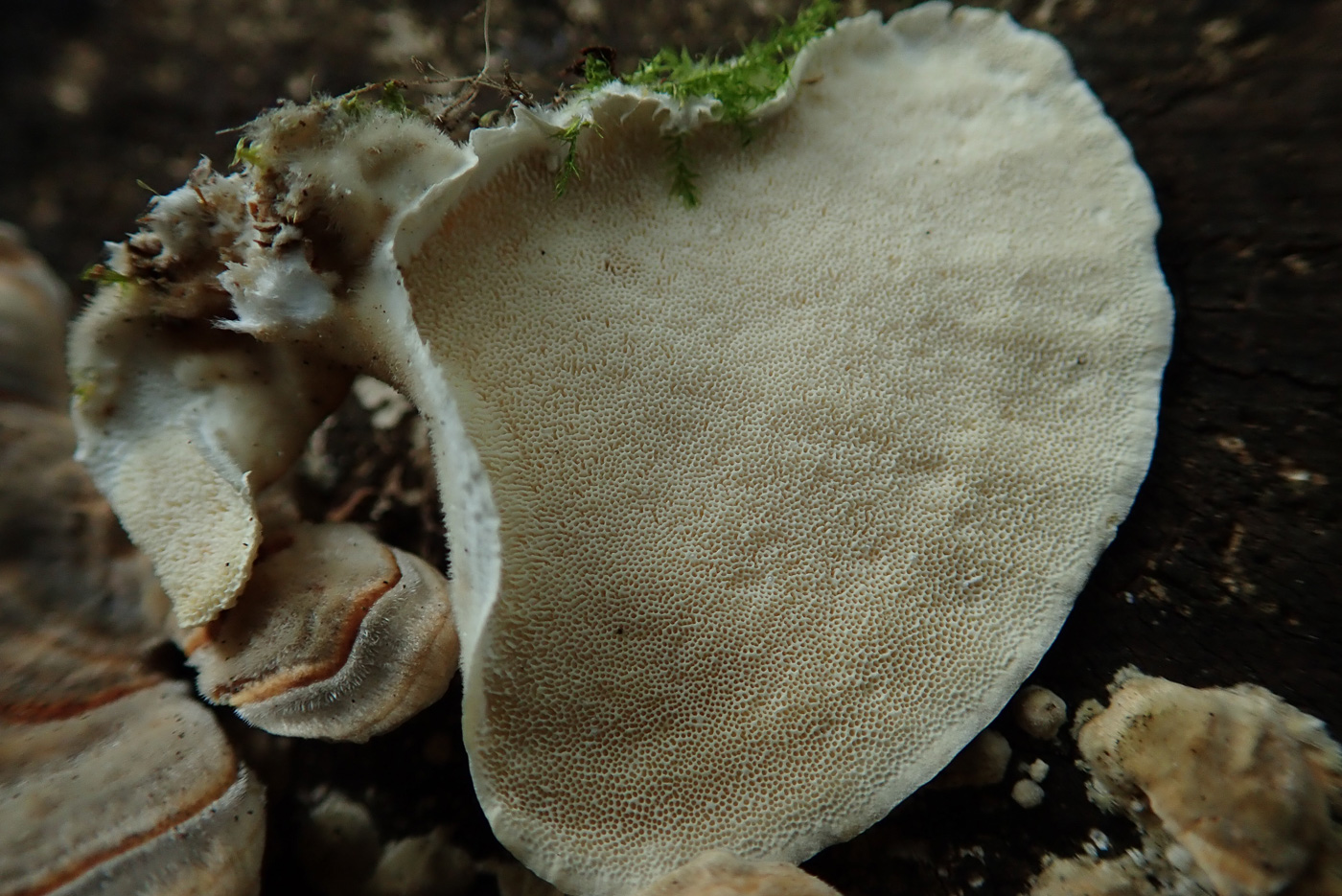
|
Trametes versicolor (Turkeytail)
Mar 25, 2023. At Stoke Common Penny found a fresh example of this common bracket showing some of the many varied colours it can display. Photos 1 and 2 were part of the same colony on fallen deciduous wood only a few inches apart though sporting different shades of grey / brown. Photo 3 shows the pale cream clearly pored undersurface which separates the species from other equally similar thin-fleshed brackets.
Oct 7, 2022. Despite having plenty of entries of this very common bracket in Finds, Penny couldn't resist taking a snap of this beautifully marked collection she came across in Marlow Common on a deciduous log. The colour of its zones are indeed so varied that it can be confused with other things - that's her excuse anyway!
Sep 13, 2022. Continuing Penny's soft fleshed bracket theme above, here for comparison (and also from Burnham Beeches) is a rather dark example of Turkeytails showing the typical zoning above - though this can also be a feature in Smokey Bracket and also the species following this one! Other examples in Finds show the creamy white pored undersurface far better than Penny's poor photo 2 here.
Jan 1, 2022. On fallen Oak at Stoke Common Jim Wills noticed these two species quite close together and was able to make a comparison of their pored surfaces underneath - this being the best way to tell them apart as their top surfaces can look extremely similar. Above is the plain creamy white finely pored undersurface of T. versicolor and below is the equally pored but grey undersurface of B. adusta showing its diagnostic white rim. The third species which is equally common to these two and can look very similar above is Stereum hirsutum, but this has an almost smooth orange underside.
Jul 15, 2021. In Stoke Common on a Birch stump Penny found a nice fresh fruiting of this very common bracket - so common that one can almost list it (together with Stereum hirsutum - Hairy Curtain Crust) as one enters deciduous woodland without actually seeing it! It's bound to be on fallen wood somewhere. To be certain of naming it correctly one should, however, look at the underside of a piece to make sure that it's just plain cream with small pores and not orange and smooth (i.e. S. hirsutum) or grey with a white border (i.e. Bjerkandera adusta - Smokey Bracket and almost as common). The top surface of this last can sometimes look identical to Turkeytail with similar zoning.
May 19, 2021. Derek Schafer noticed an attractive tiered example of this very common bracket at Burnham Beeches (possibly on standing Oak?). This collection is quite pale compared to most but this is why the species name (versicolor) is so apt.
Mar 12, 2021. In Naphill Common Paul Goby noticed these pale cream fresh fruitbodies on a fallen log, probably Birch. They varied in size between 1 and 7 cms across and he was surprised to find the (apparently) upper surface covered in pores (photo 3). However, photo 2 reveals the true identity of the species, proving that the log must recently have been overturned because the spore-bearing pores would surely only be found on the underside. Note the typical contrasting zoning of the true upper surface of this pretty and common bracket, here really displaying the appropriateness of its English name. It can occur at any time of year on the fallen wood of many different deciduous. See also an example dated January 6th which sports a slightly different colour range within the zones - it is a very variable species, hence its Latin name.
Jan 6, 2021. Greg Douglas spotted this nice collection on an unidentified deciduous log in Captain's Wood, Chesham. A common but often impressive bracket when in good numbers, it can be found on fallen wood of many kinds at most times of year. (See also Finds 2020 dated Sept 26th). Look for the white finely pored underside and clear zoning on the top surface which certainly recalls the shape and colours of our Christmas dinner bird's tail!
Sep 26, 2020. This very common clustered bracket was found by Paul Cullington on a stump in Naphill Common. Like Stereum hirsutum (Hairy curtain Crust) it can be found at any time of year given favourable conditions, and is indeed sometimes mistaken for that species. Comparing the two: the zoned tops are extremely variable in colour but rarely orange rust as in that species. Also, turning a piece over reveals white distinct pores (see detailed photo) in contrast to the almost smooth orange underside of that species.
|
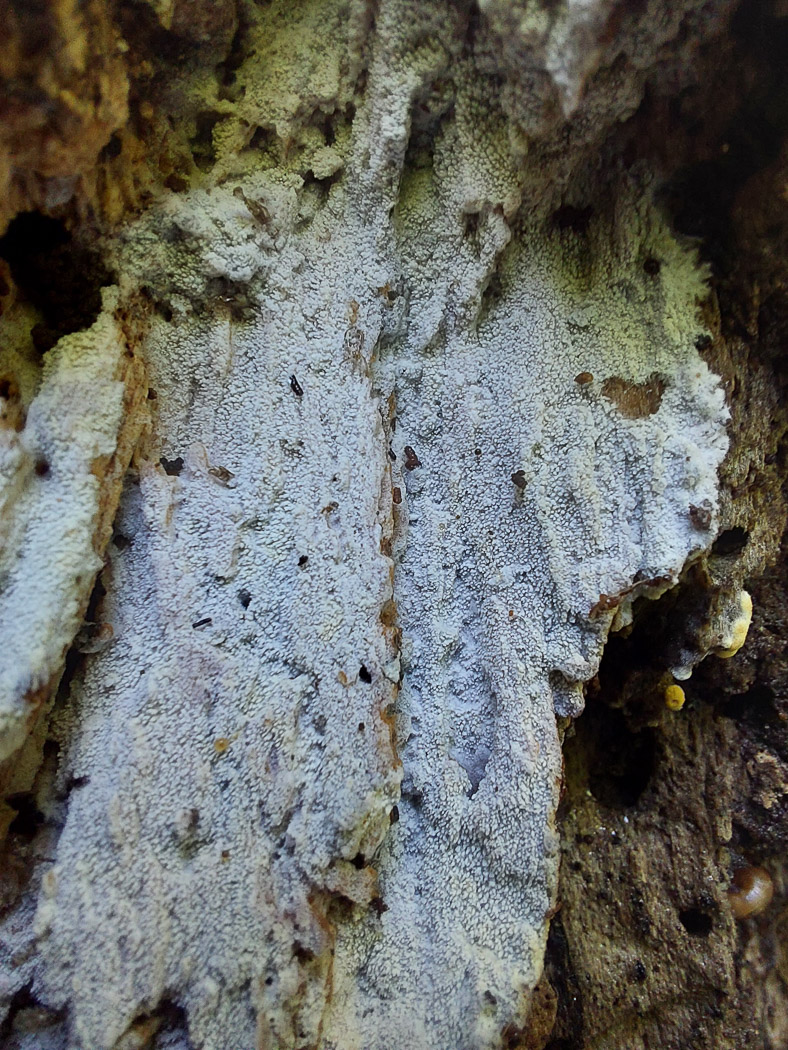 |
Trechispora farinacea (a corticioid with no English name) 
May 7, 2024. On some rotten deciduous wood at Pulpit Hill Jesper Launder noticed this patch of corticioid and was able to identify it later - the species has very distinctive spiny spores which helps to put one on the right path by eliminating many other possible similar species. Though a new entry for Finds this is a common species and we have records from quite a few different county sites.
|



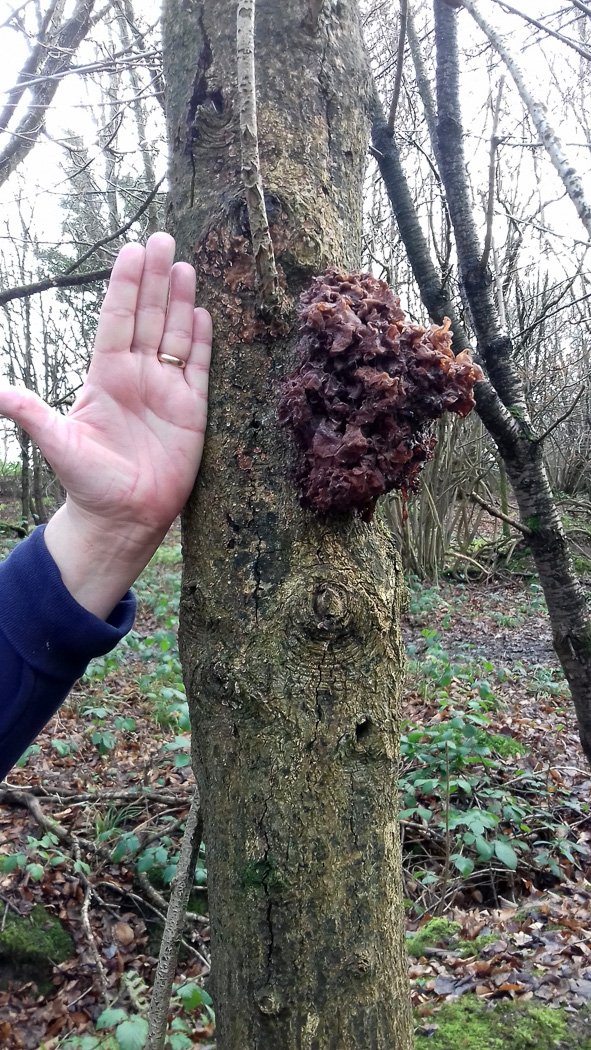
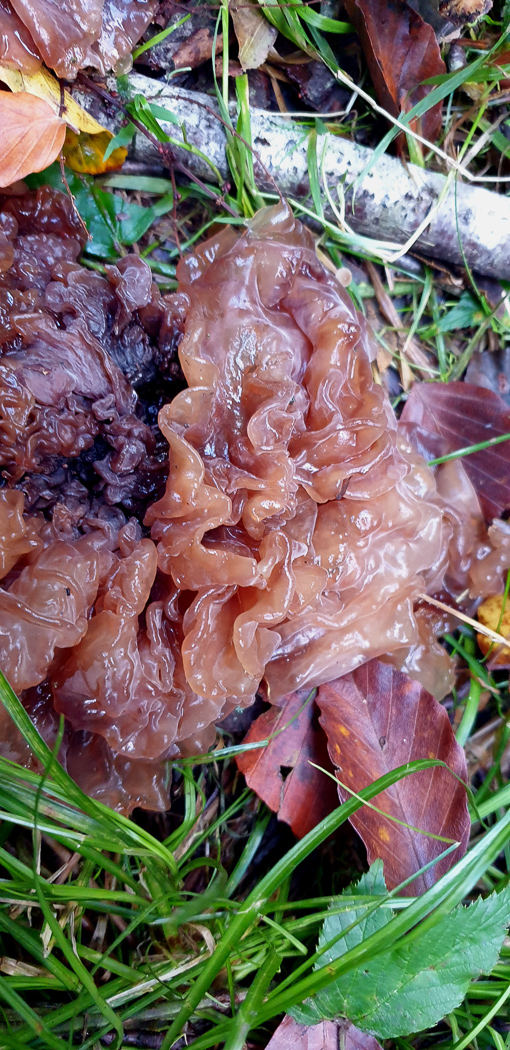
|
Tremella foliacea (Leafy Brain) 
Mar 19, 2023. In Turville Heath Penny came across a fallen branch, possibly Hawthorn, with several fresh clumps of this jelly fungus - similar to Exidia in texture but forming a wider gelatinous mass than that genus (the spores are a very different shape also).
Jan 13, 2022. In Hills Wood, south of Frieth, Andrew and Lisa Dodd noticed this large gelatinous lump at head height on a deciduous trunk and wondered what it was. Recognisable from Andrew's photo, this is quite a common jelly fungus, several different species of which have been found recently and seem to be fruiting happily at present.
Oct 11, 2020. Justin Warhurst found this jelly fungus on wood in Penn Wood. Though not visible here, this would have been growing on another wood inhabiting fungus, probably the common Stereum hirsutum, which it is now known to parasitise. It is quite common and can get to about 10 cms and when young and much smaller could be possibly be confused with the Ascomycete Neobulgaria pura.
|



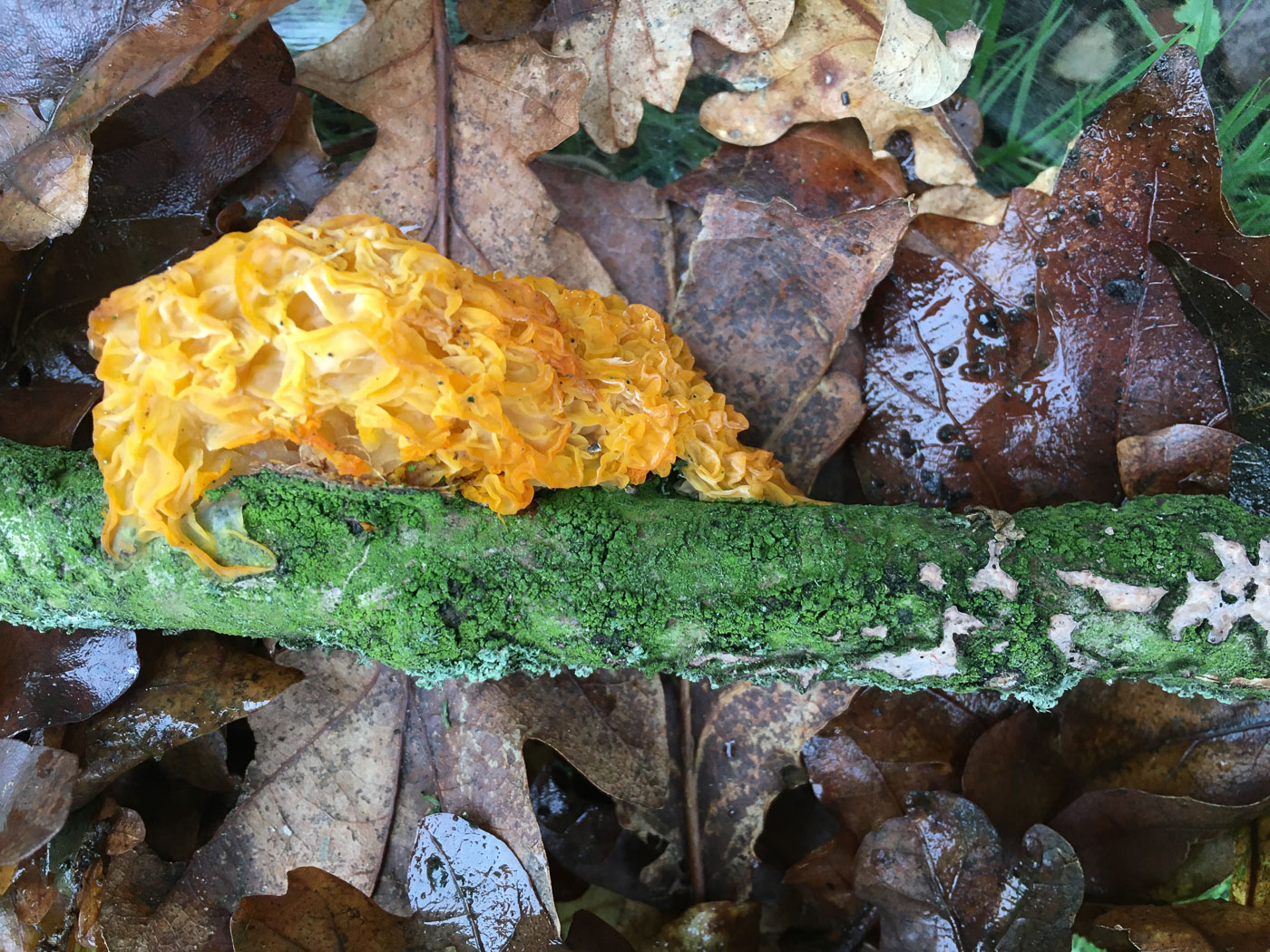
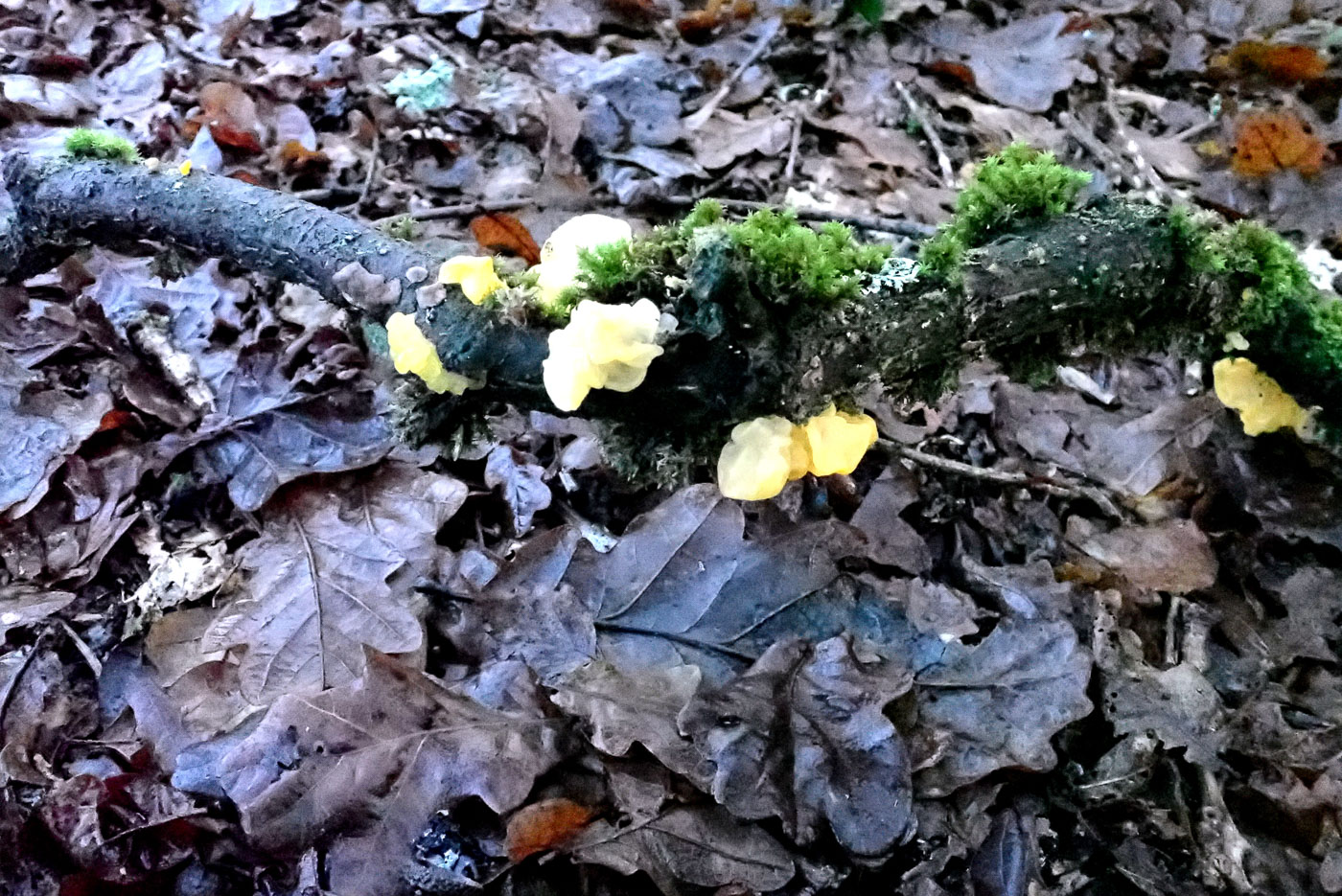
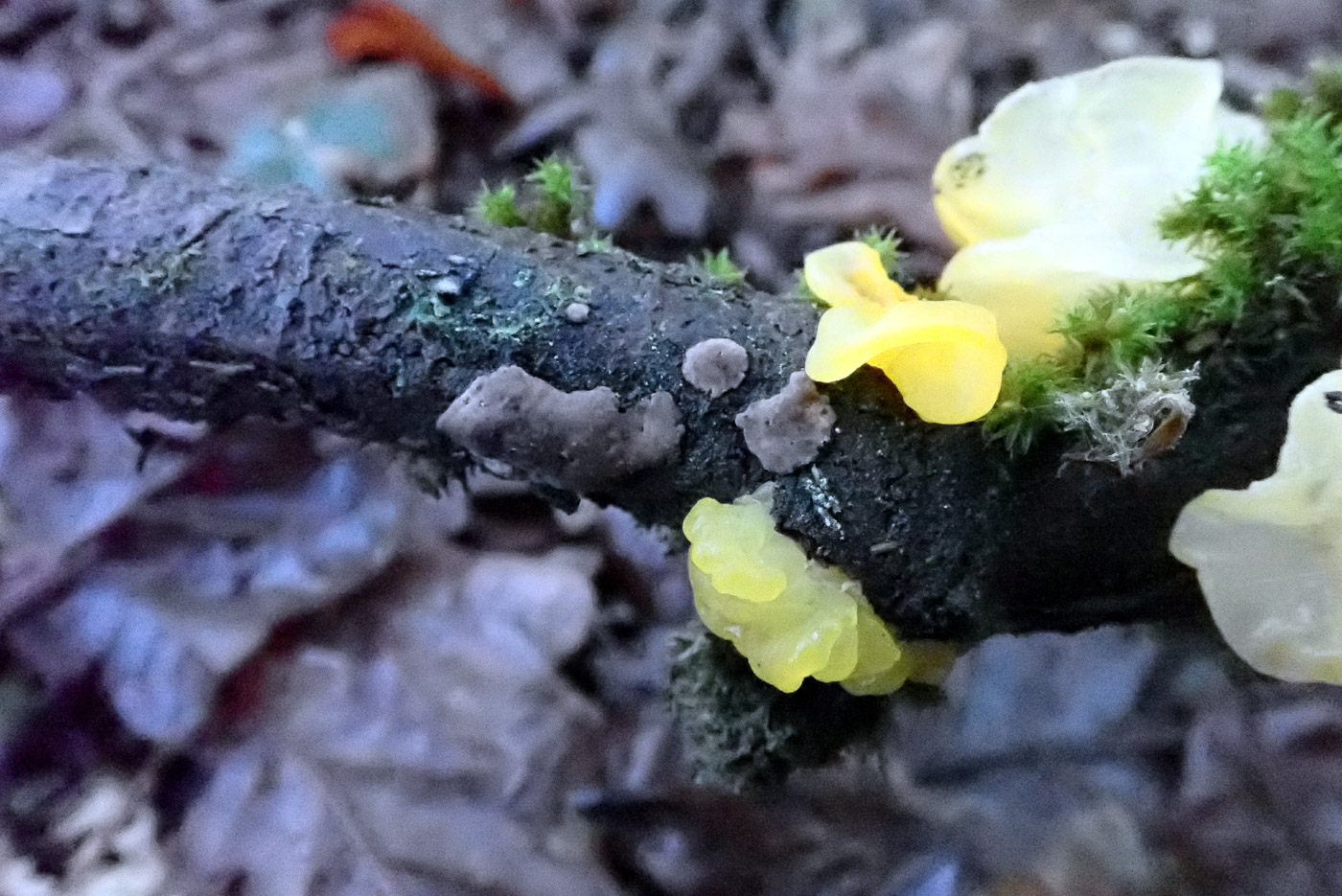
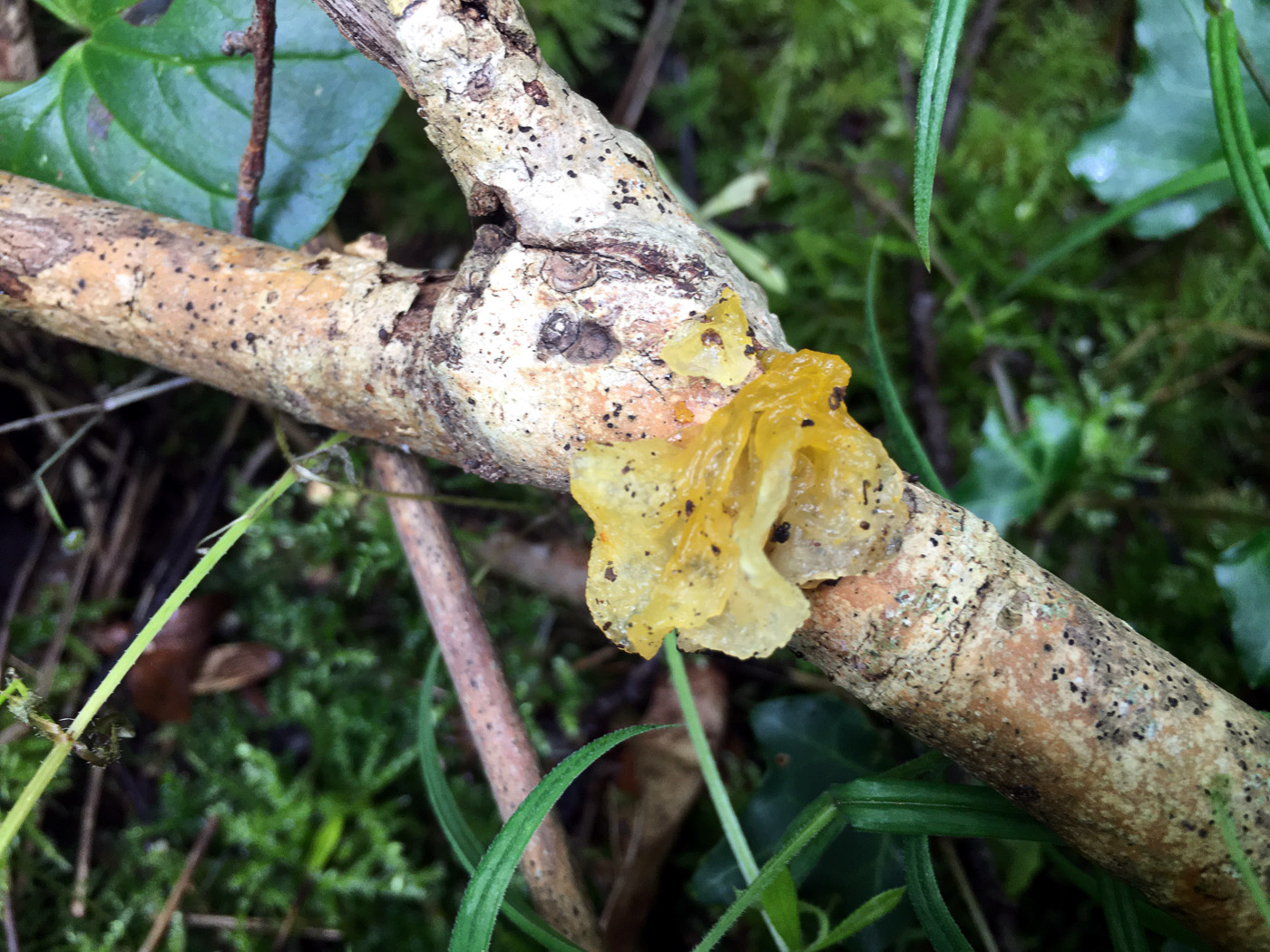
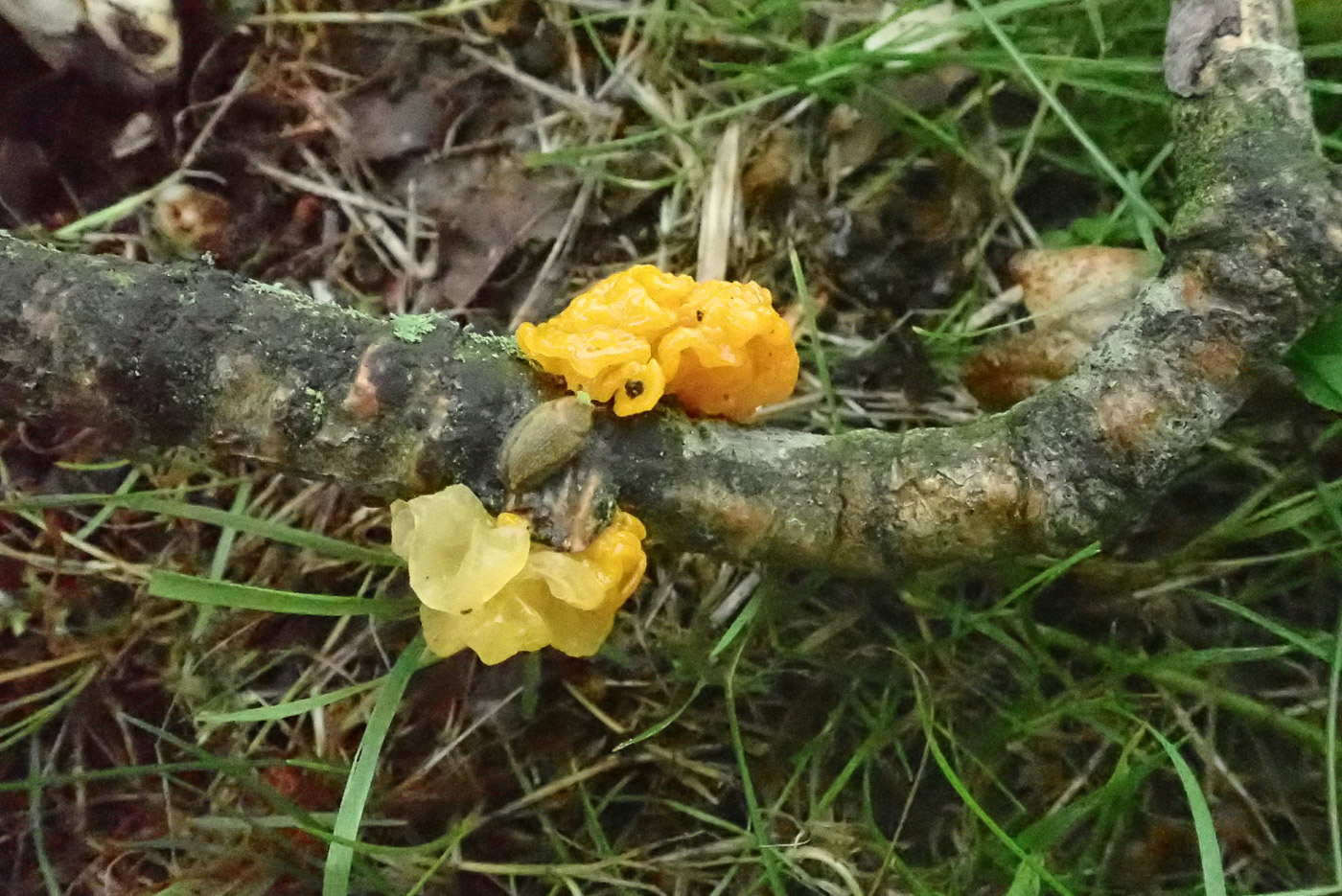
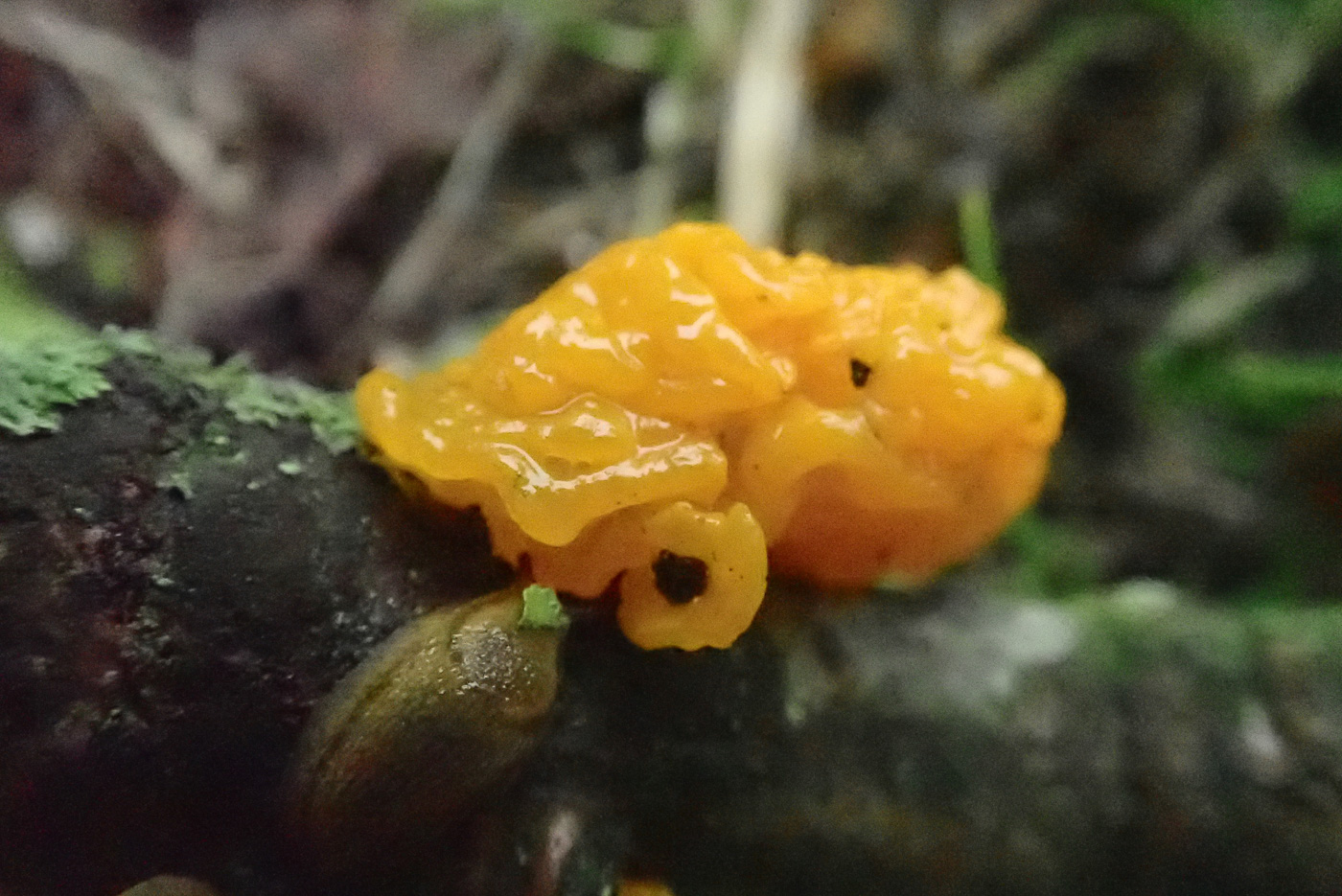
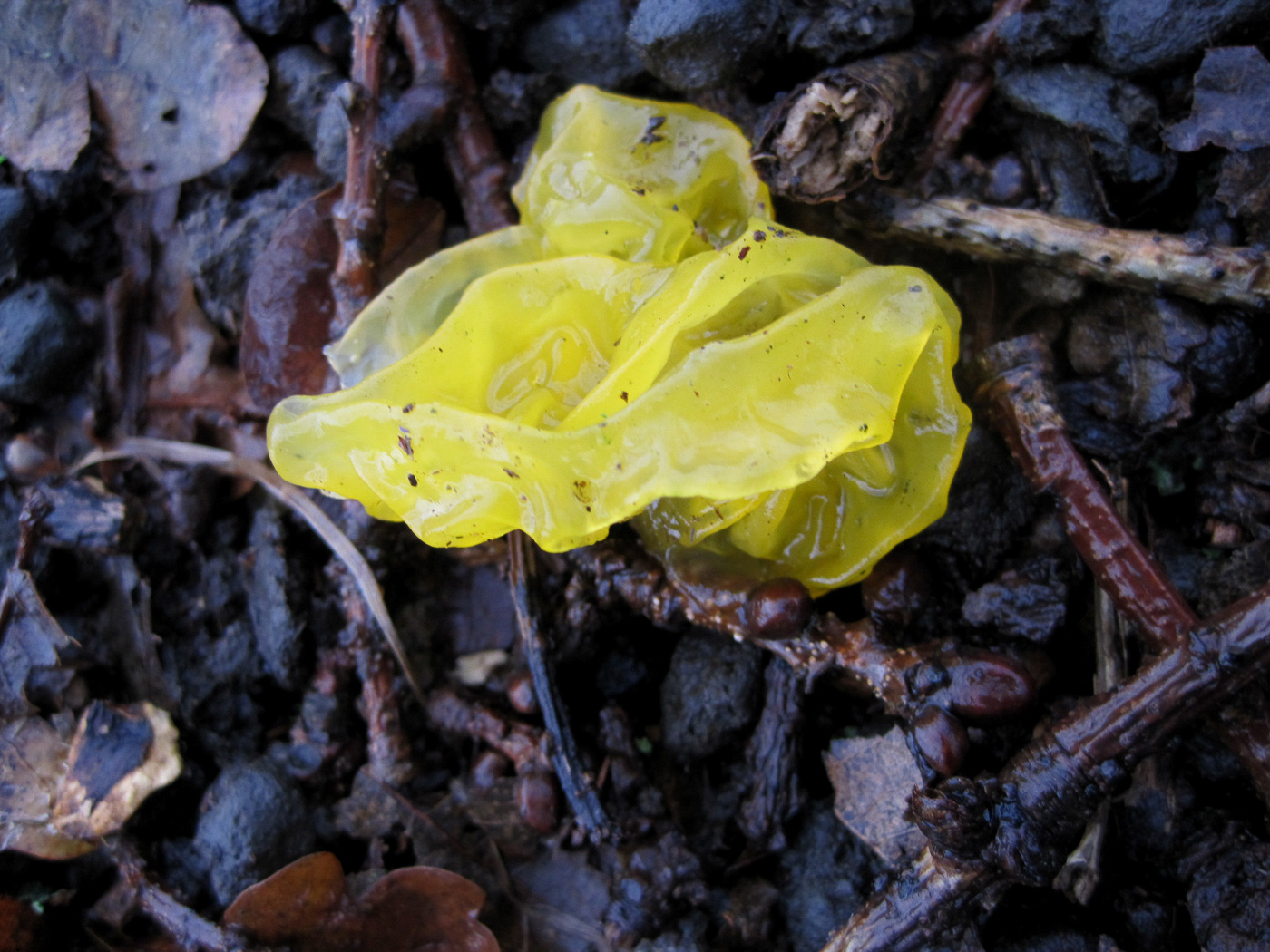
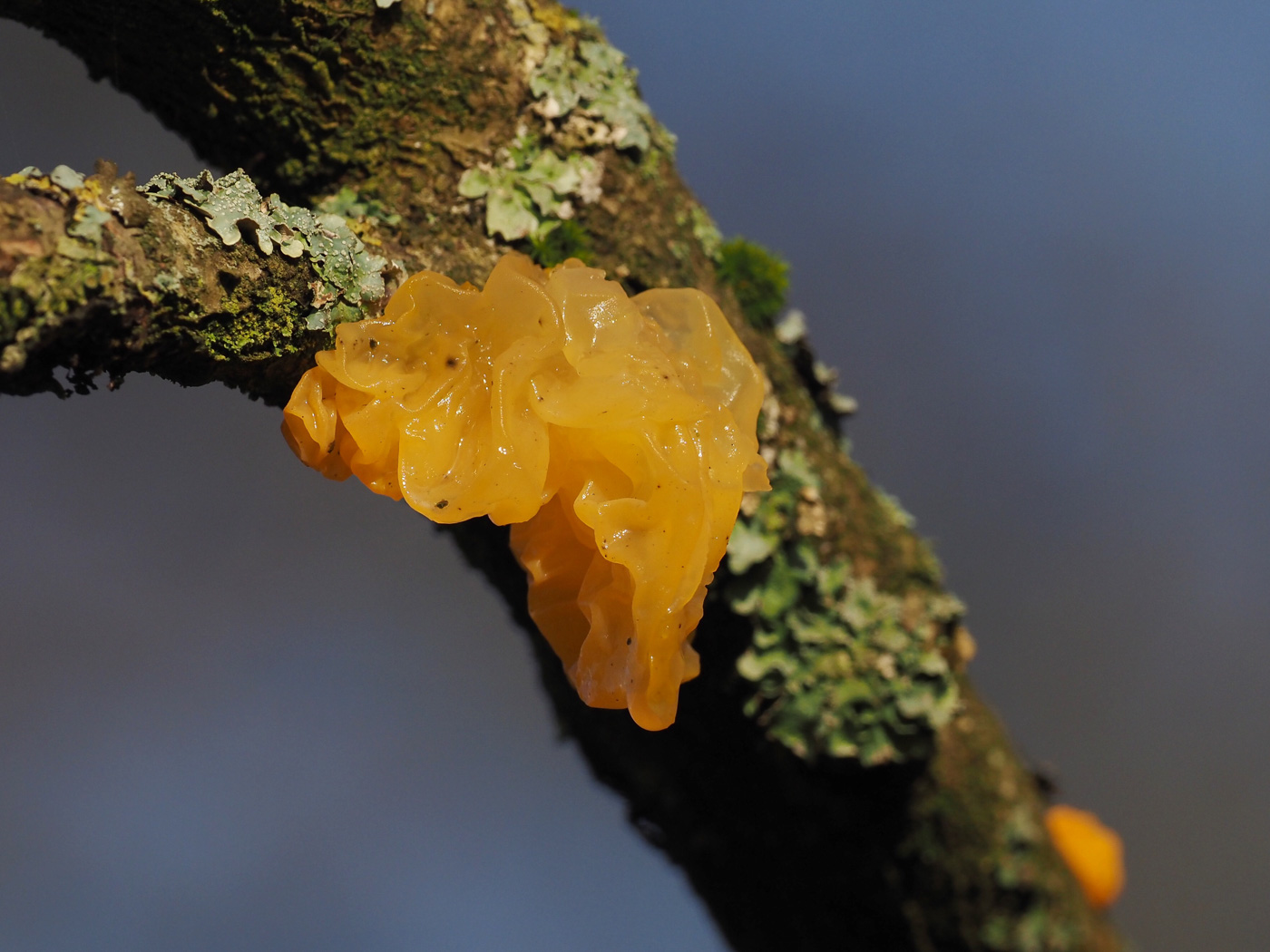
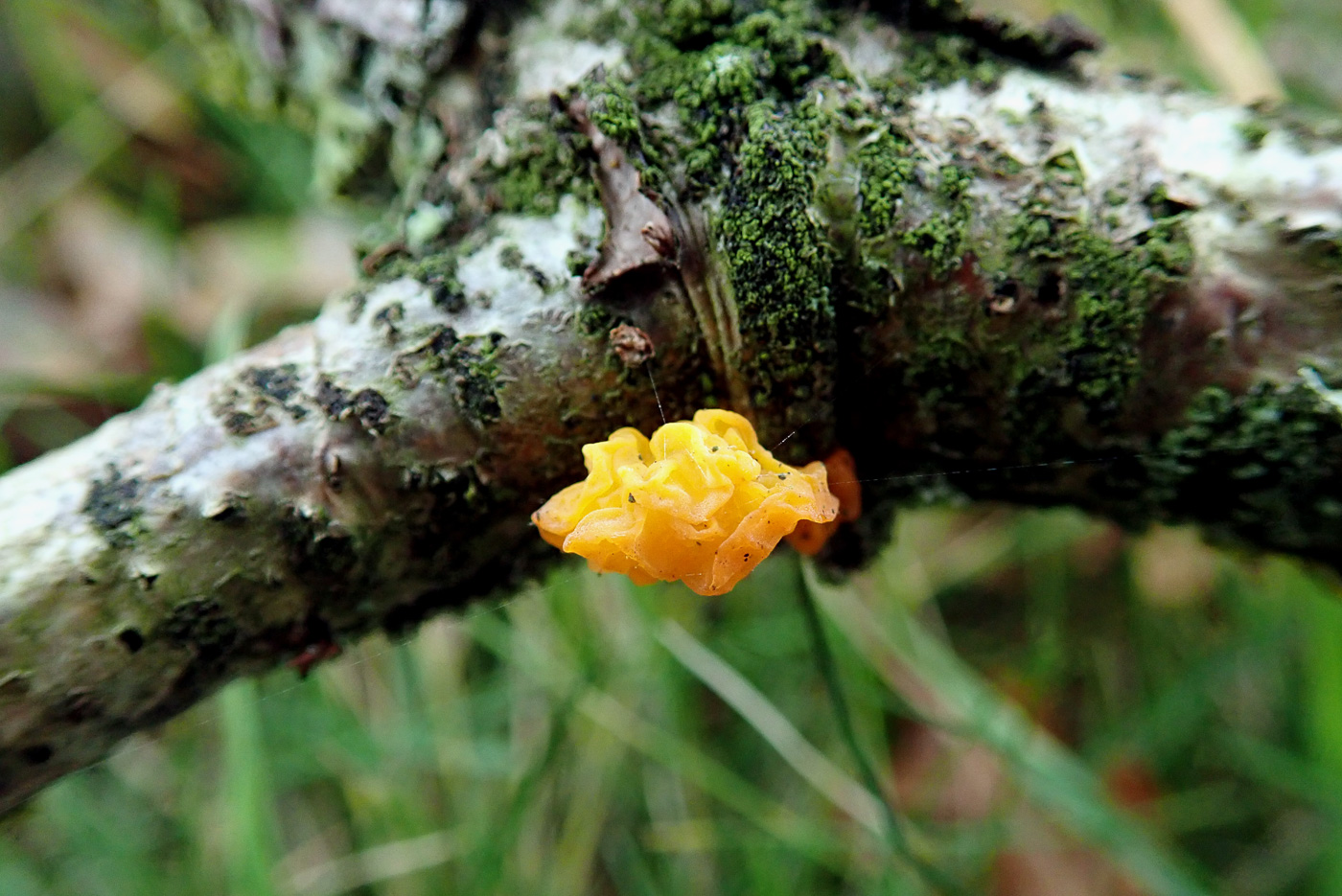
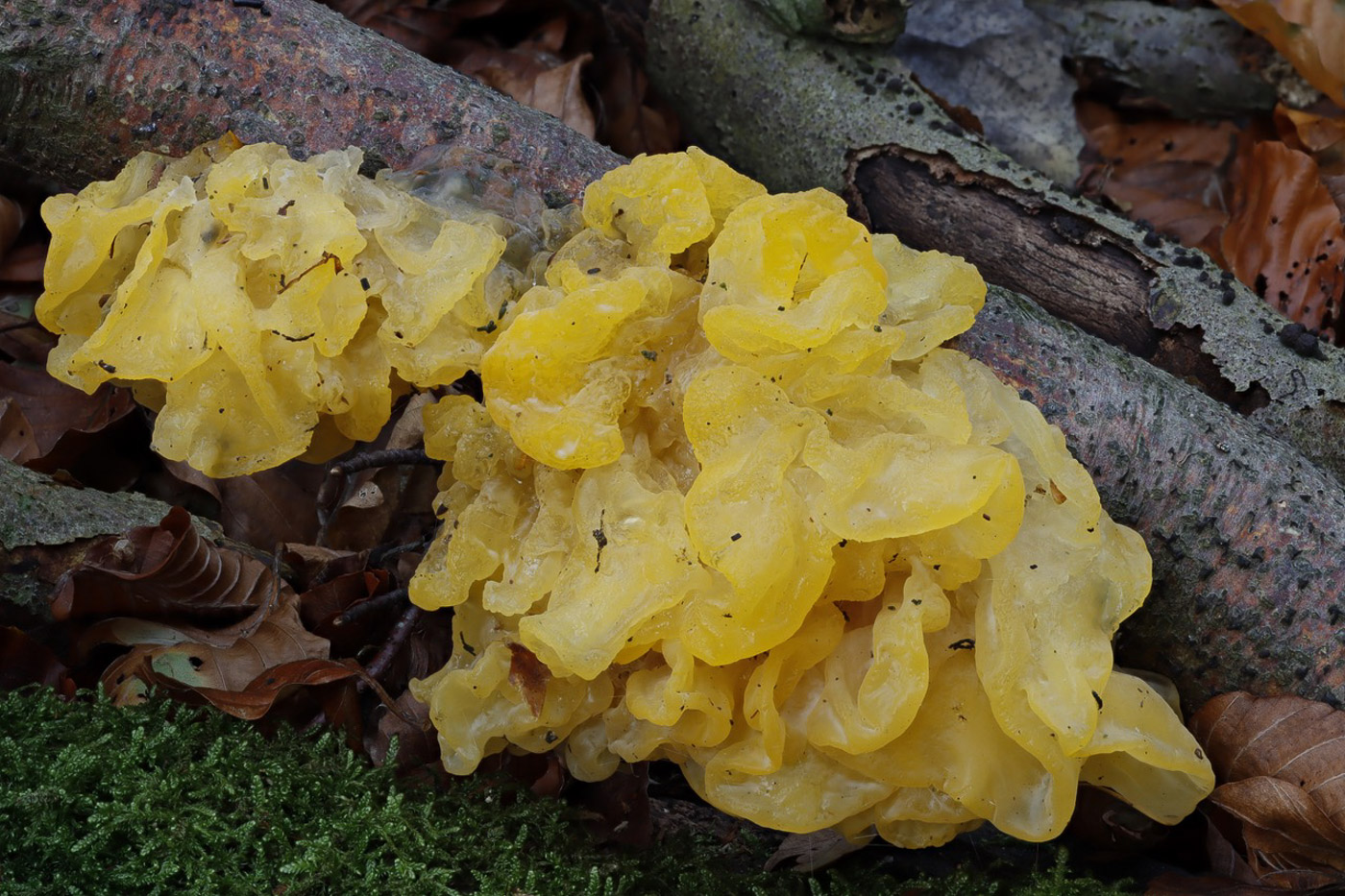
|
Tremella mesenterica (Yellow Brain)
Jan 12, 2024. In Naphill Common on a fallen mossy stick (likely to be Oak) Claire Williams noticed this brightly colour jelly fungus. Often fruiting in winter, this is a common and distinctive species which is unlikely to be confused with anything else.
Mar 18, 2023. We've had a spate of jelly fungi photos in the last week or so. Here's another one, found by Bob Simpson in Salden Wood fruiting on fallen Hazel twigs. Compare with T. foliacea and with species of Exidia - all found recently and with further images available via the Masterlist.
Jan 10, 2022. On a fallen deciduous branch in Brill Common Joanna spotted this gelatinous yellow lump which, as it looked a bit different from usual to her, she took home and checked. She then discovered that the species is parasitic on the mycelium of the corticioid genus Peniophora (though the fruiting body not always visible) and sure enough there is indeed some dried up Peniophora nearby in her photo. Photos 2 and 3 are of Penny's collection on fallen Oak in Burnham Beeches a week later where also some Peniophora is visible nearby. (See also Finds 2021 dated July 8th.) It is worth noting that if you find this species growing on Stereum hirsutum rather than on Peniophora, you may have the very similar but rarely recorded Tremella aurantia!
Jul 8, 2021. In Rushbeds Wood Joanna Dodsworth noticed this brightly coloured jelly fungus on a fallen deciduous stick - possibly Ash rather than Oak, it's commonest host. Photos 2 and 3 are Penny's from another collection made three weeks later on a fallen Oak twig at Cadmore End. The species can also quite often be found on Gorse which sounds an unlikely host for a species mainly associated with deciduous wood.
Jan 14, 2021. This species was spotted by Joanna Dodsworth on a pile of deciduous sticks in Brill Common (photo 1) and also by Claire Williams the following day on an Oak stick in Downley Common (photo 2). Jelly fungi seem to be unhindered by the winter weather: we have examples of several species found in the last couple of weeks.
Oct 30, 2020. This is another species making rather a late appearance, found today on a fallen Oak stick at Coombe Hill by Penny C. Sadly only a small specimen but big enough to show the striking yellow colour and typical lumpy gelatinous surface. So another species to look out for now, often found on Oak and also, perhaps surprisingly, on Gorse. Photo 2, however, is of a more mature collection found on fallen Beech in Bradenham Woods, taken by Paul Goby on November 9th.
|





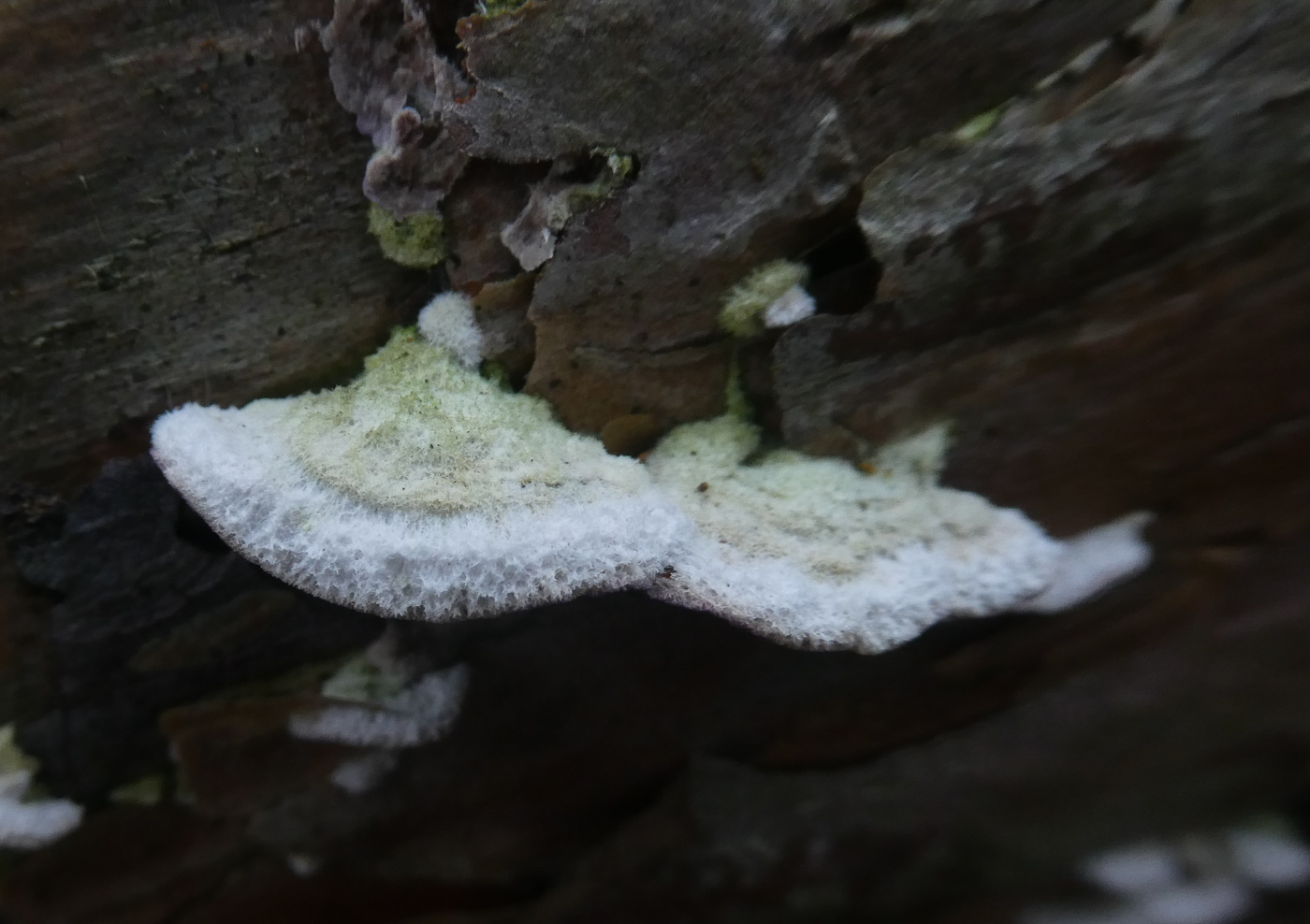
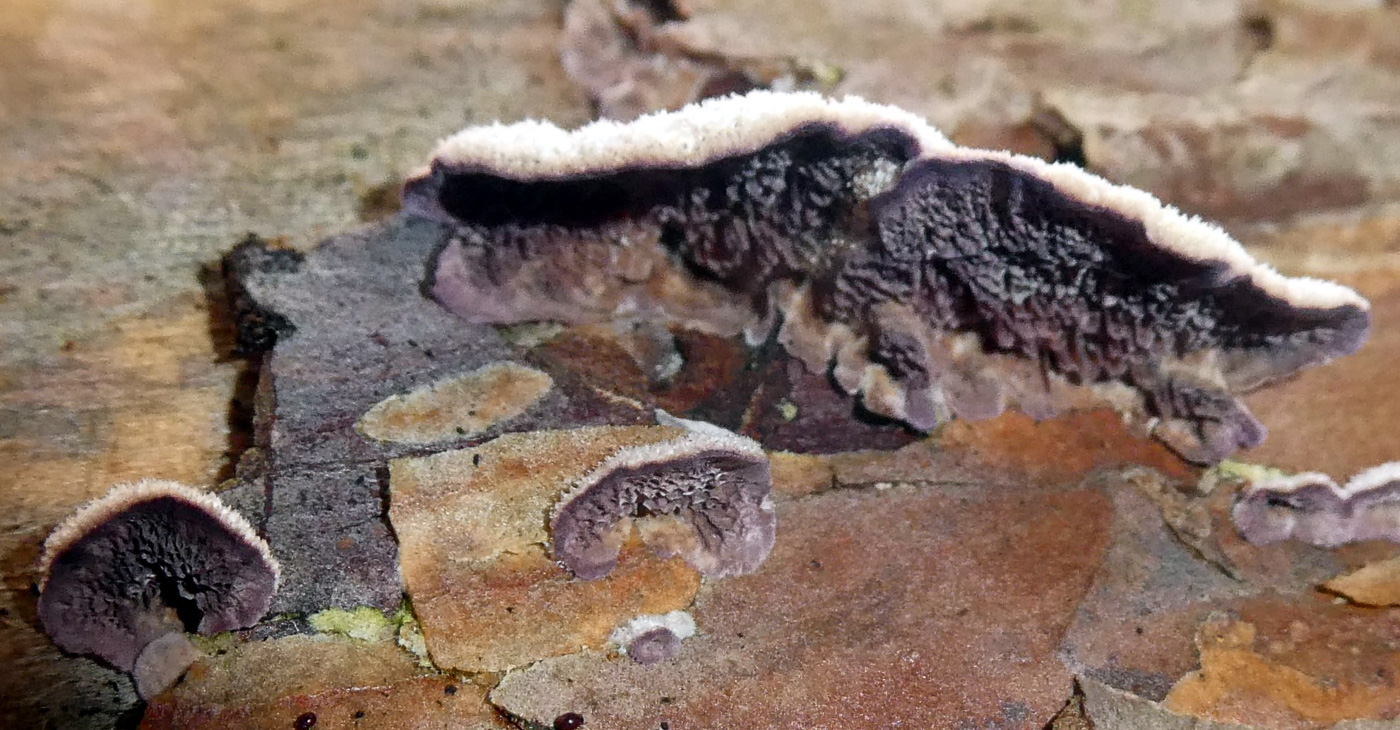
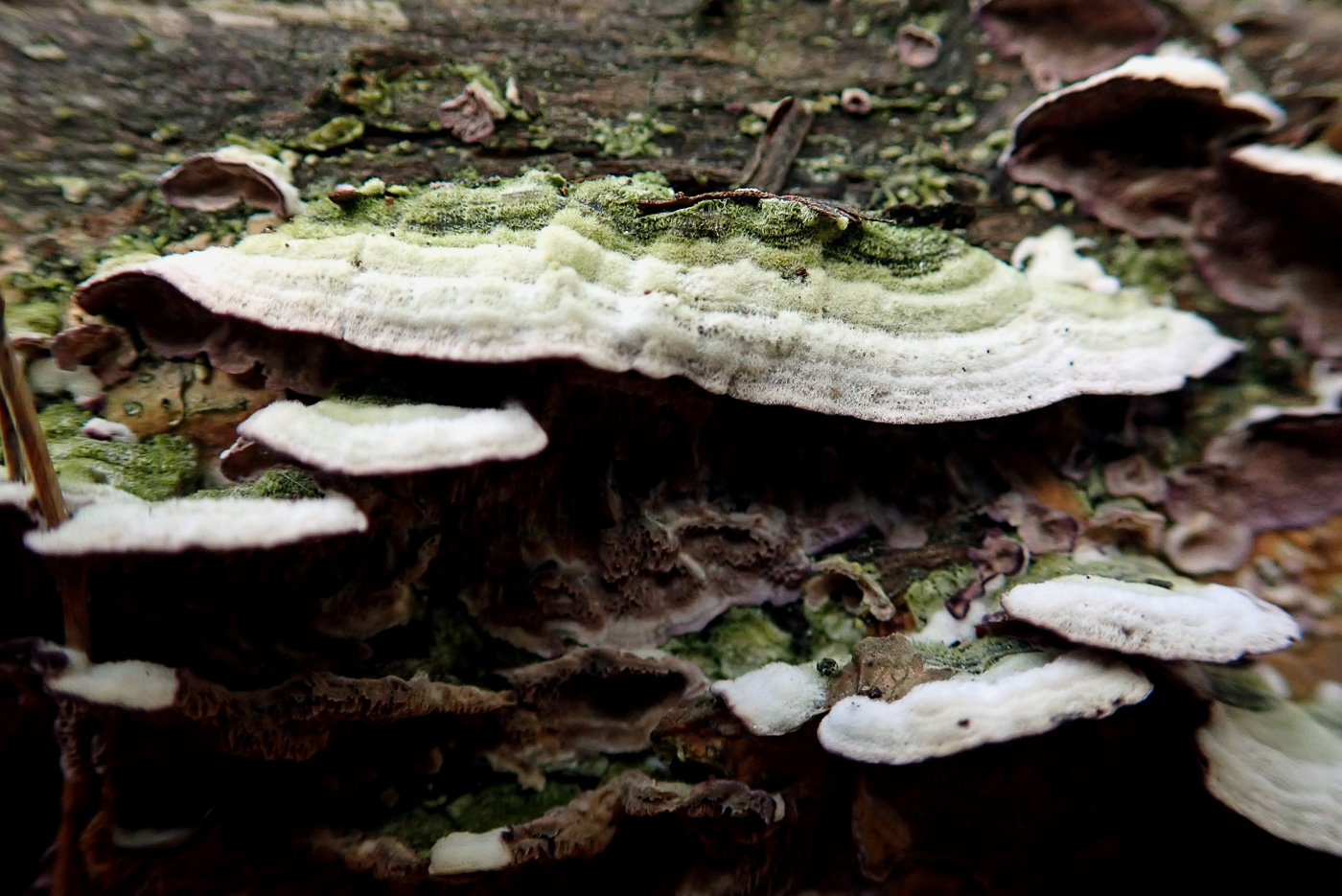
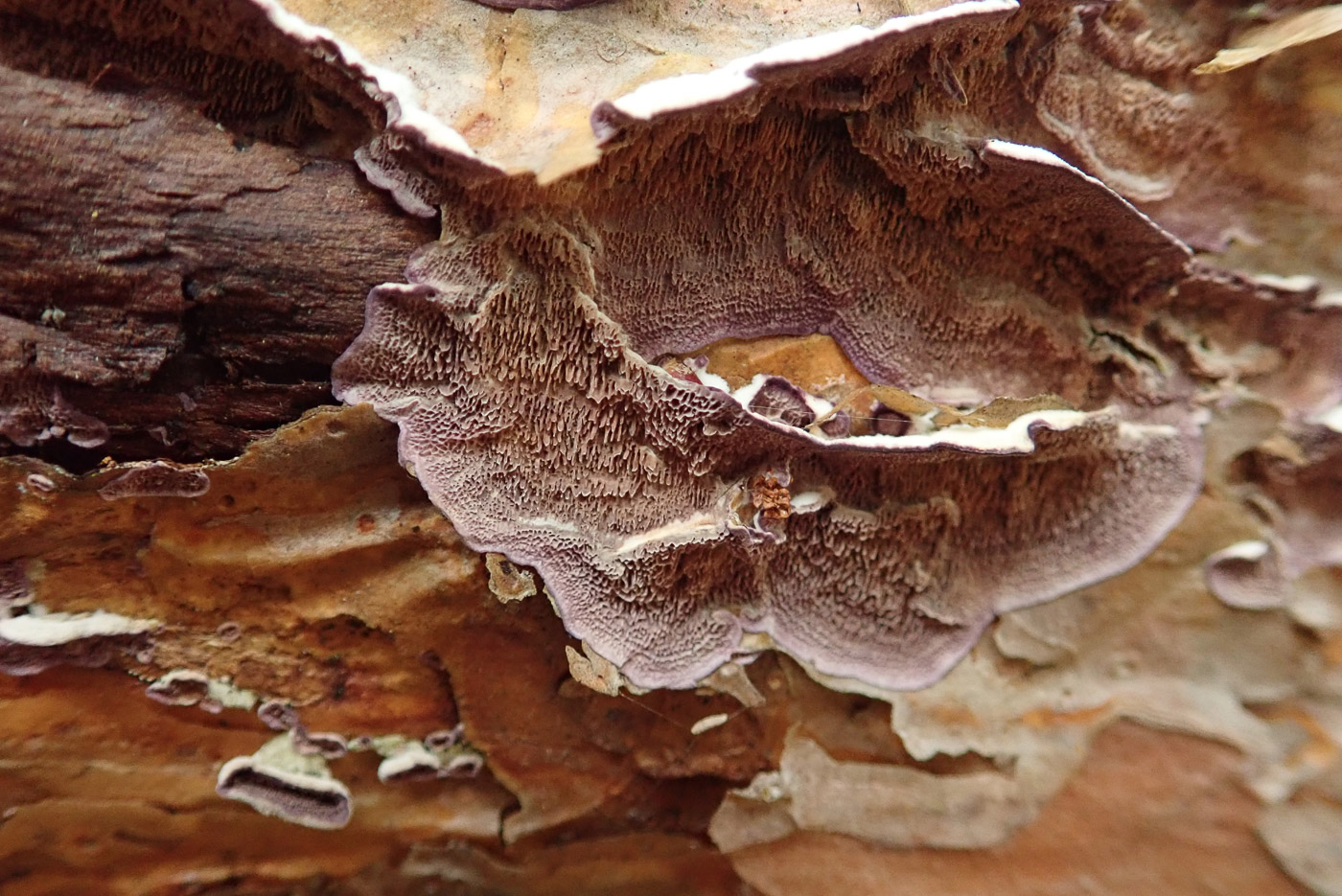
|
Trichaptum abietinum (Purplepore Bracket)
Jan 15, 2024. At Stoke Common Jim Wills found this small and quite common bracket on bare felled Pine. It tends to form colonies of tight lines along the wood, becomes pale and washed out above but the pores beneath are rather jagged and irregular and distinctly violet, especially when fresh. It occurs only on conifer whereas the quite similar Chondrostereum purpureum (also violet underneath, inhabits deciduous wood.
Jan 8, 2023. At Burnham Beeches Penny spotted some small brackets at the base of a bare Pine log (photo 1) and turned it over to confirm the purple tinged underside of this common conifer species. It was spreading partly resupinate along the log (including over the deciduous stick crossing it), and the typical small brackets had developed right at the end. Despite its name suggesting an association specifically with Fir, it is in fact equally common on any dying or fallen conifer.
Jan 1, 2022. At Stoke Common Jim Wills found this common small bracket which grows on fallen conifer.
Nov 7, 2020. On the quantities of felled Pine at Stoke Common Penny C. found this species everywhere. It forms large colonies of small whitish hairy brackets (only on fallen conifer) and the underside has violet purple pores, hence its common name. Do not confuse with the somewhat similar Chondrostereum purpureum (see photos and notes dated Nov 06, also today as well) which from above is almost identical but the underside, though purple, is smooth and not pored as in today's species. It occurs on deciduous wood, commonly Birch, never conifer.
|
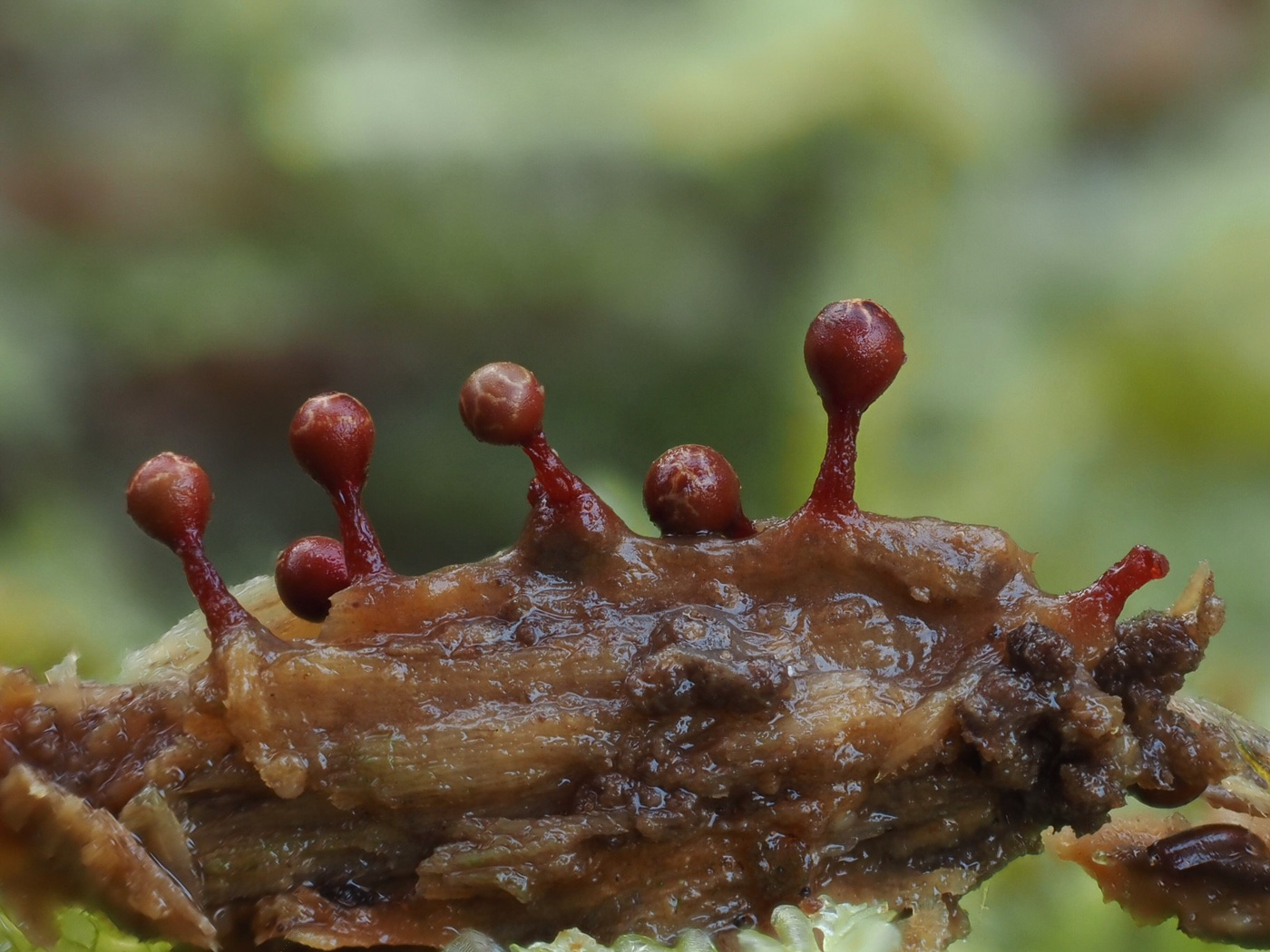
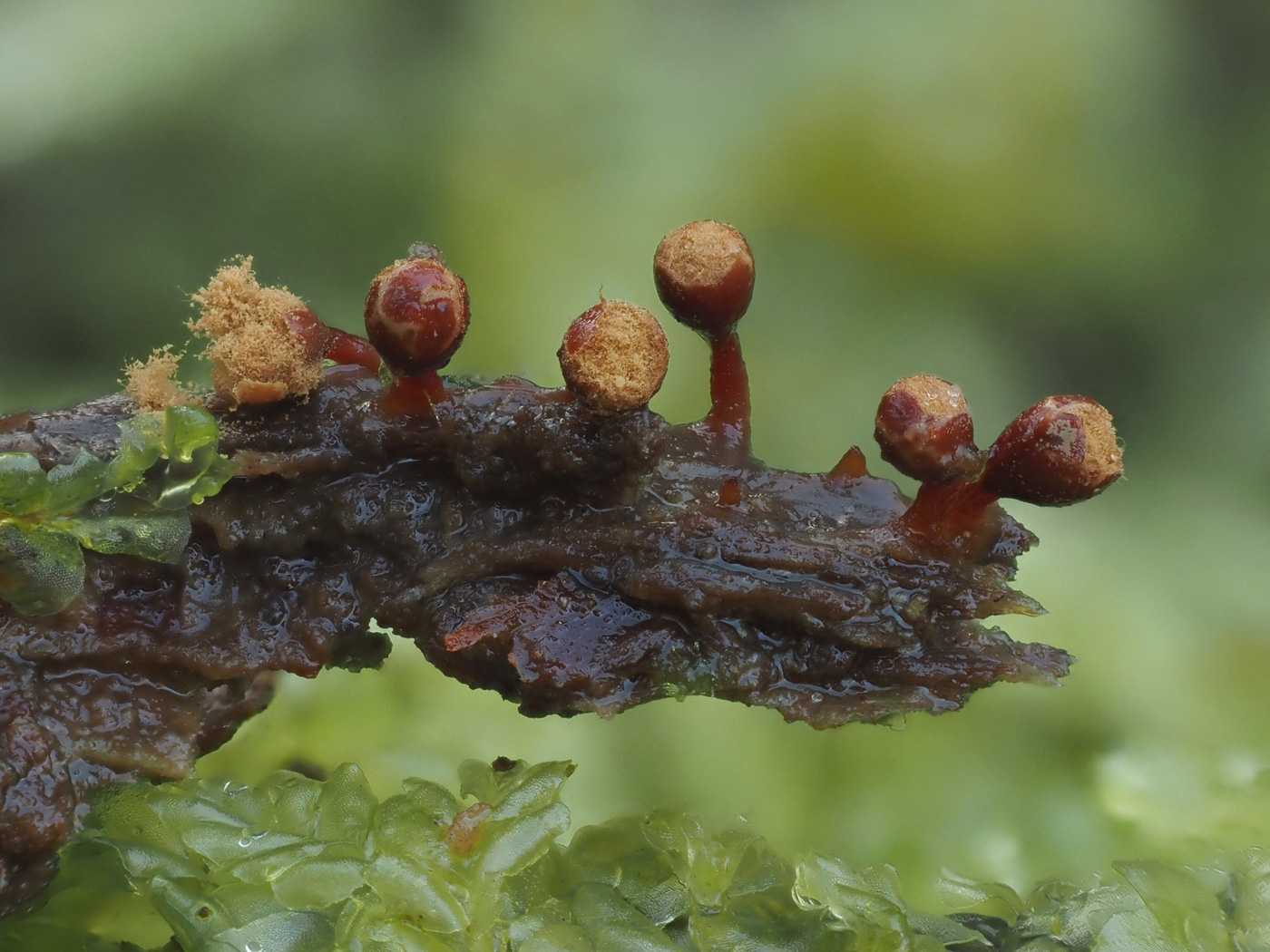
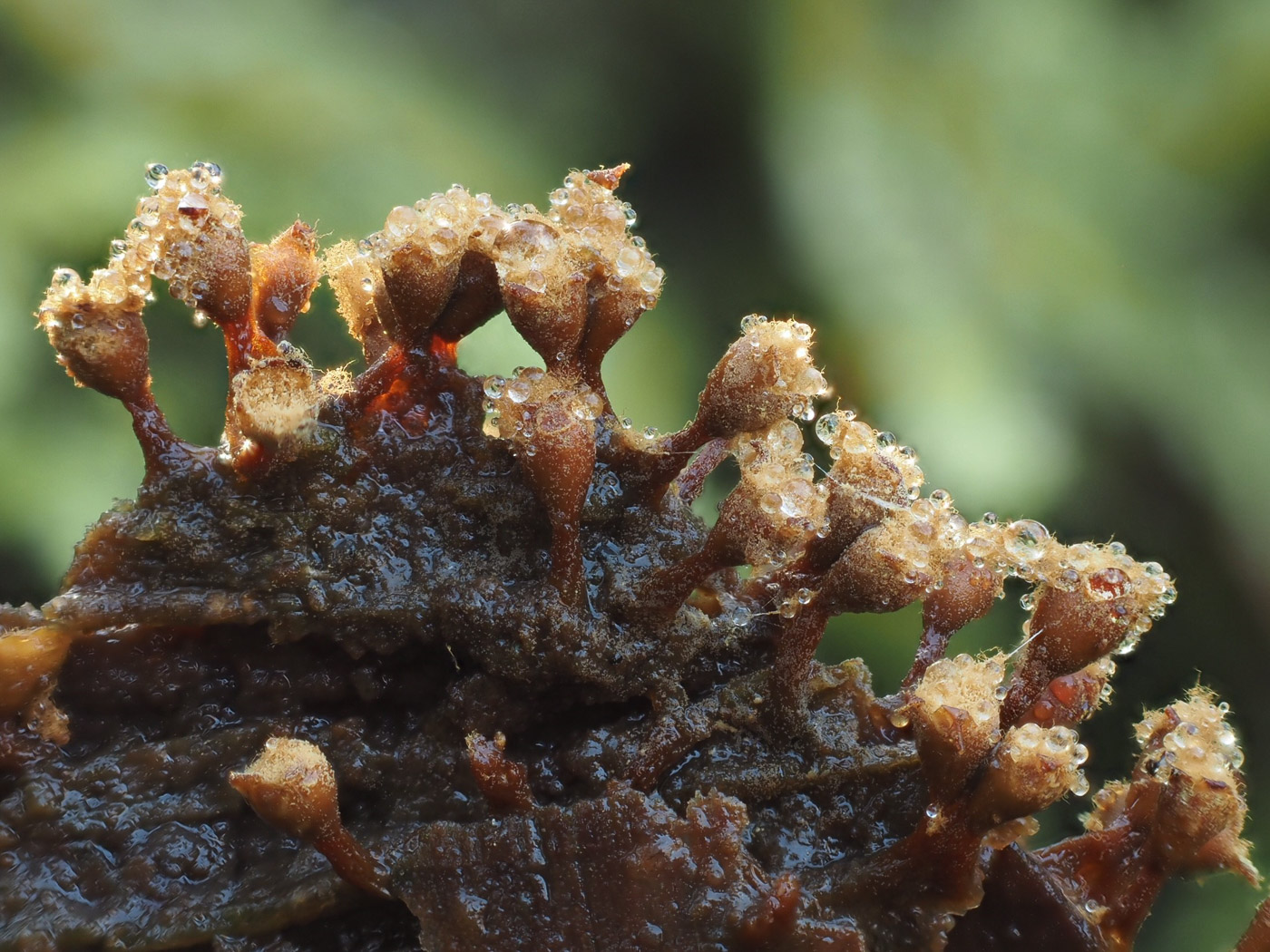
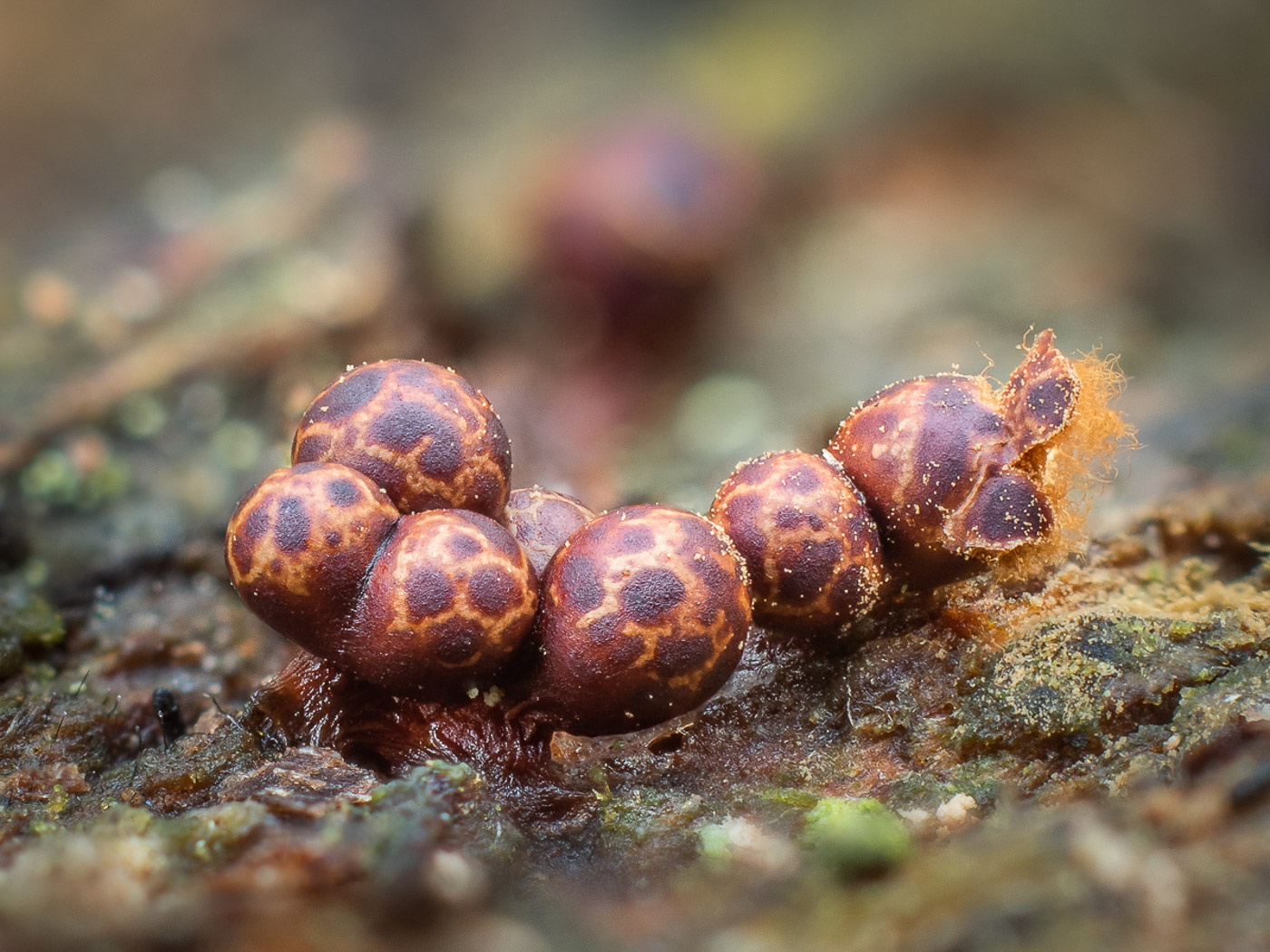
|
Trichia botrytis (a Slime Mould with no common name)
Jan 12, 2022. In Naphill Common Barry Webb found this tiny slime mould on fallen wood (the photo is by Claire Williams).The photos show three stages of development - this not being unusual to find occurring together in one colony of slime moulds. See also on Barry's page in Finds.
Nov 21, 2020. In Penn Wood Barry Webb found this cluster of tiny specimens fruiting on fallen Oak. There are many species of Trichia and a scope is nearly always needed to name them but the very distinctive mottled markings seen here are enough to separate it from others.
|

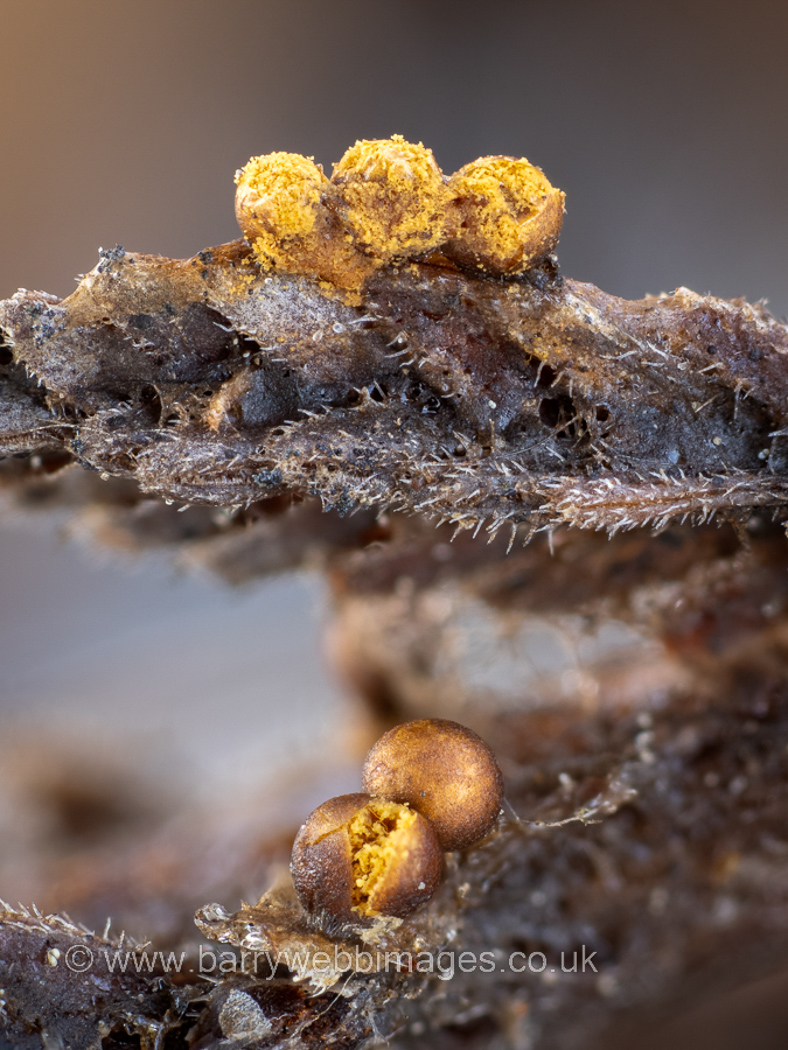 |
Trichia contorta var. attenuata (a rare Slime Mould with no common name) 
Dec 14, 2022. Barry Webb noticed this tiny species growing low down on live Heather stems at Stoke Common with snow still on the ground. He then sent both macro and micro photos to Myxomycete expert Edvin Johannesen who was able to identify it straight away from his images. We have two previous county records for T. contorta var. contorta but this is a first for this very rare variety for which there appear to be extremely few national records.
|
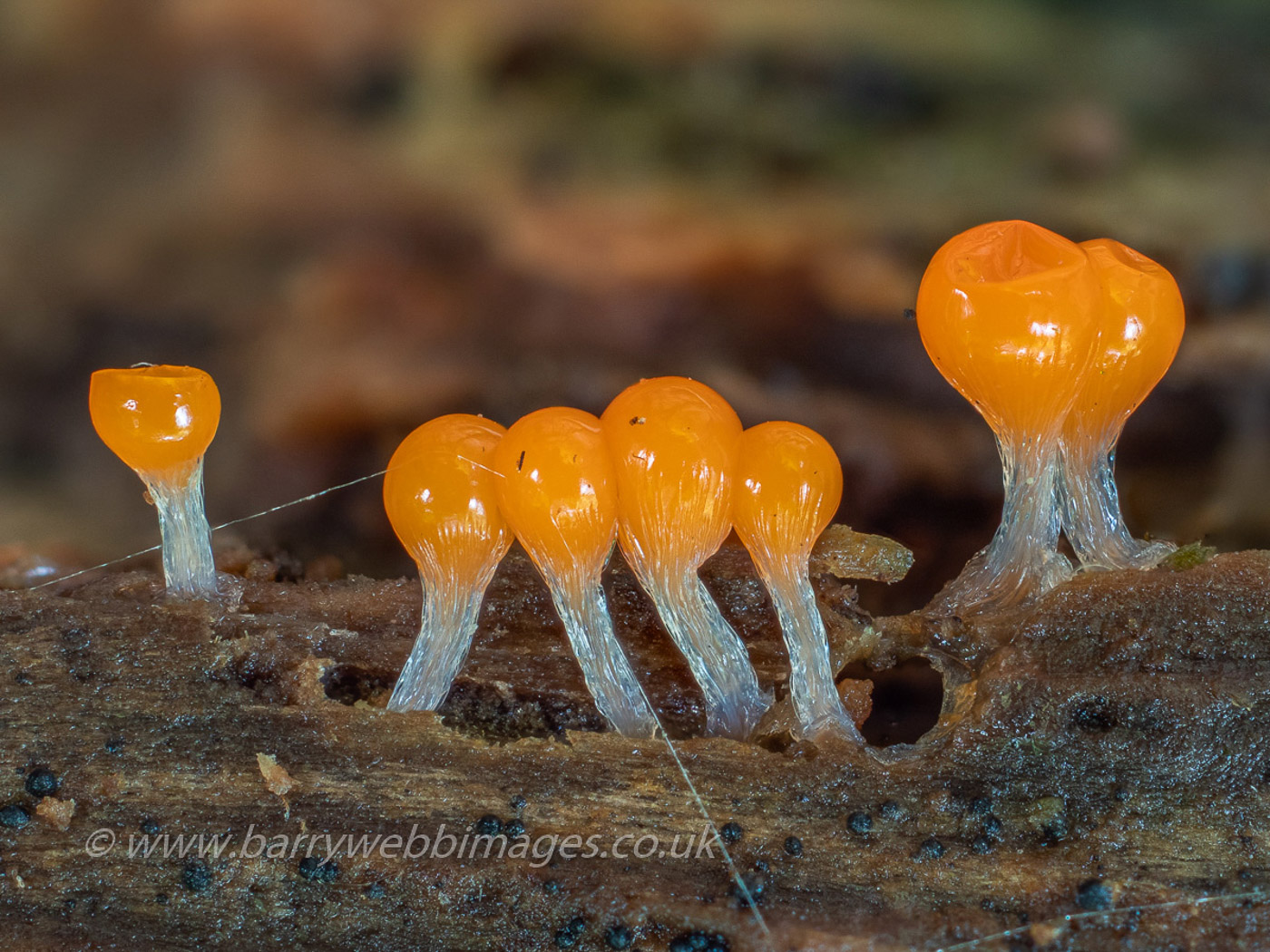 |
Trichia decipiens (a Slime Mould with no common name)
Oct 19, 2020. Barry Webb found these tiny orange blobs on stalks on rotting fallen Beech in Burnham Beeches. Most Slime Moulds have white plasmodium at this immature stage when identification even to genus is not possible, but a few species have brightly coloured plasmodium and can be named. There are many species of the genus Trichia but only this particular species has white stalks with orange to pink blobs on top. We'll try and add photos of its mature stage if / when available.
|
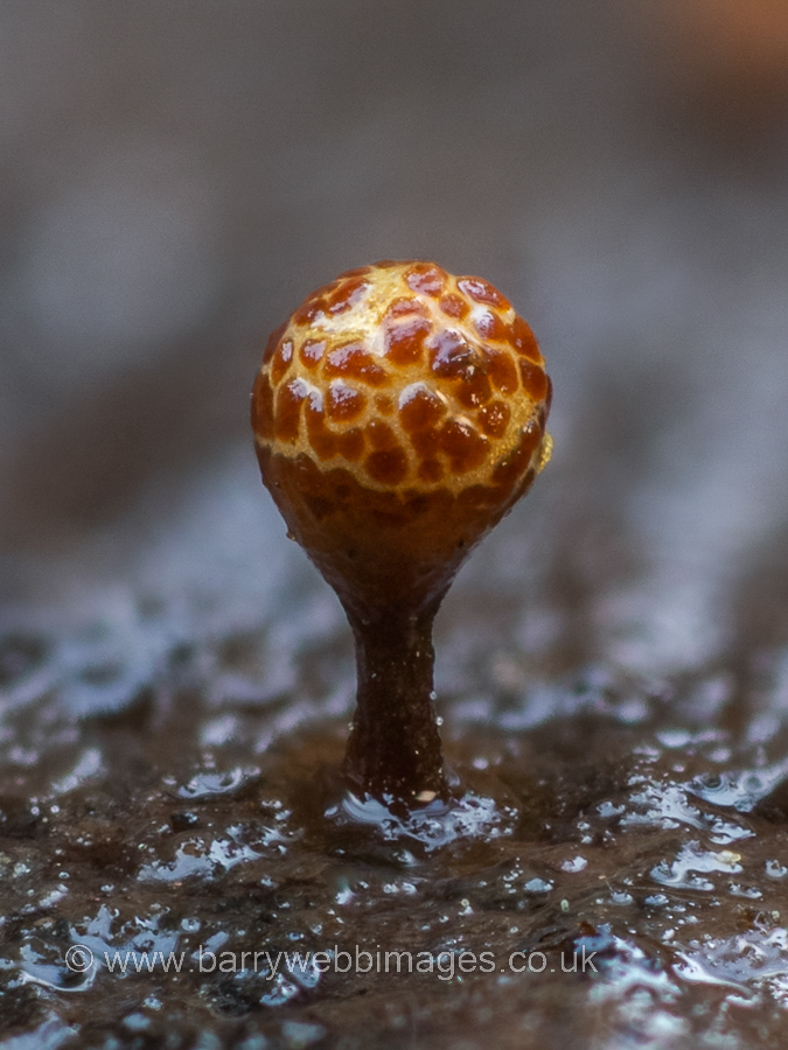 |
Trichia flavicoma (a rare slime mould with no common name) 
Dec 24, 2022. On a pile of old prunings (Osmanthus, Laurel, Yew) at Hedgerley Green Barry Webb spotted this really tiny species - less that 1mm tall. It is rarely recorded (no doubt due to its miniscule size) and is new to the county. Barry's identification was confirmed when he sent both macro- and microphotos to expert Edvin Johannesen.
|
 |
Trichia favoginea (a rare Slime Mould with no common name) 
Sep 22, 2023. On fallen rotten Birch at Burnham Beeches Barry Webb found this rare species, one that Penny has never seen. It is a typical member of the genus Trichia, ie when mature as here forming tiny yellow tightly clustered blobs, but has virtually no stalk and unusually is more cylindrical than round. On the lowest four sporangia at the far right can be seen how they burst open to release spores which are held amongst many 'elaters' - tiny long snaking strands, the shape, width and spiral markings of which are useful tools in identification under the scope. This was an nice find and is new to the county with not that many national records.
|
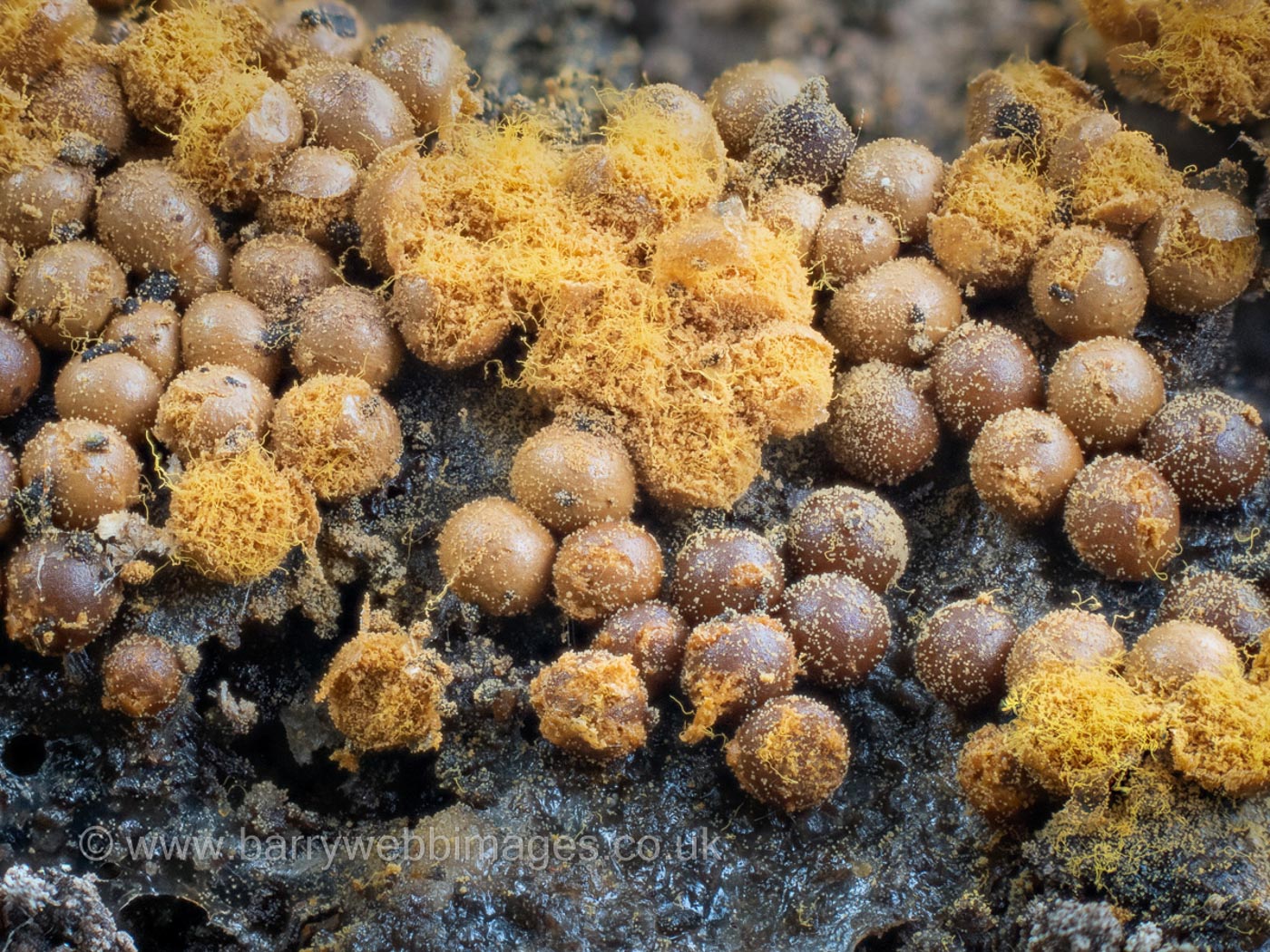 |
Trichia varia  (a Slime Mould with no common name) (a Slime Mould with no common name)
Jul 28, 2021. In Burnham Beeches on damp rotting deciduous wood Barry Webb found a colony of one of the commonest species of Trichia which was mature enough for Penny to be able to identify at home. This is genus with many somewhat similar species, most of which start out as a small patch of white blobby plasmodium which gradually turns yellow then dries off to form tight clusters of sporangia, some species with a short stalk, some without as here.
|
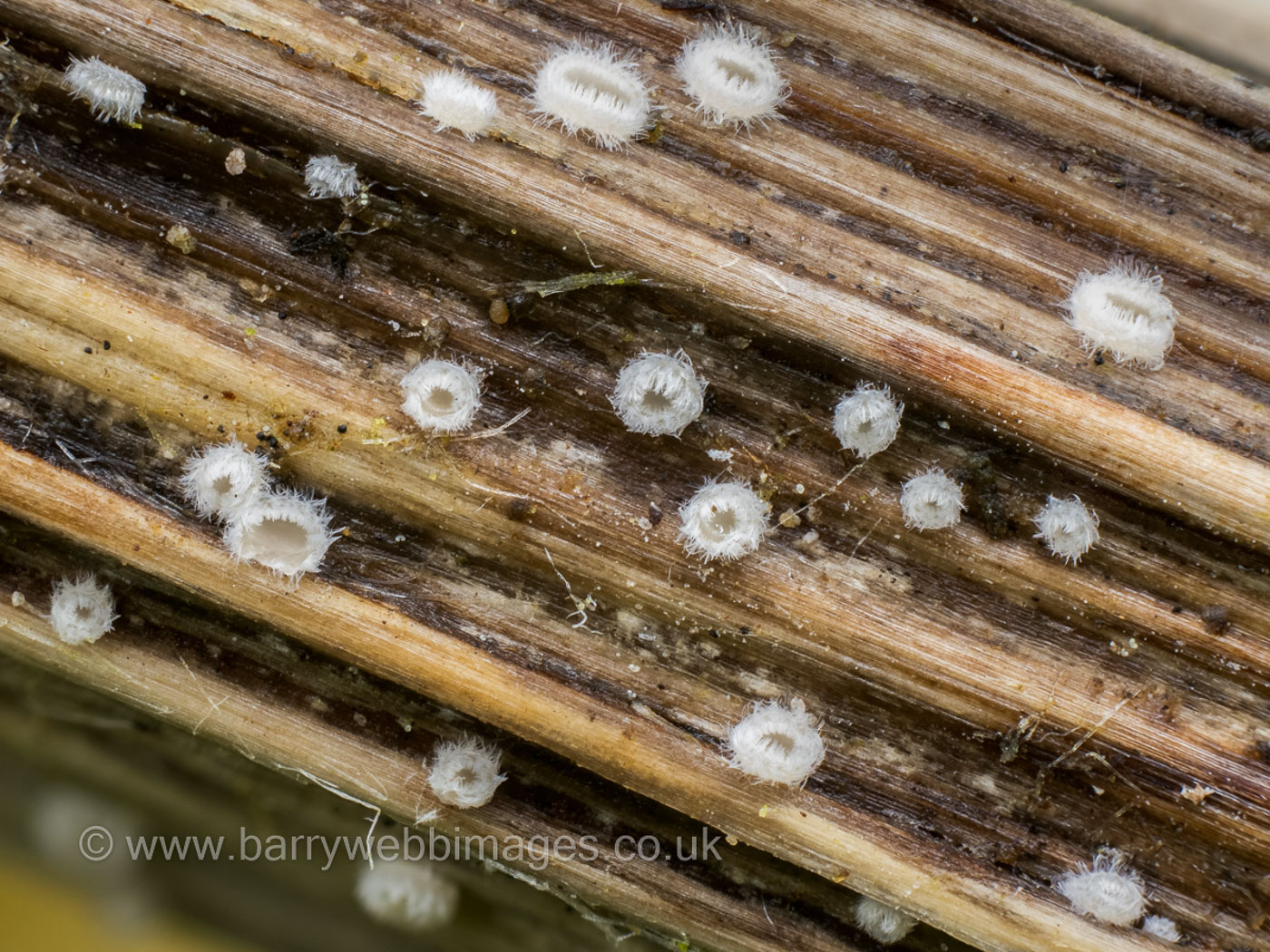 |
Trichopeziza mollissima (a Discomycete with no common name)
May 16, 2022. Also at Dancersend today several dead umbellifer stems were found having various tiny discs towards their base, later identified for us by Kerry Robinson. This tiny white hairy species seemed to be quite common today but we appear to have no previous county records. Previously Lachnum mollissimum, the name Trichopeziza (i.e. like a hairy Peziza) seems to describe it well. (Both photos are Barry Webb's)
|
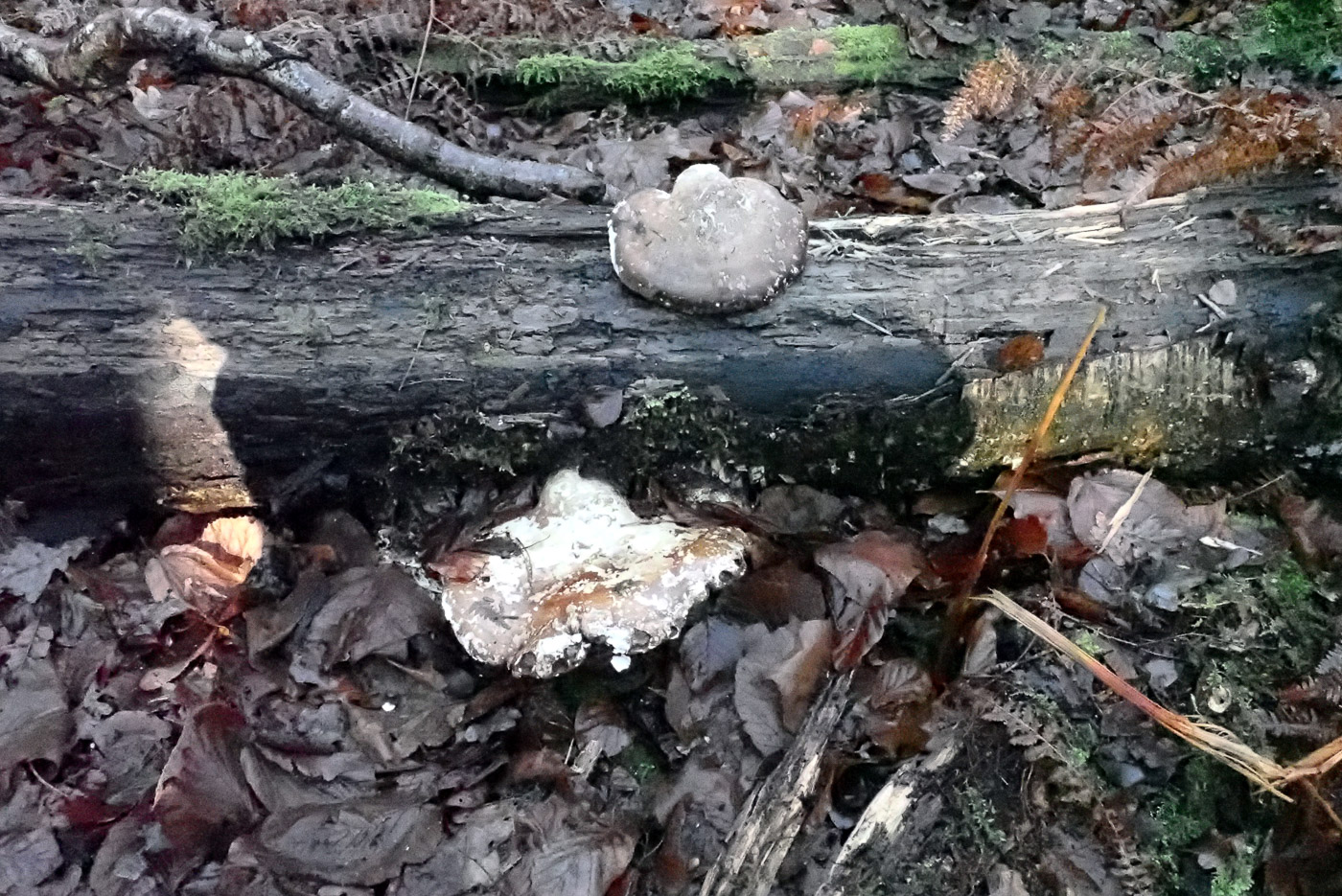
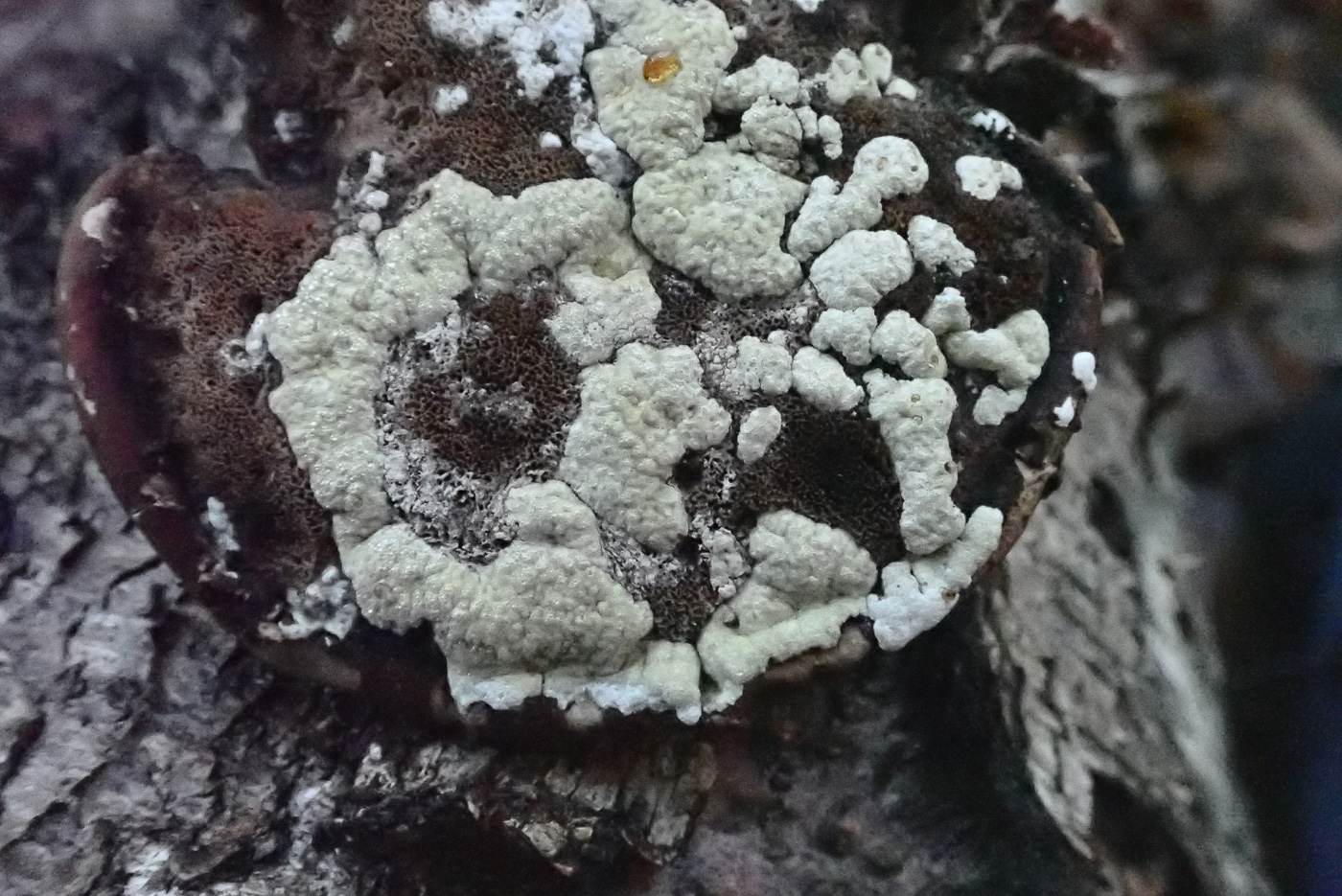
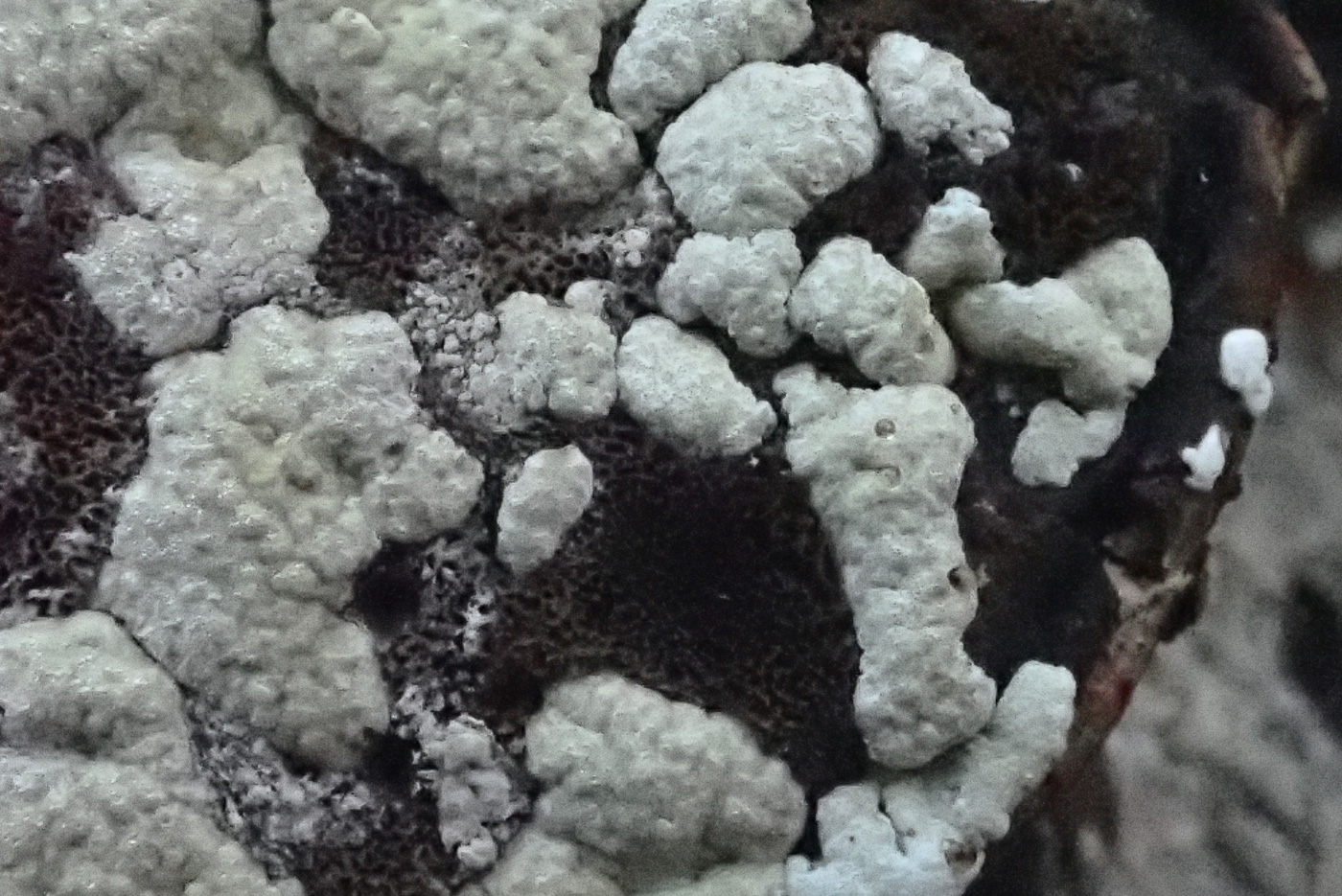
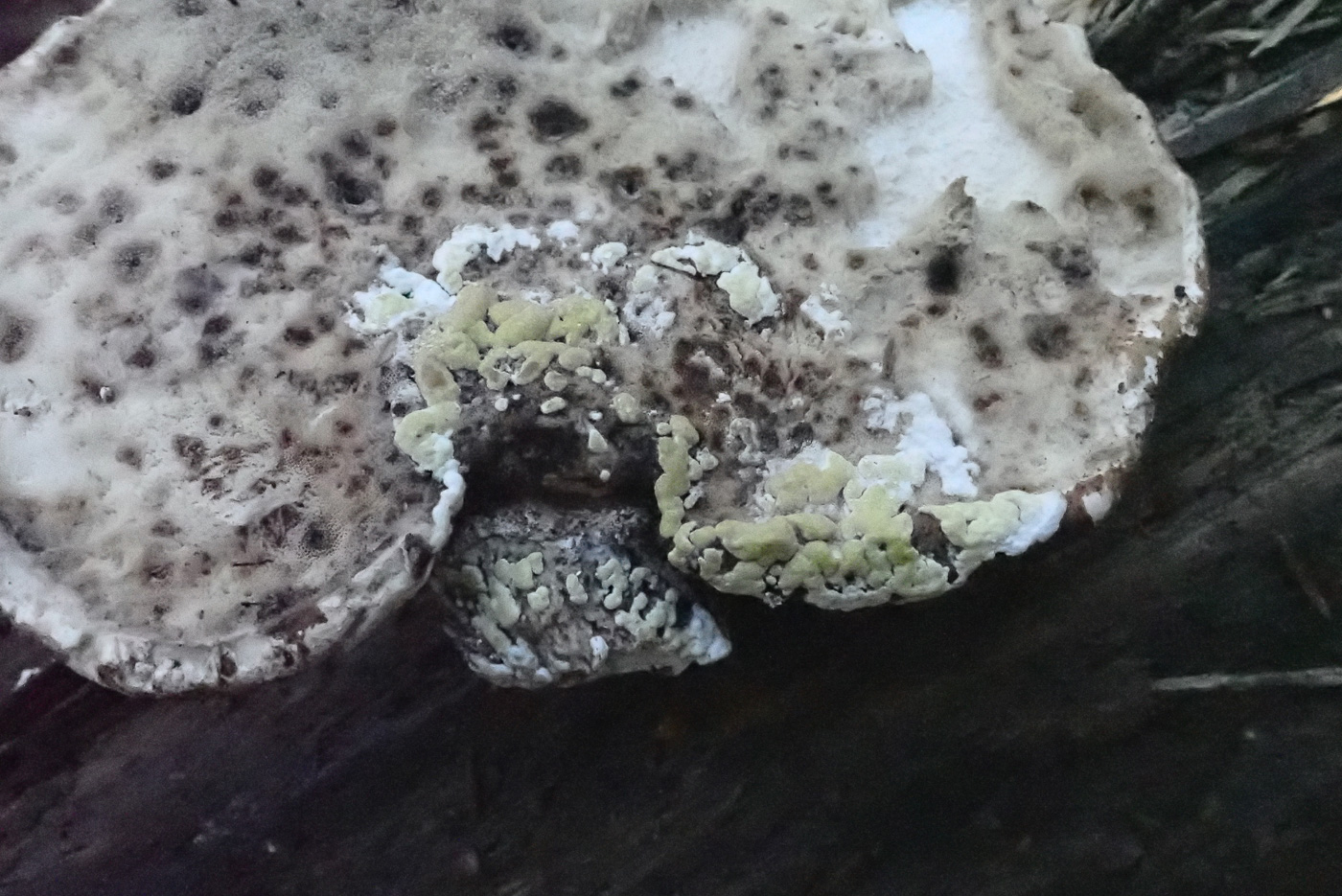 |
Trichoderma pulvinatum (Birch Bracket) with Fomitopsis betulina (Ochre Cushion)
Jan 17, 2022. In Burnham Beeches on fallen Birch Penny found some old fruitbodies of this common bracket (previously Piptoporus betulinus) and, knowing the likelihood of then finding this ascomycete growing on the pores, she broke a bracket off to take a look underneath. Sure enough there it was (previously Hypocrea pulvinata). Photos 2 and 3 show it at an early whitish stage, in photo 4 it is just beginning to turn yellow. It eventually turns ochre then brownish in age. It is only found on the underside of old fruitbodies. For younger examples of F. betulina.
|
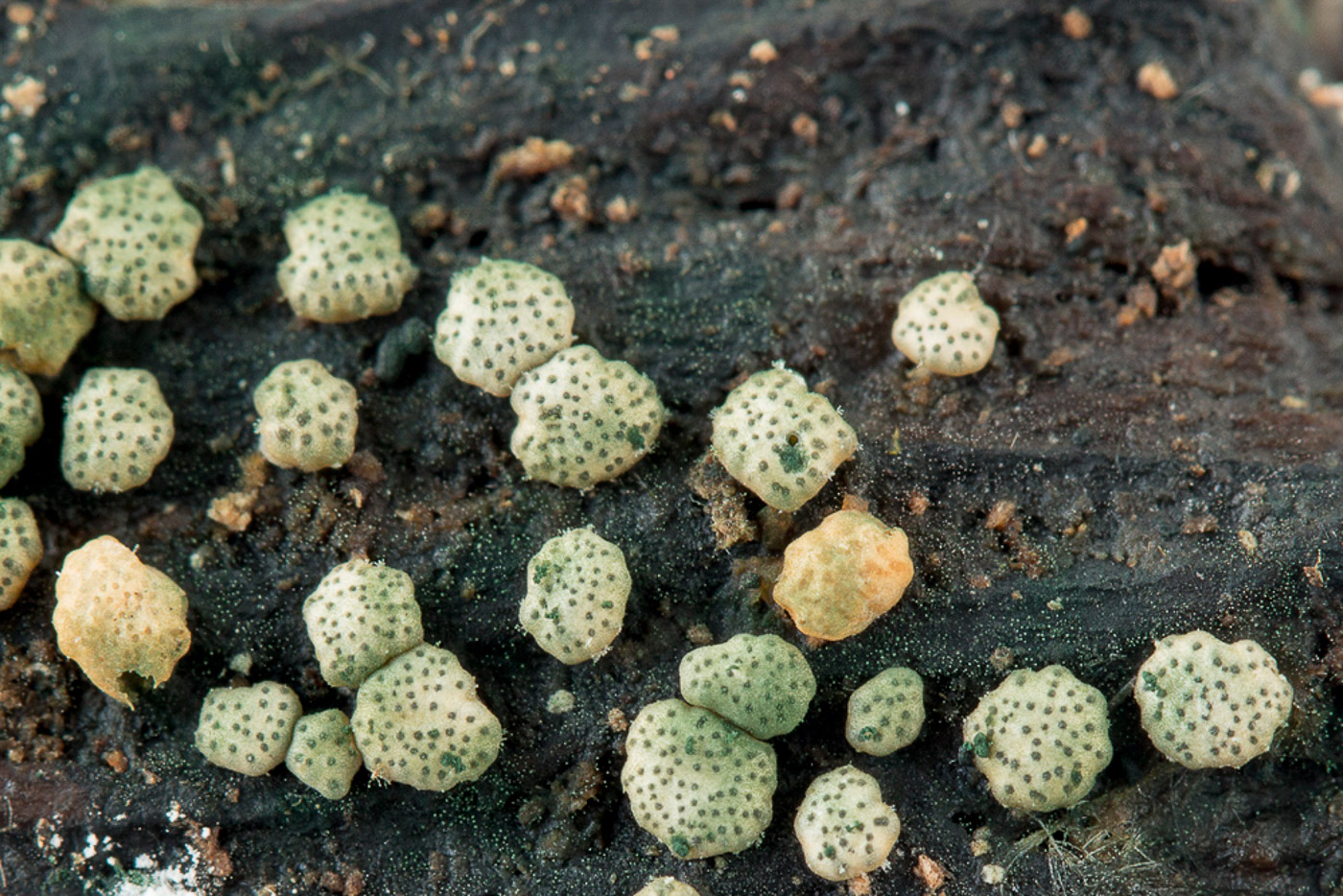 |
Trichoderma strictipile (a rare Ascomycete with no common name) 
Nov 20, 2021. On our late season walk at Rushbeds Wood, Jacqui Mckenzie-Dodds found this little colony of greenish blobs on fallen deciduous wood and handed the specimen to Claudi Soler who recognised it as very similar to Hypocrea gelatinosum. He also knew that this was a species complex recently resolved into a host of new species and moved to the genus Trichoderma. He sent the sample to Kew Asco expert Mariko Parslow who in early January was able to give him this name. So this was an exciting find by Jacqui and, thanks to Claudi's actions, we have another new species for the county. (The photo is Claudi's.)
|



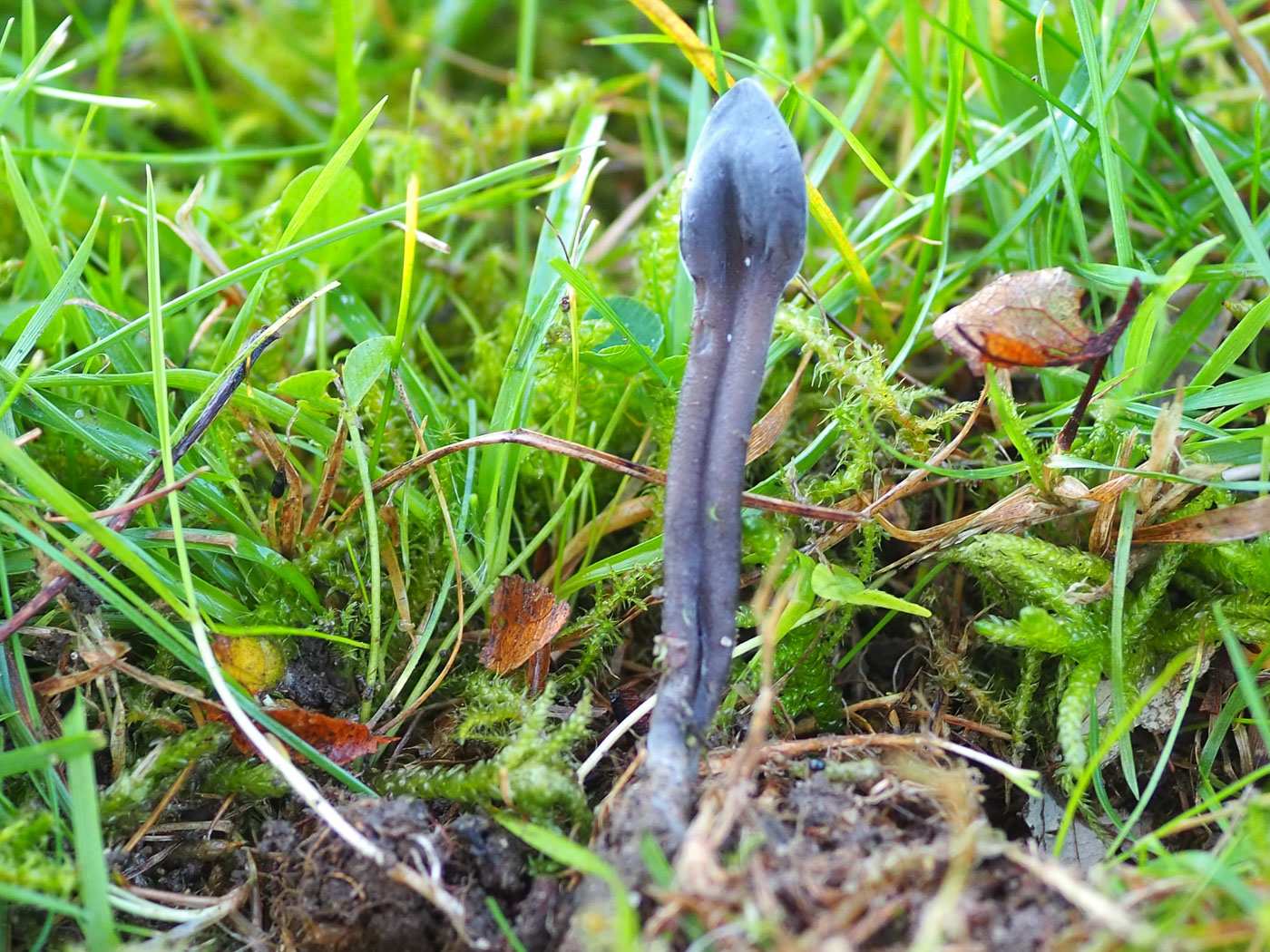
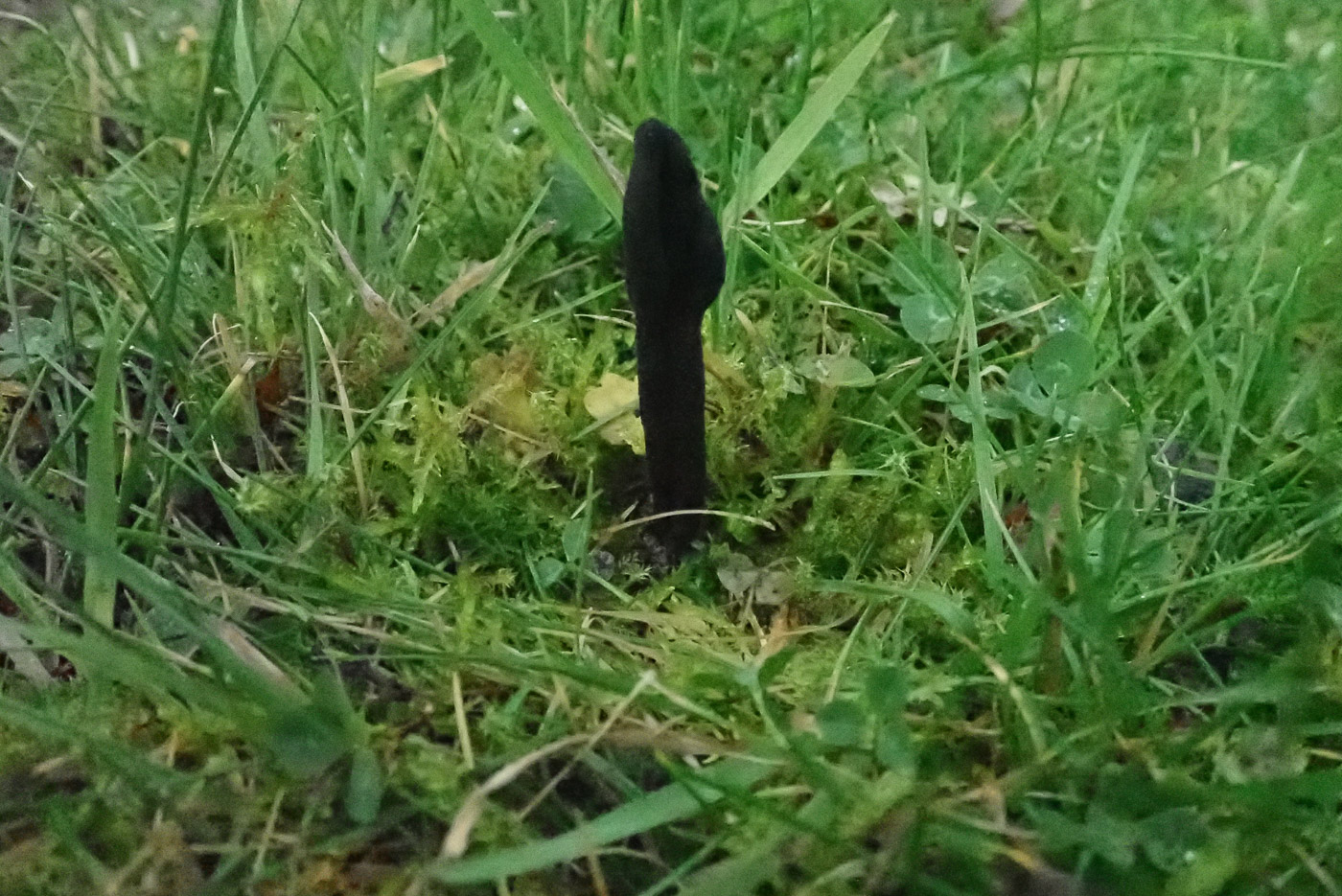
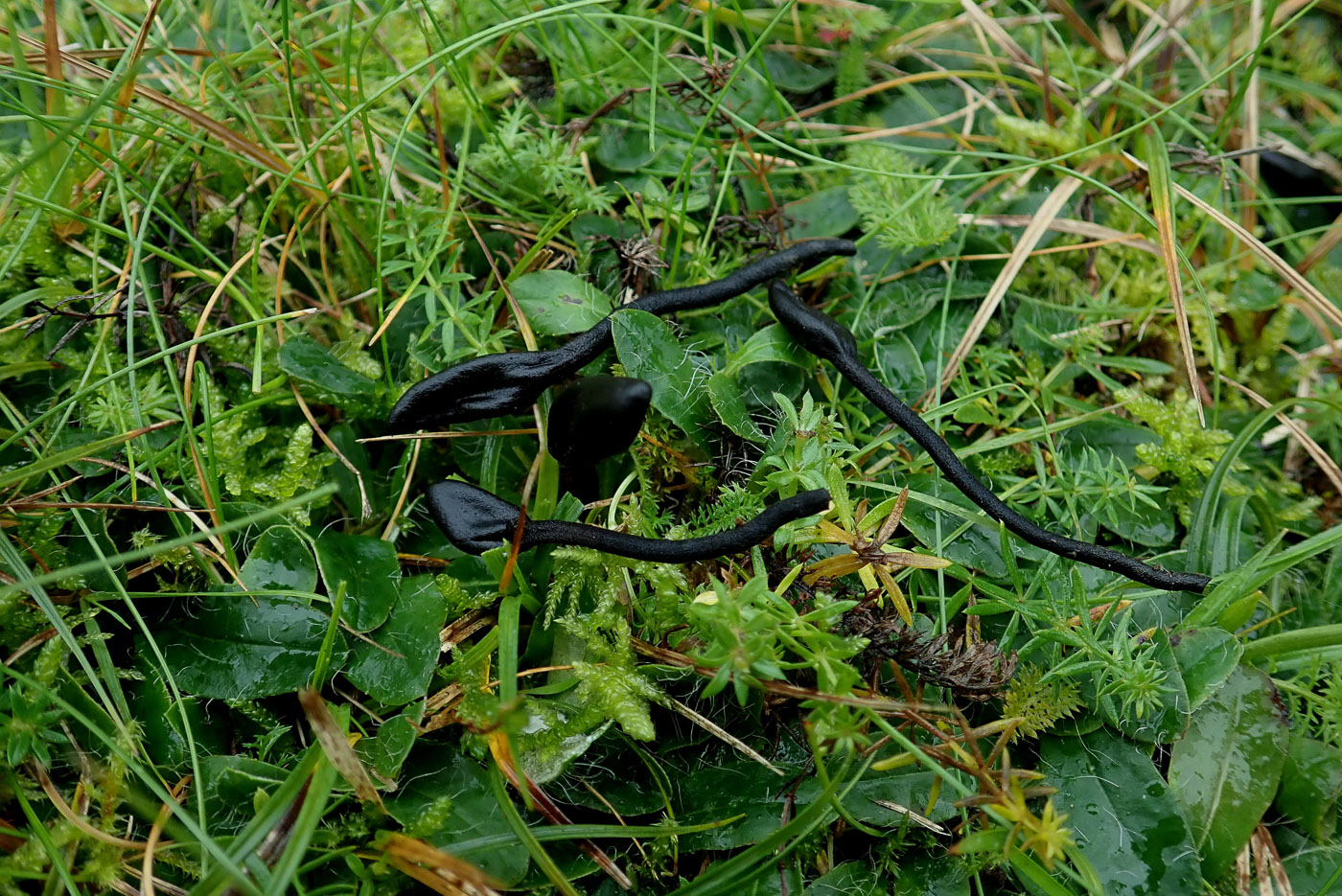
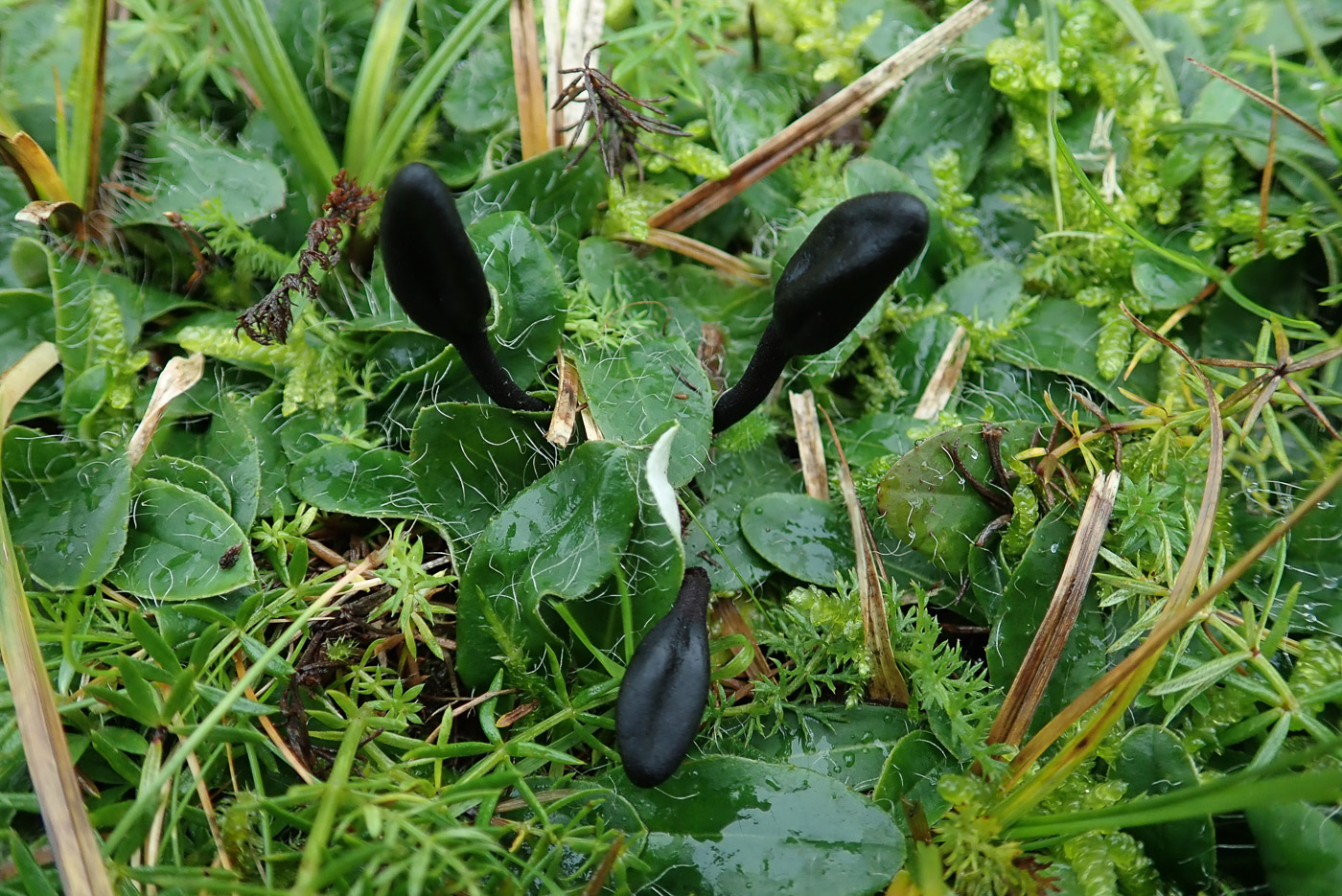
|
Trichoglossum hirsutum (Hairy Earthtongue) 
Nov 2, 2023. In St Giles churchyard Stoke Poges we found a few of these black grassland clubs which Penny later identified at home. This is perhaps the commonest Earthtongue species, the hairy part being the stem beneath the fertile top section though a hand lens is needed to see it. This and related genera virtually always need a scope to make a safe identification. We've found this species here on several occasions now. Photo 2 is Claire Williams's.
Nov 13, 2022. In Lane End churchyard John Catterson spotted just one of these grassland beauties - a black needle in a green haystack! Though we don't often find Earthtongues this is one of the commoner species (others mostly from the genus Geoglossum) and with a handlens can be recognised by the hairy surface of the stem which is clearly differentiated from the fertile head. It tends to grow singly rather than clustered.
Nov 18, 2021. In Prestwood Churchyard Penny chanced upon this singleton which, though one of the commonest Earthtongues, appears to be a new species for the site. What was unusual was finding one on its own: normally if / when one is spotted there are more to be seen once you start looking around carefully, but despite diligent searching no more could be found. With a hand lens the roughened finely hairy stem surface of this species can be seen but Earthtongues should always be identified using a scope - the spores and paraphyses are critical to any determination.
Nov 20, 2020. Penny C. was delighted to come across several of these in very mossy grass in St Giles churchyard, Stoke Poges. She assumed on collection that these would turn out to be a species of Geoglossum, but under the scope it was clear that the presence of dark brown hairs eliminated that genus and the spores were suitably multiseptate thus confirming this determination. We have a handful of county records but not from this part of the county nor since 2008. It tends to be found in late autumn to winter, so one to look out for now in suitable mossy grassy habitats.
|

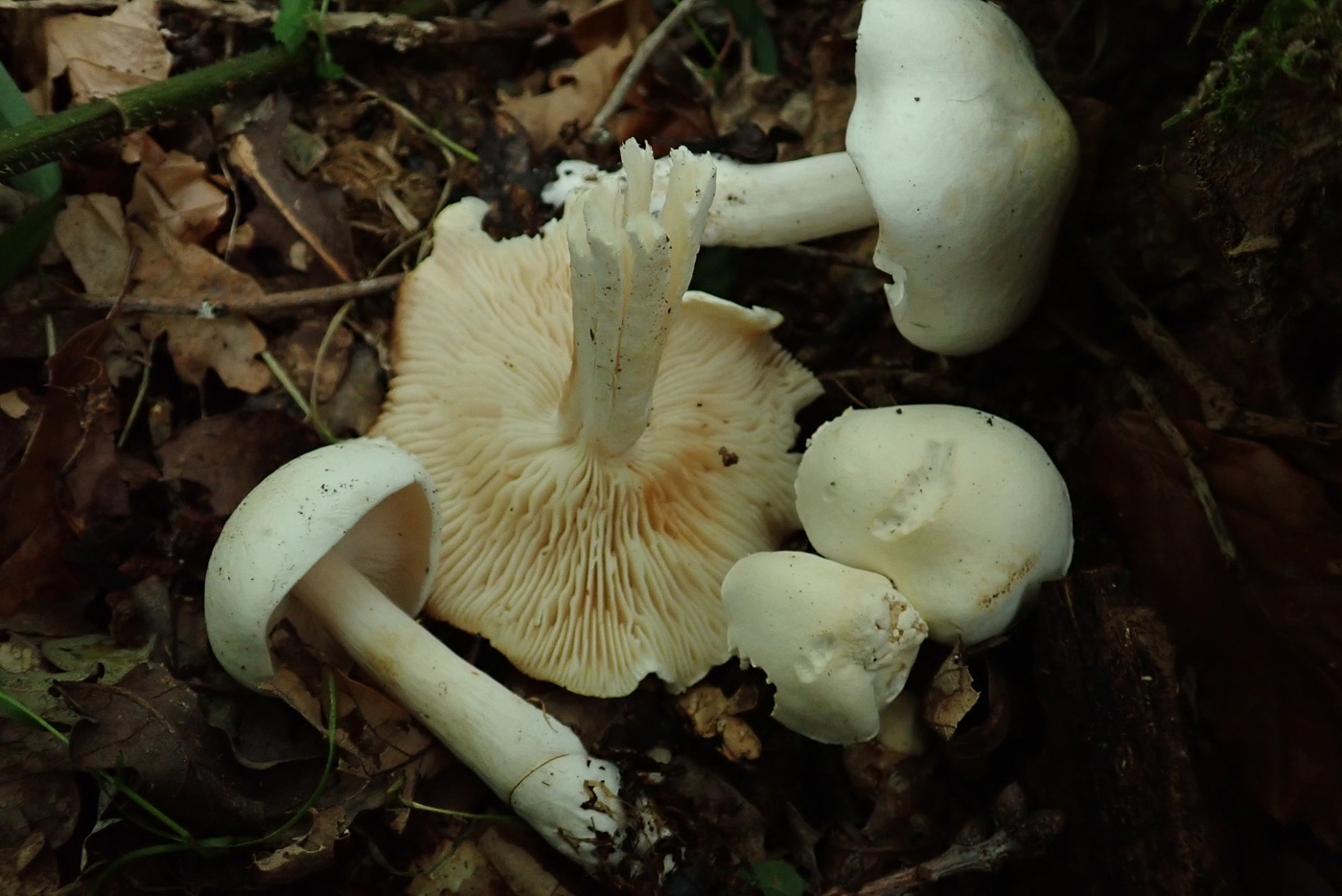
|
Tricholoma album (White Knight)
Oct 6, 2023. In Gerrards Cross under Oak Jesper Launder found a few of these chunky white Knights. This species is one of three very similar white capped Knights, all of which have similar unpleasant pervasive smells and their tree association is key to their identity. Under Oak as here = T. album; under Beech = T. lascivum; under Birch = T. stiparophyllum. If more than one of these tree species is nearby then it is probably safer not to name these mushrooms to species!
Sep 26, 2020. Paul Cullington found the collection under Oak in Naphill Common. One of several white capped Knights, all of which have a pervasive and unpleasant smell especially when contained for any time in a pot, this one is probably quite rare and probably often misdetermined. It is found only under Oak whereas the much commoner T. stiparophyllum (Chemical Knight) occurs under Birch and even more common T. lascivum (Aromatic Knight) occurs under many different trees.
|
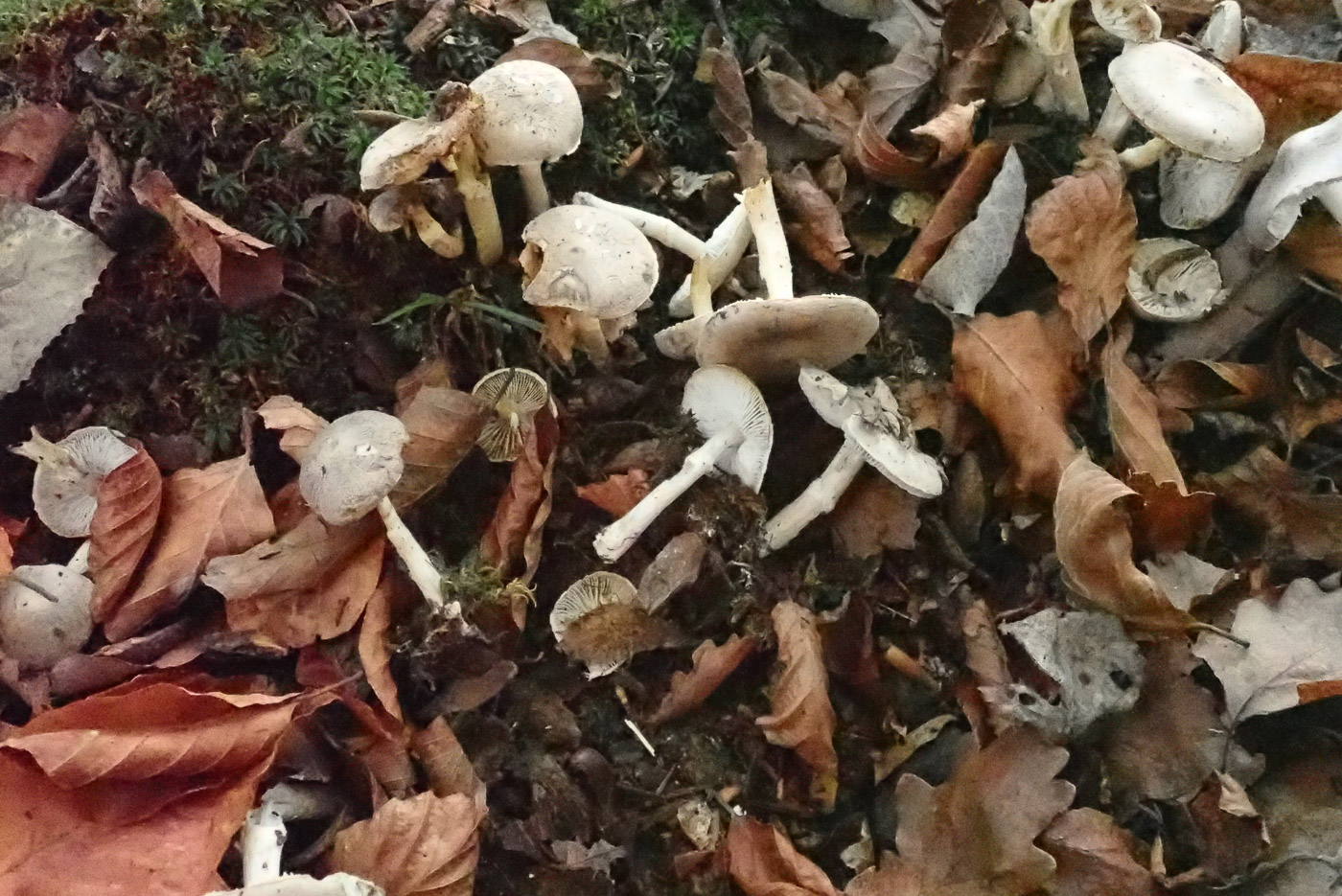
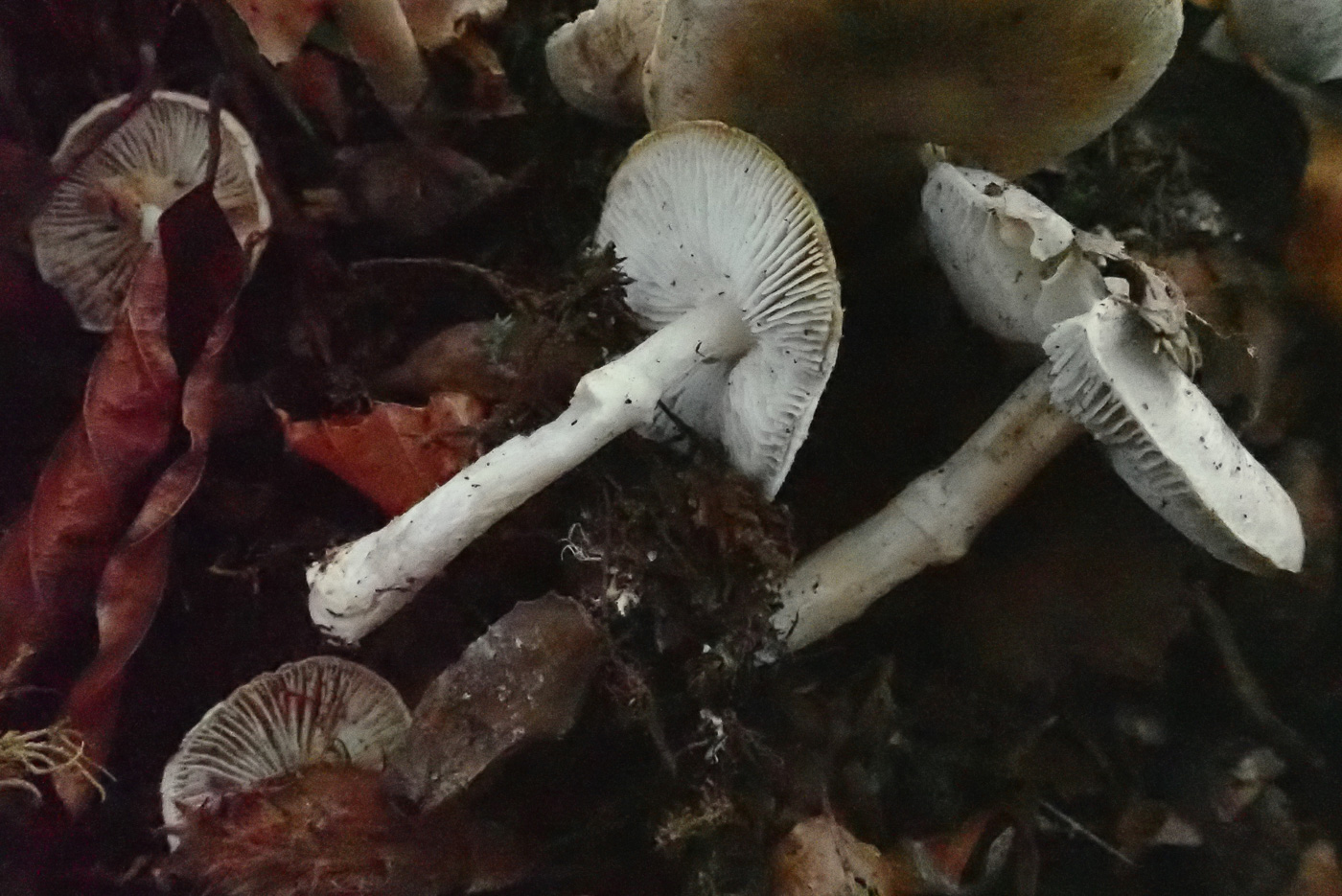
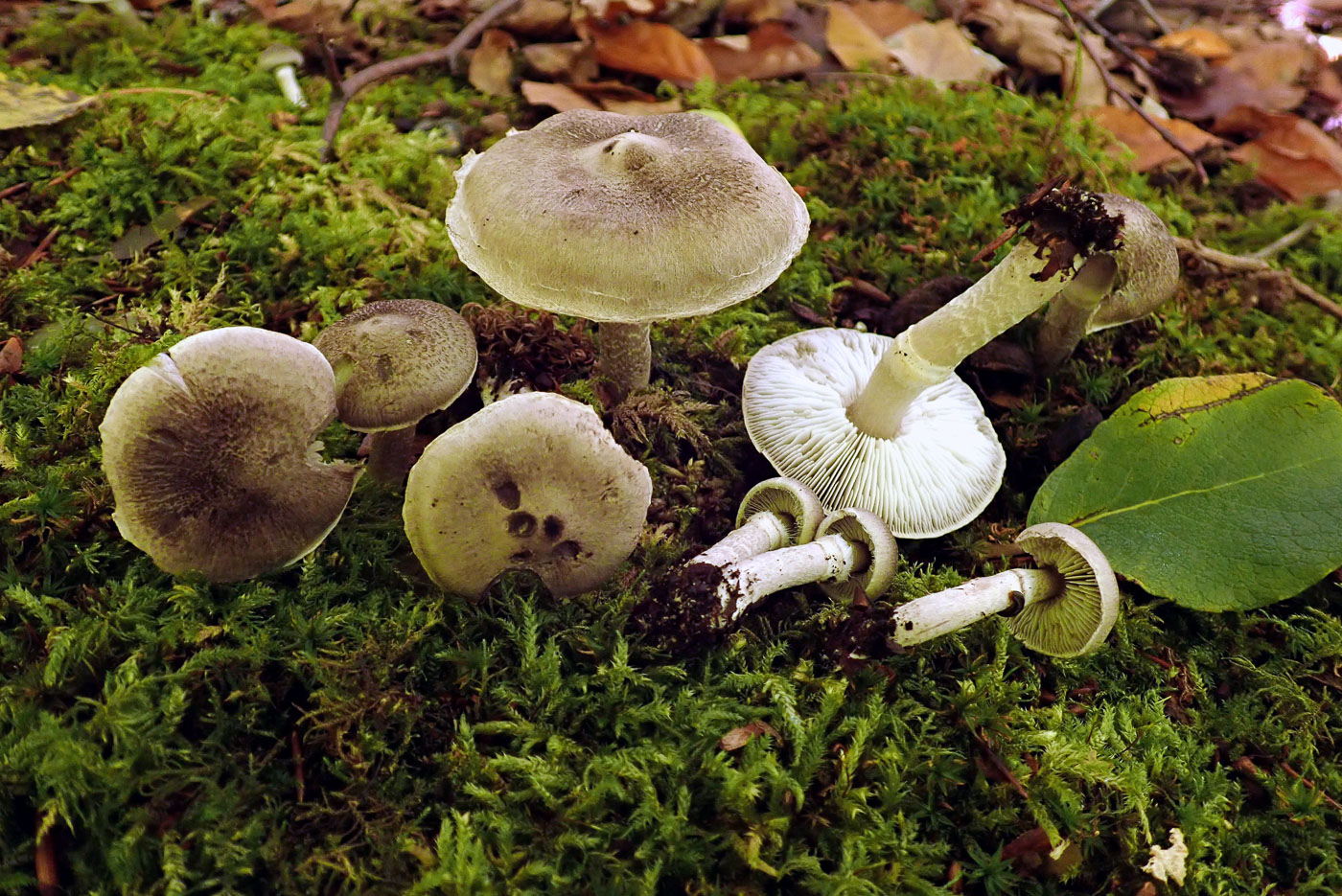
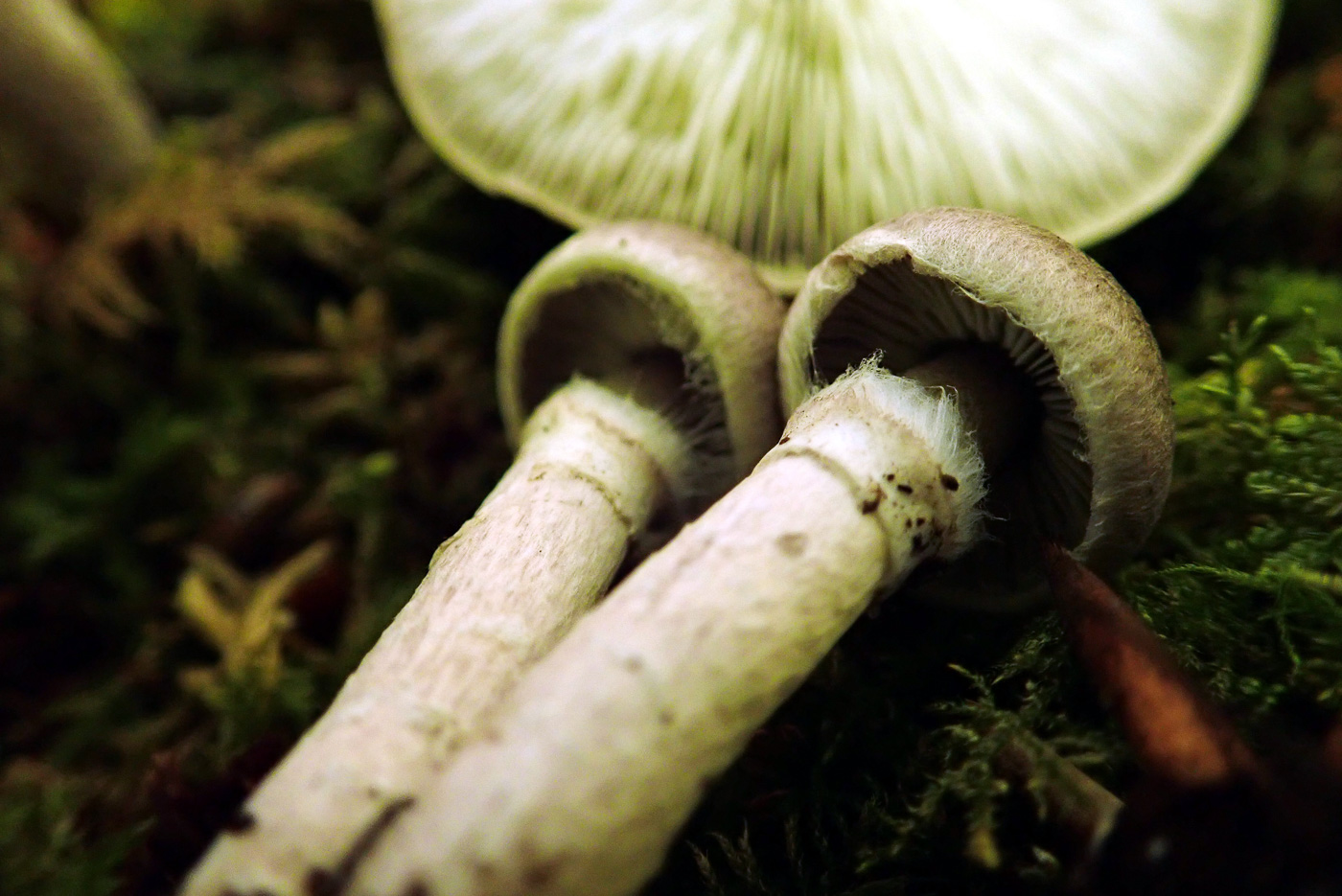
|
Tricholoma cingulatum (Girdled Knight)
Nov 9, 2021. Under Willow at Burnham Beeches Penny found this species of Knight which - once you recognise its genus - is an easy one to name in the field. The two key features: its occurrence under Willow and (uniquely) the presence of a ring on the stem. There are many Knights having quite similar grey caps and a mealy smell, but noting the tree and the ring should be sufficient though on older specimens the ring can disappear so it's worth checking several to make sure.
Oct 16, 2020. Paul Cullington found good numbers of this species of Knight under Willow in Burnham Beeches (photo Penny C.). There are quite a few Knights having similar brownish grey caps but this particular species is unique amongst them because it has a ring on the stem - the only member of the genus to do so. So if you find a greyish Tricholoma under Willow (its only host) check for a ring. If it has one, job done!
|
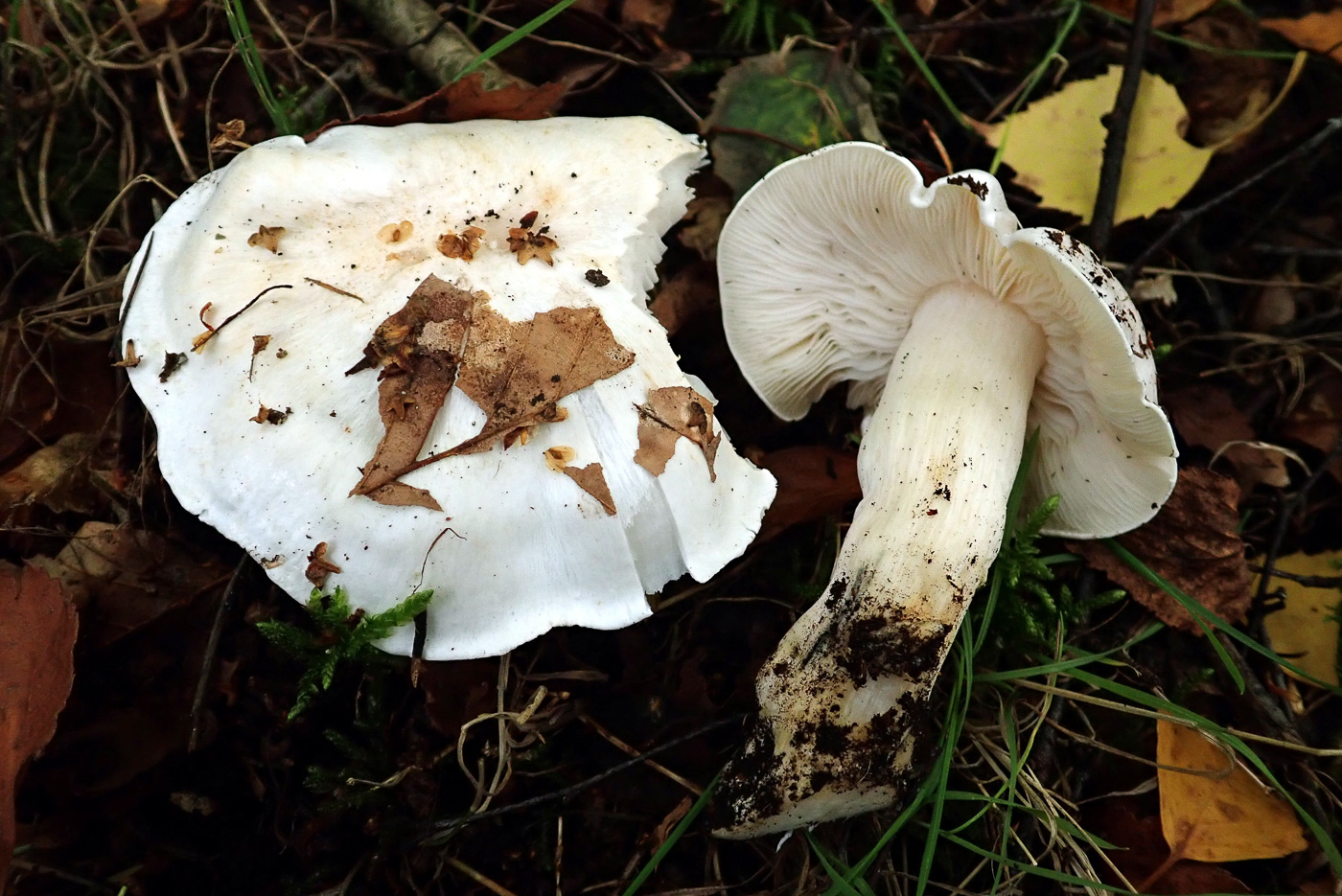 |
Tricholoma columbetta (Blue Spot Knight)
Oct 16, 2020. Penny C. found this species under Birch at Burnham Beeches - yet another of the white capped Knights but this one lacks the unpleasant pervasive chemical smell of the trio previously discussed under T. album (dated Sept 26) and T. stiparophyllum (dated Oct 13). We have very few county records of today's species though this may be due to our lack of experience over its recognition: the bright white shiny silky rounded cap combined with the lack of a distinctive smell is the key feature, though in maturity it can develop blue green spots at the stem base (not always present, however). It occurs under various deciduous trees.
|


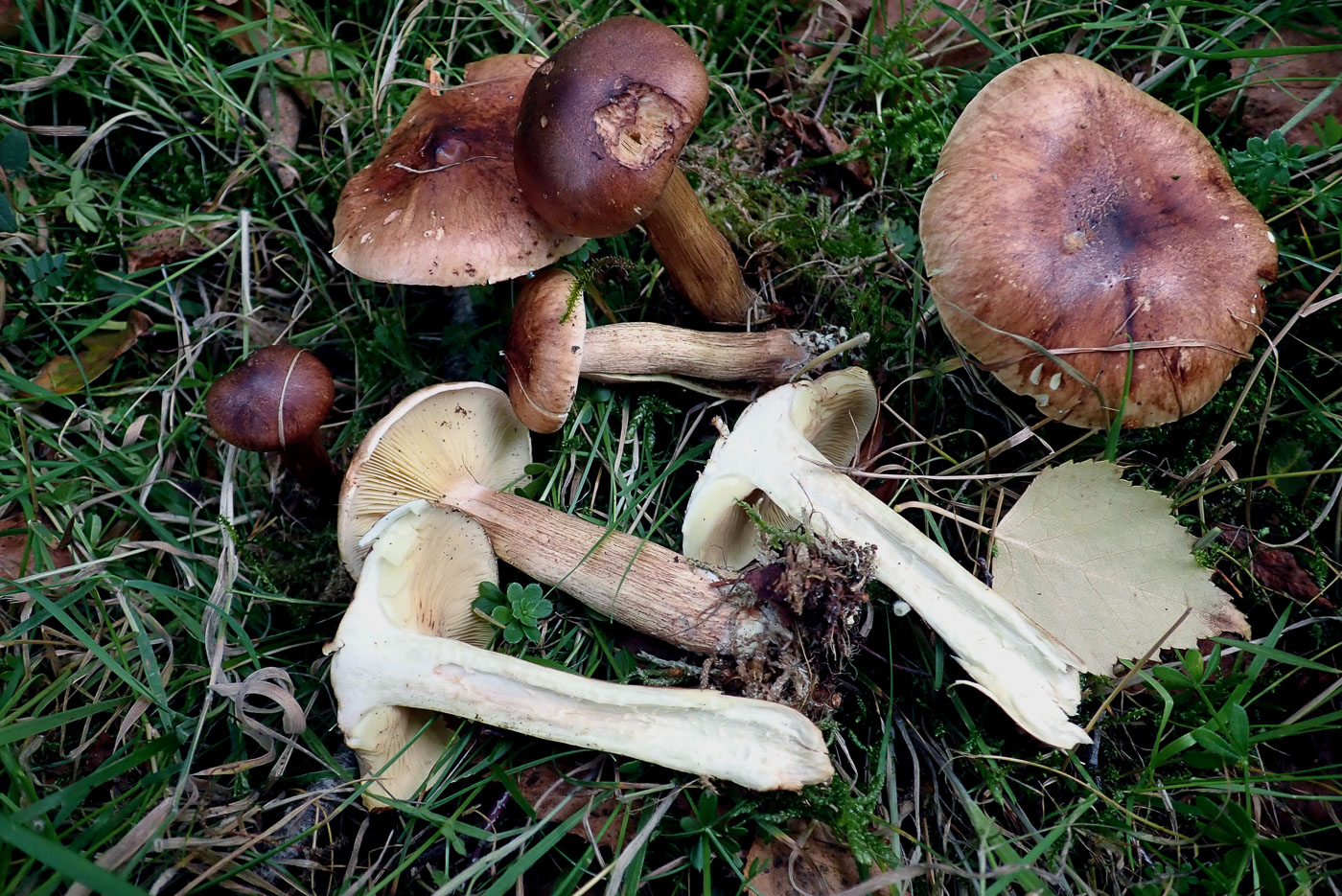 |
Tricholoma fulvum (Birch Knight)
Oct 26, 2023. In Bernwood Forest under birch Penny found a few of this brown-capped Knight which can sometimes confuse. It is host specific to Birch and characteristically has somewhat yellow gills together with yellow flesh within the brown stem. Photo 2 shows another characteristic: the cap - similar in colour to Amanita Fulva (Tawny Grisette) - often develops a 'pie crust' crimping around the rim.
Sep 18, 2020. Our first Knight of the season, this was found by Penny Cullington at Hodgemoor Wood under Birch with which it is host specific. Features to note as well as the host tree nearby: the fulvous brown smooth cap, pale yellow gills and a brownish stem which if broken open reveals pale yellow flesh and becomes hollow as it matures. It is quite common wherever Birch occurs.
|
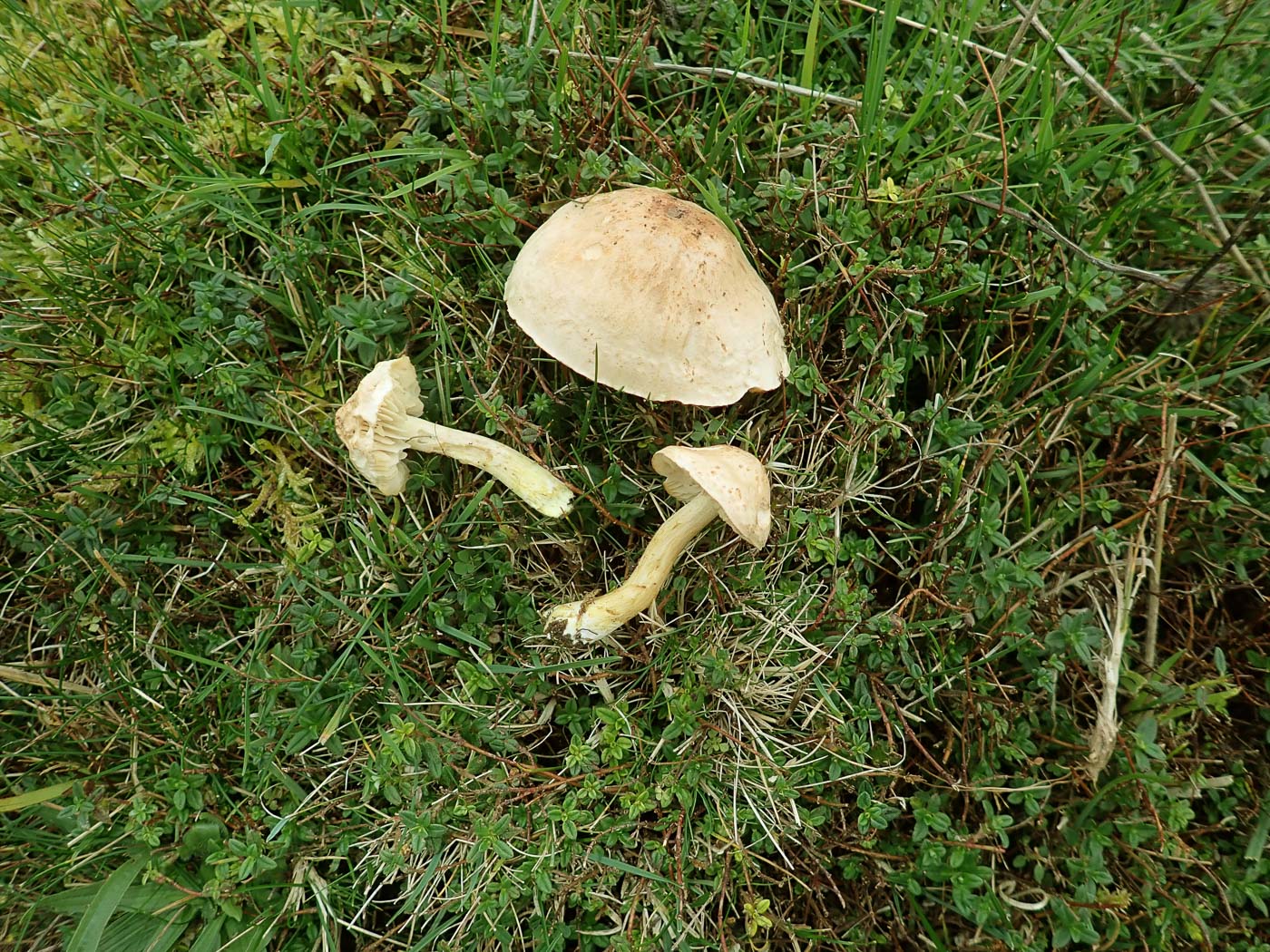
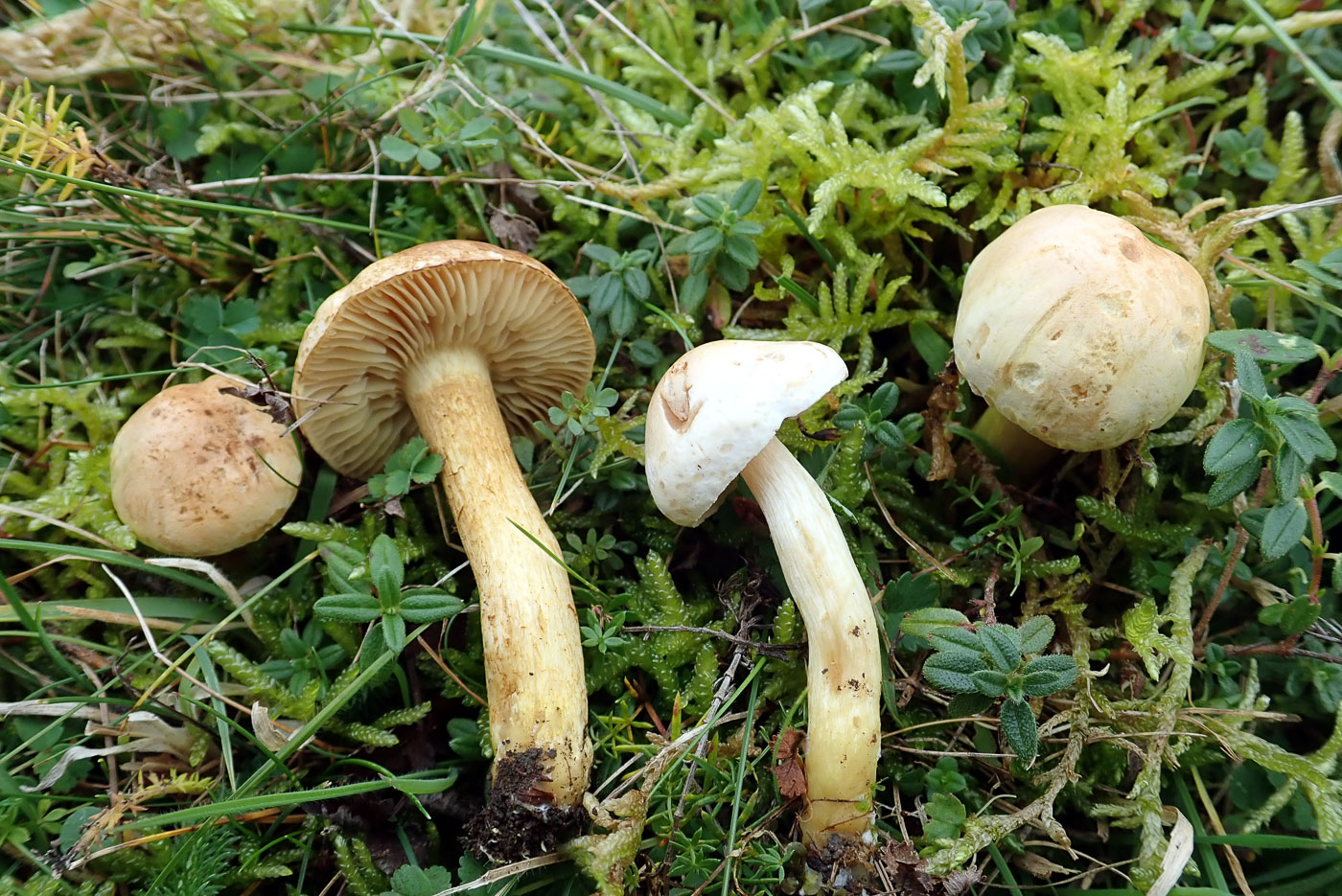
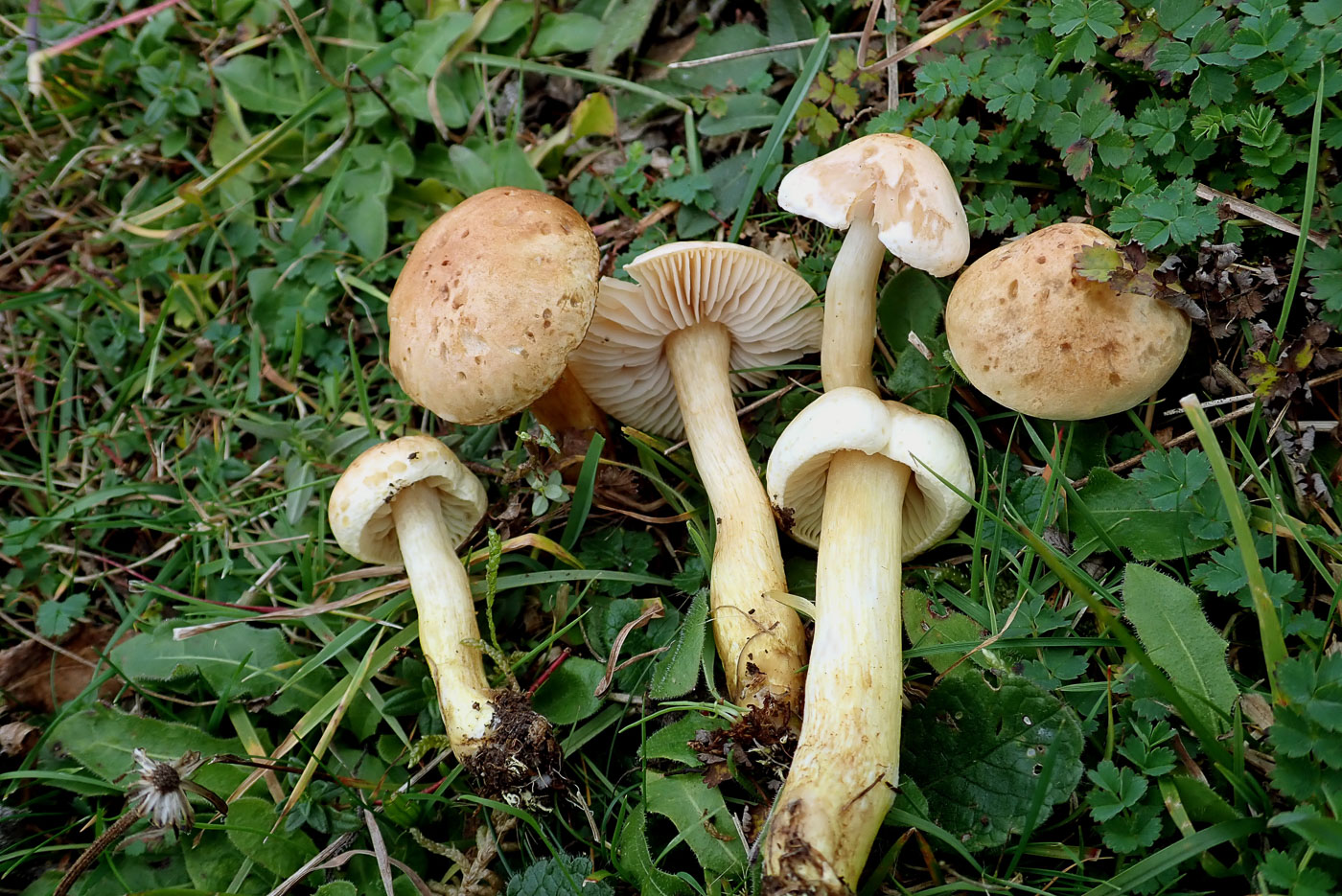 |
Tricholoma hemisulphureum (a Knight with no common name)
Nov 14, 2024. On the Helianthemum-covered escarpment at Coombe Hill Penny was on the lookout for any of the special mushrooms which associate with this particular plant. She found only this one, a fairly nondescript species which, however, is clearly related to the familiar yellow T. sulphureum (Sulphur Knight) sharing its remarkably pungent and unpleasant smell of coal gas tar. Once smelt never forgotten! It appears to be host specific to Helianthemum so well worth looking out for, as are many other mycorrhizal species, wherever that plant occurs.
Oct 30, 2020. Penny C. visited the escarpment at Coombe Hill today hoping to find one or two of the specialised species which grow there in association with Helianthemum (Rock Rose). This Tricholoma is one of those, closely related to the common yellow T. sulphureum (see photo dated Oct 16) and with exactly the same smell of coal gas tar, but it lacks the distinctive yellow cap of that species, having a duller pale brown cap though with a hint of yellow. The gills are pale cream and the stem is concolorous but usually yellow at the base. It appears to be host specific with Helianthemum and seems to be quite common wherever that plant is found.
|
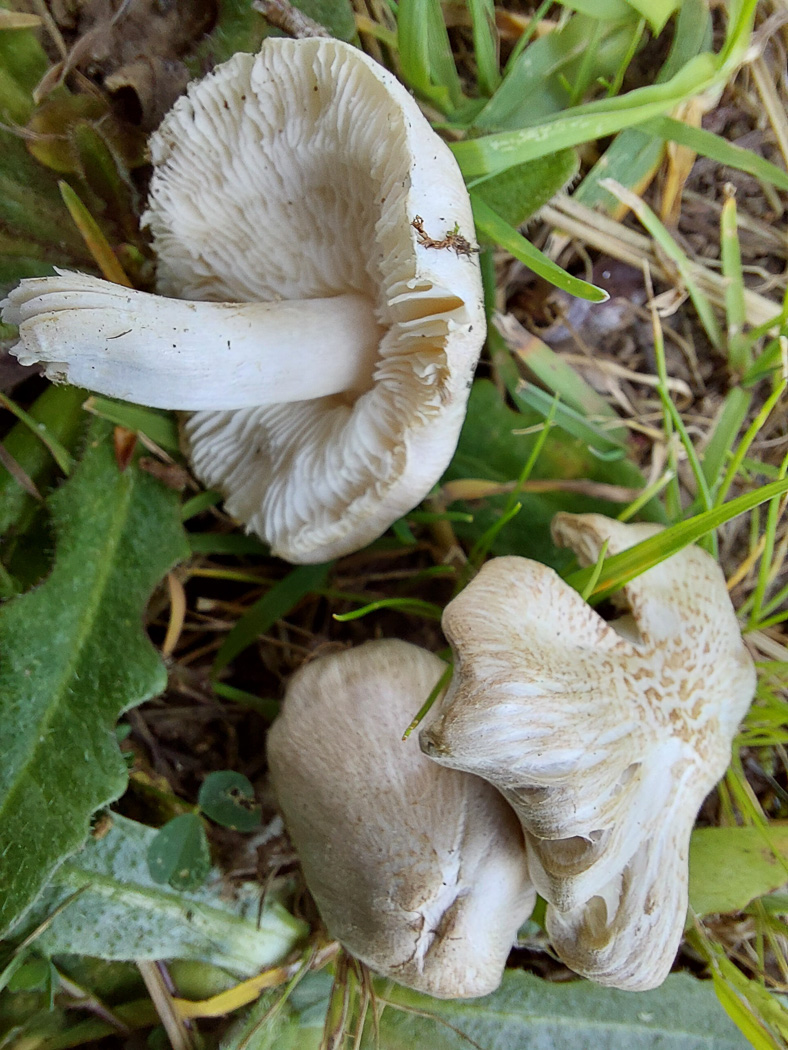 |
May 8th Tricholoma inocybeoides (a rare species of Knight with no English name) 
May 8, 2024. Whilst visiting South Buck Golf Course (Chalfont St. Peter), Jesper Launder found this unusual white species which he likened to a white Inocybe (Fibre Cap) on collection. However, white spores and an unpleasant earthy smell soon put him onto genus Tricholoma though the lack of Birch, Beech and Oak eliminated the three likely white-capped candidates. This then led him to the possibility of T. inocybeoides, close to both T. scalpturatum and T. argyraceum, though he was somewhat doubtful, so a sample was sent for sequencing. Eventually the result gratifyingly confirmed his ID! This is new to the county and to Finds.
|
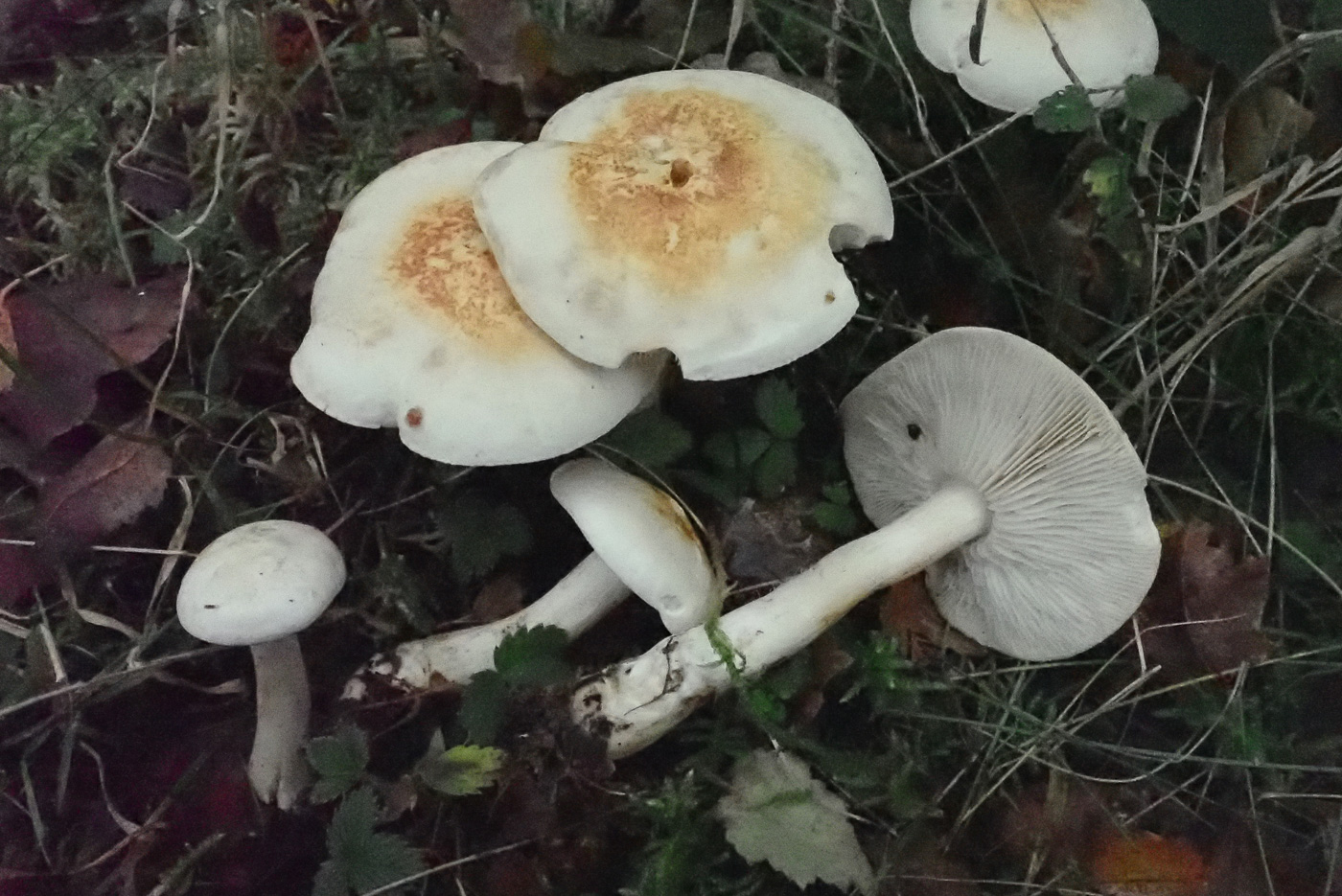
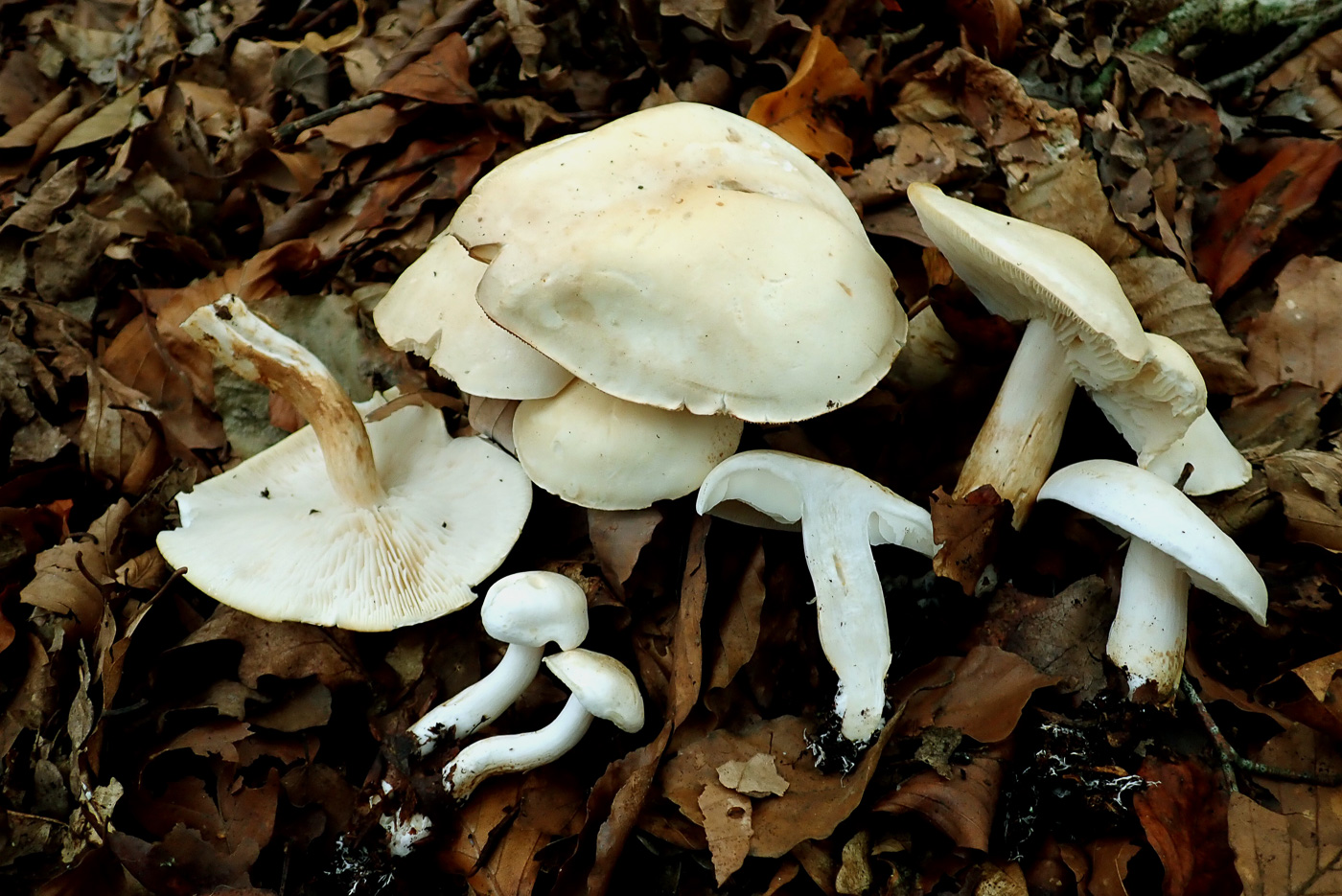
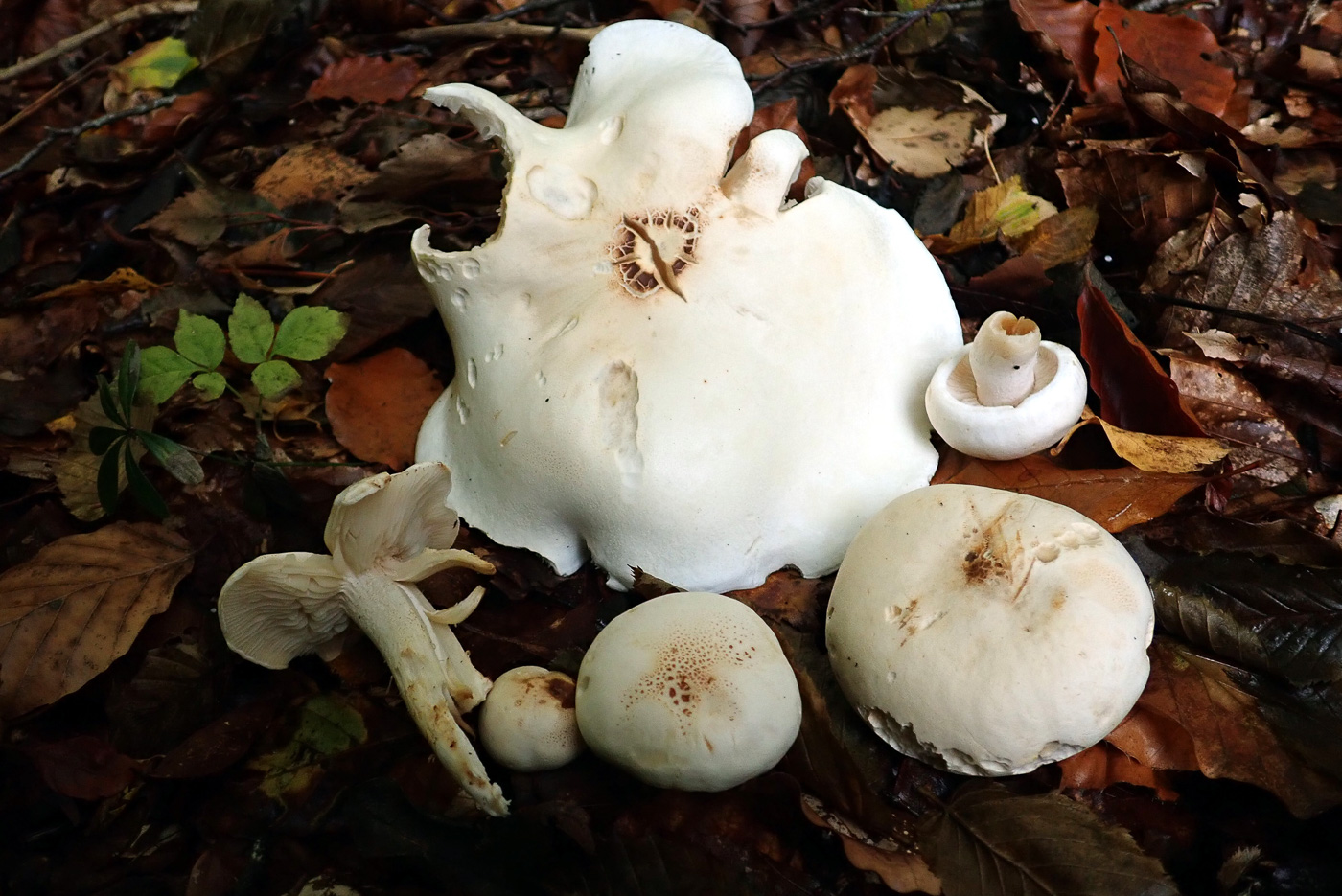
|
Tricholoma lascivum (Aromatic Knight)
Nov 3, 2021. In a grassy path edge under mixed deciduous trees in Hodgemoor Woods Paul found a large patch of these substantial mushrooms, identified by Penny from a combination of features observable in the field but mainly the strong smell and the white cap but with brown marks developing in the centre. The white Knights are often confusing, especially in mixed woodland. If only under Oak and having a strong chemical smell then you have T. album, if only under Birch you have T. stiparophyllum, and if only under Beech you have T. lascivum - all three have a very similar pungent smell (but be aware that a white Knight without this smell could be T. columbetta!) Separating these three species if two or even all three of the host trees are nearby as here is often not possible! However, if Beech is one of the trees nearby and your larger caps are developing brownish marks at the centre then you have T. lascivum because the other two remain white.
Oct 19, 2020. This collection, found under Beech in Burnham Beeches by Geoffrey Kibby (photo Penny C.), completes our quartet of the white capped Knights. Three of these have unpleasant pervasive chemical smells but the fourth, T. columbetta, can be recognised by its lack of smell (see photo dated Oct 16). Today's species is by far the commonest and is found only under Beech whereas T. album (see photo dated Sept 26) is found only under Oak and T. stiparophyllum (see photo dated Oct 13) is found only under Birch. This sounds simple enough but so often they occur where there's mix of these trees present. Time to admit defeat and be satisfied with knowing that it must be one of these three!
Oct 13, 2020. Penny Cullington found this collection under Birch at Pulpit Hill. There are three extremely similar white capped Knights which are very easy to get confused, all of which have an unpleasant pervasive smell especially if contained in a pot. To separate them one needs to note what tree your collection is growing under. T. album grows only under Oak, today's species T. stiparophyllum grows only under Birch, and T. lascivum grows only under Beech, The problem arises when a collection is found with mixed trees nearby, in this case it's probably safer to be content to call it one of the smelly white Knights and leave it at that!
|
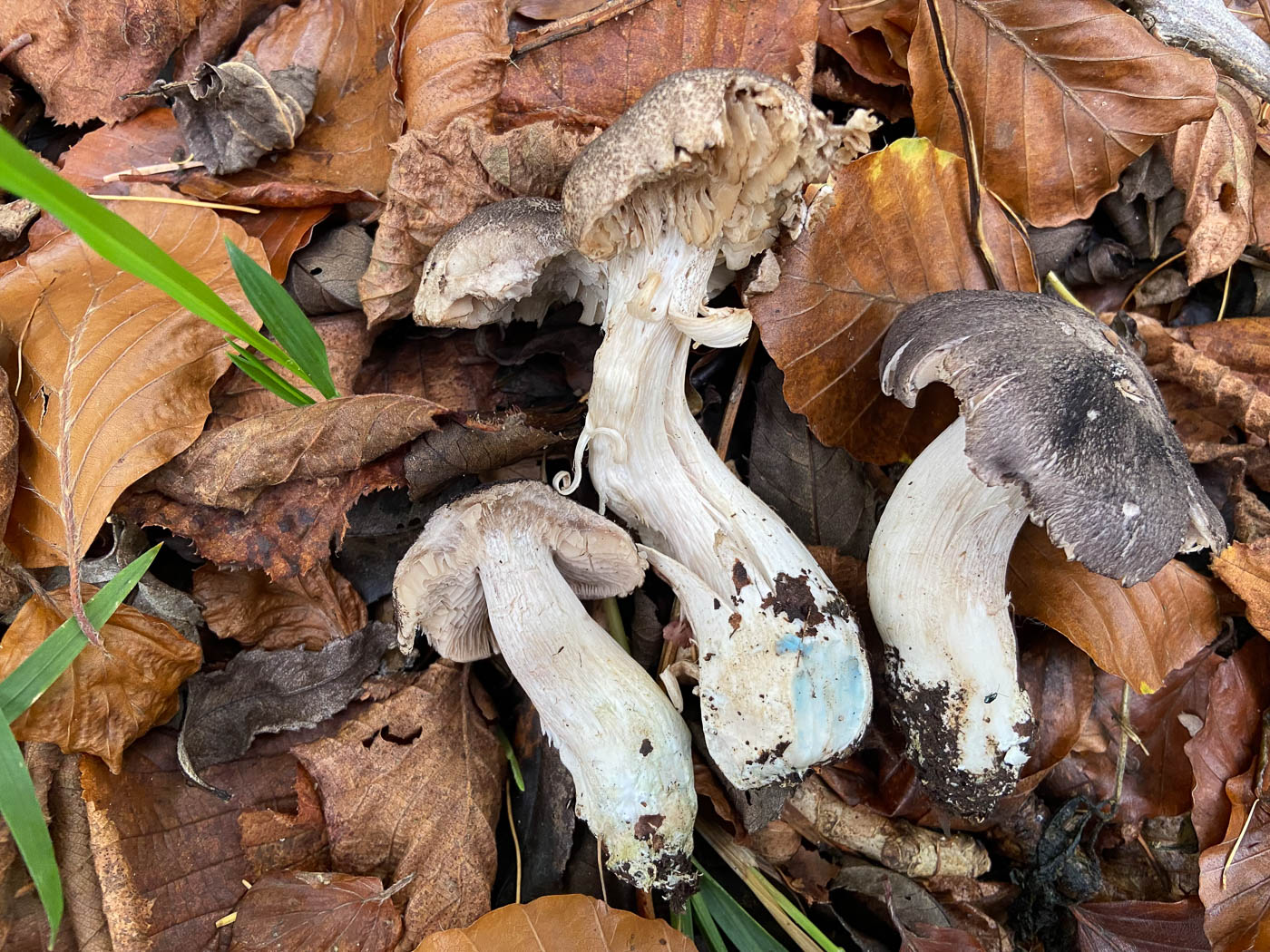 |
Tricholoma orirubens (a Knight with no common name)
Nov 10, 2022. In Round Spring Wood, Dancersend, warden Mick Jones was keen to show us this species which he'd found here recently amongst the Beeches and wanted identified. On collection we scratched the stem and waited for a few minutes before the telltale blue staining appeared towards the base, a clear sign of T. orirubens which otherwise is almost identical to T. atrosquamosum, one of the many grey species of Knight which can be tricky to name to species. The species is not that common and is a new one for Finds, the photo being Sarah Ebdon's.
|
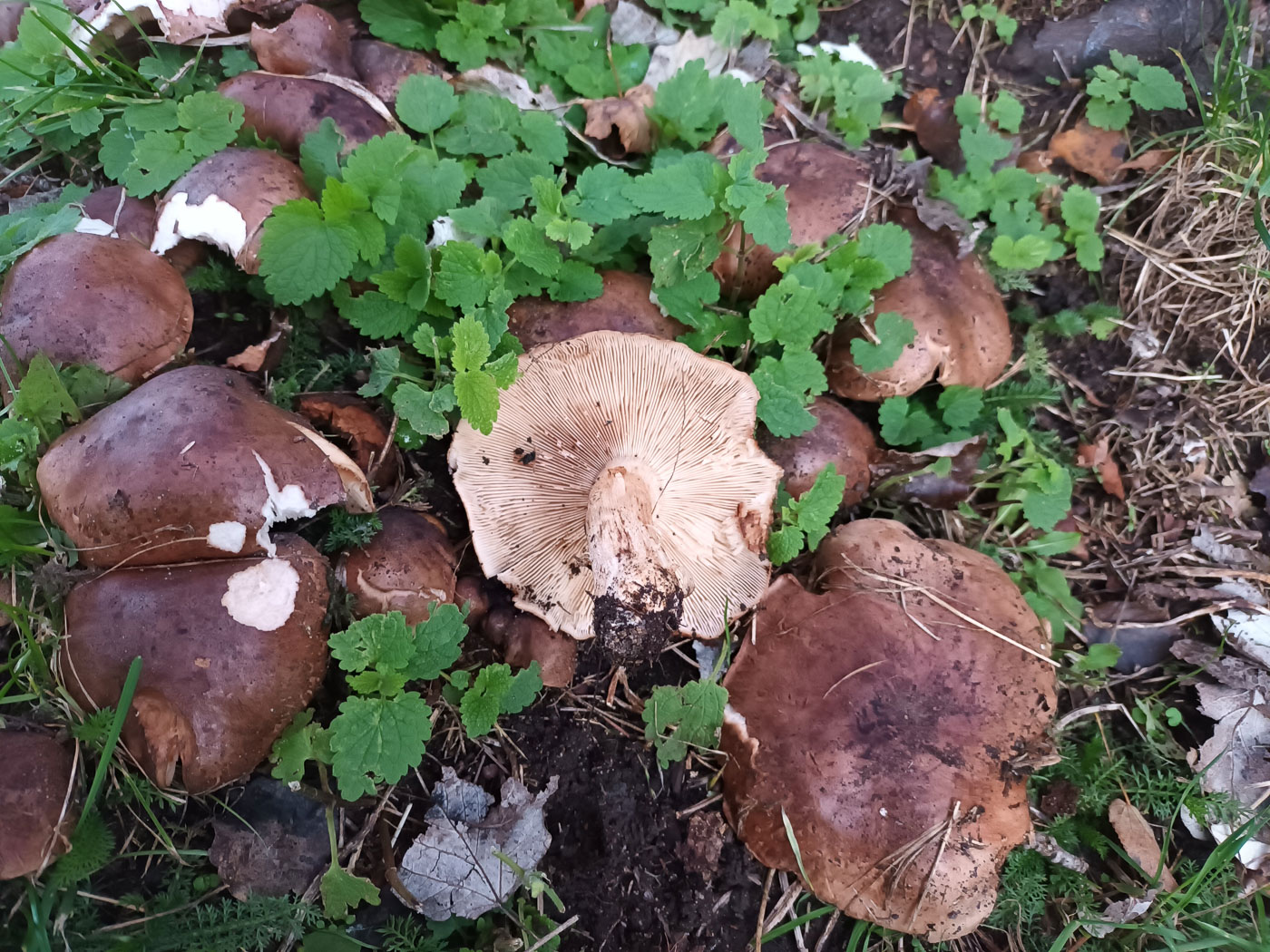
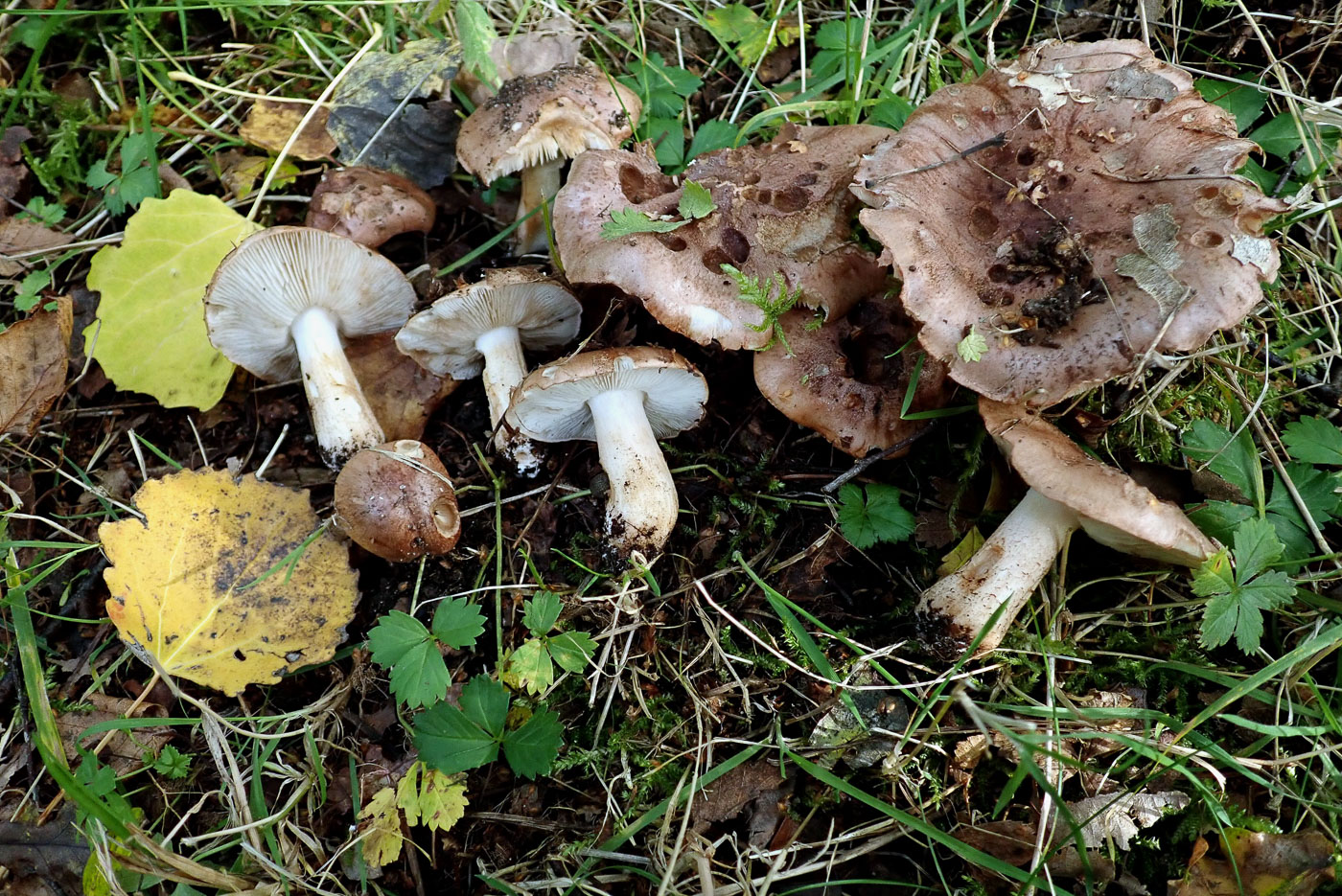
|
Tricholoma populinum (Poplar Knight)
Nov 2, 2021. Under Poplar in Chalfont St. Peter Jesper Launder found this unusual Knight. The species was - we thought - new to the county when it turned up at Burnham Beeches last year, but Jesper knew of today's site from previous years and says he knows it from various other local spots as well, where it can grow in abundance. So it sounds as if its not that rare but has just been missed before. It only occurs under Poplar species including Aspen, so is one to look out for when amongst those particular tree.
Oct 19, 2020. Penny C. noticed a cluster of unfamiliar mushrooms in grassy litter under mixed trees in Burnham Beeches. On picking one she noticed the Tricholomoid habit and strong mealy smell (of musty flour). Luckily Geoffrey Kibby was on hand and recognised the species from collections in Kew Gardens where it grows under Aspen. This is a rare Knight, known in England more or less south of the Thames, and always under Aspen or hybrid Poplars. So a new species for the site and the county and possibly also the further north it has been observed.
|



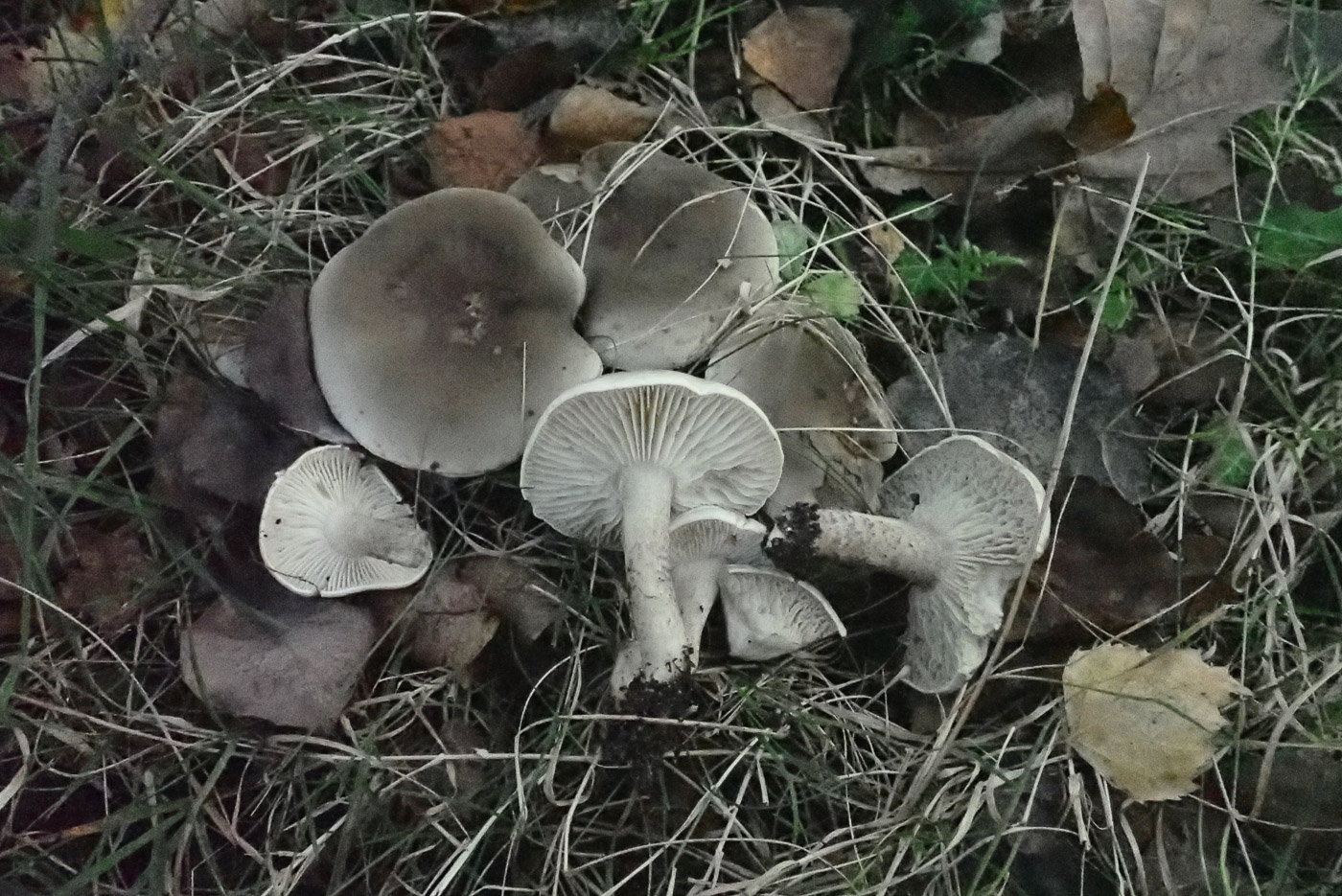

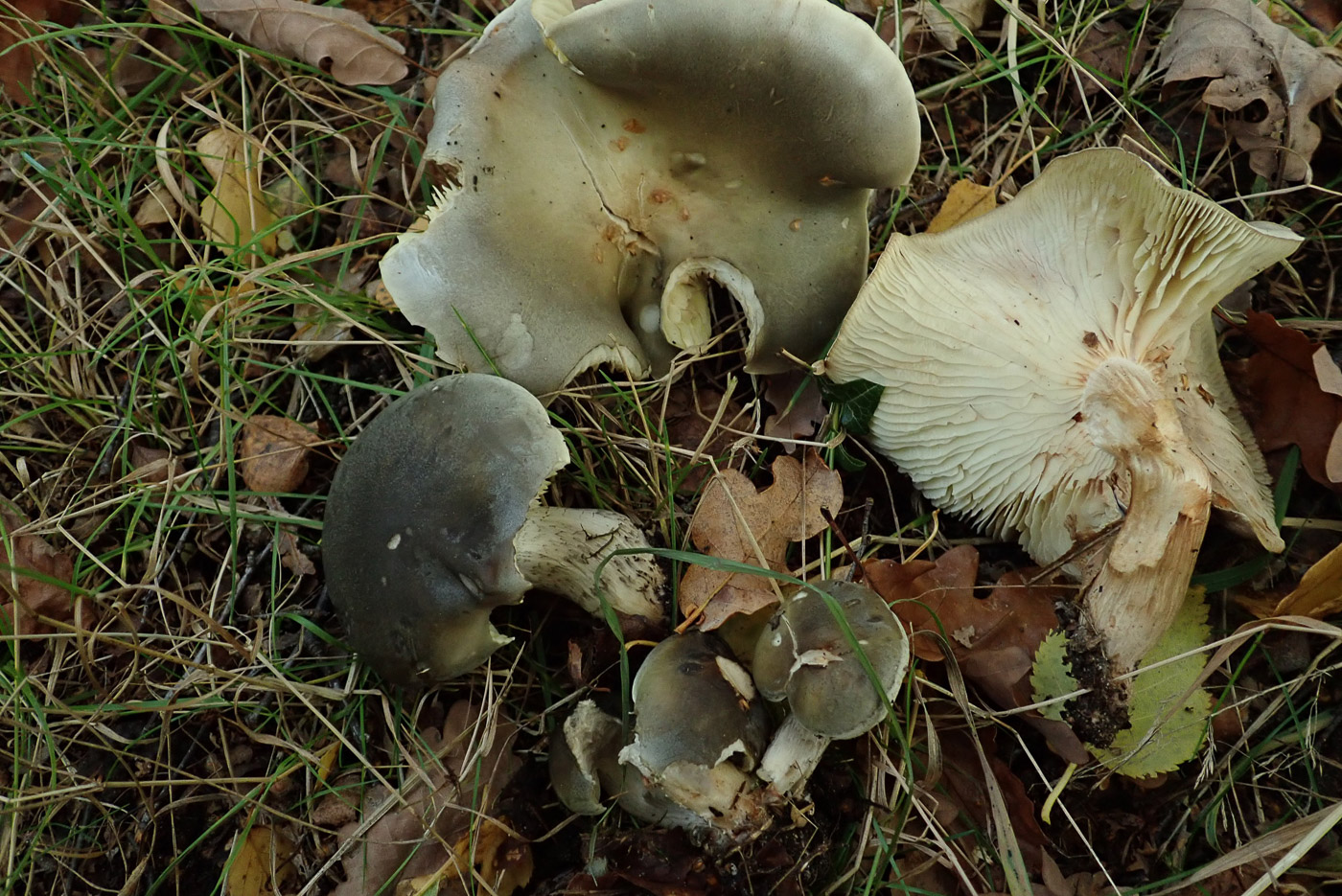
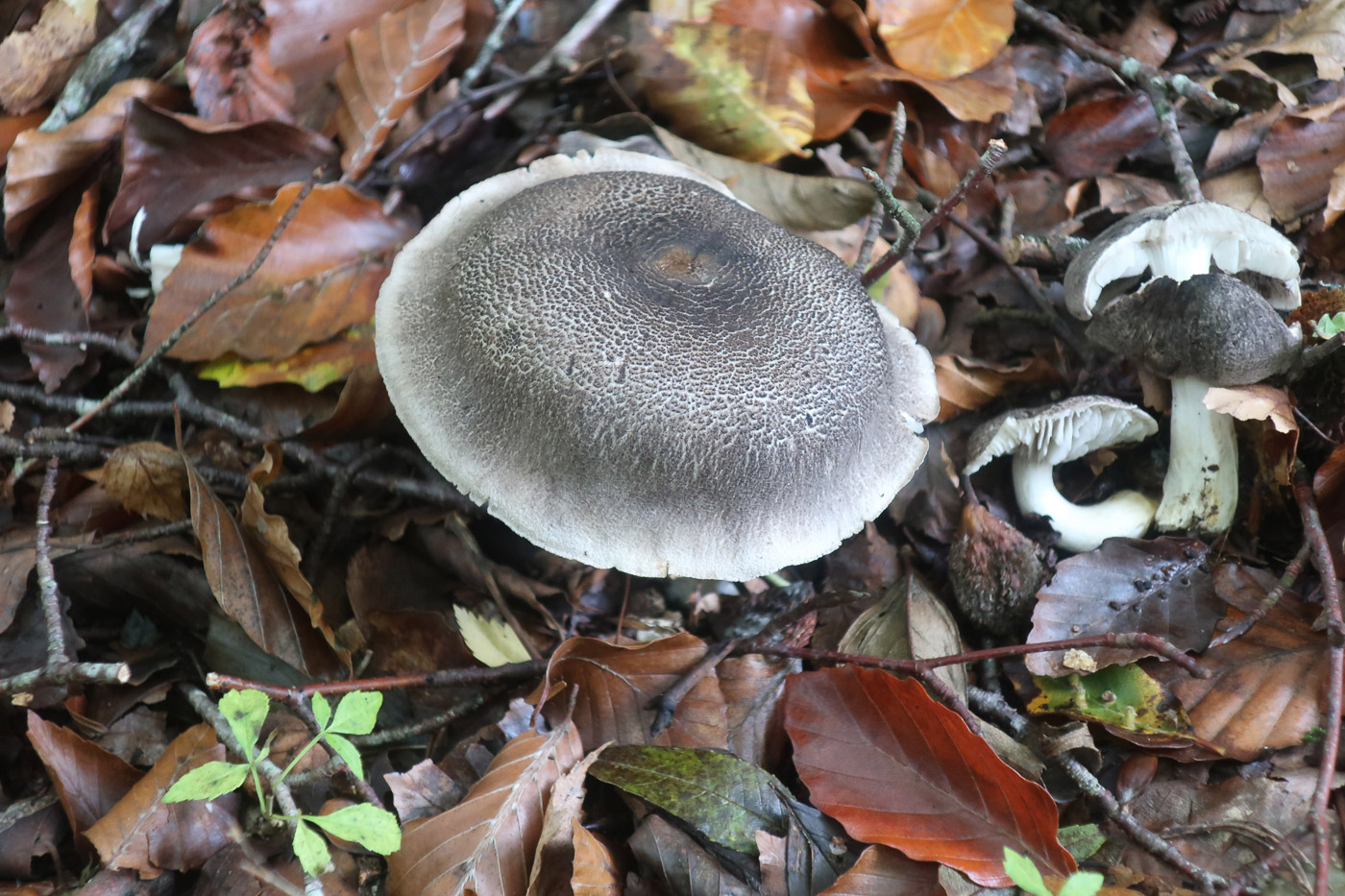
|
Tricholoma saponaceum (Soapy Knight)
Aug 30, 2023. Under Oak in Bernwood Forest Penny and Paul found a cluster of Knights which foxed Penny in the field, having dark brownish dry caps and stems with distinctive blackish squamules. It was not until flipping through images at home that she realised it was the very variable T. saponaceum, then confirmed by its unpleasant smell of unperfumed soap (which she'd not checked for in the field since the cap colour did not conform to her concept of the species). Usually having a cap some shade of grey though often with olive tinges in the outer half - which can be seen in photo 1 - this appears to be a species complex with several named varieties (one being var. squamosum) which in time may warrant raising to species level. Hence this collection will be sent for sequencing. See in Finds 2020 October 14 and 19th, also 2021 November 9th, for examples with very different caps from those shown here though several with stems having similar markings.
Nov 9, 2021. In a grassy glade under Birch at Burnham Beeches Penny found several groups of this quite common Knight, one that occurs under many different trees. It is medium sized for the genus, has a smooth rounded cap with greyish colours having a hint of olive green and often a paler edge as seen here. The gills are white and the stem also, though sometimes with bands of darker scales, seen in photo 2, when in some books named as var. squamosum.
Oct 19, 2020. We do have a previous photo of this species (dated Oct 14), but it is so variable a species and this collection from Burnham Beeches so different that it is worth including again. Found under Birch by Penny C., in contrast to our other photo these specimens had smooth caps with a distinct olive green tint, yellowish gills and a stem with faint black flecks (visible in photo 2) The common factor is the strong soapy smell.
Oct 14, 2020. Richard Fortey found this quite common Knight in Gussetts Wood under Beech. It is one of the many Knights having a grey cap but the only one having a smell of unperfumed soap. It is very variable in appearance, with basically greyish caps but with tones of green or olive, also often with a paler margin as seen here. The cap and stem surface can be either smooth or finely scaly as also seen here.
|
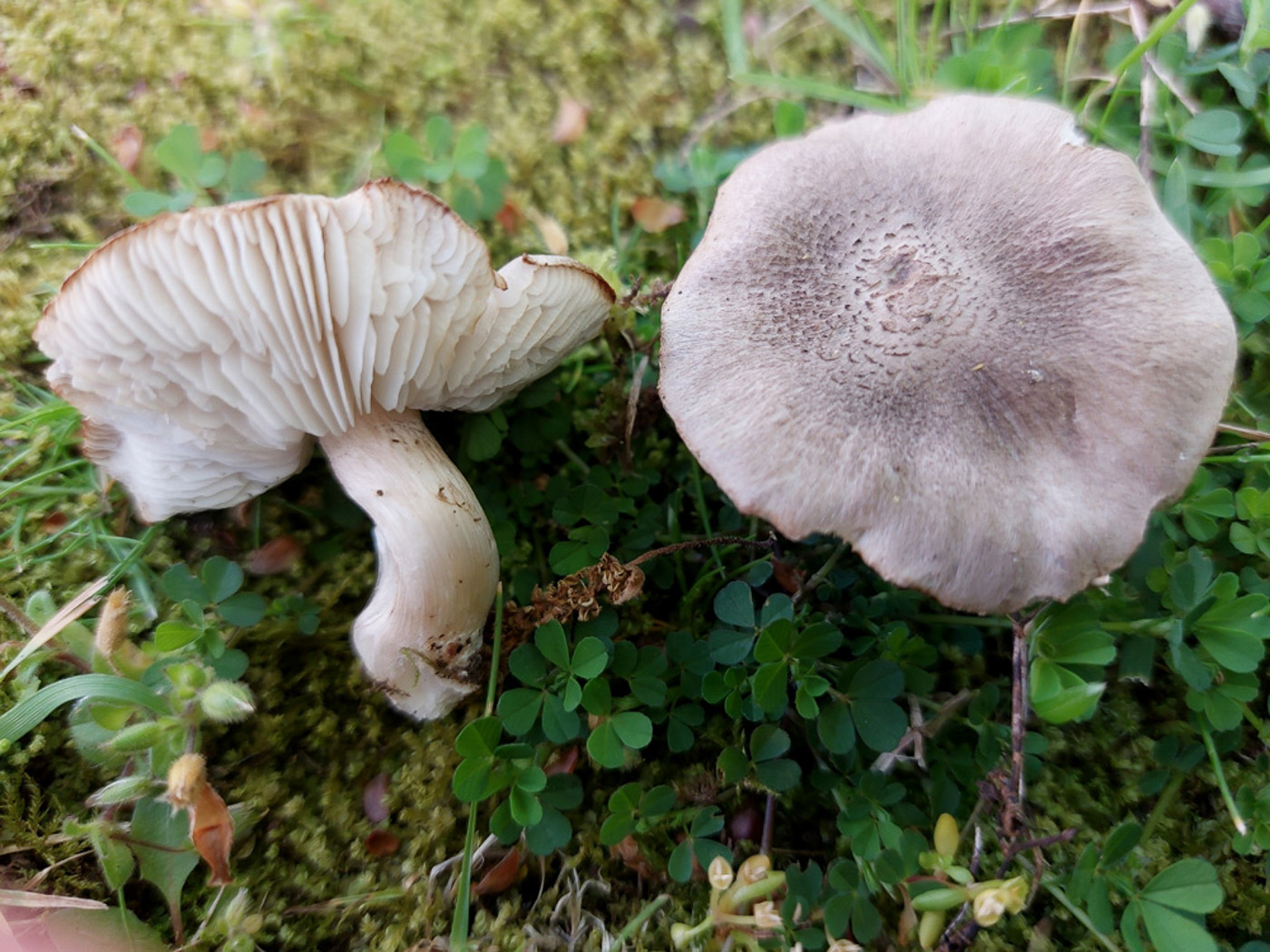


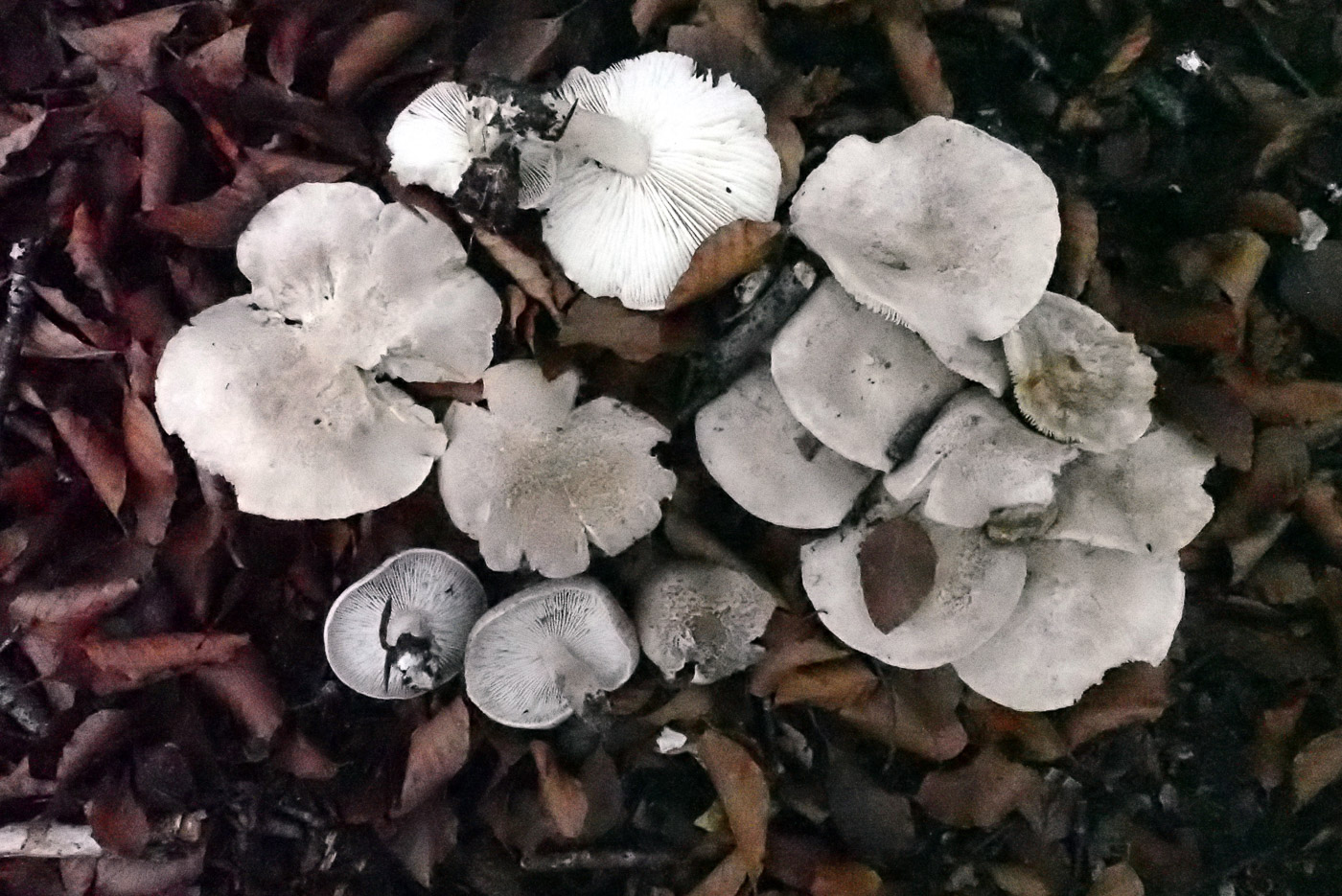
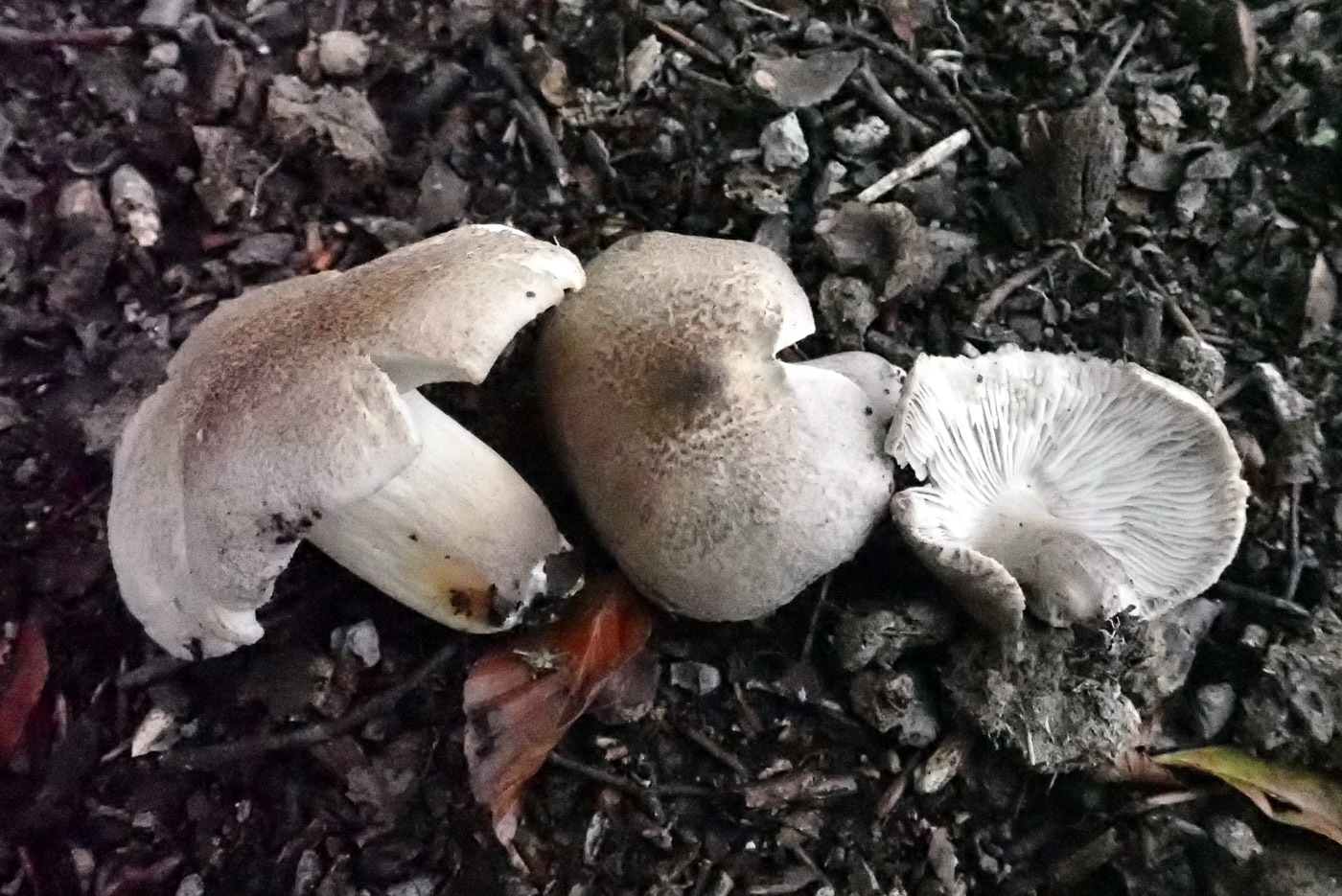
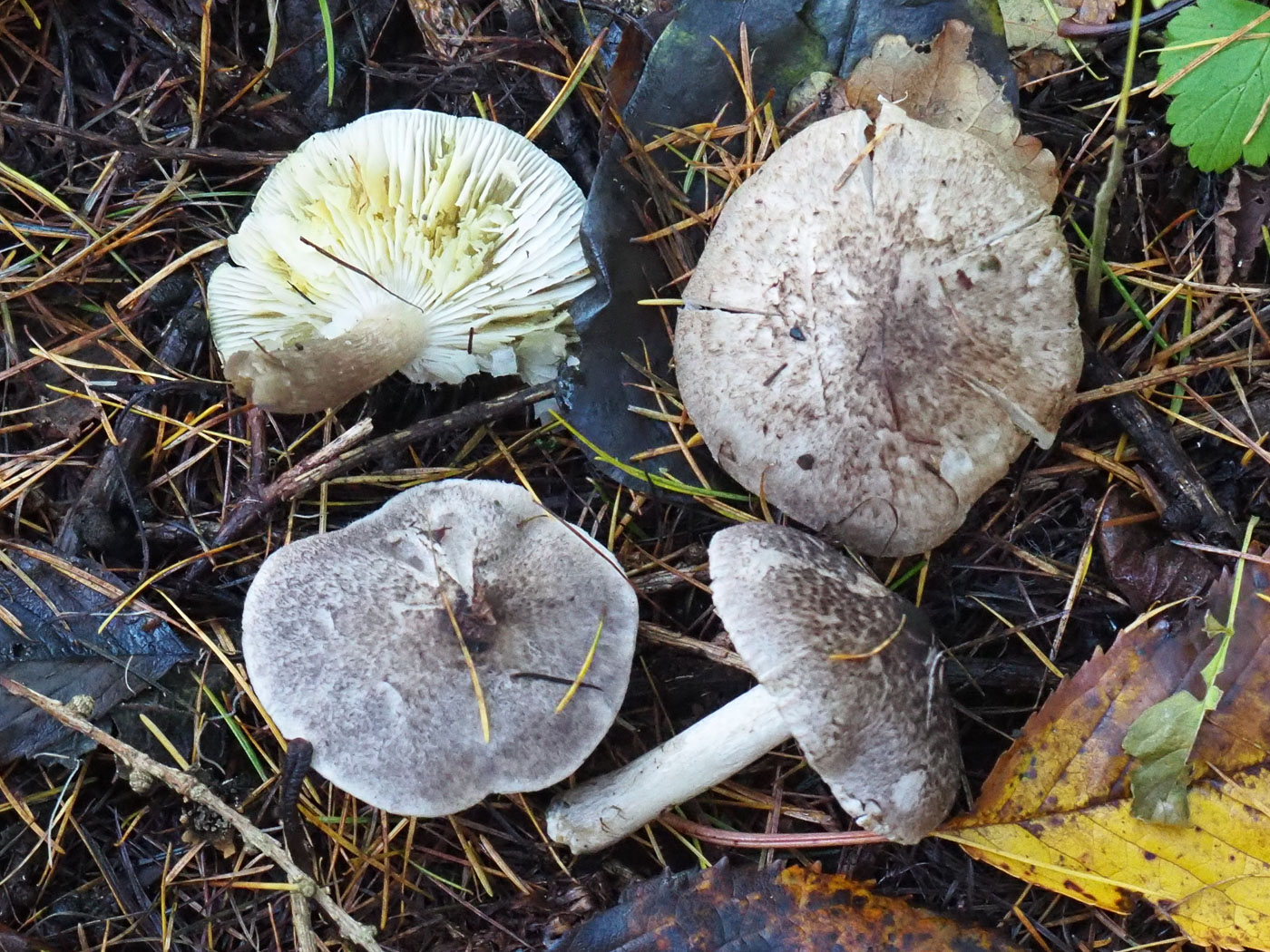
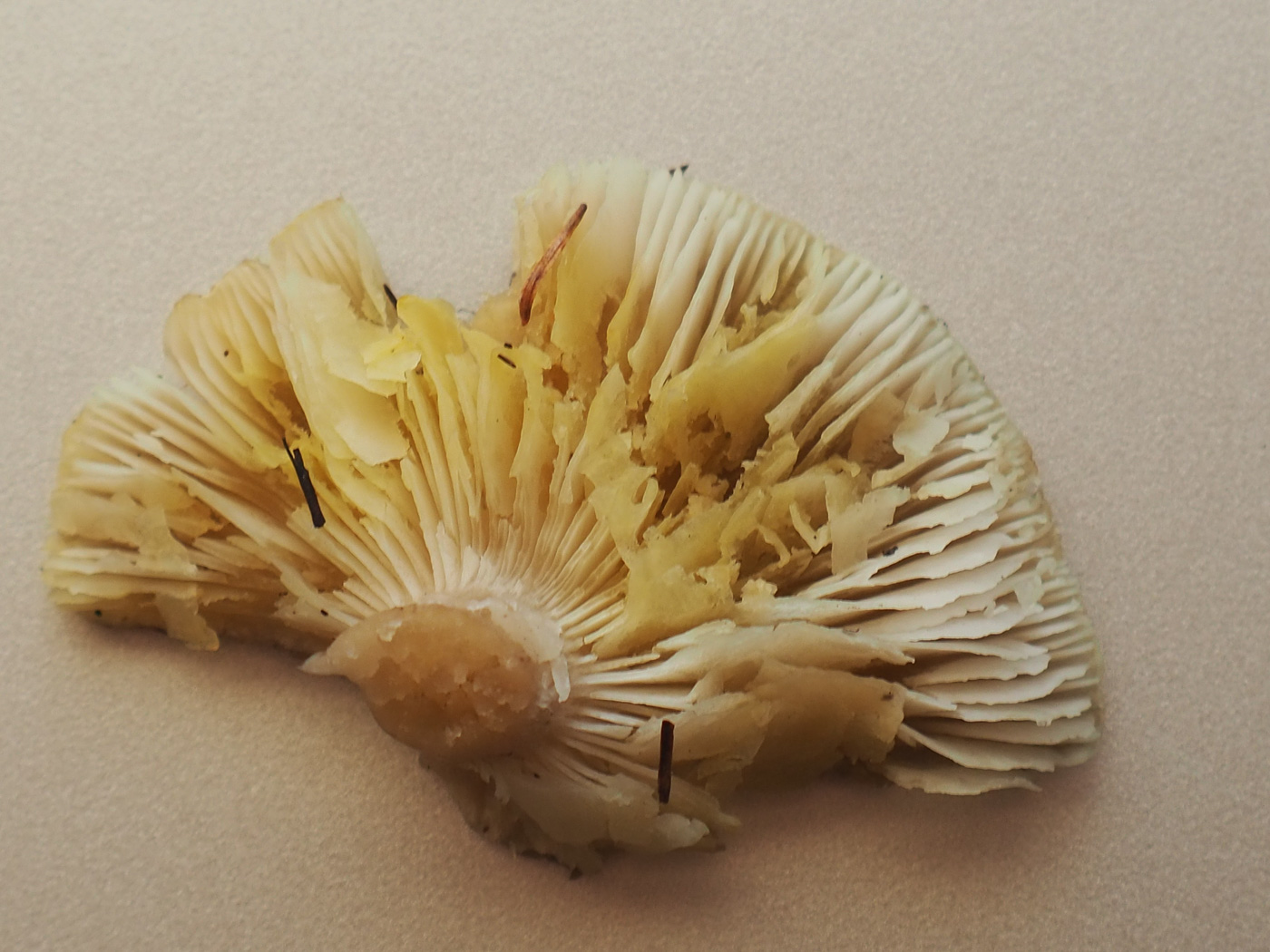
|
Tricholoma scalpturatum (Yellowing Knight)
May 8, 2024. Under Birch in a roadside verge in Stoke Poges Jesper Launder noticed two instances of this species - quite common in autumn not unusual as early as this in the year. One of quite a few dirty white to greyish members of this genus, it is paler than most and when old tends to develop yellow patches around the cap rim and gills - not seen here. it is one that has a farinaceous (musty floury) smell.
May 11, 2023. In Gerrards Cross under mixed deciduous trees Jesper Launder found this species - one we associate with autumn fruiting. It is one of our commoner grey-capped Knights, having a mealy smell and a slightly scaly surface and when older tends to turn yellow where damaged - not seen here, however. We have many records, the vast majority from September - November but a smattering from earlier in the year.
Dec 2, 2020. Under a large Beech at Pulpit Hill Penny C. was surprised to find a collection of this mushroom in such good fresh condition. We do have a previous photo (dated Nov 05) but this seemed worthy of inclusion and shows that not all the larger agarics have now stopped fruiting. This collection doesn't show the typical yellowing with age of this species but there was a rotting specimen nearby which was entirely yellow!
Nov 5, 2020. John Catterson found and identified this quite common species found under mixed deciduous trees in Tinkers Wood. This is a medium sized Knight with a quite finely scaly grey cap and a strong tendency to yellow in the gills and at the cap margin when mature. This feature helps to distinguish it from the many other grey capped Knights, also it has a mealy farinaceous smell (though a few others also have this smell but do not turn yellow). When found without the yellowing present, however, it is hard to confidently separate it from others.
|

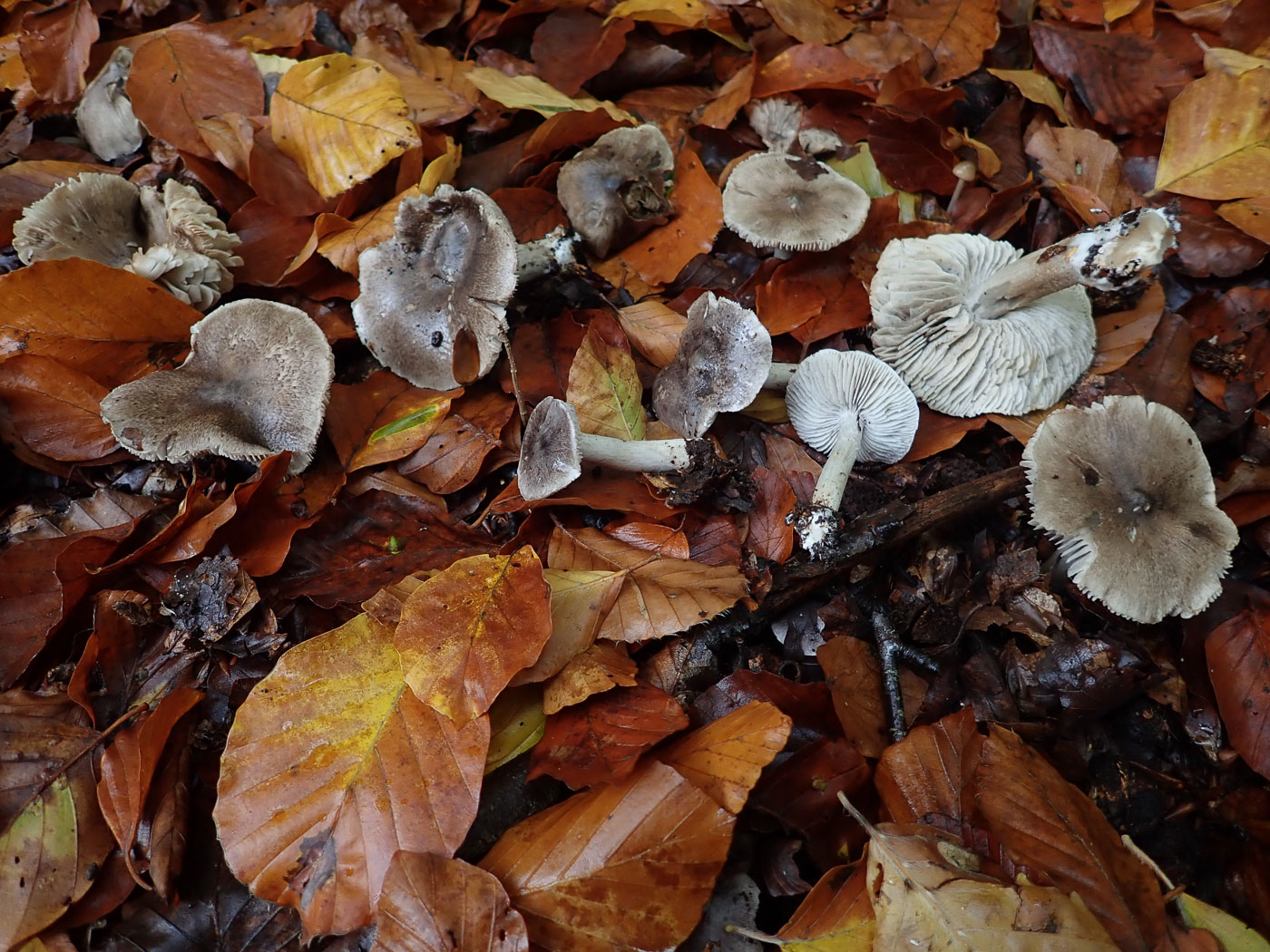
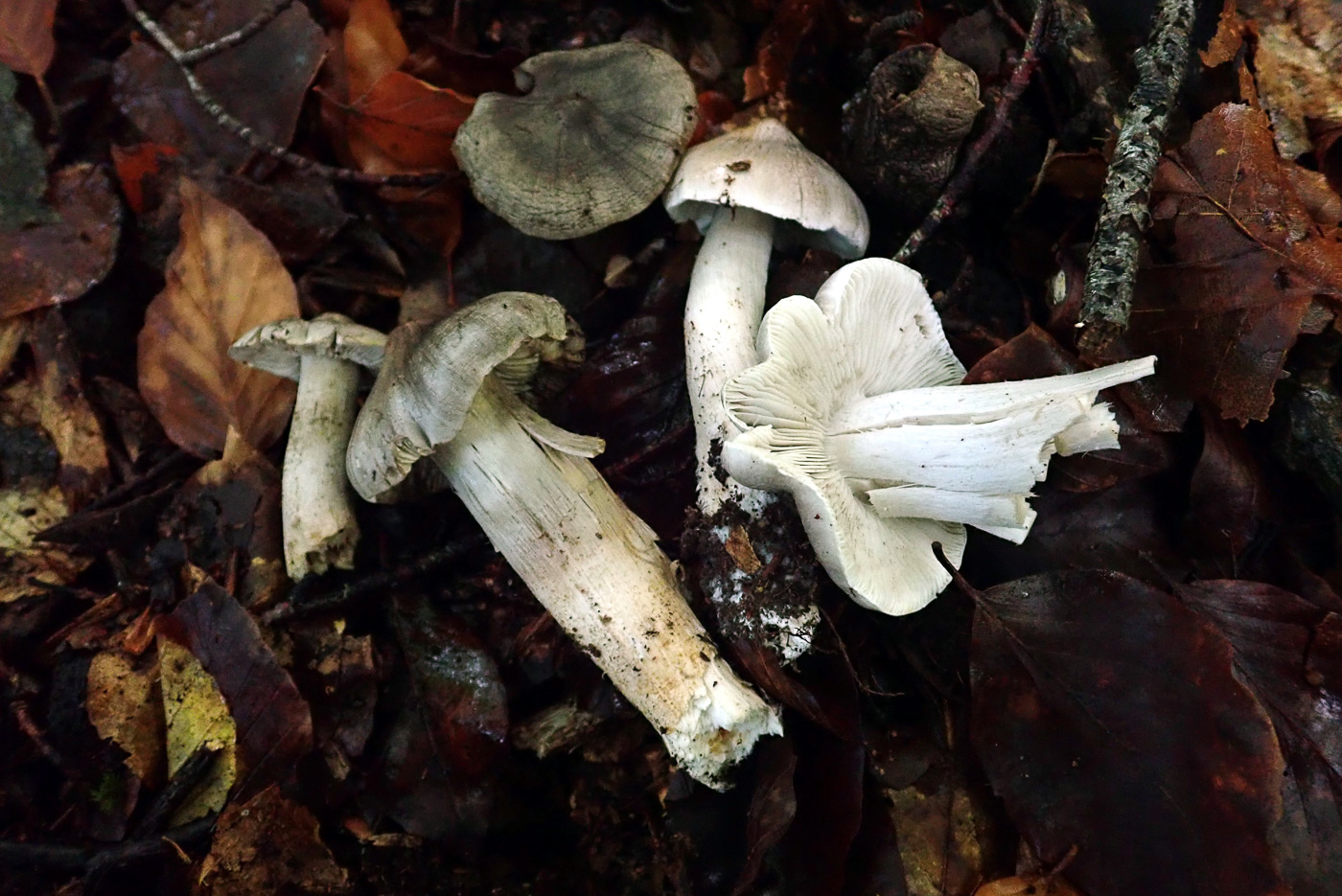
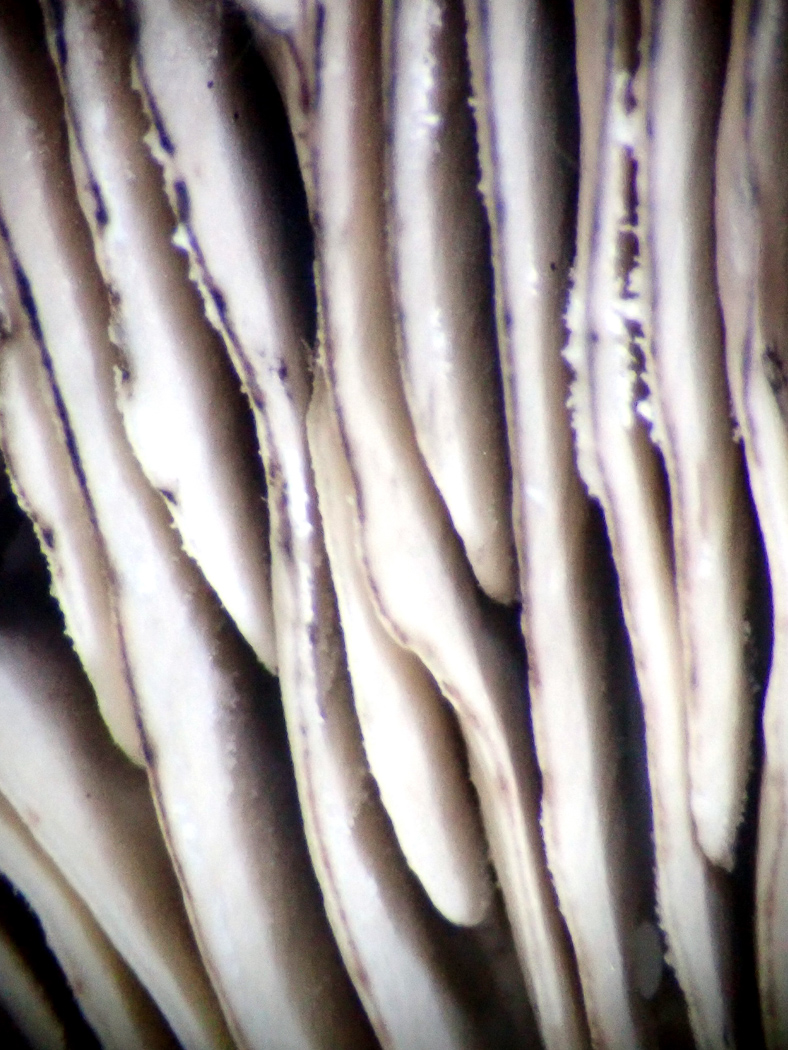
|
Tricholoma sciodes (Beech Knight)
Aug 21, 2023. In Bradenham Woods Penny found this cluster of grey Knights under Beech with which it is host specific. One of several somewhat similar grey-capped Knights, the species is the most likely under Beech though not the only possibility! However the silky surface and conical shape when small, also the black gill edge (just visible in the LH upturned specimen) together with the lack of much smell and unpleasant taste help to confirm the ID. It is locally common in our area wherever Beech is present. See also in Finds 2020 September 24th and 2022 October 21st.
Oct 21, 2022. In Gussett's Wood under Beech there were plenty of these Knights which are host specific to this tree, found by Penny. There are many grey capped Knights which can be confused, but this species has a smooth quite pale cap, often with a small umbo, and has an earthy slightly raphanoid smell.
Sep 24, 2020. Penny Cullington found this collection under Beech (with which it is host specific) in Mousells Wood. An occasional though not uncommon species given the frequency of Beech in the Chilterns, it is one of quite a few grey capped Knights with which it can be confused. Note the slight umbo (central bump) and smooth but slightly streaky surface on the cap (also features of T. virgatum which, however, frequents conifer or birch, but not Beech), also with care one can see a black edge to the gills in more mature specimens (see detailed photo) not found in T. virgatum.
|


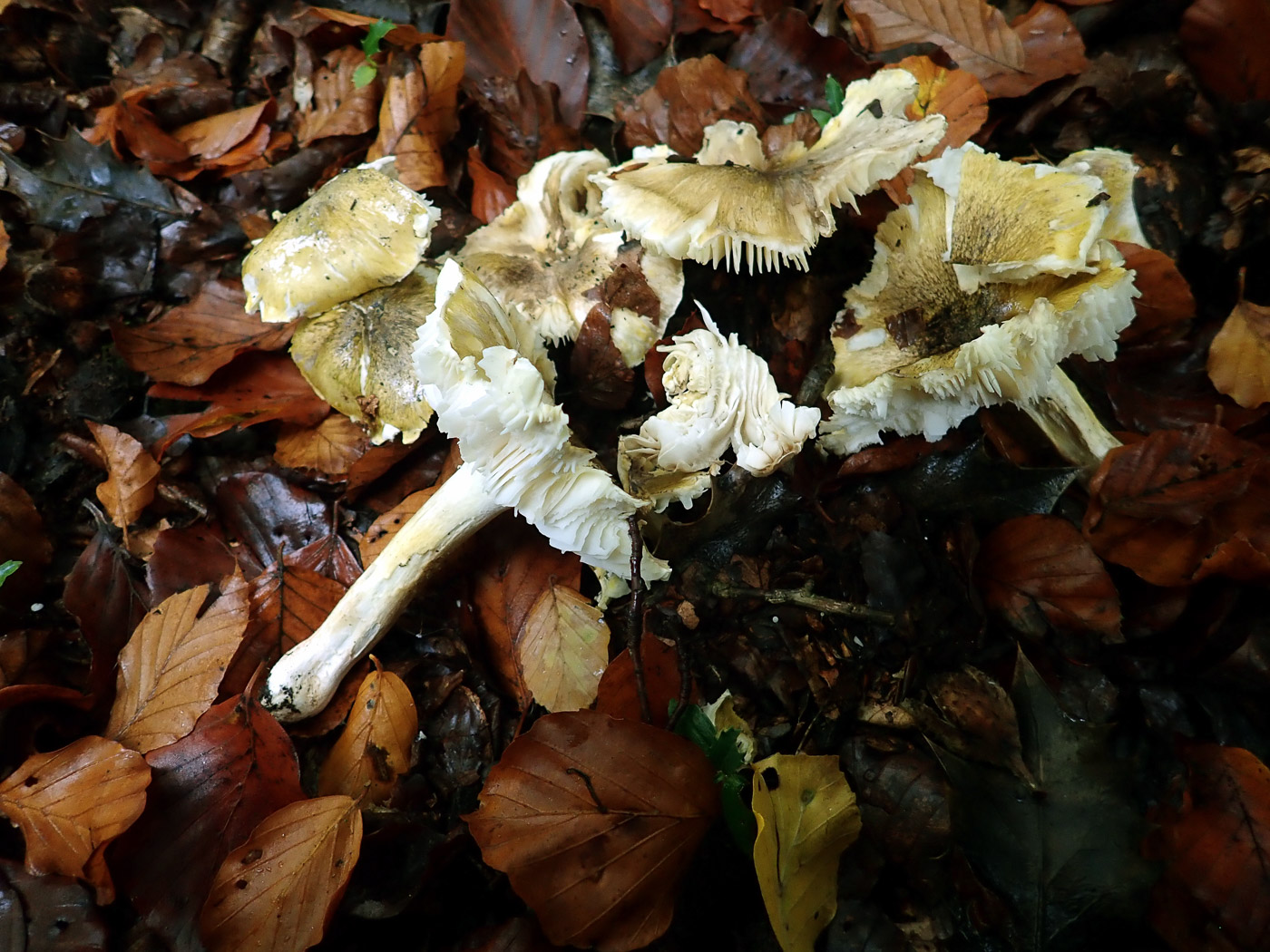 |
Tricholoma sejunctum (Deceiving Knight)
Aug 19, 2023. Beside a muddy ride in Rushbeds Wood Penny came across a large patch of these quite unusual Knights under Oak. They were, however, somewhat past their best, also quite faded from their exposed position, but their fibrillose surface and unusual greenish colour was still visible on a couple of caps though the greenish droplet markings visible on the central cap margin are not mentioned in descriptions. The yellow staining on the upturned stem is a further character of the species which has a farinaceous smell. This was new to the site and we have one previous image in Finds: 2022 October 21st. Photo 2 was found by Penny in Bernwood Forest on August 30th, also under Oak, and shows a fresher collection with more typical coloured caps.
Oct 21, 2022. Under Beech in Gussett's Wood Penny found just one place with a few of this unusual species of Knight fruiting, though sadly all were rather damaged and past their best. The greenish yellow cap colour with darker fibrillose streaks is quite distinctive amongst members of the genus. This is a first entry for Finds.
|
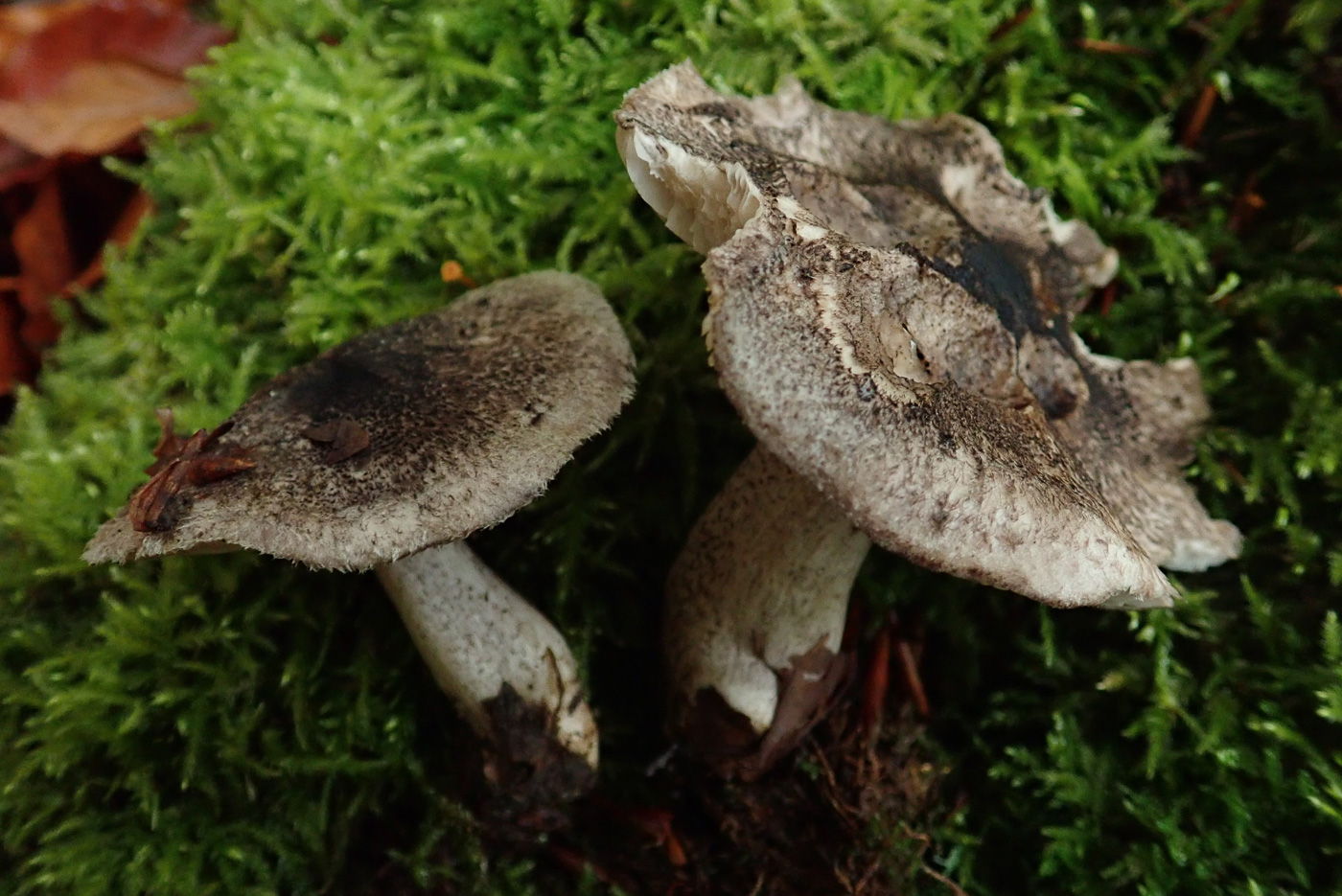
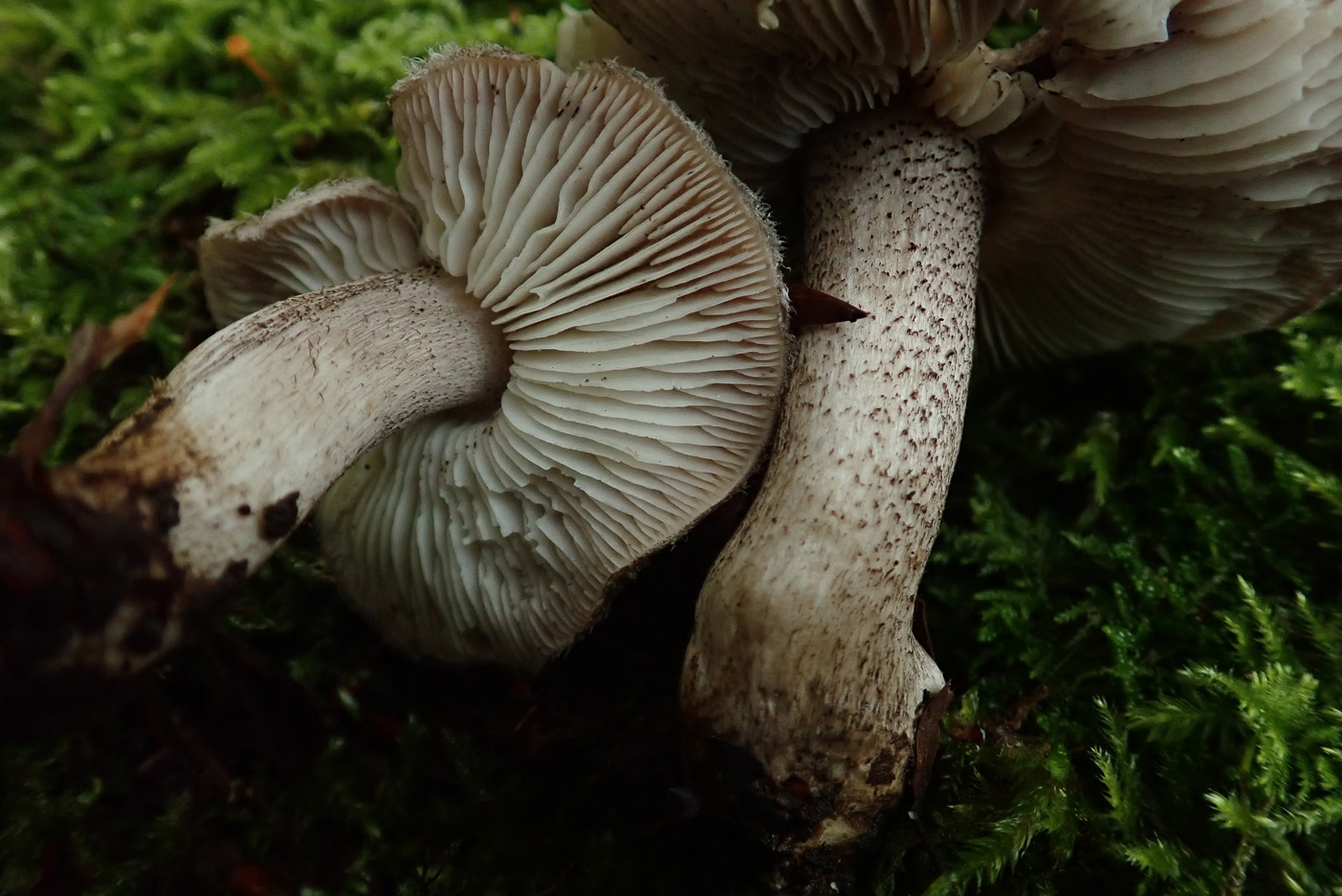 |
Tricholoma squarrulosum (Dark Scaled Knight)
Oct 24, 2020. Paul C. found this pair under Beech in Gussetts Wood. One of many grey-capped Knights, this occasional species is often confused with the very similar T. atrosquamosum which also has a dark scaly cap, almost black at the centre. However, the black stem scales seen here convinced Penny C. that it was not that species which has a shiny stem, also the Beech habitat is typical for this species.
|


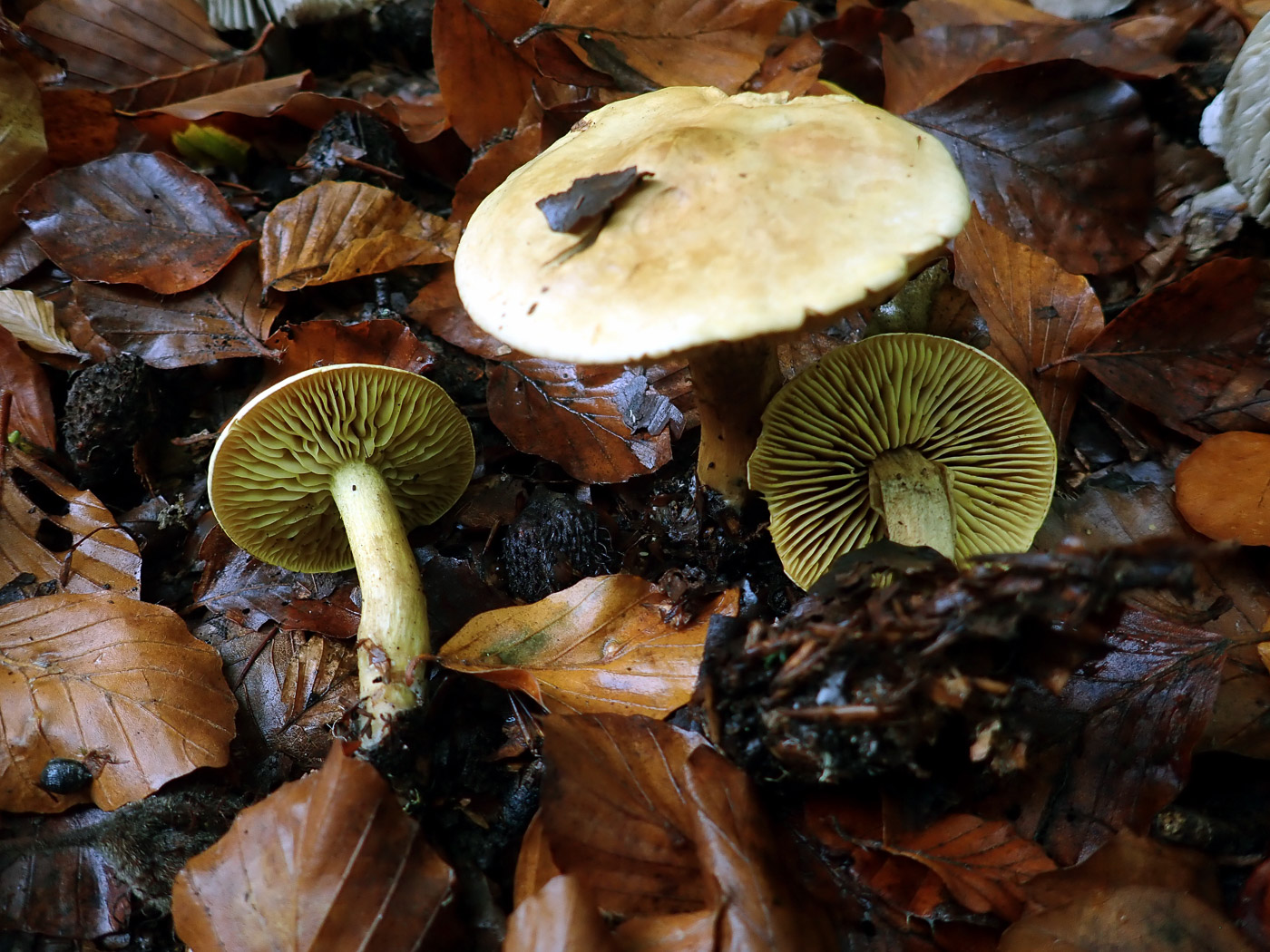
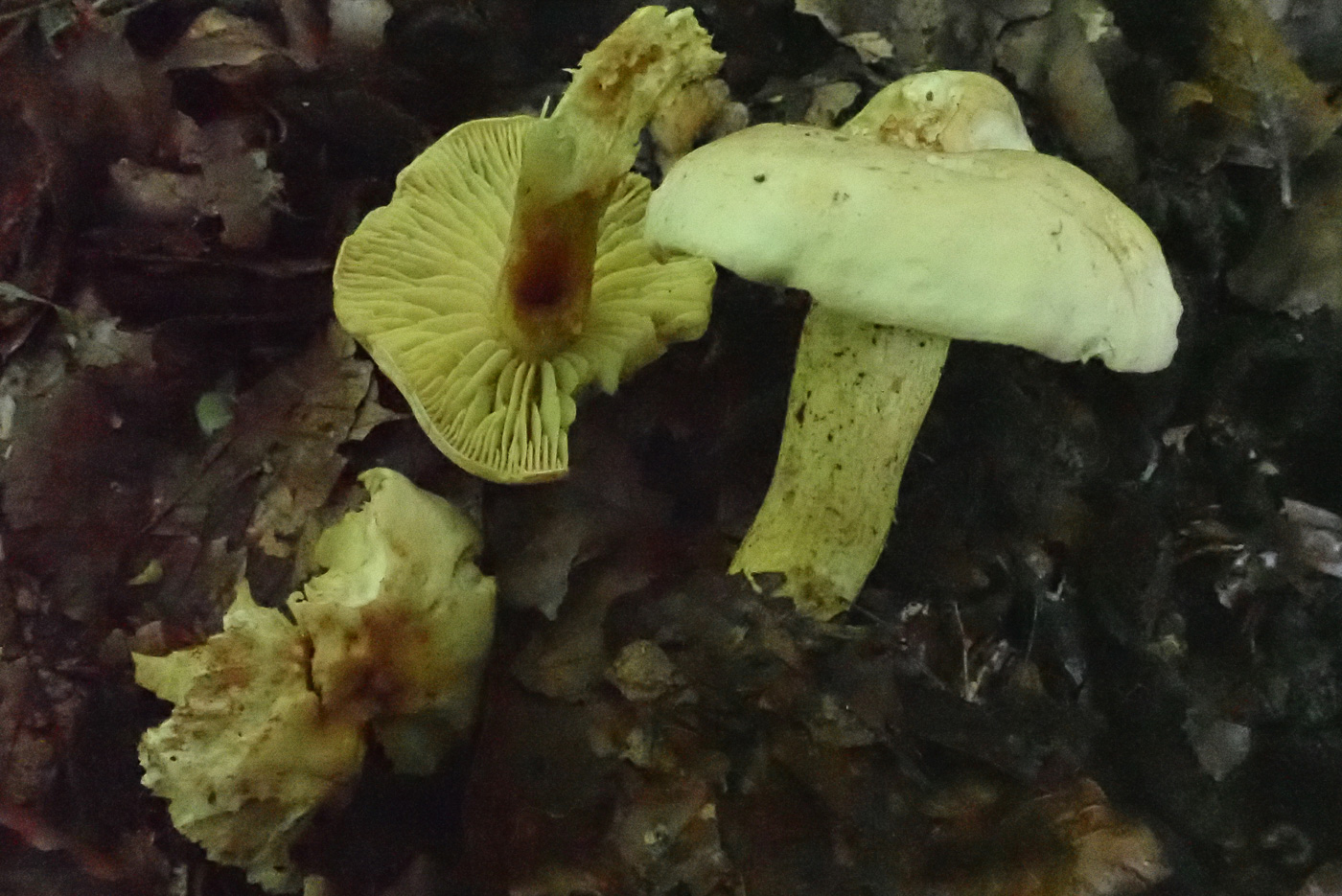
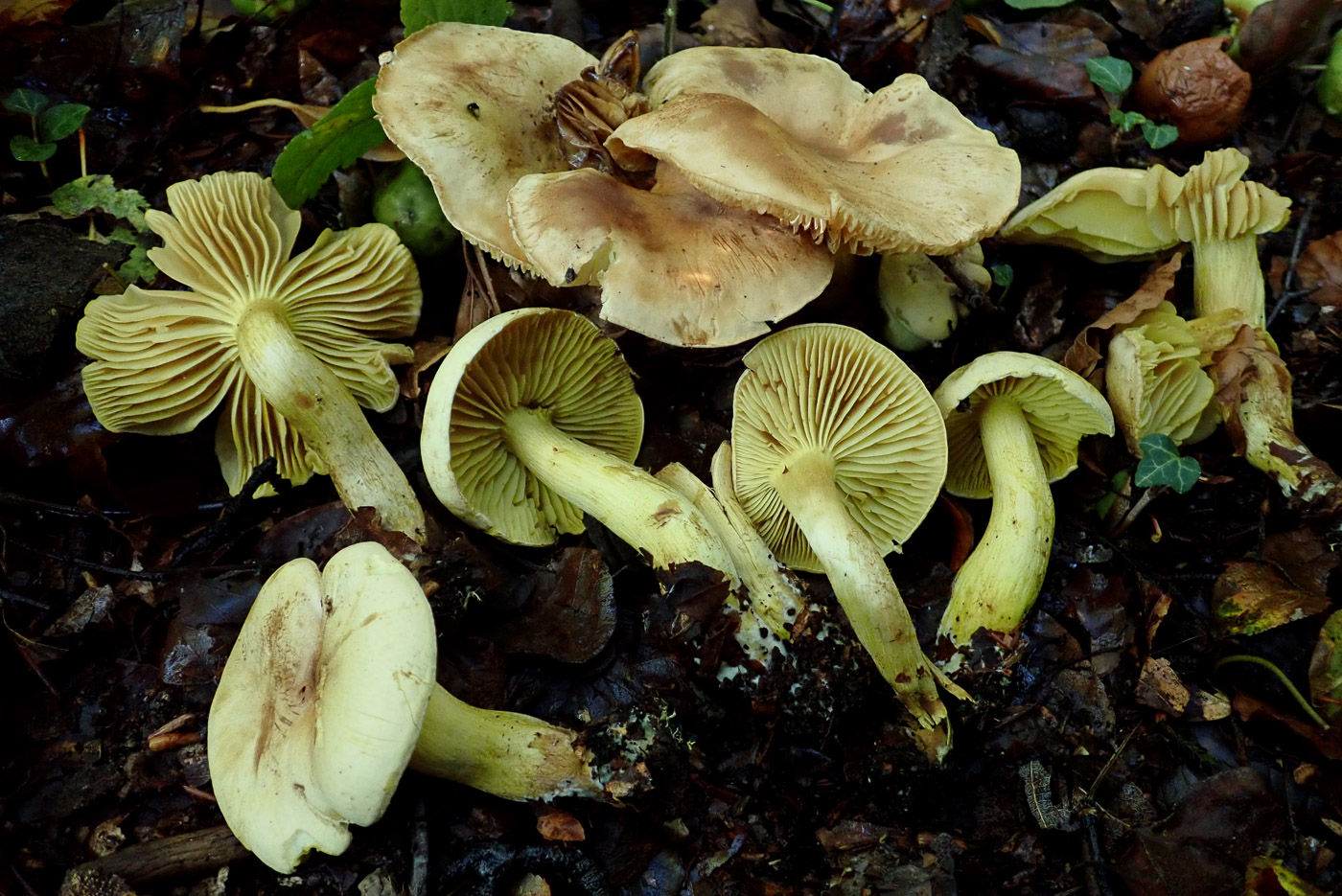
|
Tricholoma sulphureum (Sulphur Knight)
Oct 26, 2023. Under Oak in Bernwood Forest Penny found quite a few of this distinctive Knight just starting to fruit. This is one of the easiest in the genus to recognise, having clear yellow colours in cap, gills and stem but also if collected and put near ones nose, the unmistakeable unpleasant odour of coal gas tar (bad eggs) leaves little room for doubt.
Aug 23, 2023. At Mousells Wood under Beech Penny found just one little group of this common knight pushing up through the litter. The dry pruinose yellow cap can vary in colour with shades of green and/or brown and is often much brighter yellow than here, but one sniff of the strong coal gas tar smell is enough to confirm its ID. Most often under Beech it is not unusual under Oak and on occasion other trees including Pine. See the Masterlist for a choice of other images.
Oct 21, 2022. In Gussett's Wood Penny found just one little cluster of this normally very common Knight which is happy under both Beech and Oak, less commonly also under Pine. Its distinctive colour (cap, gills and stem) together with its strong sulphurous smell (bad eggs!) make it one of the easiest to recognise.
Oct 6, 2021. In Kings Wood Tylers Green Penny found just a very few of this striking but common woodland species, a member of a genus we've hardly seen yet this autumn. It often occurs under Oak and Beech and is an easy one to identify: not only is it entirely yellow but it has an unforgettable smell of coal gas tar. Put one to your nose and you'll see!
Oct 16, 2020. Alison Peace found this wonderful collection under Beech in Burnham Beeches (photo Penny C.) Though caps and gills are sulphur yellow when young, caps tend to become slightly brownish with age though the gill colour is always striking, as is the pervasive smell of the species! In fact we could smell these without needing to put them near our noses! They reek of coal gas tar or for some of bad eggs - unmistakeable.
|

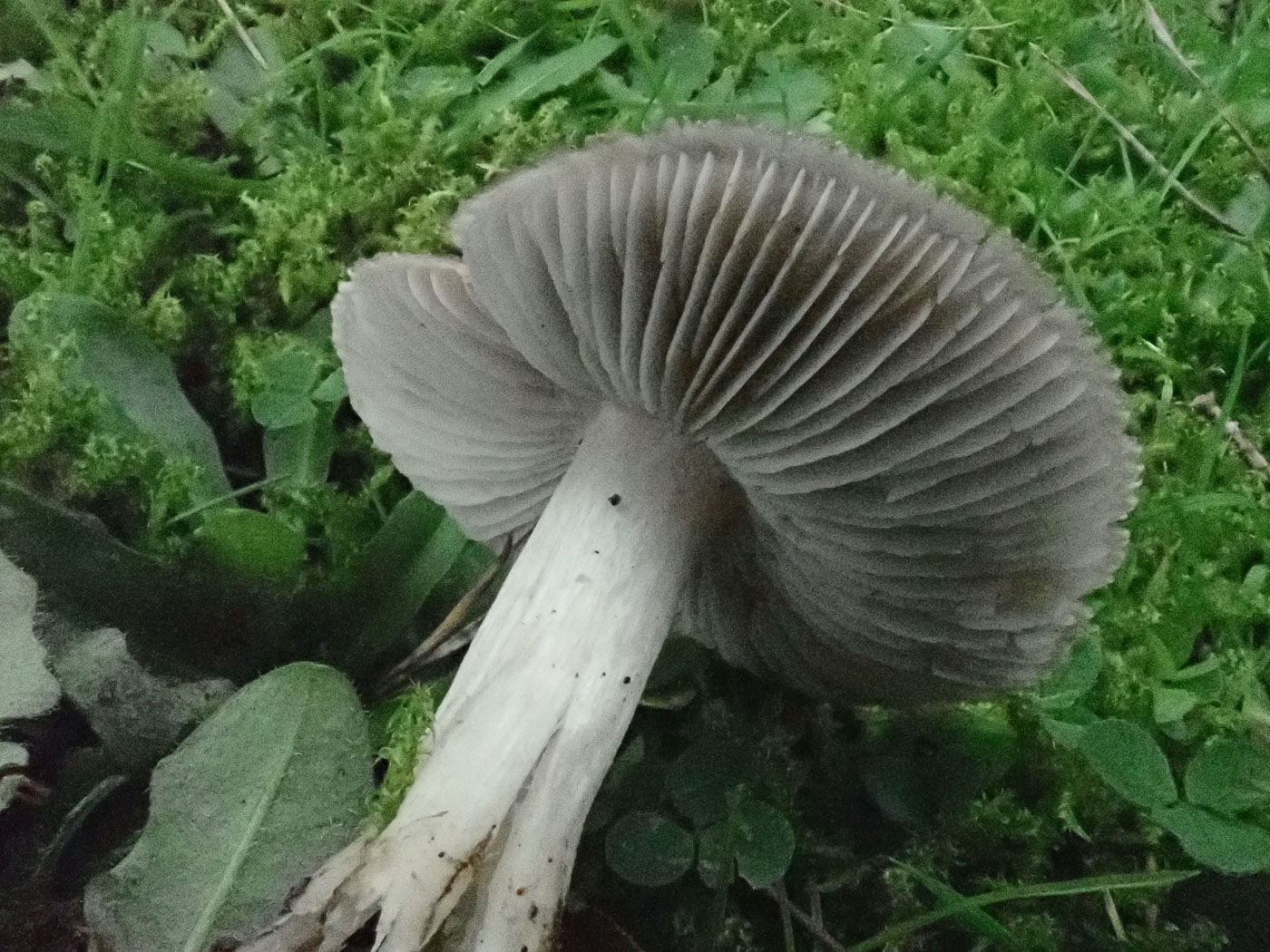
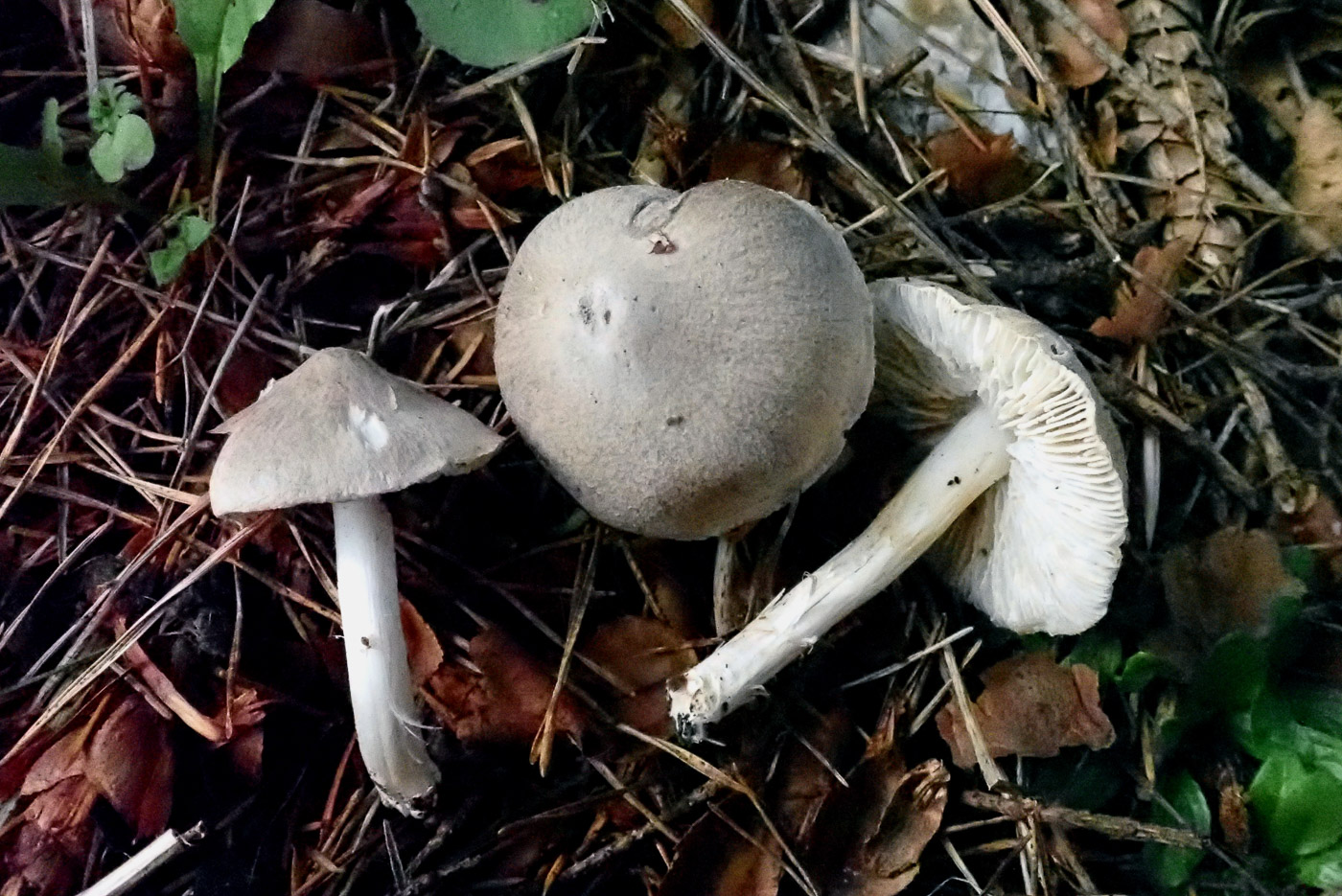 |
Tricholoma terreum (Grey Knight) 
Nov 17, 2022. In a grassy bank under Pine adjacent to Prestwood Churchyard Penny found this grey mushroom, the first impressions of which were of Dermoloma cuneifolium (Crazed Cap) but it completely lacked the strong mealy smell of that species. At home this was backed up by the presence of gill edge cystidia - not present in that species but more significantly nor in Tricholoma as far as she knew! Keys to Tricholoma do not refer to cystidia, only to spore shape and size, otherwise relying on field characters. Nevertheless she persevered with Tricholoma because there are many grey capped species - often hard to separate - and she also discovered to her surprise the following comment in one monograph: "Cheilocystidia can be found in many species ....... the abundance, shape and size is variable within species and hence of limited taxonomic value." So the grey cap colour with paler rim and dry felty texture, the faintly sweet smell, occurrence under Pine together with rather elongate ellipsoid spores led to two species: T. terreum and T. triste, the first common, the second extremely rare and both having cheilocystidia! The collection was sent for sequencing and turned out to be T. terreum - a species which more often occurs under Pine, less often under deciduous trees.
Nov 18, 2021. Under Pine at Prestwood Churchyard Penny noticed several of these pale grey Knights, took a photo and collected a couple to work on at home. The name 'Grey Knight' is not particularly helpful because there are a good many grey-capped Knights and sorting them out is not that straightforward! In a genus where there are virtually no microscopic features to help it comes down to a combination of field characters and the host tree - that in itself not always decisive either! T. terreum is one of the commonest, however; it favours Pine (though not exclusively) having a felty fibrillose cap surface (which was very obvious in today's specimens) and lacks the mealy smell present in several others. The cap can often be darker grey than shown here.
|
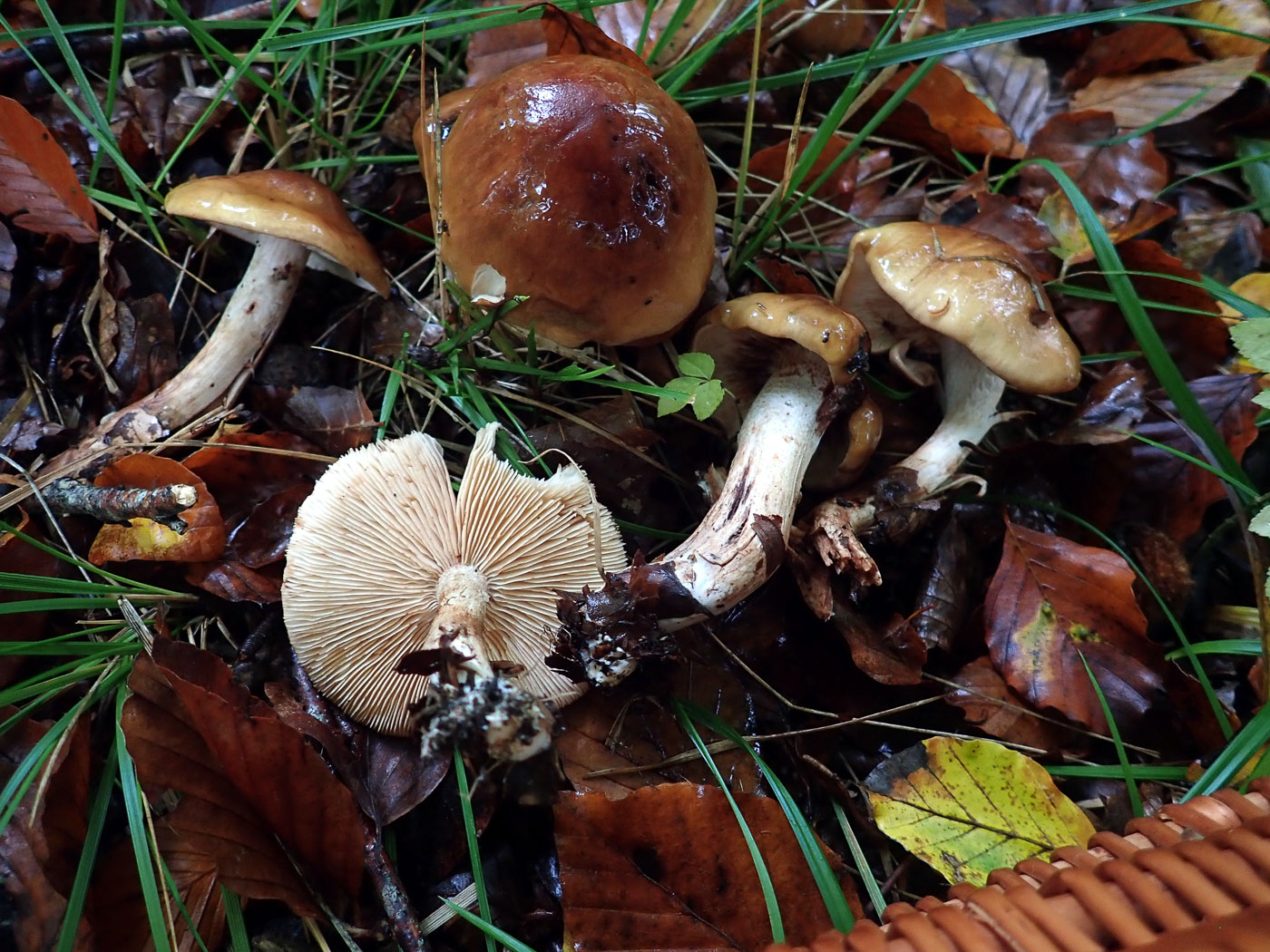
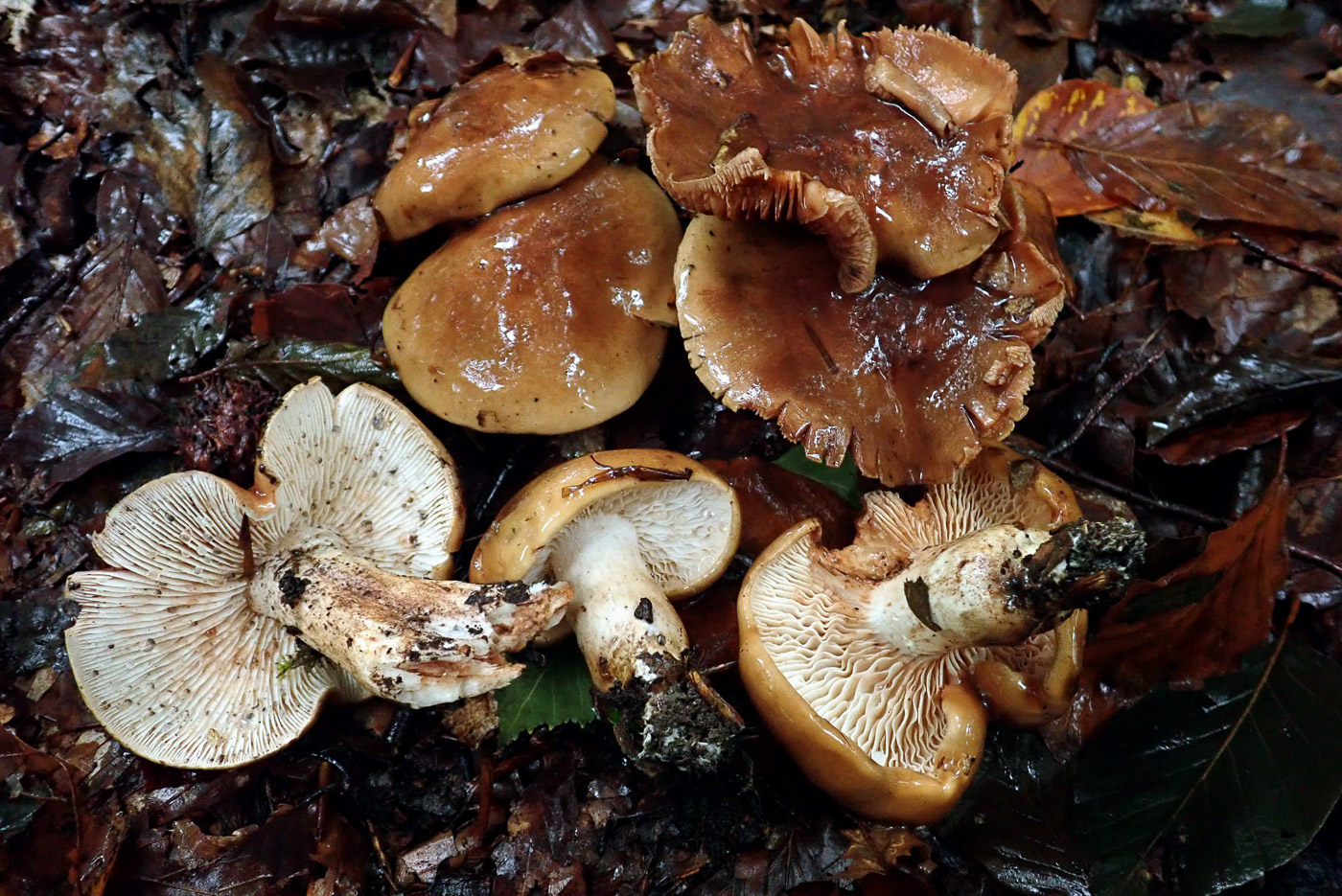
|
Tricholoma ustale (Burnt Knight)
Oct 21, 2022. In Gussett's Wood under Beech Penny found just a few of these Knights which are common given their host tree which is abundant here. Their bright brown rounded caps were typically slimy in the rainy conditions today.
Oct 3, 2020. Penny Cullington found this collection under Beech at Penn Wood. Quite a common Knight, it is host specific with Beech and in wet weather like today the tawny brown caps are shiny and slimy but in dry weather they blend into the leaf litter and are harder to spot. Caps can get to 7 cm across or more and the pale gills tend to be crinkly and become brown spotted.
|
 |
Tricholoma ustaloides (Charred Knight)
Aug 19, 2023. In thick vegetation at the edge of a ride near Oak in Rushbeds Wood Penny uncovered this clump of rich brown mushrooms which she at first couldn't place. Turning one over to see the pale gills spotting dark reddish brown reminded her of T. ustale - a Beech specific species but that tree is not present here. However, T. ustaloides is somewhat similar (hence its name) but is associated with Oak and favours clay soils, so a perfect match. It was extremely sticky - even more so than T. ustale, it has an intensely bitter cap cuticle (which Penny can vouch for!) though not visible here is the white zone just under the stem apex which apparently is another useful way to separate the two species. We have only a handful of county records and this was new to the site and to Finds today.
|
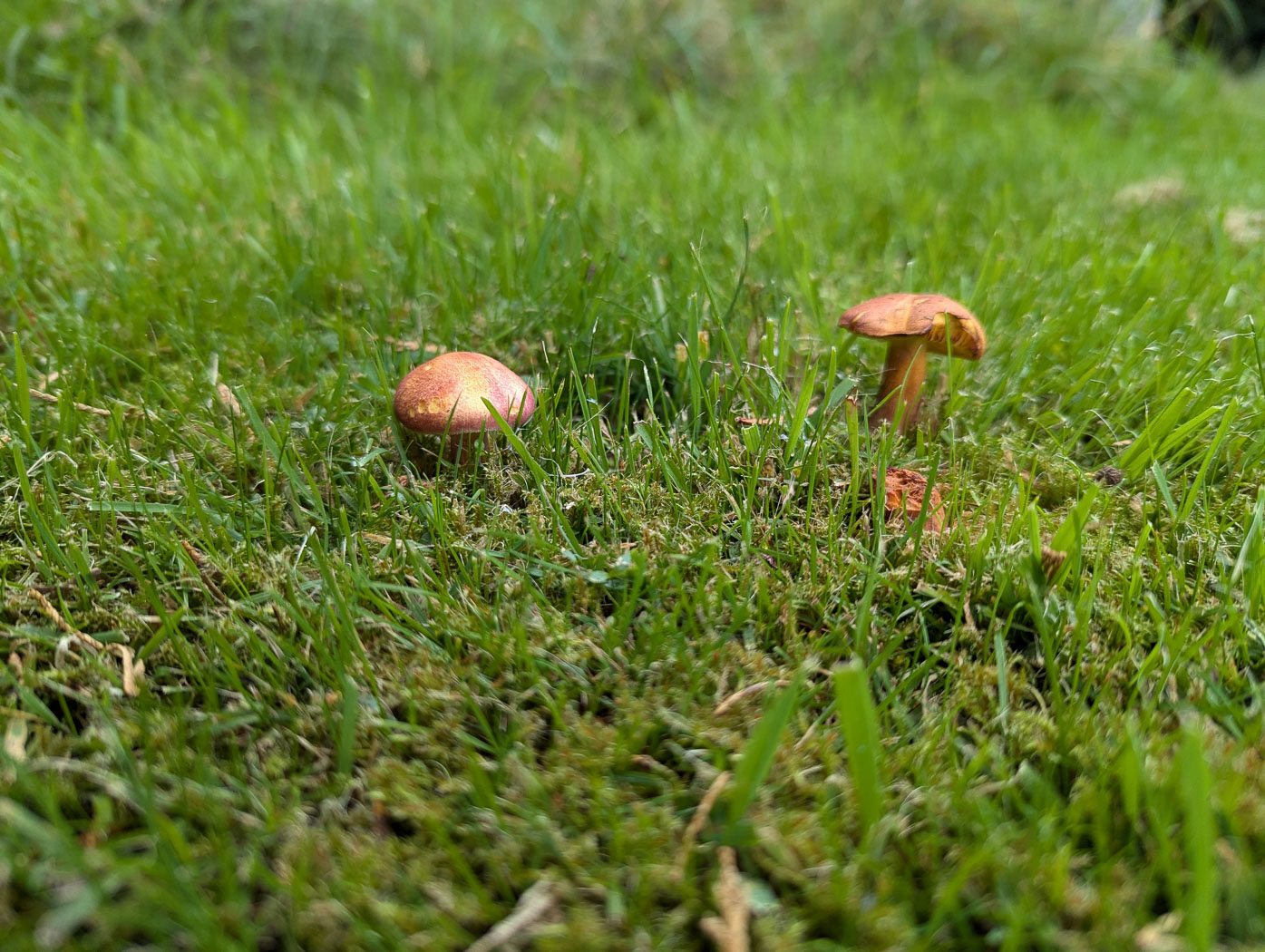
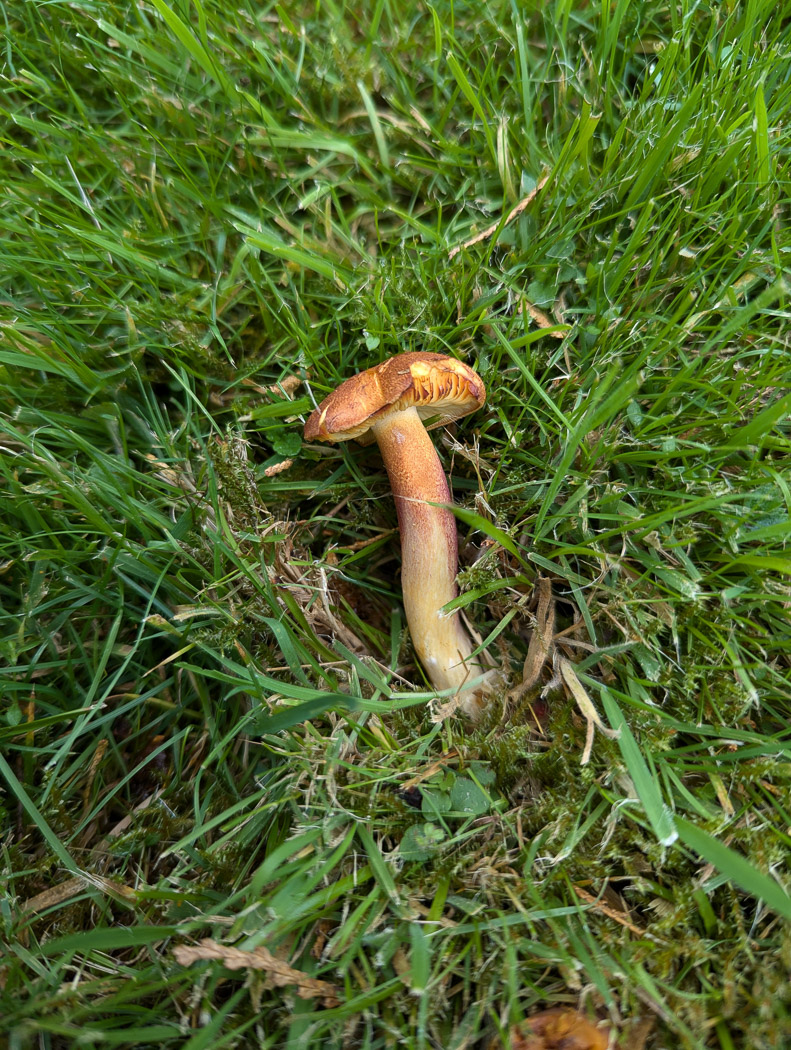
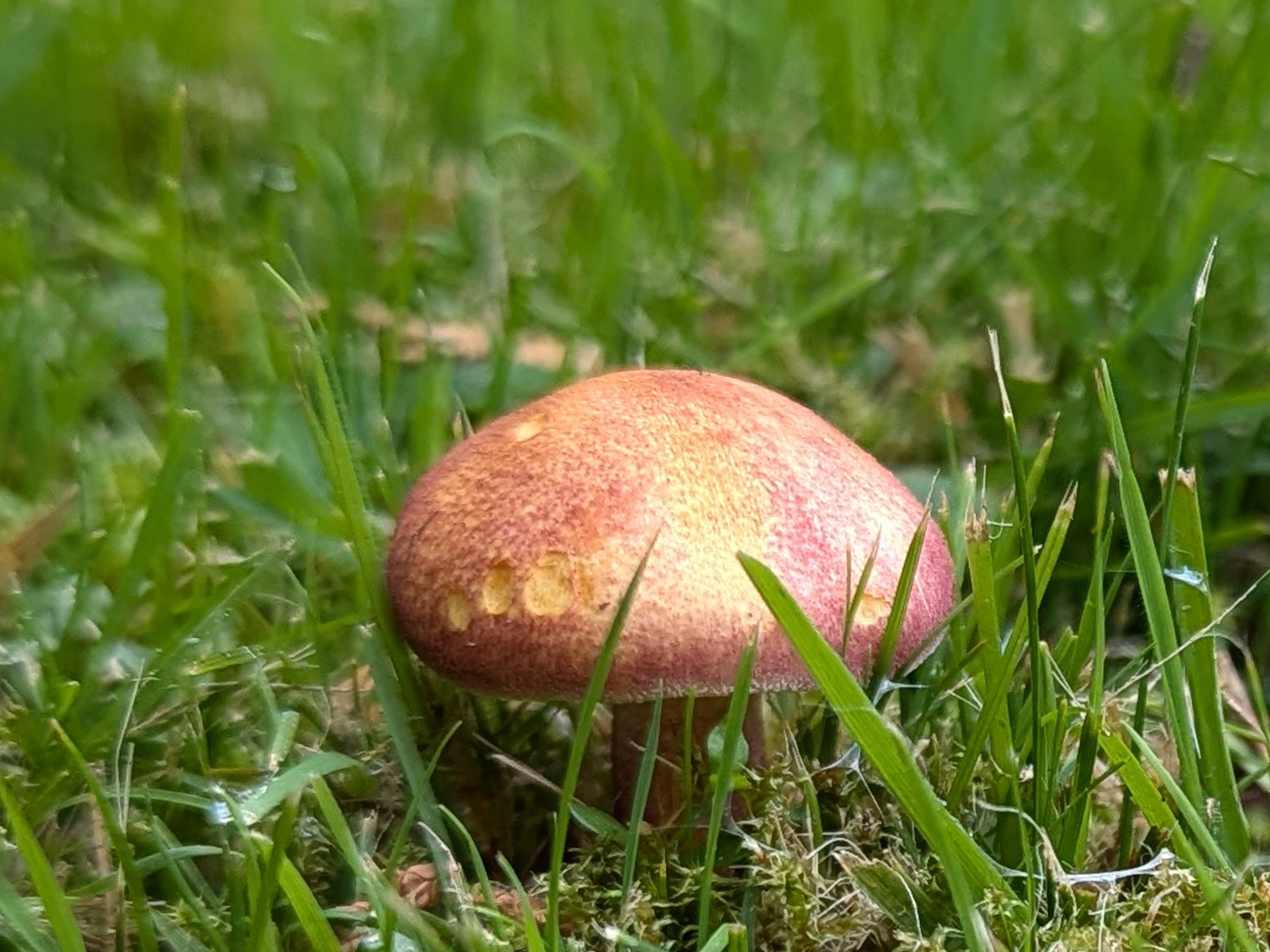 |
Tricholomopsis rutilans (Plums and Custard)
Sep 20, 2024 On a hurried visit to Penn Street Churchyard Claire Williams spotted what she assumed was possibly a Waxcap in the grass though near Pine, and sent her photos to Penny for a second opinion. However, Penny is naming this Plums and Custard (hopefully correctly!) and guesses that it was growing on submerged Pine wood or roots. The jizz just doesn't look right for a Waxcap despite the bright colours and apparent grassy habitat, also zooming in (photo 3) the typical mottled cap colours of the species become much more obvious.
|
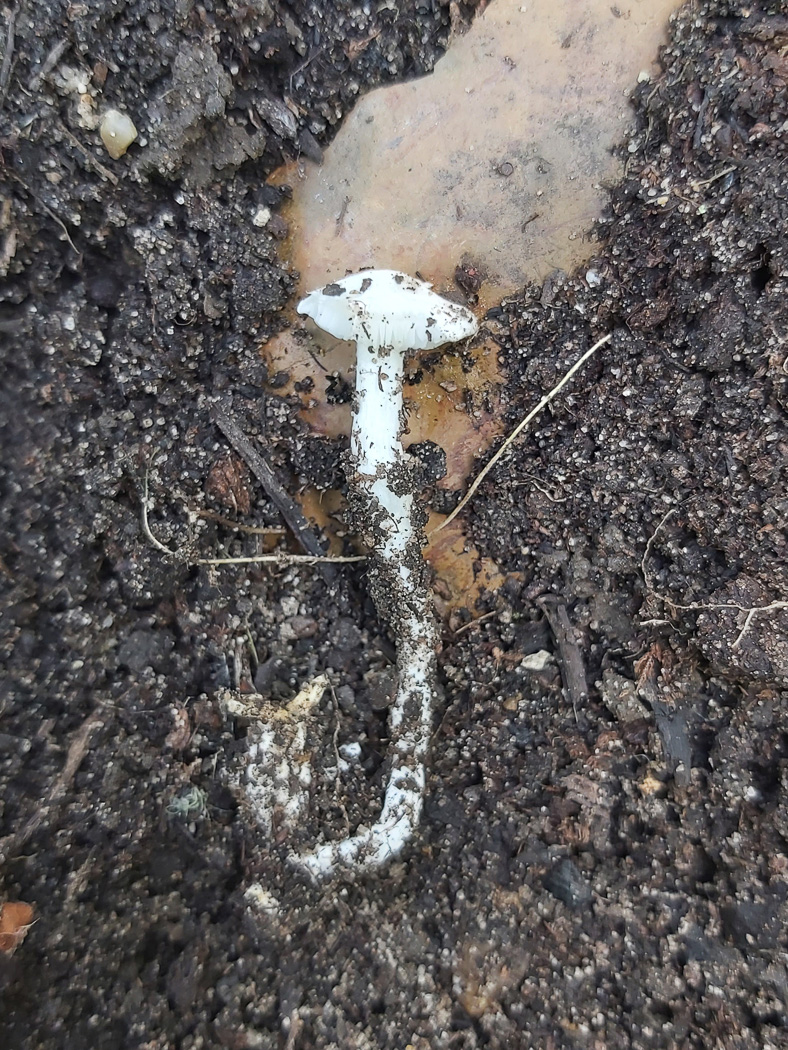 |
Tricholomella constricta (an unusual Agaric with no common name) 
Jul 5, 2021. Whilst working on one of his raised beds at home in Jordans village Jesper Launder noticed this small white mushroom which, on excavation, revealed a distinct root. At one stage in the genus Calocybe, this species is difficult to place and has an odd set of features matching nothing else, hence now residing in its own genus. Though perhaps reminiscent of Tricholoma, it has a smooth and slightly viscid cap surface, is entirely white including gills and spores (which are ornamented with spines), and the stem has a narrow ring when young and is often rooting as here. It favours disturbed soil, also burnt or urinated spots and we have just three other known county sites for it.
|
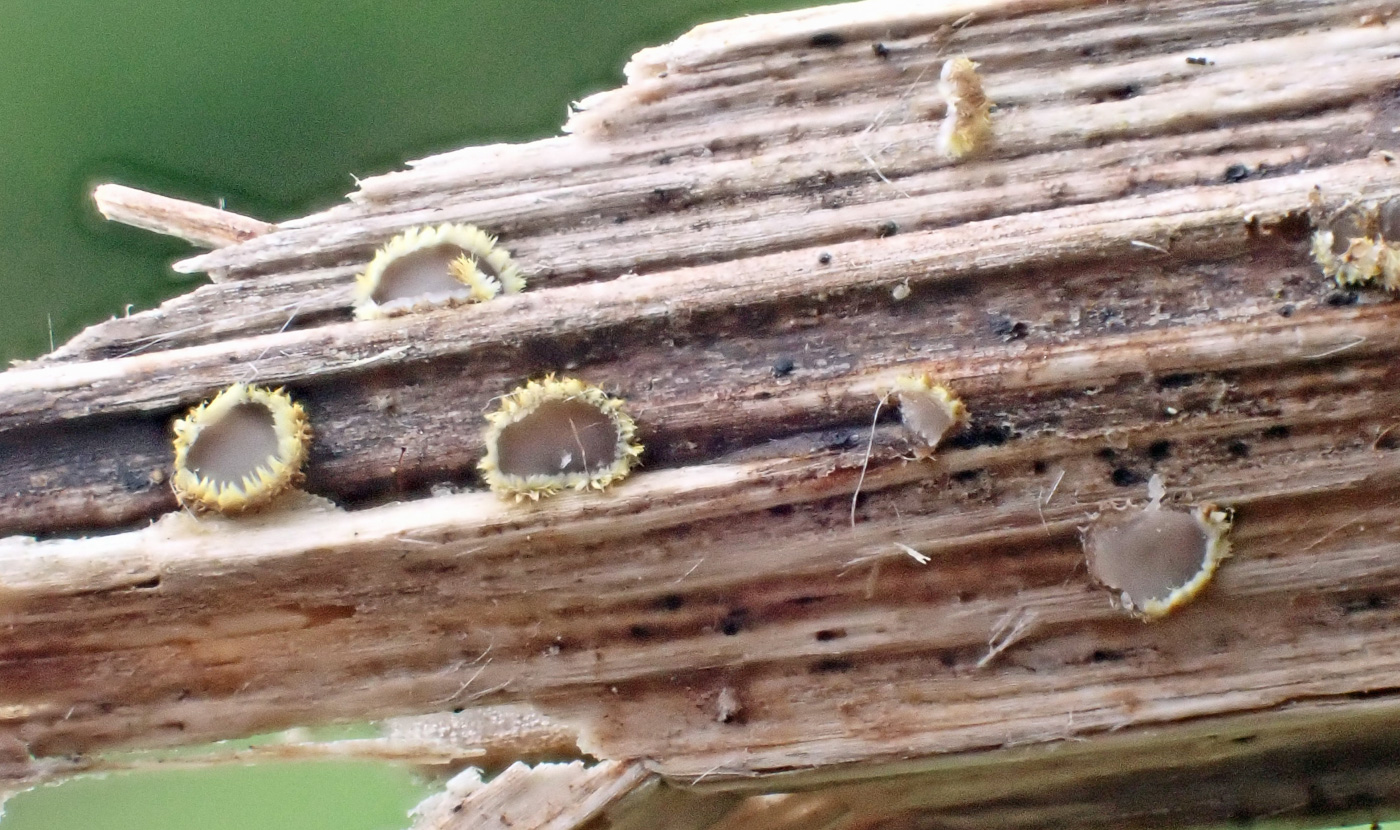
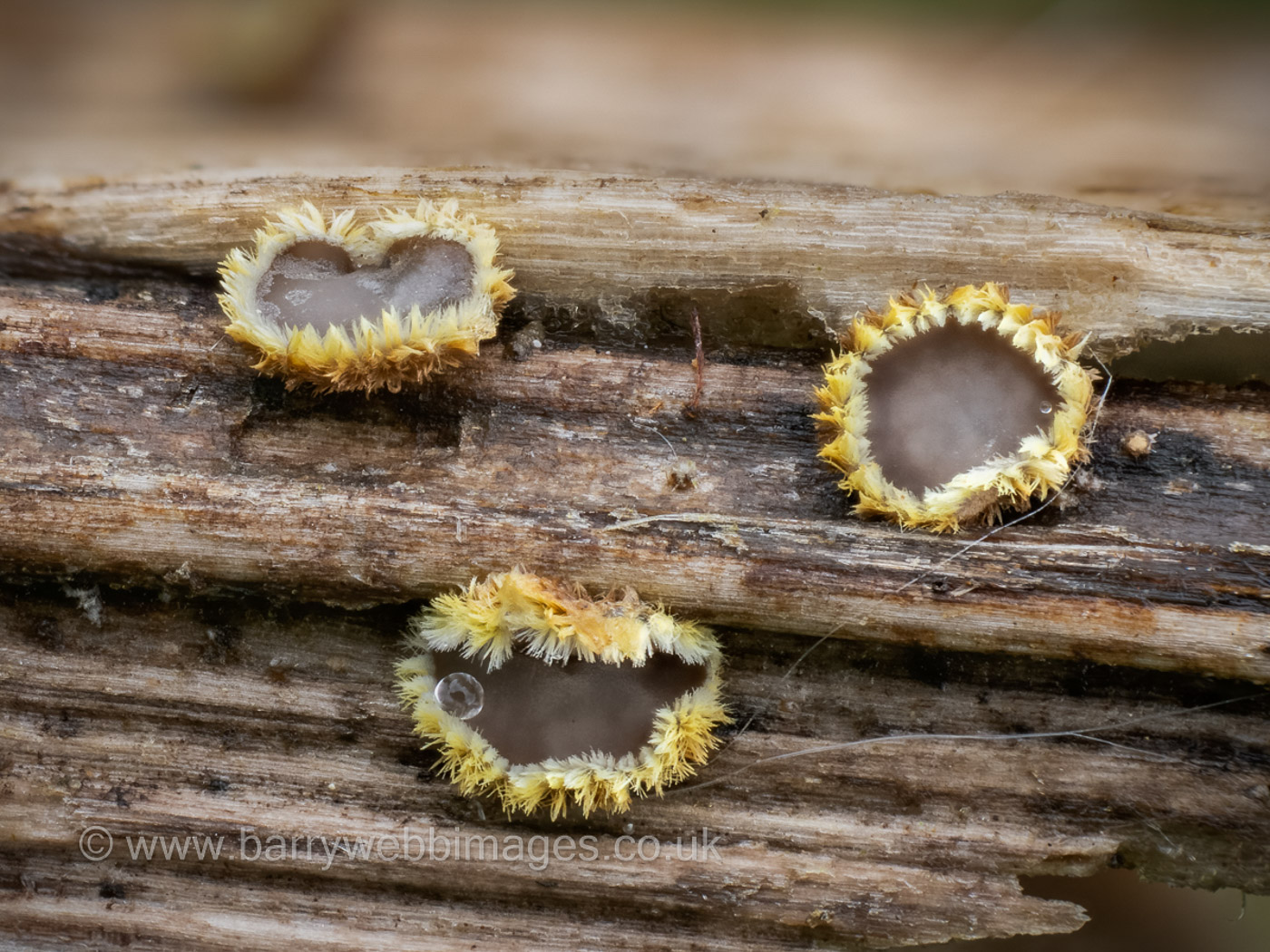 |
Trichopeziza leucophaea (an Ascomycete with no common name)
May 16, 2022. Also found on the base of dead umbellifer stems - probably Burdock - at Dancersend today were these rather distinctive tiny grey-brown discs with yellow hairs around the edge. Though they unfortunately missed being examined by Kerry Robinson later, they seem distinctive enough to name, being closely related to T. mollissima (and indeed growing on the same stem) but clearly differing in their colour. The species appears to be new to the county. (Photo 1 is by Neil Fletcher, photo 2 is by Barry Webb.)
|
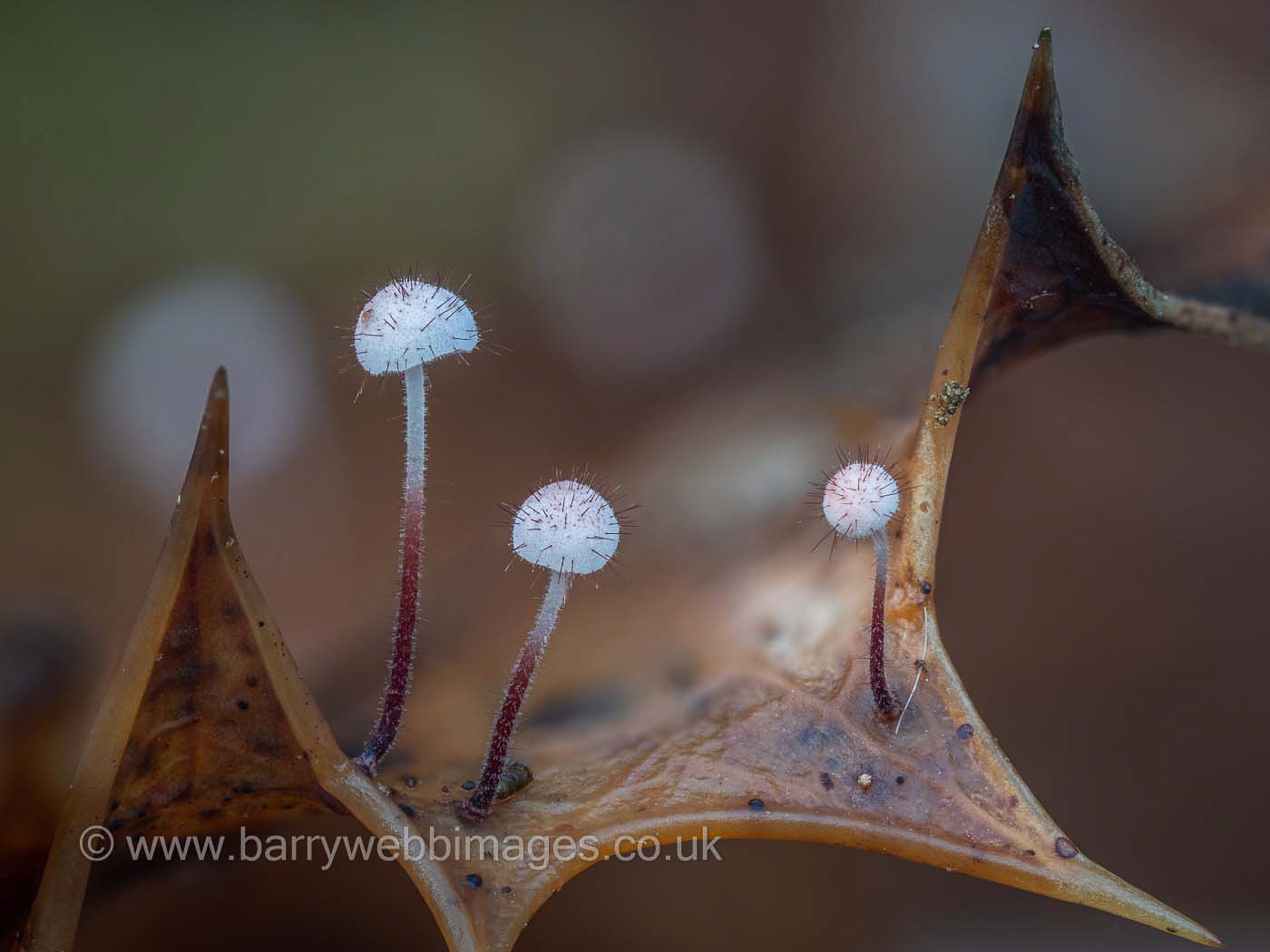
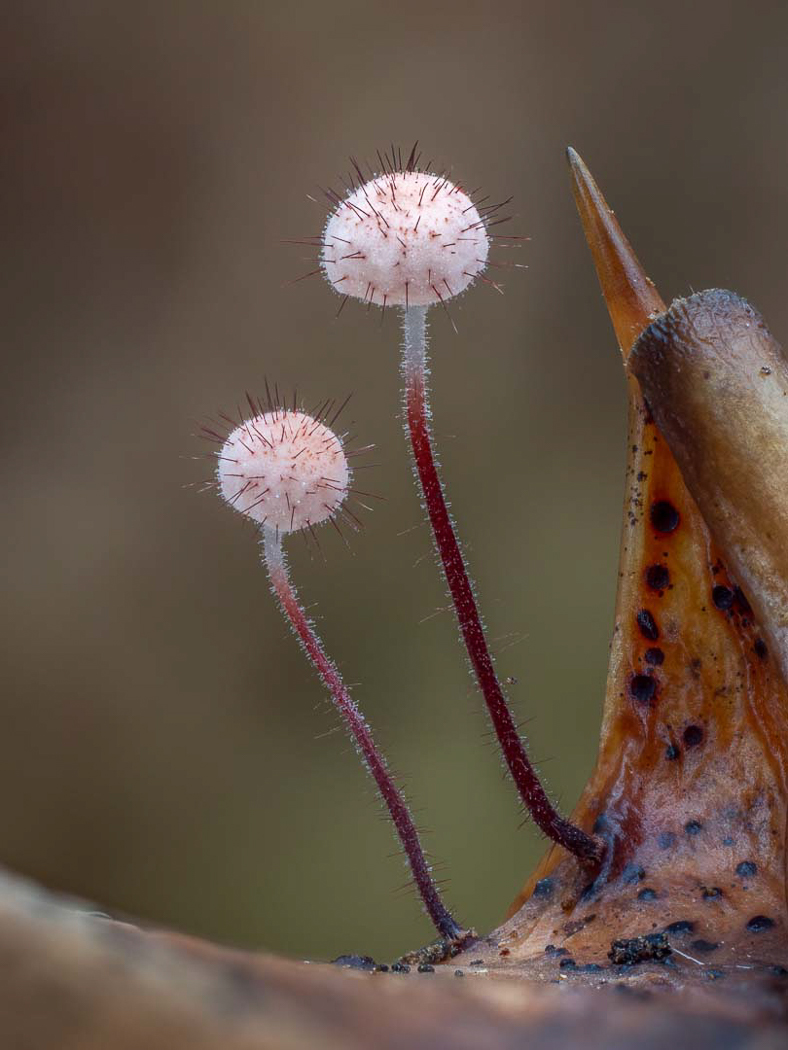 |
Marasmius hudsonii (Holly Parachute) with Trochila ilicina (Holly speckle)
Dec 15, 2020. Whilst cutting the hedge, Barry Webb noticed this stunningly beautiful little mushroom on a dead Holly leaf in his garden - a species Penny C. had unsuccessfully been on the lookout for! With its unique pinkish brown bristles covering the cap surface, no other Parachute can be mistaken for this species in the field, the caps being less than 6 mm across at most. It only grows on this substrate and likes damp to soggy conditions late in the season and is mostly confined to the south west of the UK, becoming rarer the further east you go. We have just one previous record for the county. Incidentally we have two for the price of one here because the little black dots visible in photo 2 are of the very common ascomycete (also host specific to holly leaves) Trochila ilicina, also new to our list.
|
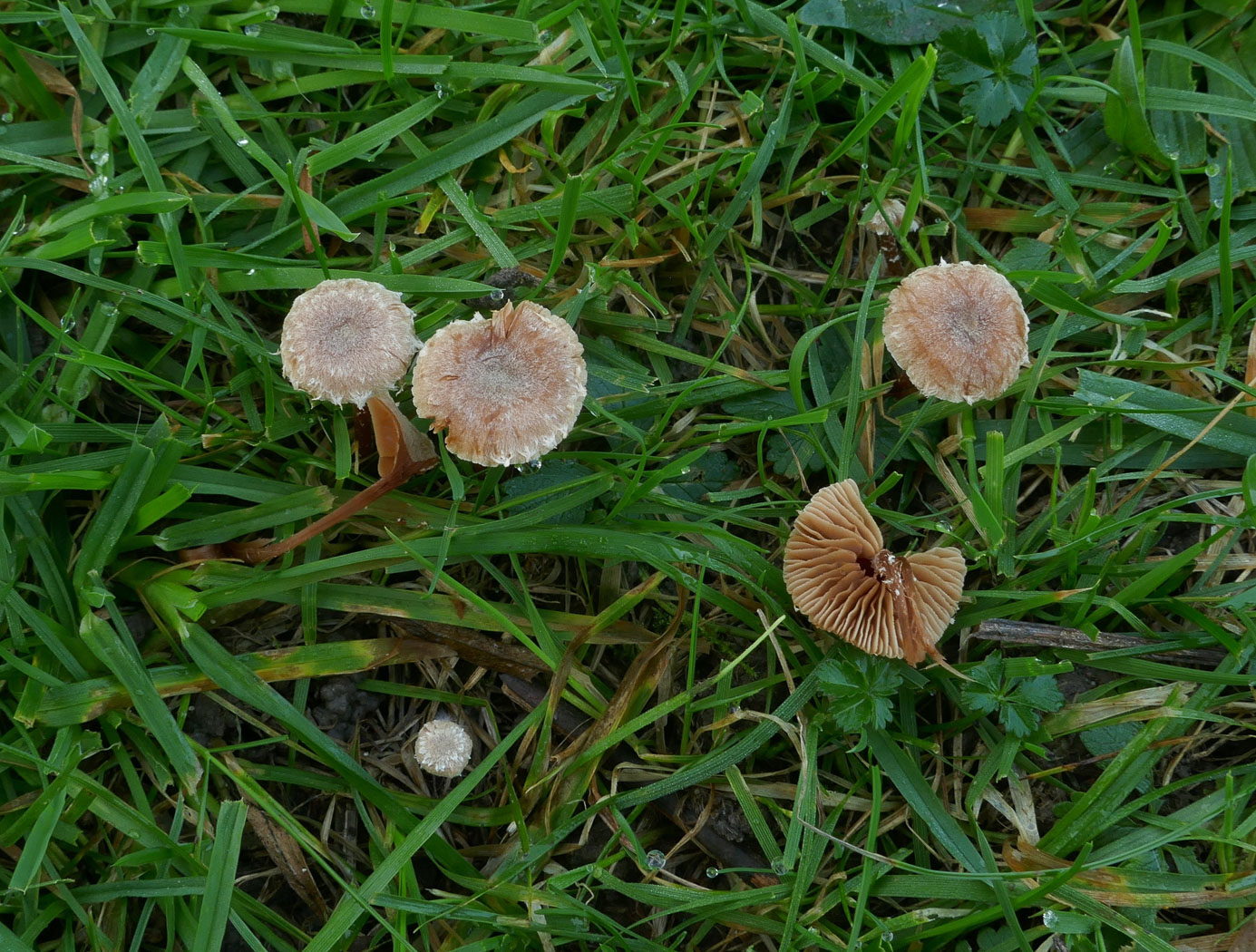
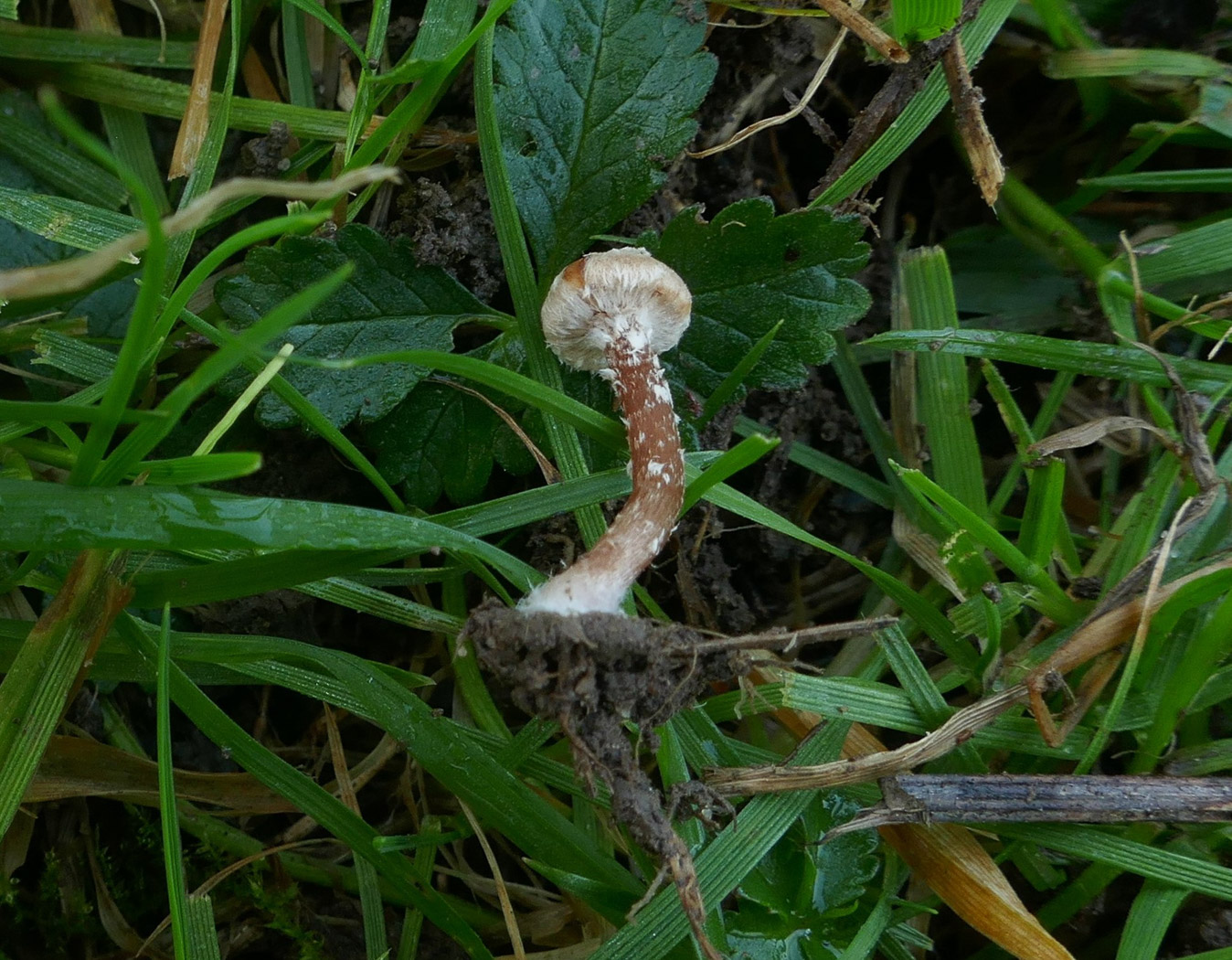

 |
Tubaria conspersa (Felted Twiglet) 
Apr 24, 2023. At Stampwell Farm Jackie Ewan found this singleton LBJ in the same grassy spot where it occurred last year. Very similar to and possibly equally as common as T. furfuracea, also found on the same substrate with woody debris, the cap tends to have more white flecks of veil distributed over a wider area than in that species, these also on the stem as well.
Nov 12, 2022. At Stampwell Farm Jackie Ewan found this little group of Twiglets and suspected they were different from the very common T. furfuracea (Scurfy Twiglet) which we record very regularly. In that species the white scurfy bits are confined to the cap edge and it lacks the scaly stem of T. conspersa seen in photo 2. There are also microscopic differences. This is also common but may quite possibly be mistaken for T. furfuracea when we don't take enough care to observe it properly. it is new to Finds.
|













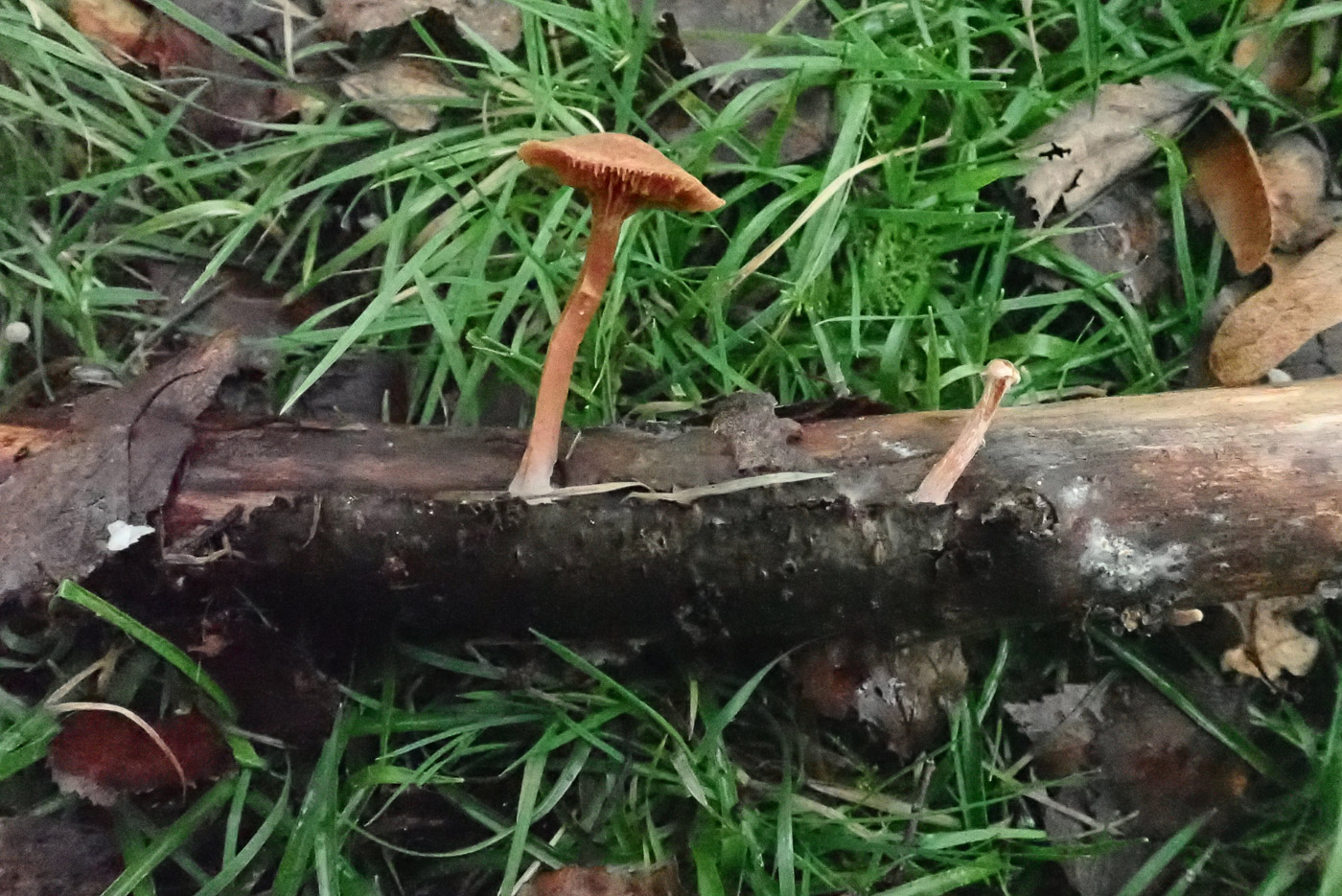
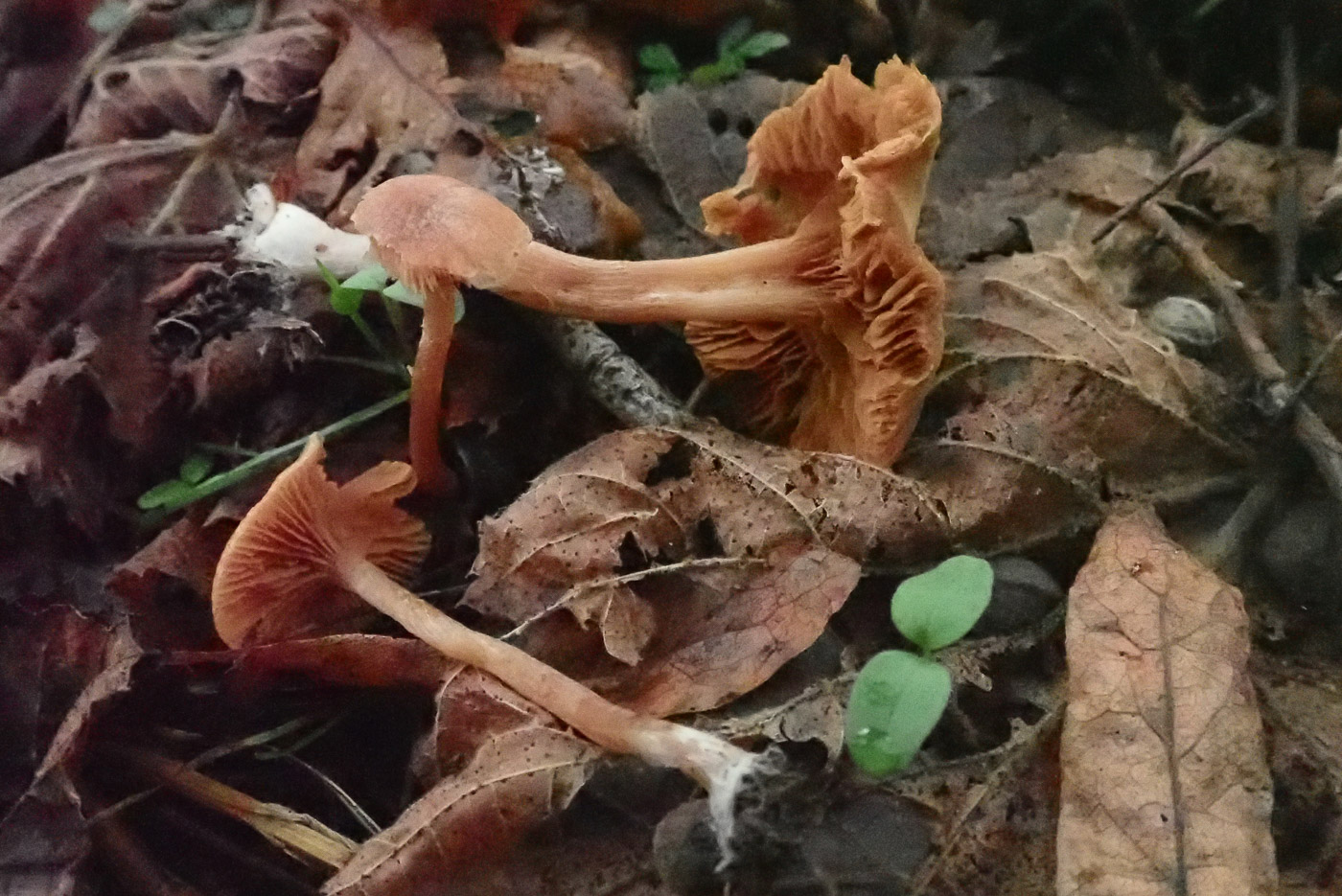
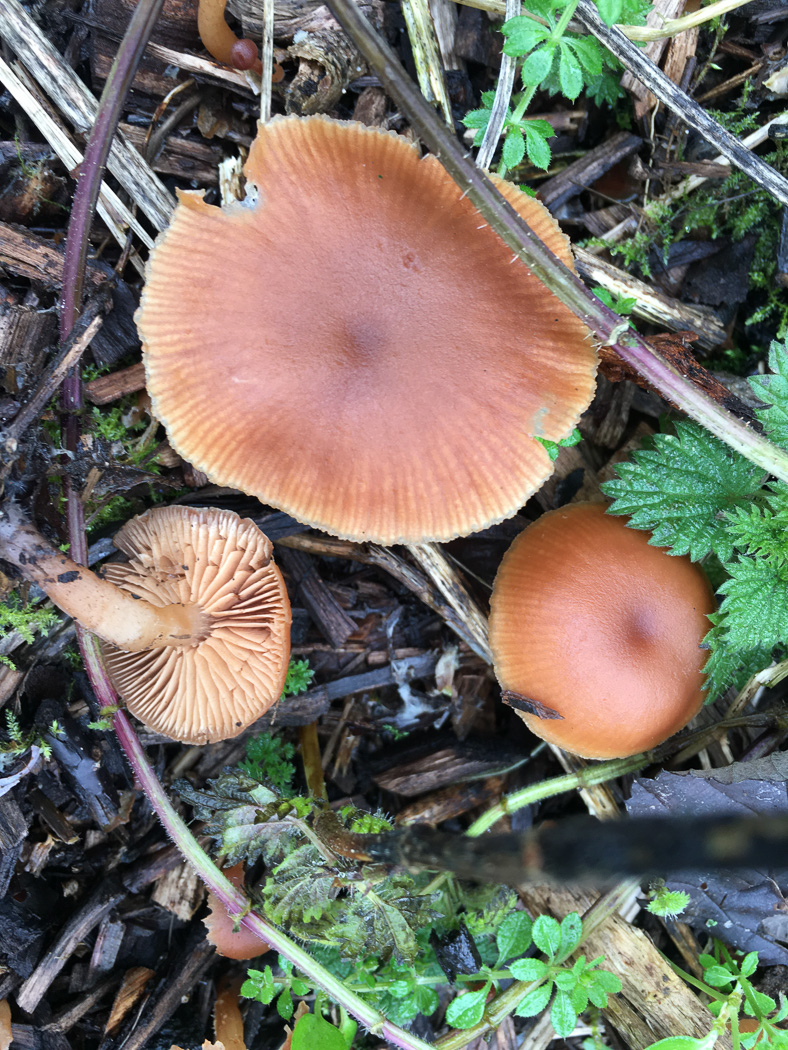
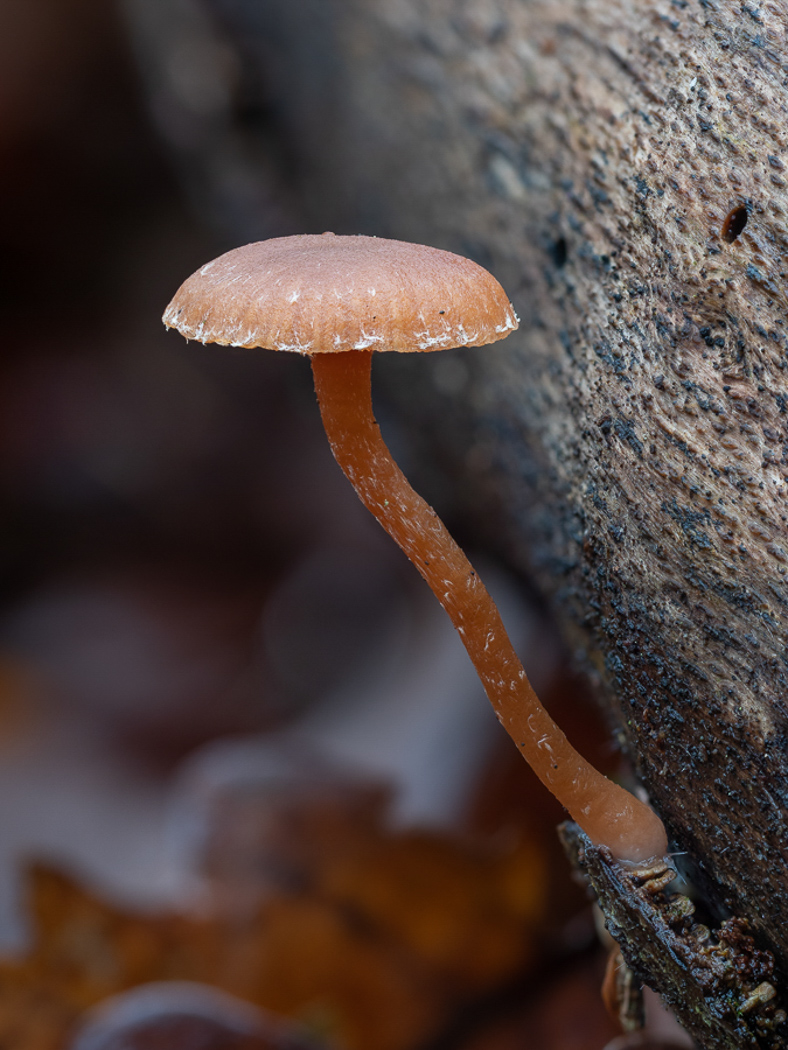
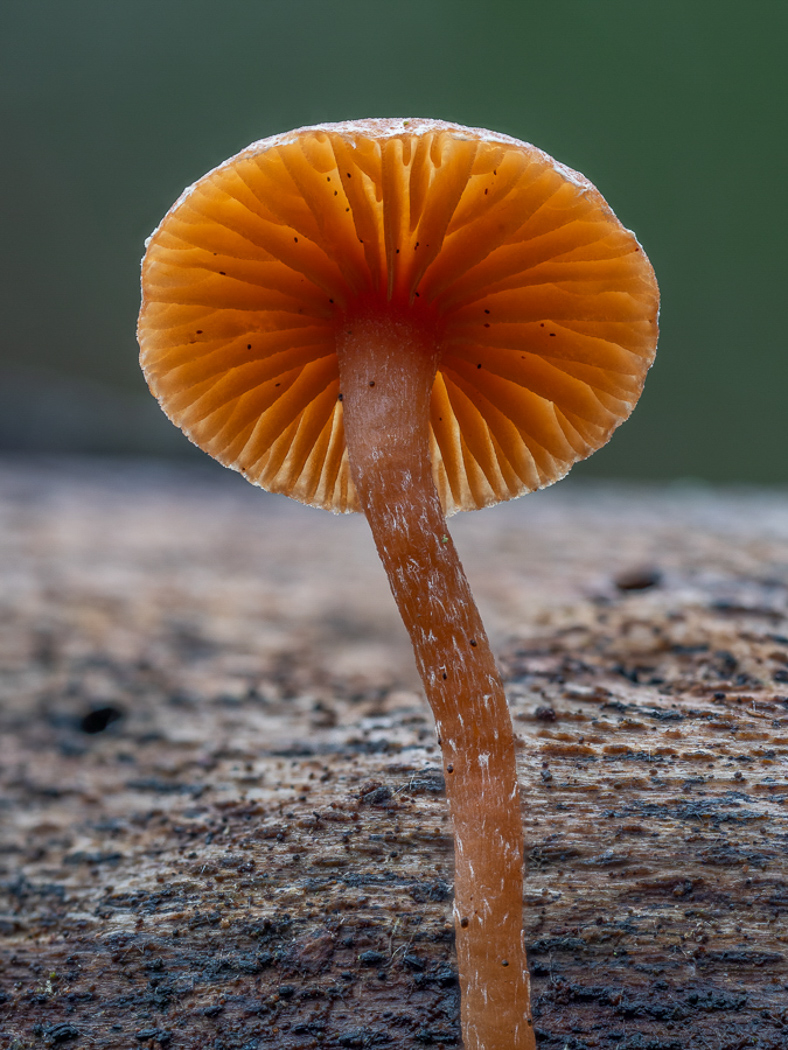
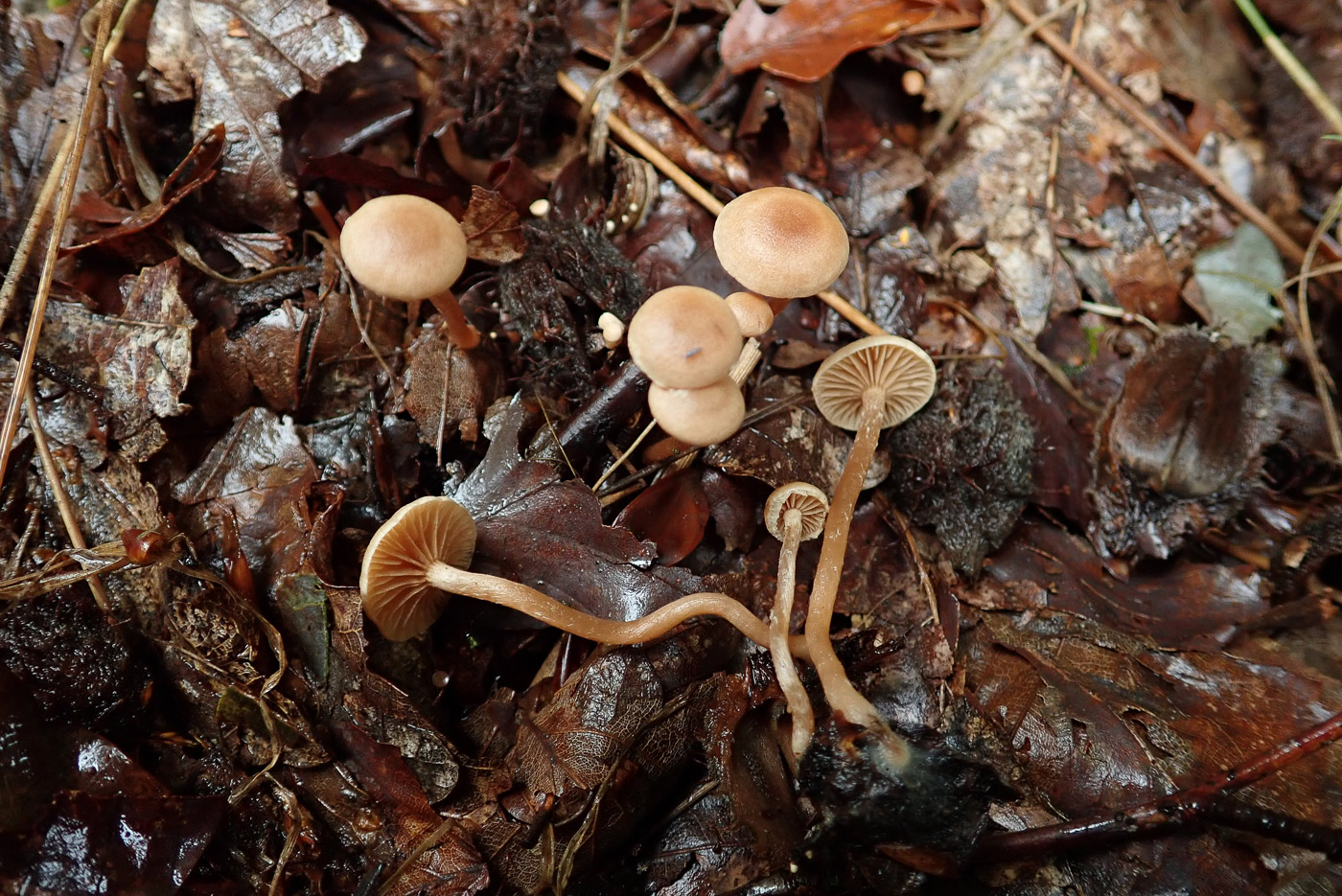
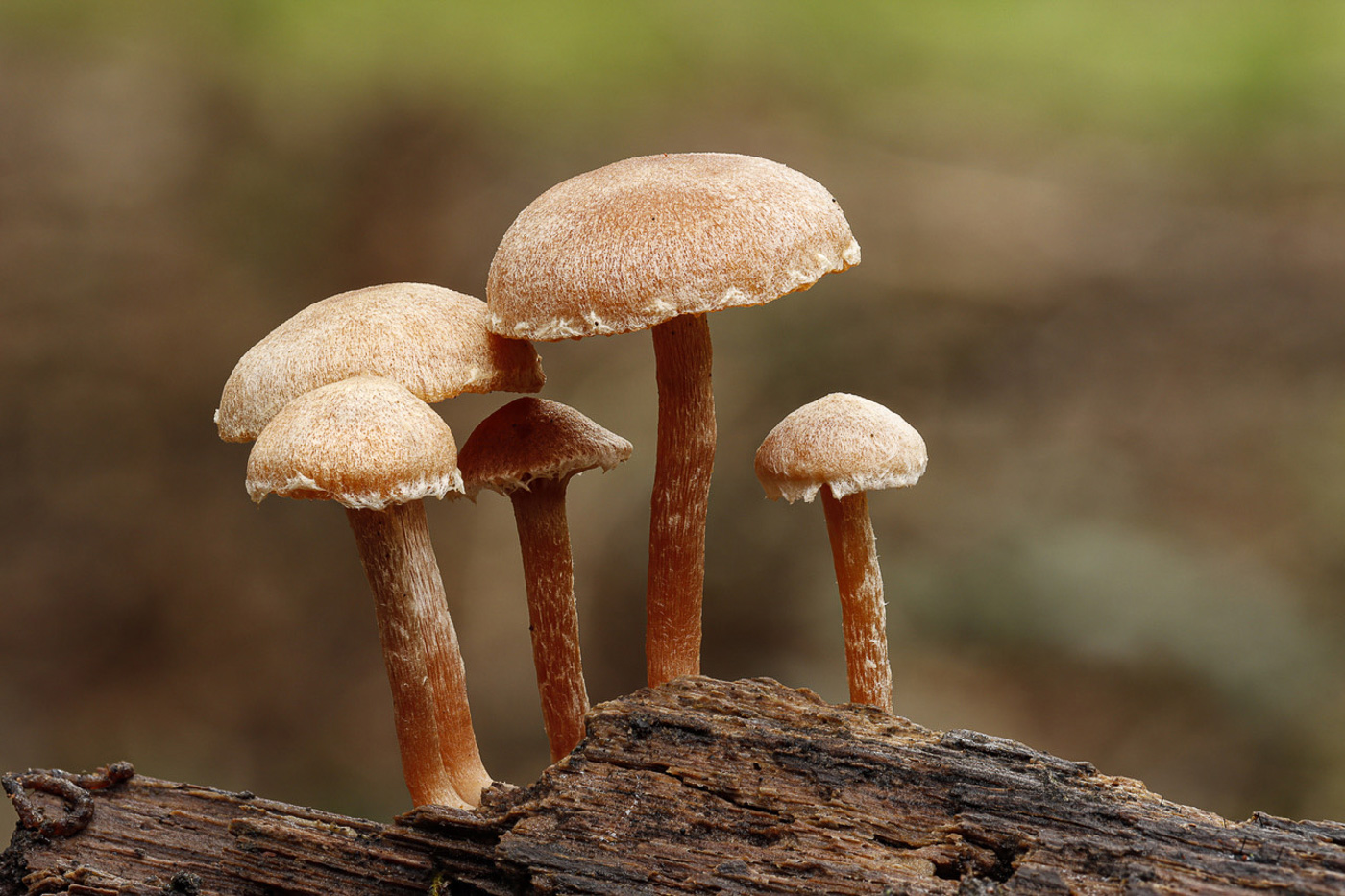
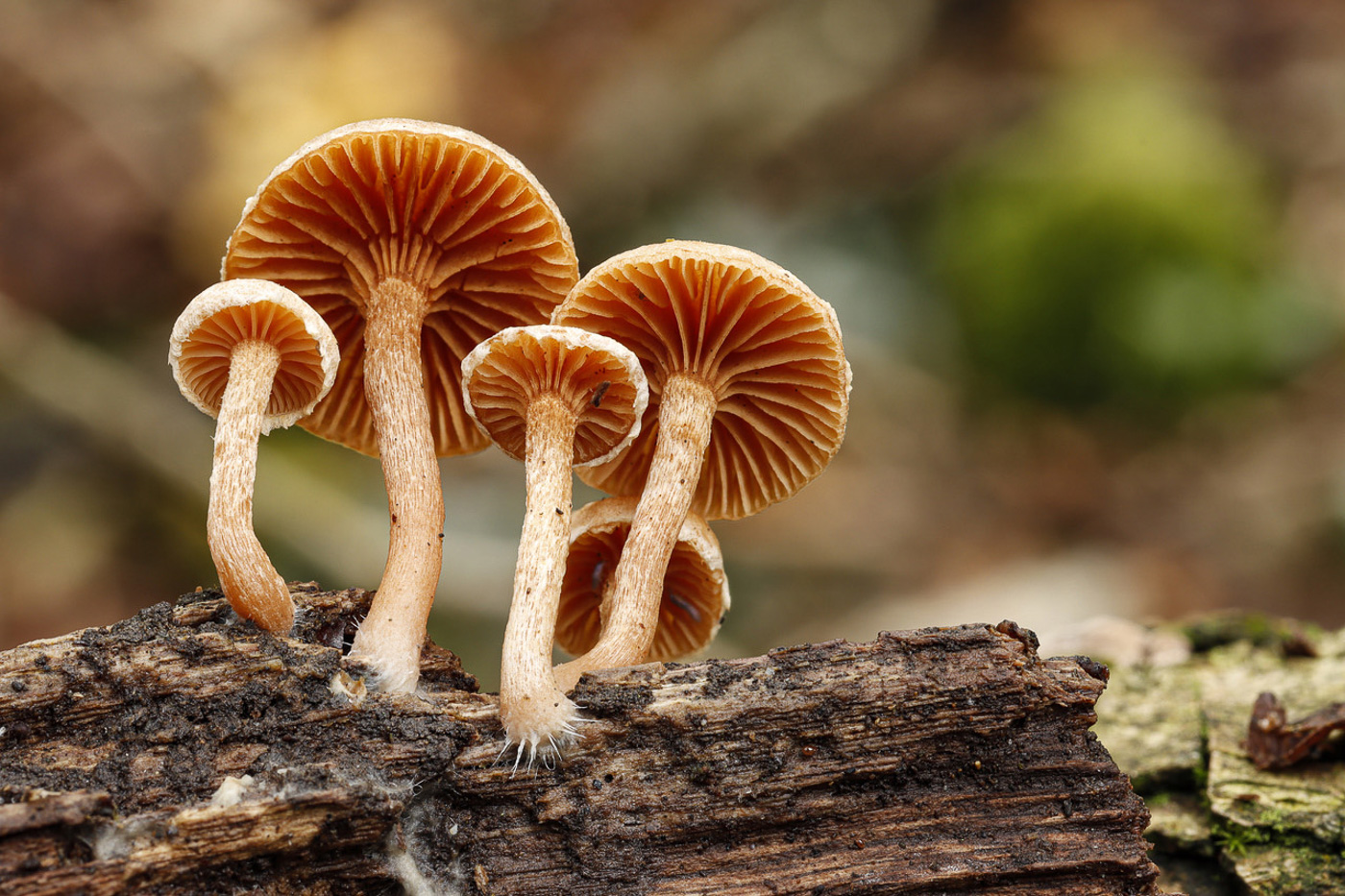
|
Tubaria furfuracea (Scurfy Twiglet) 
Jan 3, 2024. In Salden Wood Bob Simpson found this very common mushroom in grassy soil at the woodland edge but was unsure of its identity. This is a typical LBJ which often causes doubt in the field, being initially somewhat similar to both Conocybe and Galerina in size and colour. It favours woody debris and can often be found in sheets covering a large area, but when single or in small groups it is less easy to recognise. It tends to have a duller more reddish and less yellow tinge that the two genera mentioned. The gills are possibly paler than in those genera and can quite often be slightly decurrent too.
Aug 12, 2023. At Turville Heath on some Beech sawdust Penny spotted loads of this LBJs and at first thought it must be a species of Galerina having a frilly veil around the edge. Turning one over and noticing the semi-decurrent gills she realised it was not that genus but the much more common T. furfuracea though it was unusual for the scurfy bits of veil to be so obviously apparent around the edge. Many clusters however lacked this where rain had probably removed it. The species is often one which can confuse but finding quantities of it like this surely pointed to it being something pretty common, and so it proved.
May 17, 2023. In some damp Beech sawdust at Turville Heath Penny found good numbers of this common LBJ coming up in troops. The area was open and sunny so many were somewhat dry, smooth and faded (hence the check later with a scope) and in photo 2 the pale rusty brown spore colour can be seen on the three caps uncovered when Penny picked a specimen which was covering them. Photo 3 shows the similarly coloured gills and also signs of ring zone right at the apex which often seems to be present in the species.
Mar 25, 2023. At Stoke Common Penny found several examples of this very common species on fallen wood or in woody debris.The identity of this typical LBJ tends to cause confusion and doubt being in appearance very like several other genera such as Galerina and Conocybe. It is much the commonest species, however, fruiting at all times in woody litter and sometimes in abundance, that it's worth making oneself really familiar with it in order to be able to eliminate it when something different turns up.
Mar 18, 2023. In Salden Wood Bob Simpson noticed these LBJs in some woody litter and was unsure as to their identity. Penny has named them purely from these photos so there's no guarantee on the ID but it is a common species which often confuses, looking similar to both Conocybe and Galerina but with much less distinctive micro-characters. It can be found at most times of the year, can sometimes have slightly decurrent gills and sometimes signs of a ring zone as can be seen here.
Jan 1, 2022. Under various deciduous trees in woody litter at Turville Heath Penny found several specimens of this common little LBJ which often confuses people.
Jan 27, 2021. We already have a couple of photos of this common species (dated Jan 10th) but Joanna Dodsworth's collection from Brill Common amongst deciduous debris gives another example of an LBJ that often confuses people, especially after rain (we've had plenty of that recently!) when the tell-tale 'scurfy' bits usually visible on the edge of the cap have been washed off leaving it smooth and easily mistaken for something different. This species could well be described as the default LBJ, so if in doubt about a little nondescript brown mushroom among woody litter (sometimes on wood itself) this might well be what you have!
Jan 10, 2021. Barry Webb found these small mushrooms fruiting on deciduous wood in Burnham Beeches. This species is a very common LBJ and often mistaken for a species of Galerina or Conocybe - both genera very similar in size and colour of caps and gills. Look for the remnants of white veil near the cap margin (seen in photo 1), the often slightly decurrent gills (though not in this case!), the white veil flecks on the stem as well, the even colour over the whole fruit body and its often clustered habit - sometimes in very large numbers - in woody litter. (For another example see Finds 2020 dated Oct 3rd.)
Oct 3, 2020. This group was growing in woody litter in Penn Wood, found by Penny Cullington. This is one of our commonest LBJs (Little Brown Jobs) and frequents woody remains, woodchips, sometimes apparently on soil, even in lawns on submerged woody bits. Sometimes found in large colonies, caps, gills and stem are all the same soft pinkish to cinnamon brown, caps fading when dry and often with white flecks (the scurf referred to in the common name), gills can be more decurrent (sloping) than shown here, and texture is soft, quite fragile. The scurf on today's specimens had long since been washed off by rain. . However, Paul Goby's two photos taken two weeks later in Naphill Common are good examples and show the scurfy caps and stems as well as the slightly decurrent gills.
|
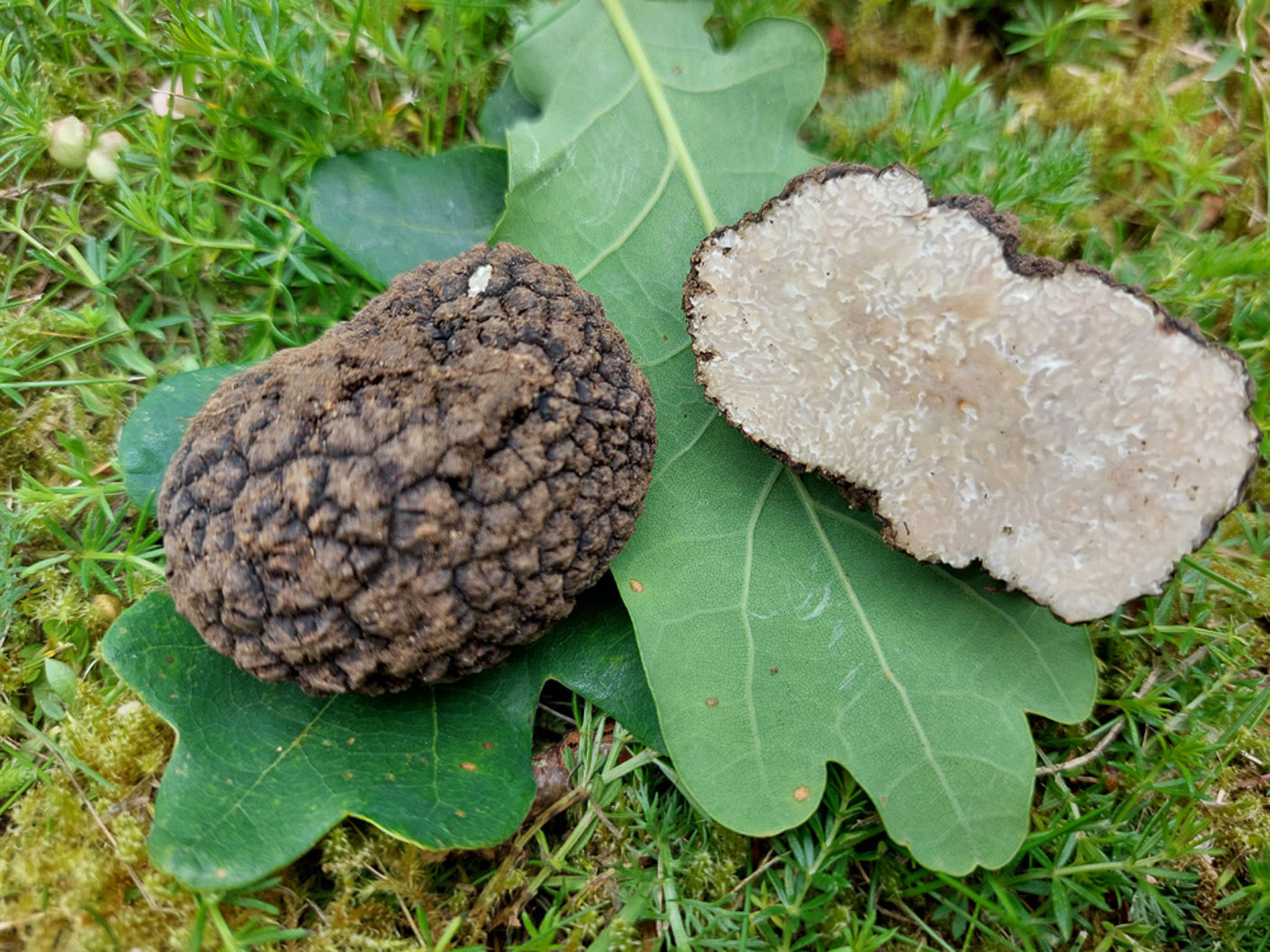




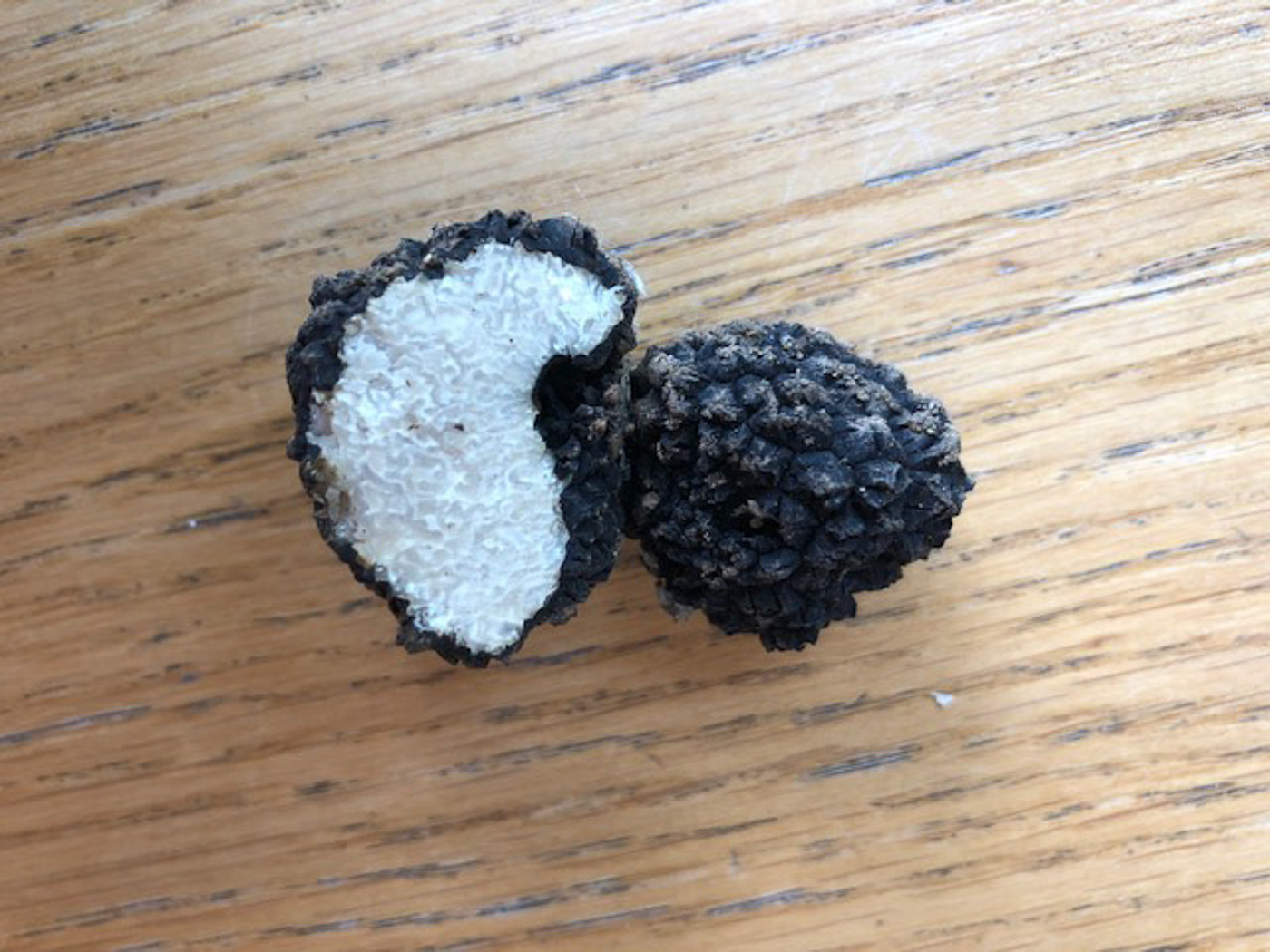
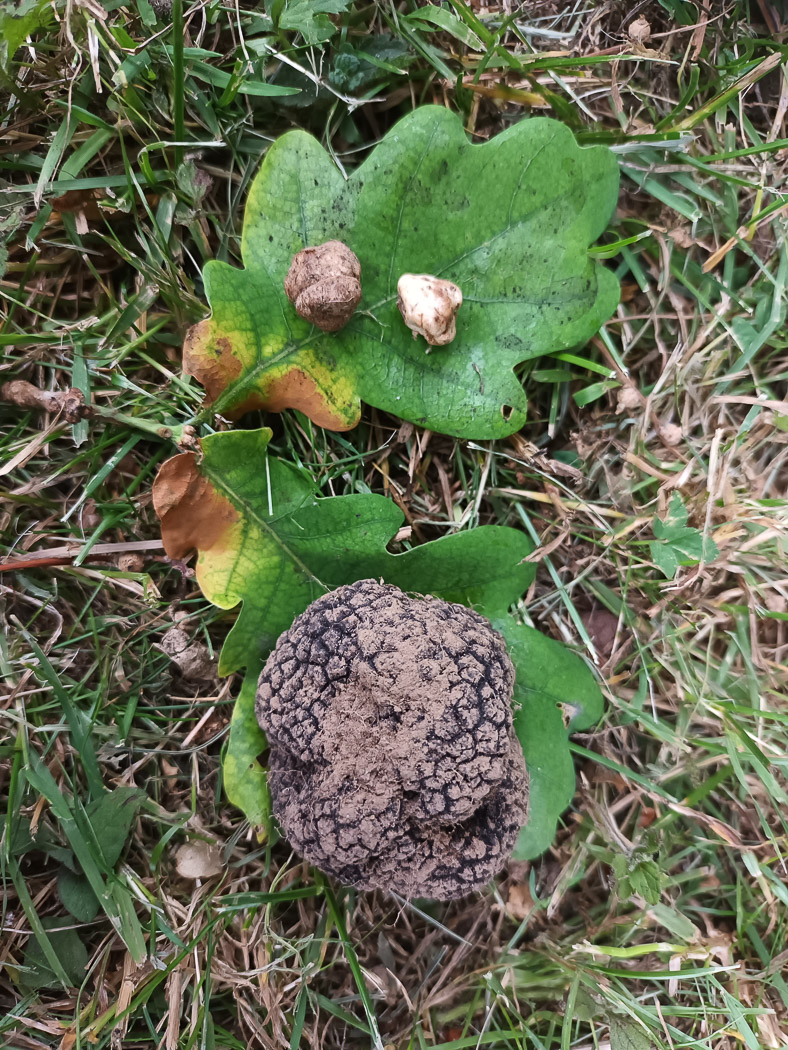
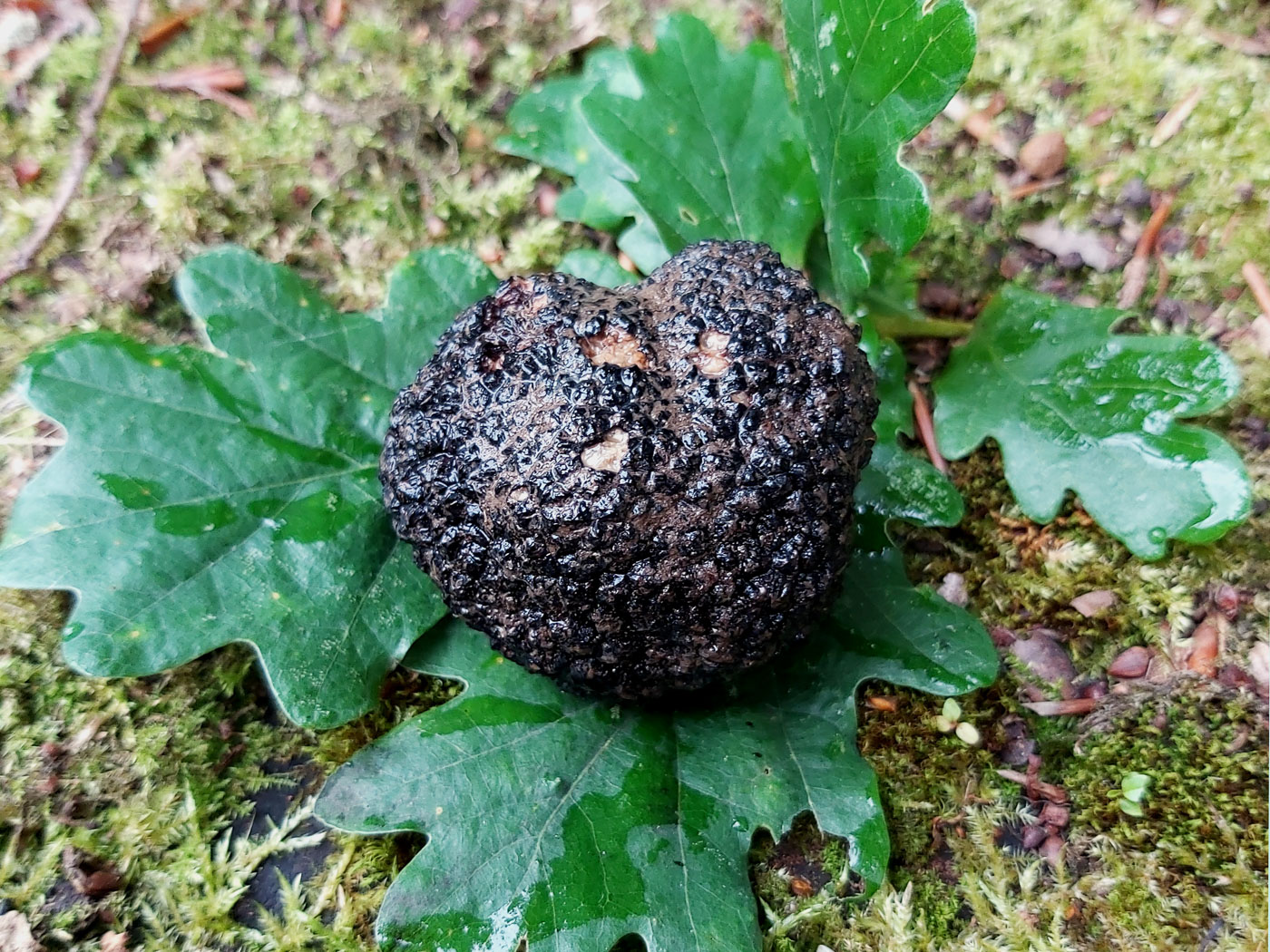
 |
Tuber aestivum (Summer Truffle)
Jun 1, 2024. Under Oak in a private garden in Gerrards Cross Jesper Launder was investigating various 'dig holes' made by foraging animals and was rewarded with this beautiful specimen. This is an Ascomycete truffle and probably quite common locally, though still with only a few county records owing to the lack of 'know how' amongst us mycologists - something we really should work to rectify!
Apr 22, 2024. Under Lime in Hughenden Woods Sarah Ebdon discovered this somewhat early fruiting of a distinctive and quite common truffle species (genus Tuber is a member of the hypogeous ascomycetes - ie related to cup fungi but growing underground). It is certainly the truffle we have the most county records for but these still can be counted on two hands! Its black knobbly surface and marbled interior are easy to recognise and it can get to 8-9 cm across though today's was pretty tiny judging from the leaf in Sarah's photo! What a good find!
May 26, 2023. Under an Oak in Jordans where he has found this species before, Jesper Launder went looking as he's been finding several different Truffle species recently. Sure enough it was there though on the early side for it to be fruiting. The species is probably quite common, occurring in clayey calcareous soils under various deciduous trees, though goes unnoticed owing to its subterraneous habit. Its black strongly warty surface with pale marbled interior make it distinctive an easy to recognise, and when mature has a strong 'truffly' smell. Photo 2 is of another collection made by Jesper from Gerrards Cross on June 24th. We have three previous entries in Finds, the first two from the same Jordans spot as today's find.
Jul 7, 2022. Following a report of this species from Jordans on June 24th (see Finds for that date), Sally Knight found two specimens in her garden in Long Crendon under shrubs and a nearby Birch. She and Tony were unsure which Truffle it was so checked the microscopy, finding the strange ovoid asci of the species having just a few spiny spores within. A nice find.
Jun 24, 2022. Under Oak in Jordans village Jesper Launder found this species by searching in the numerous holes underneath it. Three specimens were found though only one was in good nick (the larger fruitbody seen here). The species is probably much more common in the area than we realise - we just don't know where or how to find it! (See above for the identity of the smaller truffles seen here.)
Aug 17, 2021. In Jordans village in soil under Oak Jesper Launder uncovered this nice specimen of a revered species for those who enjoy eating fungi! Apparently fruiting in this spot a month later than in previous years, the species is hardly ever reported in the county (we have just one previous record) but is probably not at all rare, having a preference for calcareous soil under both Beech and Oak - a habitat in plentiful supply! Tubers belong with the Ascomycetes and this species can get to 7 cms across but remains submerged in soil / litter therefore hidden unless one deliberately looks for it or detects its delicious nutty sweet smell!
|
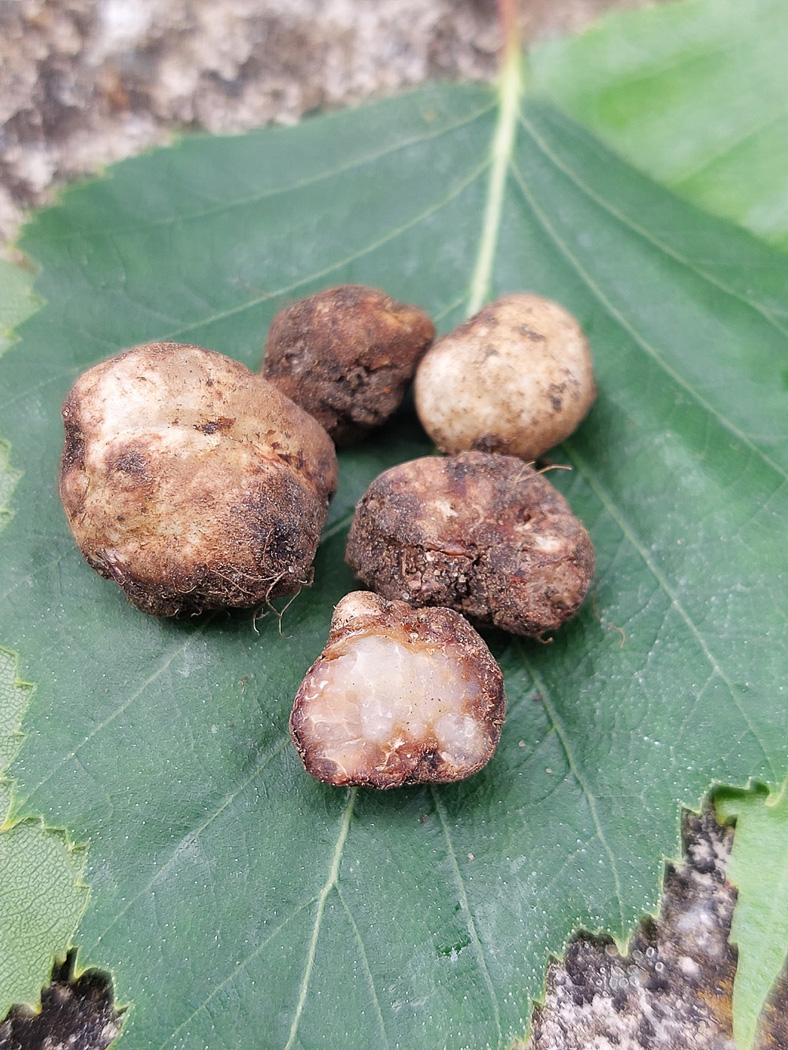 |
Tuber maculatum (a rare ascomycete tuber with no English name) 
Jun 8, 2024. Jesper Launder was after pastures new to continue his truffle hunt and struck lucky in Little Chalfont - an area apparently virtually completely unrecorded for fungi. Under a non-native Birch he examined about 20 dig holes and in two of them was delighted to find this collection - a rare species, new to him and to the county with under 30 records in FRDBI. Though superficially similar to other such truffles, it is mainly down to microscopic details, particularly the spore size and ornamentation, which allows a secure ID to be made.
|
 |
Tuber rapaeodorum (A rare species of Tuber with no common name) 
Jun 24, 2023. In Gerrards Cross Jesper Launder had a field day finding four different species of truffle including this one under Oak which is new to the county with only 15 national records on FRDBI. He informed Penny: 'Confirmed by its large, narrowly ellipsoid, and uniformly reticulated spores. One I've only encountered once previously, in Cheshire.' This was an exciting find.
|

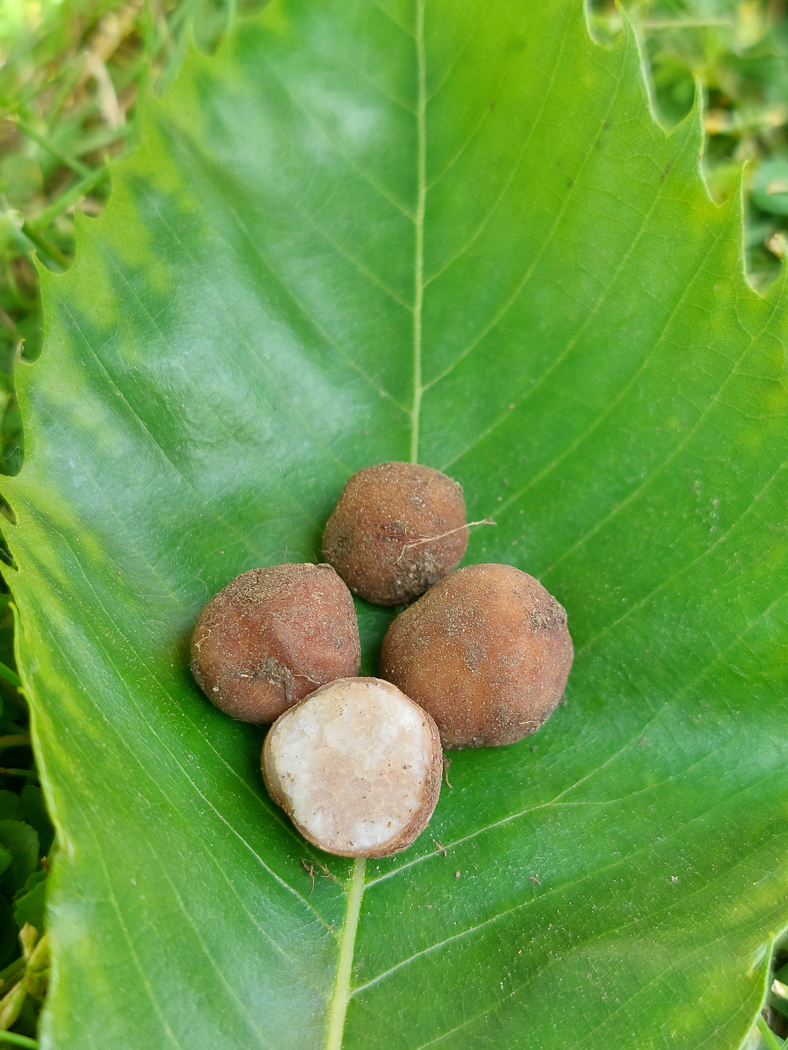
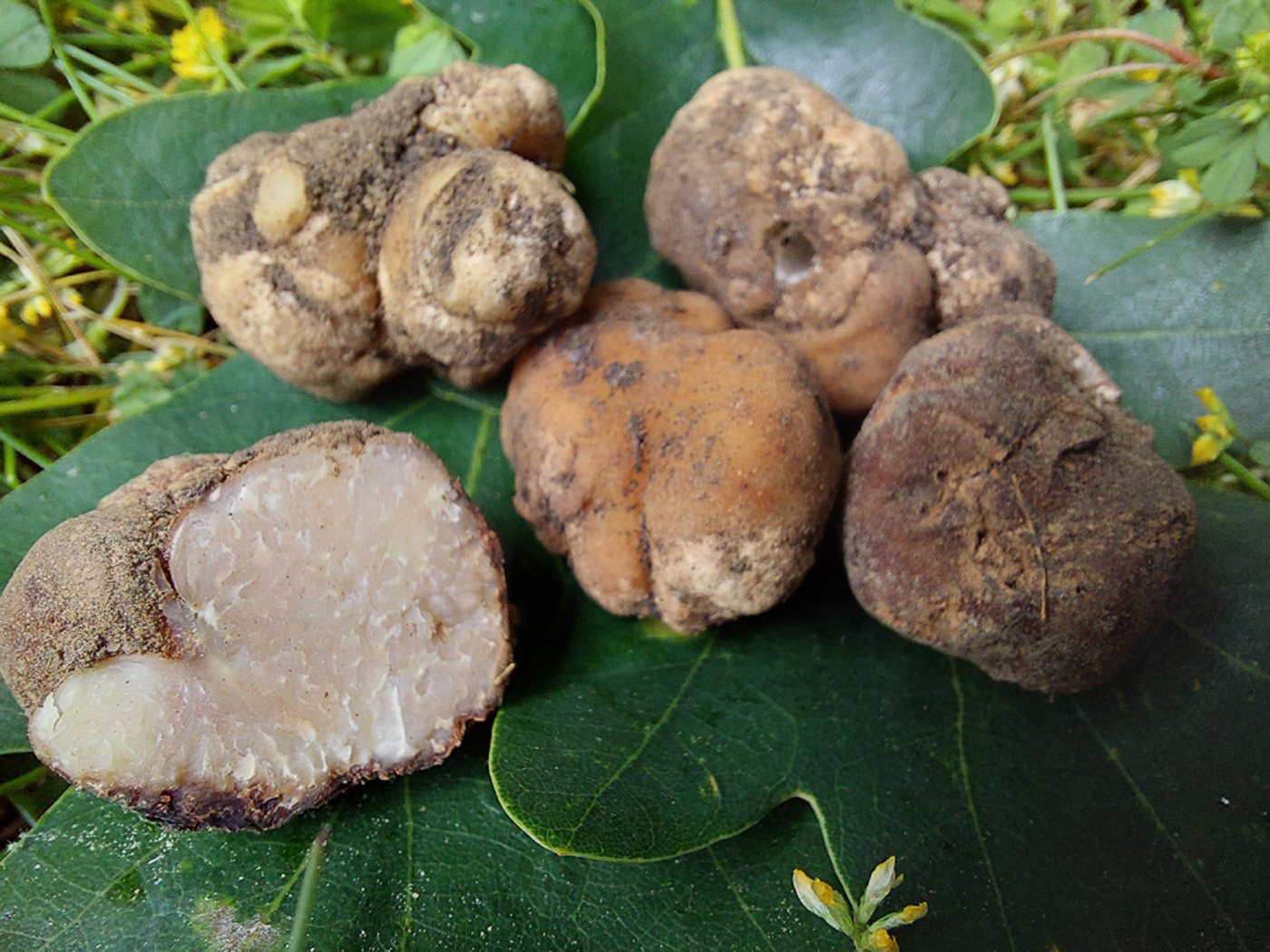

 |
Tuber rufum (an Ascomycete Truffle with no common name) 
Apr 22, 2024. This was the third tuber species Jesper uncovered under the Lime in his garden in Jordans Village in the space of two days! This is one of the ascomycete hypogeous species (those related to cup fungi which grow just under the surface of the soil). Though he checked for spores to confirm his ID the specimen was still too immature to produce any, but he knows the species well and the uniform round shape together with pale colour already developing rufous tones were enough for him to make his ID. It rarely gets bigger than 2 cm across or so and the size here can be assessed by the leaf he's placed it on. We have just two previous county records though the likelihood is that this is a common species. Photo 2 is of a further sizeable collection Jesper made from under Chestnut in Gerrards Cross, June 6th, where he commented that there were many 'dig holes', half of which had specimens remaining in them - the more mature ones having their distinctive smoky aroma. Photo 3 is of a collection of remarkably large specimens he found in Little Chalfont under Oak on June 8th - the largest he's ever seen!
May 23, 2023. In Jordans under a mature Beech hedge Jesper Launder dug about and came up with this rare Truffle - the only previous county record coming from Derek's Whitchurch garden (2011), found by Truffle specialist Carol Hobart when dog-sitting the Schafer's property! It is mycorrhizal with various deciduous trees, apparently favouring calcareous soils, therefore may be not that rare locally but goes undetected because of its habit of remaining just under the soil surface throughout life. Needless to say, this is a new entry for Finds. Photo 2 is of another collection made by Jesper from Gerrards Cross on June 24th
|
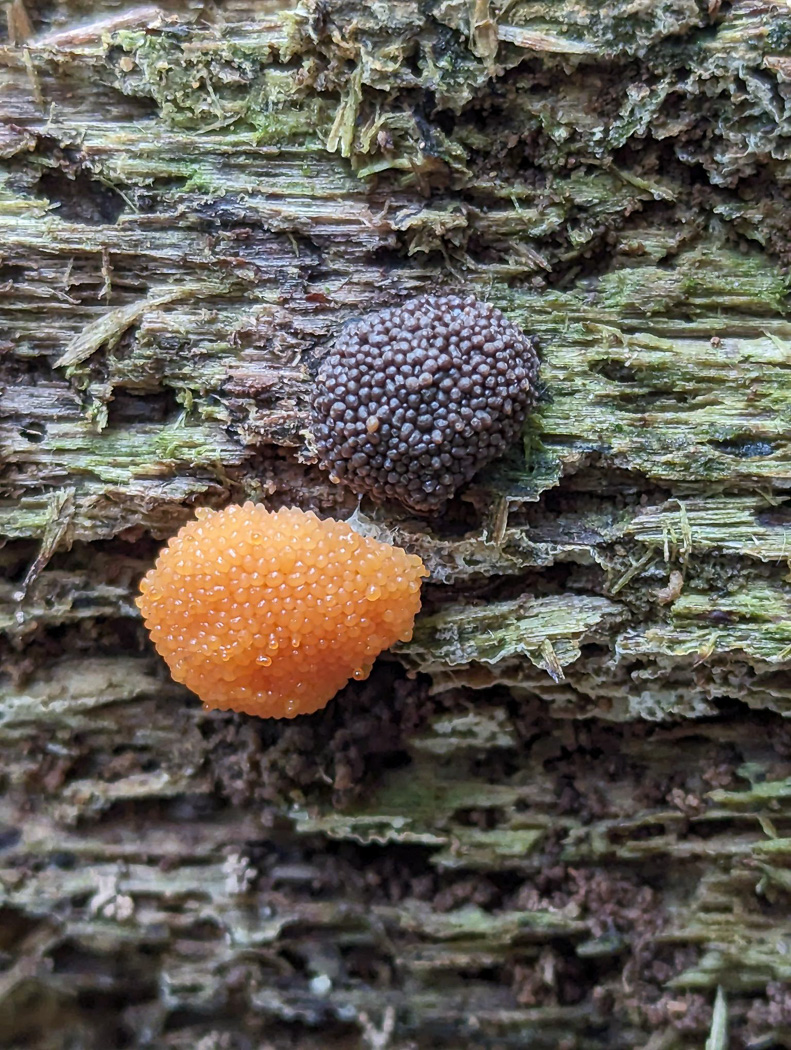

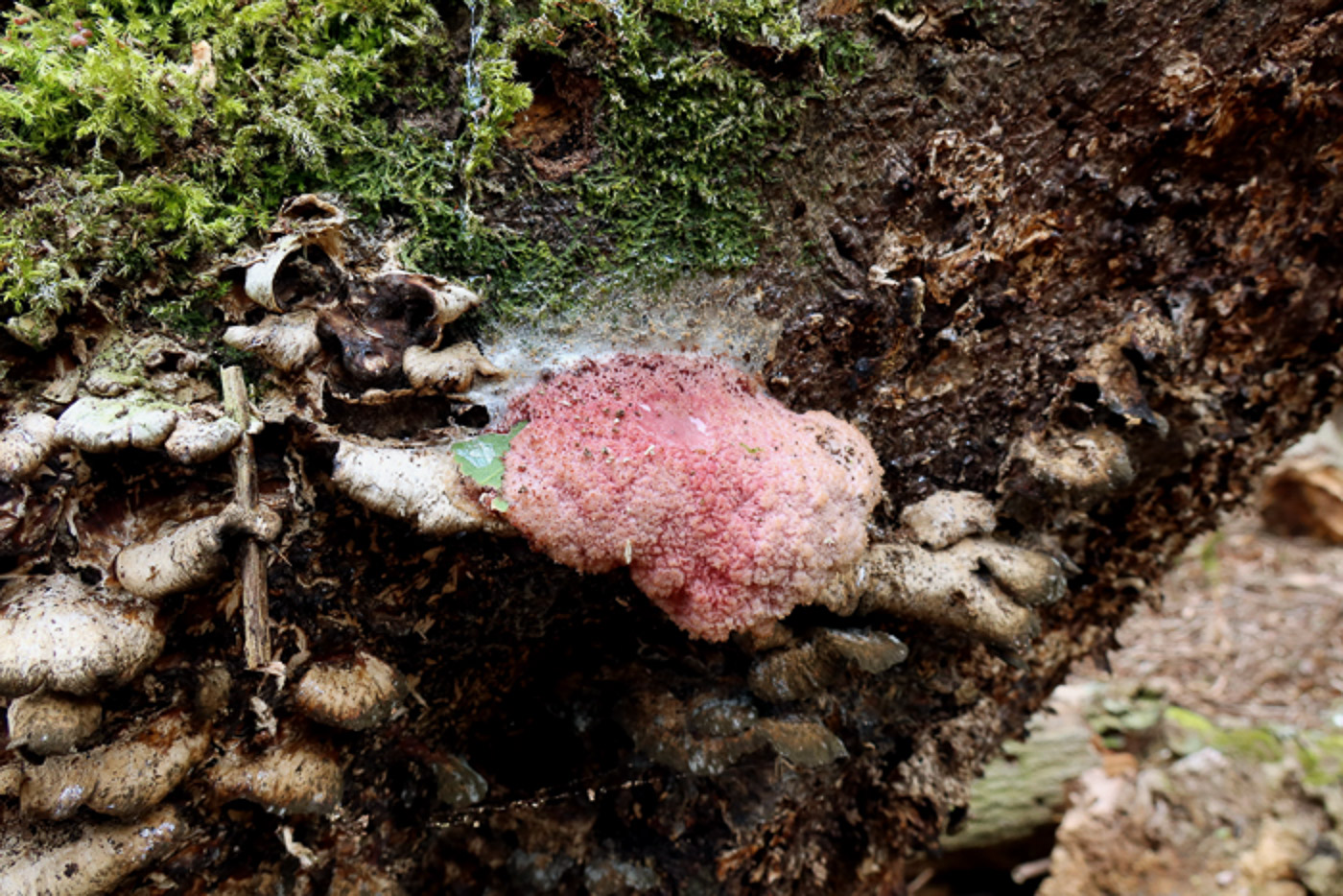
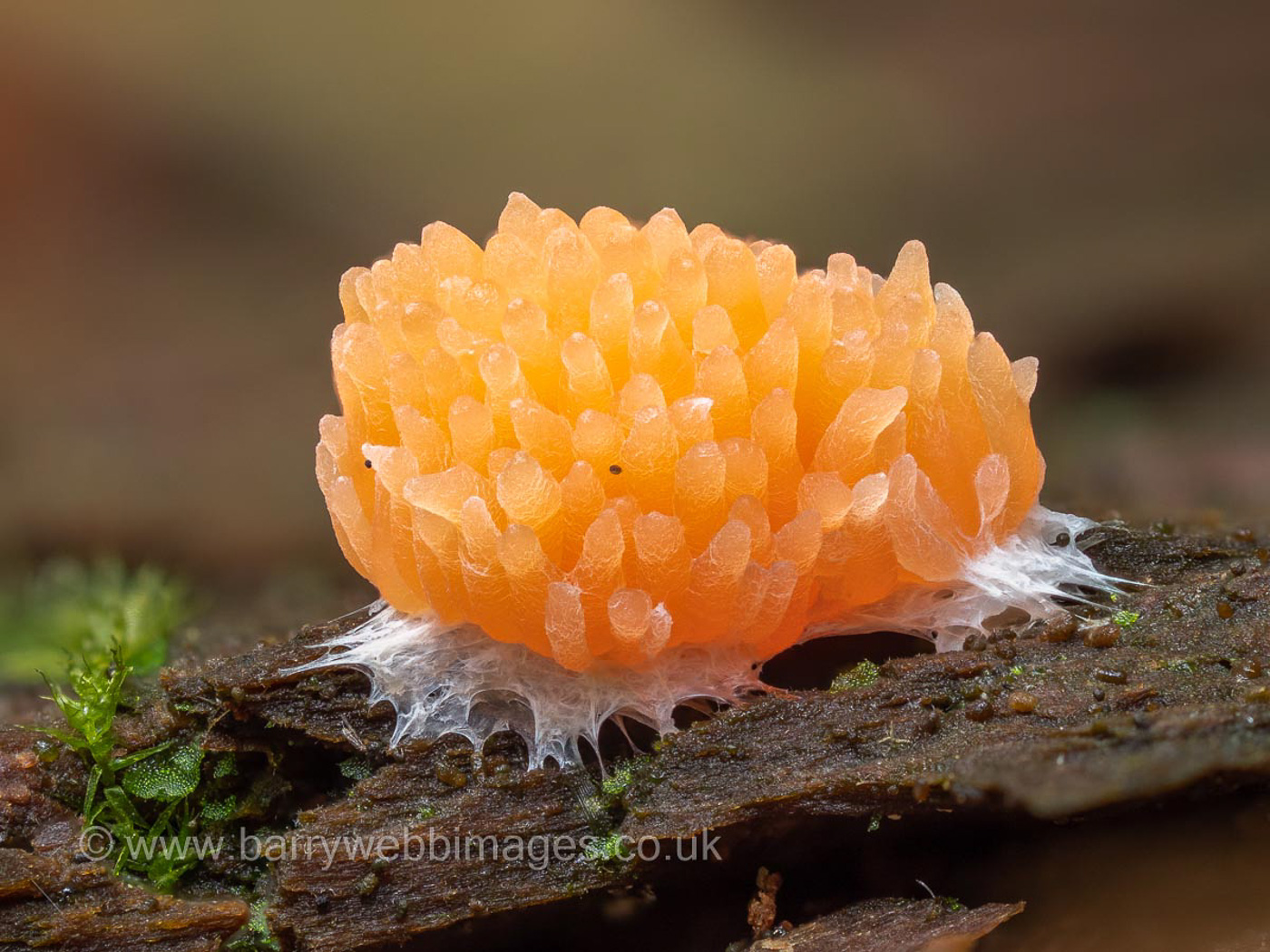
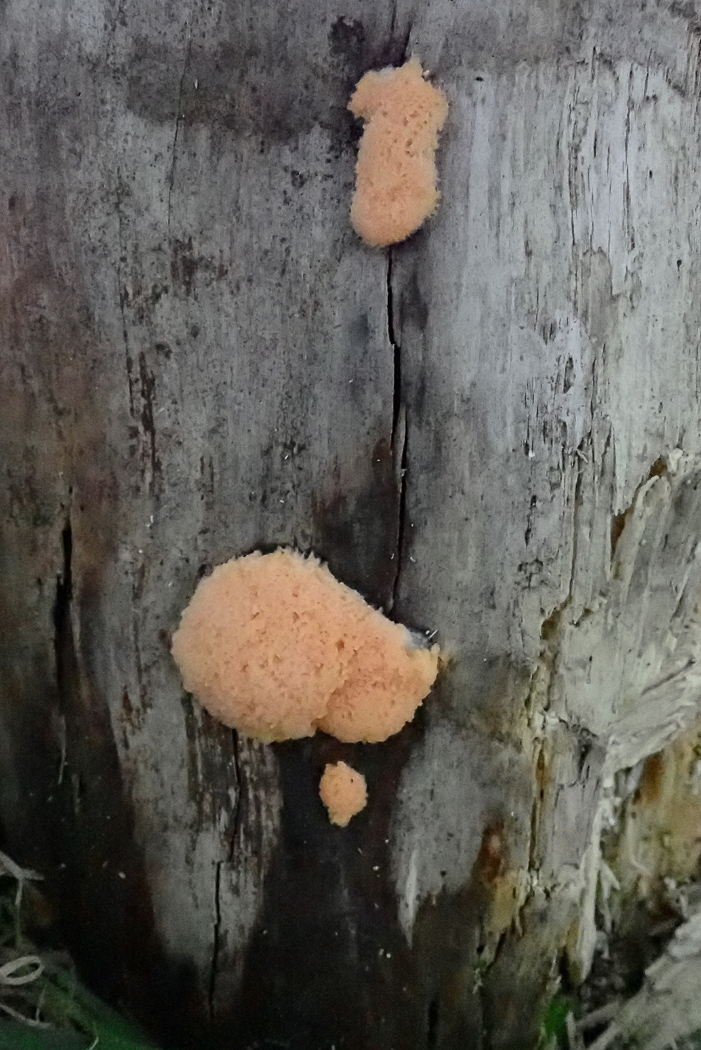
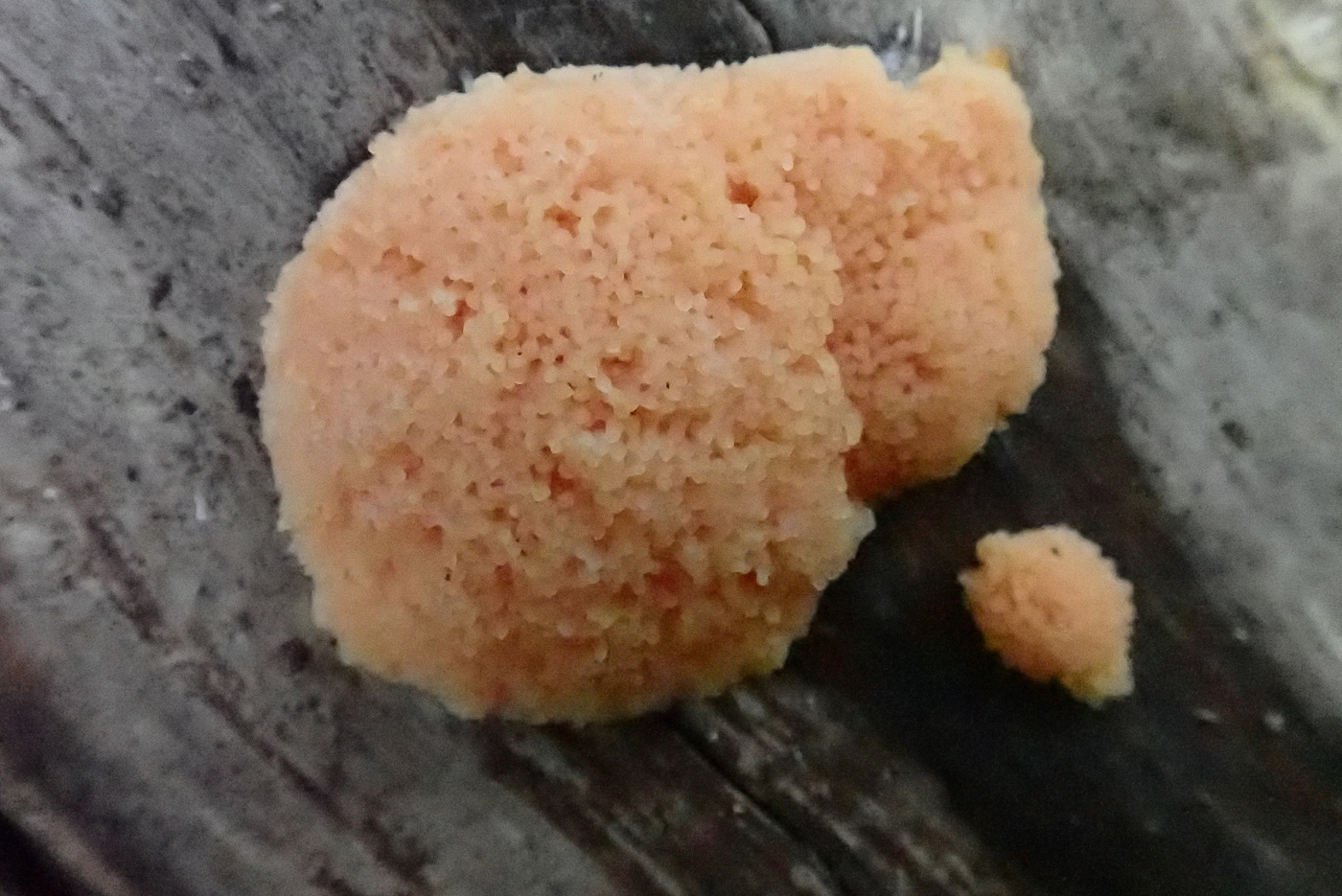 |
Tubifera ferruginosa (Raspberry Slime)
Jul 21, 2023. In Burnham Beeches on fallen damp conifer Gill Ferguson spotted the striking peachy orange immature stage of this quite common Slime Mould, then found that conveniently adjacent to it was a rapidly maturing patch of the same species. This is one of extremely few Slime Moulds which can be identified at this early stage of development, purely through its startlingly bright colour, ranging from orange through to pink - the vast majority of Slime Moulds have white plasmodium - and occurrence on conifer wood. Once mature the dull dark brown is well camouflaged on its woody substrate and much less impressive. (Photo 2 is Barry Webb's).
Jun 13, 2022. On Naphill Common Claire Williams spotted this splodge of pink mess on a rotting log (presumed to be conifer) and tested for sliminess with her finger, recognising what it was. This species surely has to be one of the brightest coloured when at this plasmodium stage - often much more vivid darker pink / orange than this example - but soon dries off and becomes quite boring inconspicuous brown. If you spot an orange / pink patch on Beech, not conifer, you may have Dictydiaethalium plumbeum! See both species in Barry's separate page on Finds.
Sep 13, 2021. In Ivinghoe Common on rotting fallen conifer Barry Webb found this brightly coloured little mound just beginning to develop from the 'red raspberry' mycelium stage when instantly recognisable. The vast majority of slime moulds have white mycelium (the slimy stage), this being one of very few to sport bright orange, peach, pink-red mycelium. Here it can be seen beginning to evolve the closely packed columns which turn brown when mature.
Aug 14, 2021. At the base of a bare Conifer trunk in Penn Street Churchyard Penny noticed these brightly coloured patches of plasmodium - one of the few slime moulds nameable at this stage of its development purely from its distinctive orange / peach colour together with its occurrence on conifer.
|
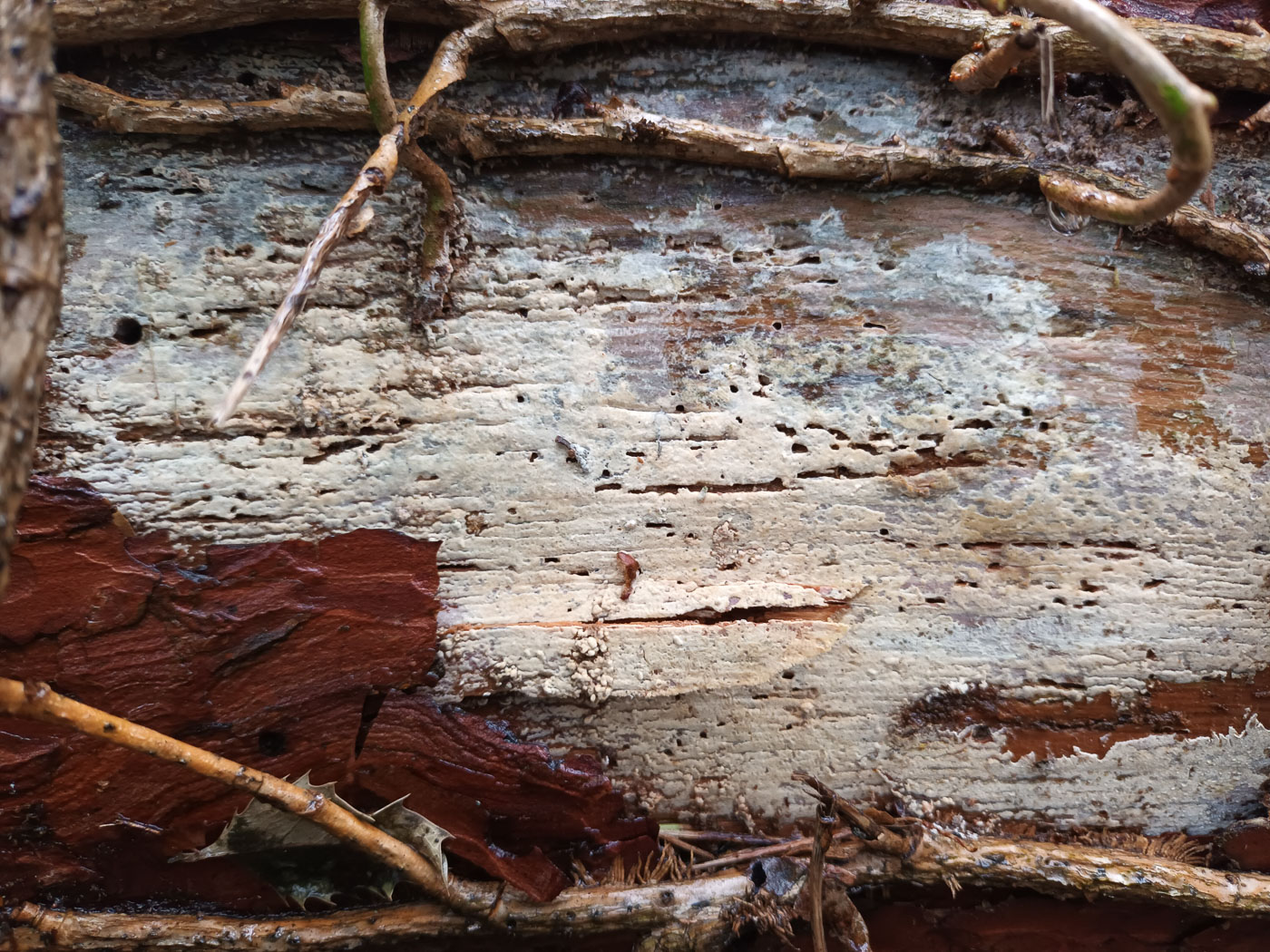 |
Tubulicrinis subulatus (a rare corticioid with no common name) 
Feb 15, 2022. On decorticated fallen Pine in woodland near Chalfont St. Peter Jesper Launder collected this corticioid sample to take home and work on. The microscopic characters were distinctive, leading straight to this genus (which appears superficially very similar to so many other 'white paint' species which frequent fallen wood). Further detective work revealed the species - one for which we have only one previous record made by Kerry Robinson at Burnham Beeches last June, also on conifer with which it is always associated.
|



 |
Tulostoma brumale (Winter Stalk Ball) 
Jan 13, 2024. On an arid gravel bank at Dorney Wetlands Russell Ness spotted these tiny fungi amongst moss, with 25 counted at one spot and a further 11 at another. Each 'head' is less than 1 cm across and spores are puffed out of the central opening when mature in the same way as in puffballs. The species was new to the county from Gerrards Cross in November when found by Jesper Launder, so Russell's find is our second county record.
Nov 8, 2023. In a mossy bank on the edge of a hotel carpark Jesper Launder spotted about ten of these tiny 'Puffballs on a stalk'. The species favours sandy calcareous soils and is apparently widespread though generally uncommon - Penny has only seen it in sand dunes! So this is new to the county and one of three similar species though the other two are extremely rare in the UK.
|





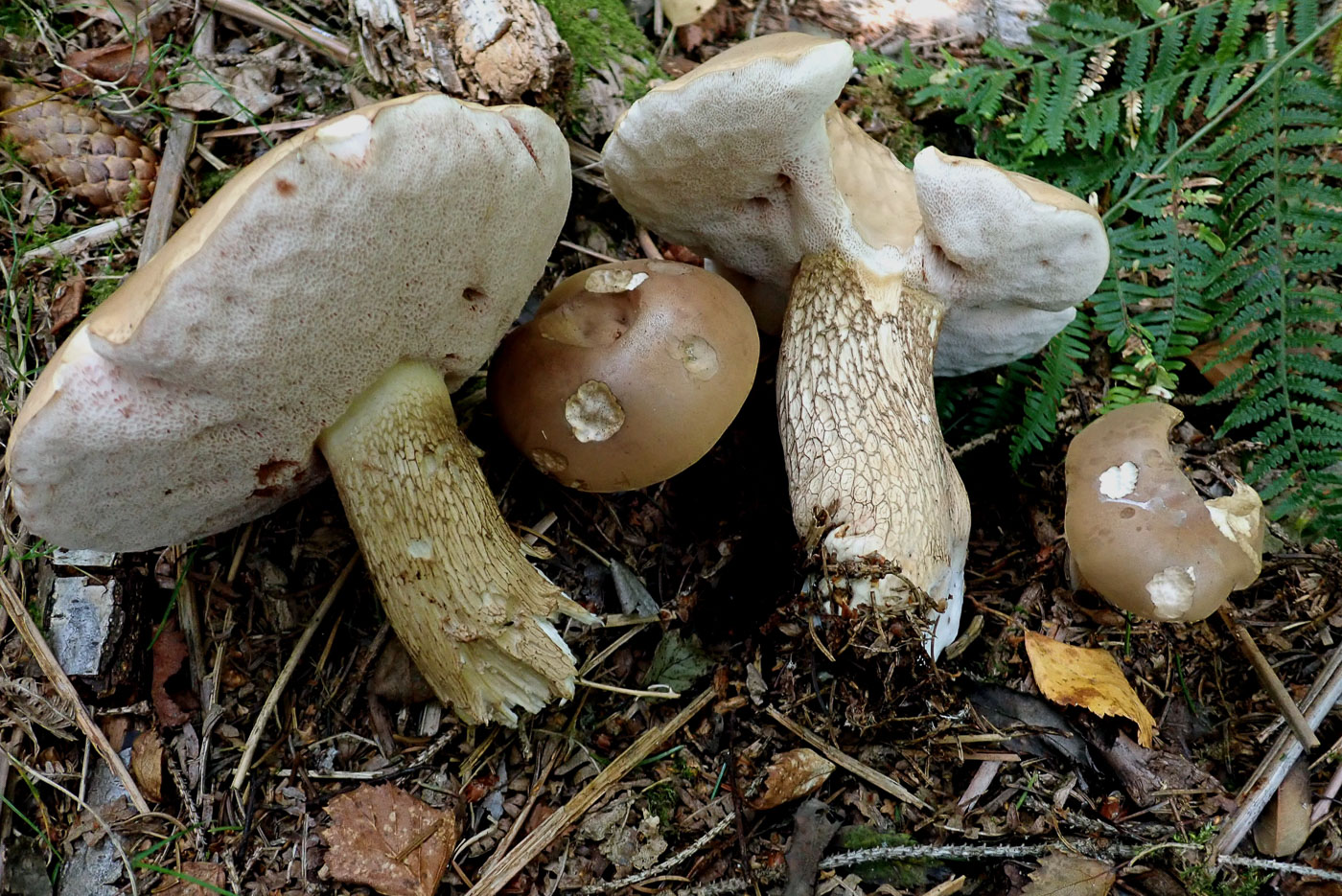
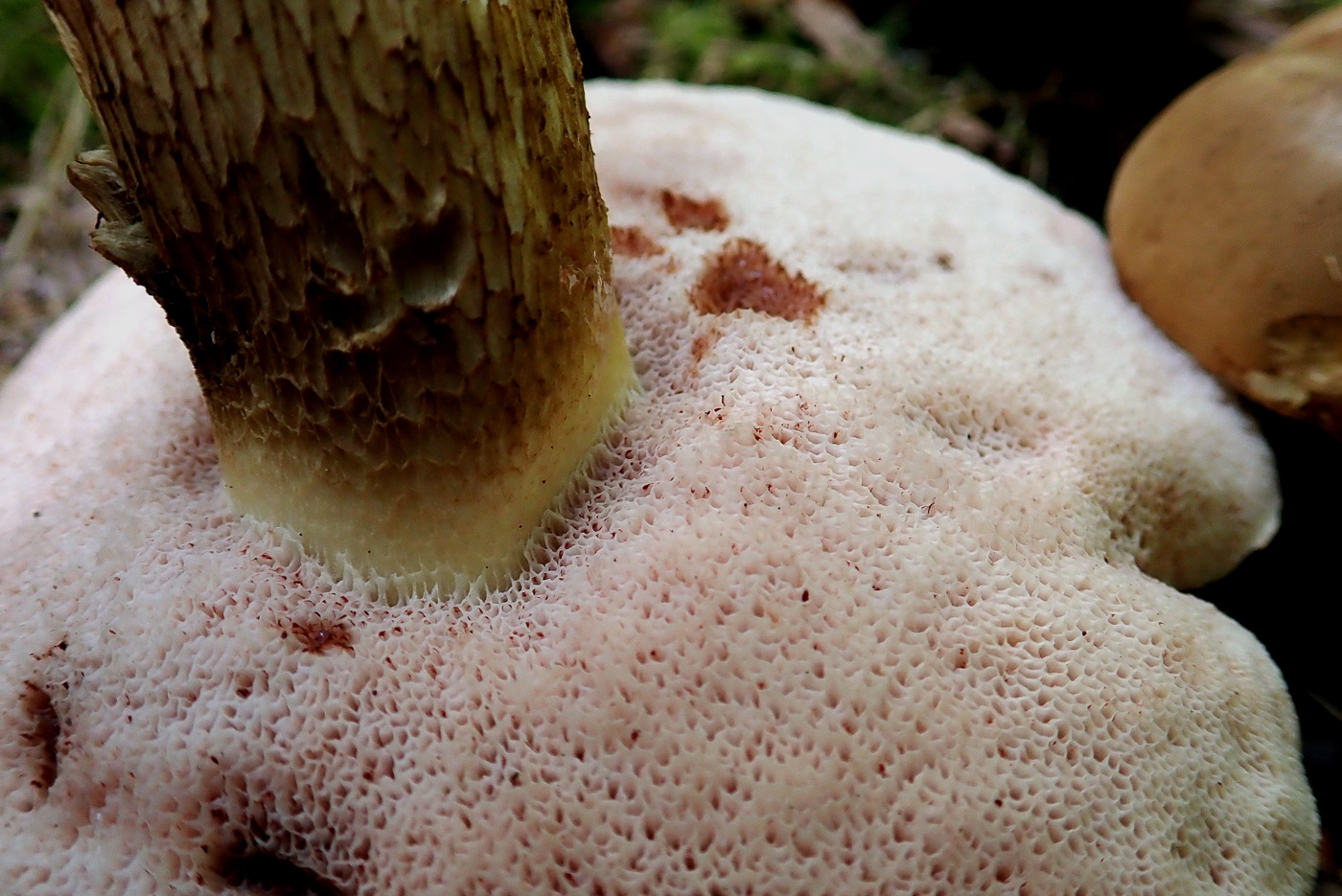
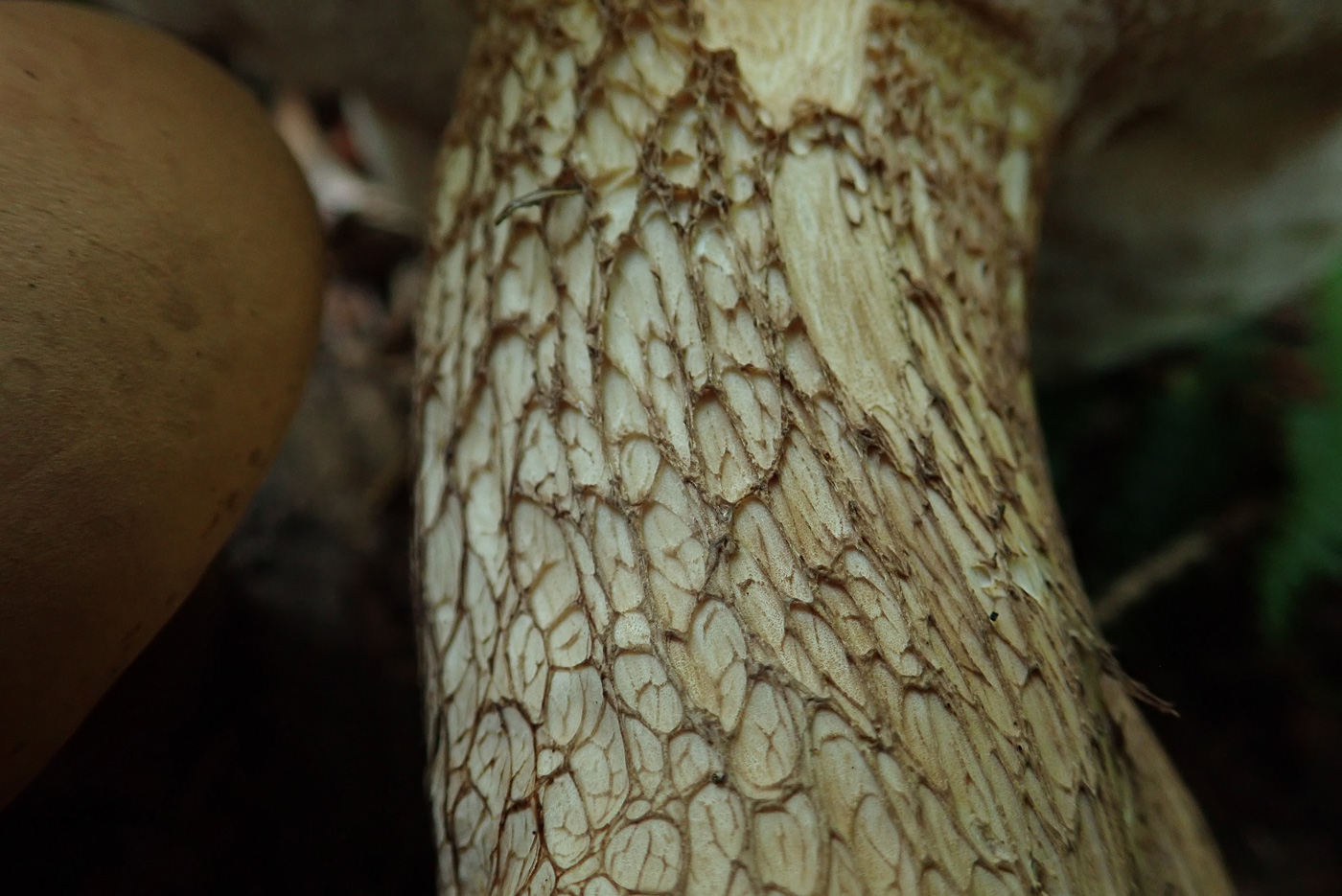
|
Tylopilus felleus (Bitter Bolete) 
Aug 21, 2023. In Bradenham Woods Penny spotted a chunky pale brown mushroom emerging from the base of a mossy Beech trunk, so took photo 1 prior to extricating it to find out what it was. The pink pores and tubes (well nibbled) and pale reticulate stem provided the answer (photo 2). Presumably the rodent nibblers are immune to the very bitter taste of this occasional species and many fungi in this area were really well nibbled today.
Aug 2, 2023. Under Oak in Gerrards Cross Common Jim Wills found this sturdy Bolete which though similar to B. edulis just didn't have the right 'jizz'. At home the pores and tubes soon developed a pink tinge, pointing him to this ID. In confirmation a spore print proved pink and the spores correct for the species which tends to have the clavate stem shape seen here. In some years the species is quite common, occurring under a mix of different trees, in others it is seldom found.
Sep 19, 2020. An occasional bolete, this collection was growing under Douglas Fir in Penn Wood, found by Penny Cullington. On first noticing the large caps, about 13 cm across, she thought she'd found Boletus edulis but turning one over revealed the pores turning a shade of pink, especially where damaged, and the marked reticulation on the stem, both features diagnostic of the Bitter Bolete (which, also unlike B. edulis, has a bitter taste as the name suggests). Though under conifer today, it more often occurs under deciduous trees, especially Beech.
|

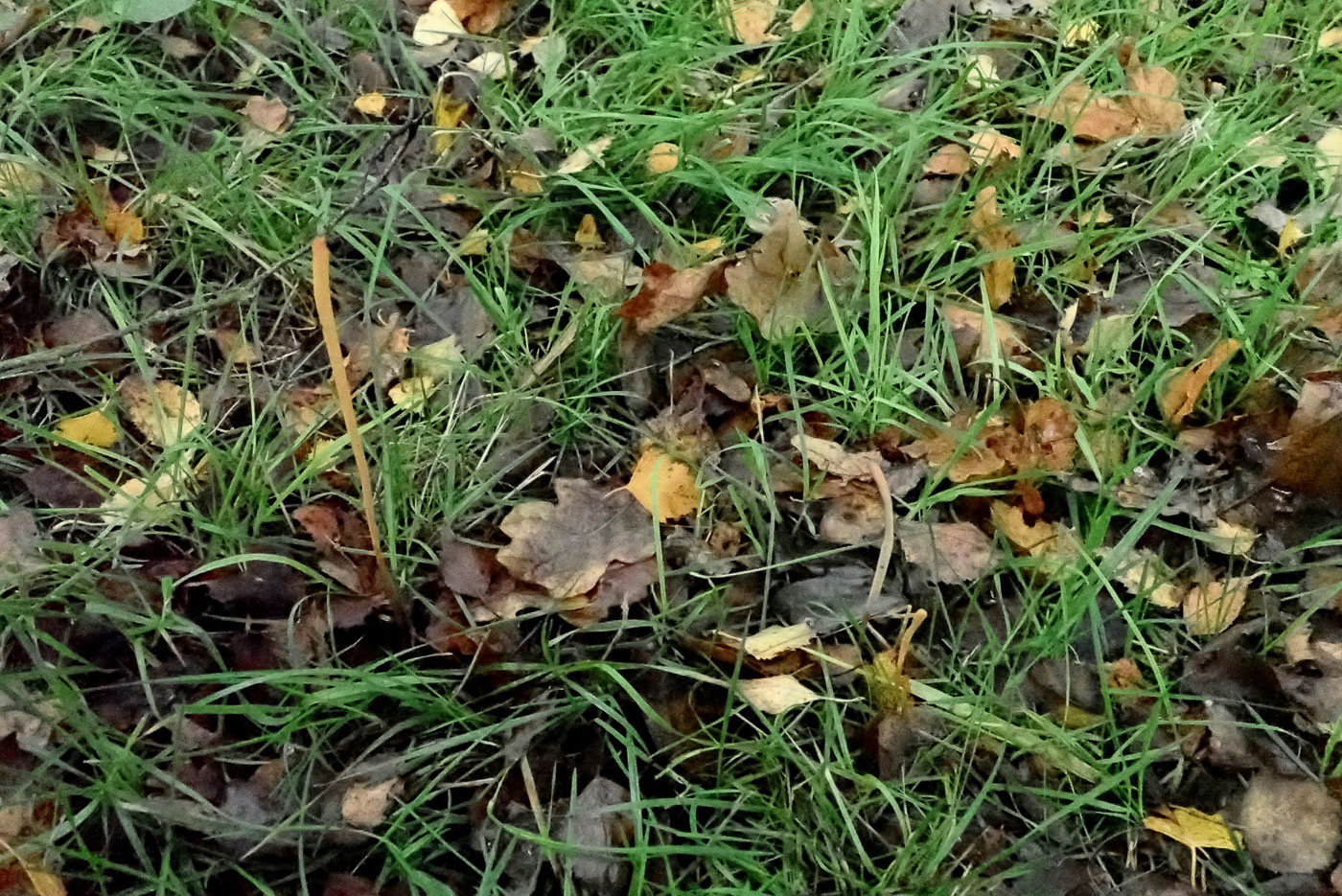
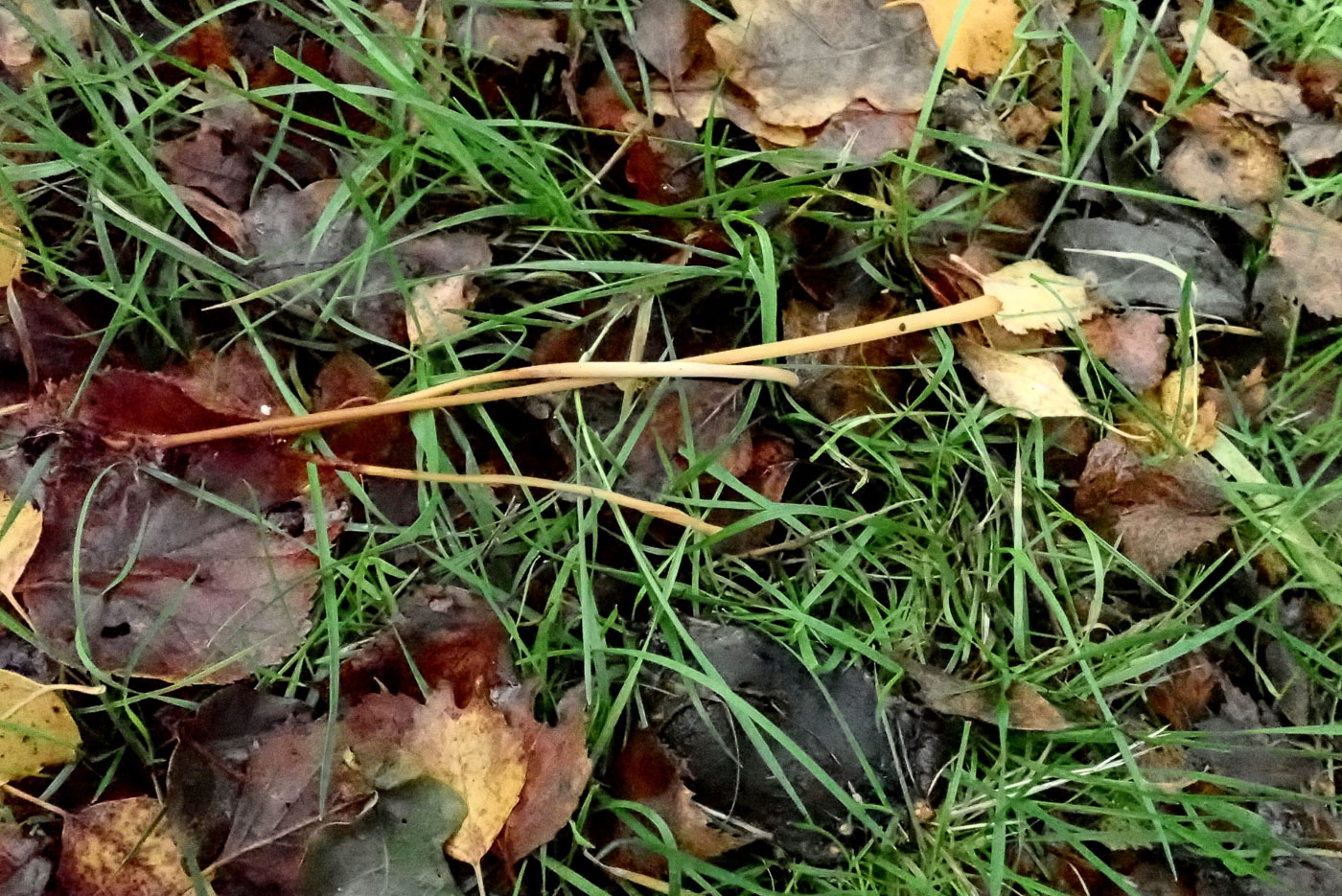 |
Typhula fistulosa (Pipe Club)
Nov 2, 2023. In woodchip under a large Cedar Claire Williams noticed these unusual clubs which though about 10 cm tall are surprisingly difficult to spot.
Nov 13, 2021. At Turville Heath in grass under Birch Penny spotted first one then a couple more of these tall but well camouflaged clubs nearby, the tallest being a good 20 cms high. One would think these would stand out and be easy to spot, but not so! They are probably quite common in woodland litter but are easily missed and therefore not that often recorded.
|
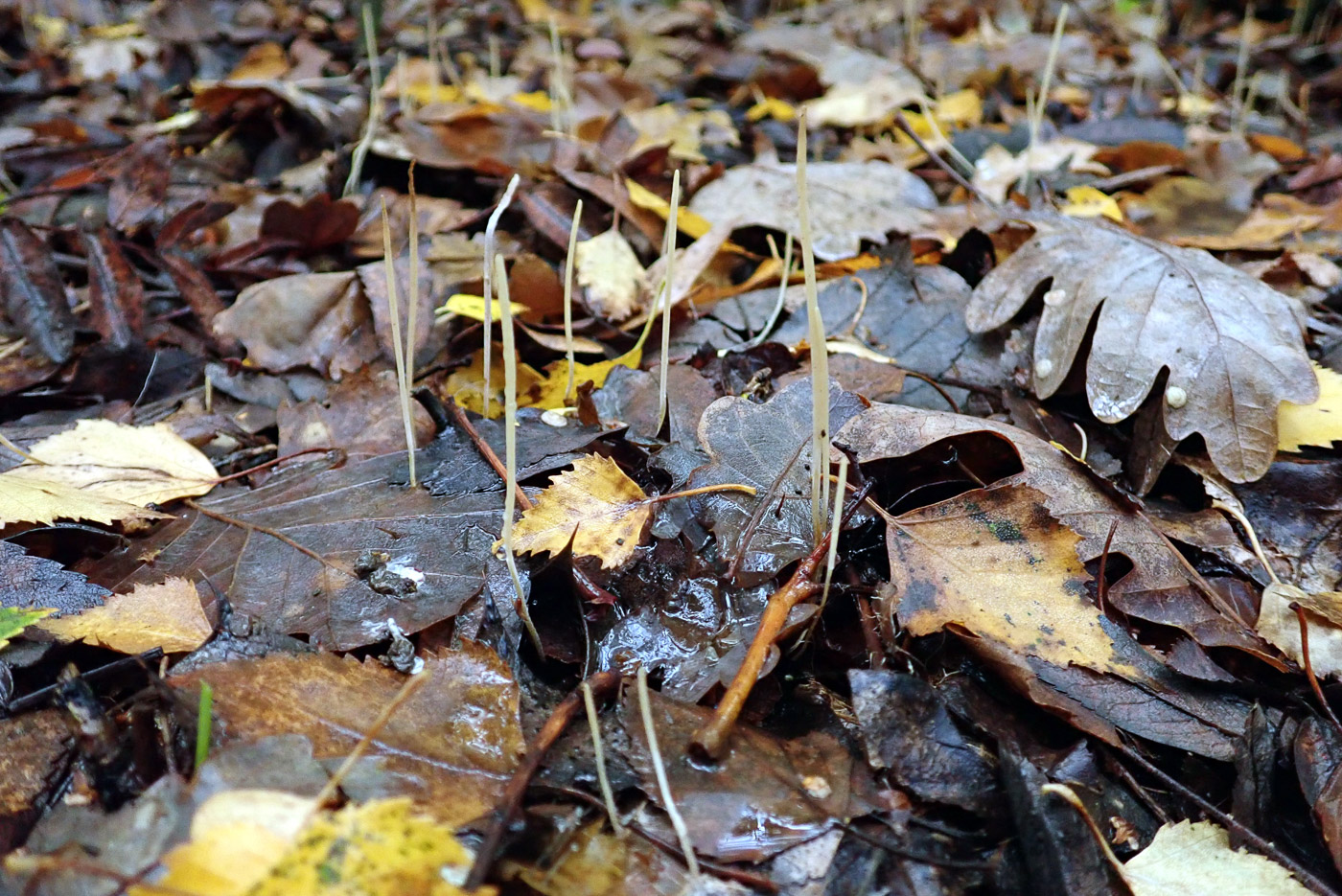
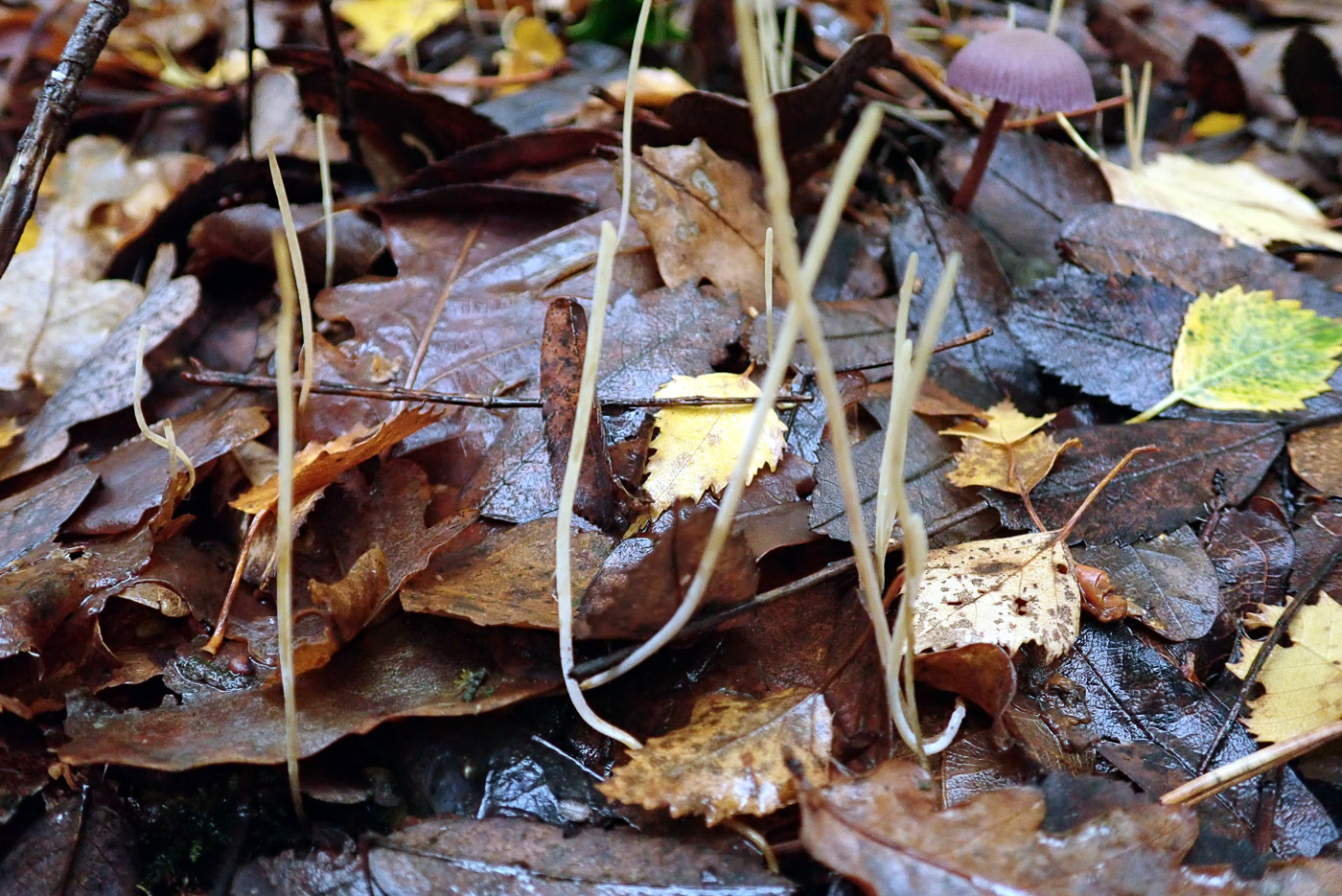 |
Typhula juncea (Slender Club)
Nov 3, 2020. Another species at Burnham Beeches noticed by Penny C. by chance, this was fruiting in good numbers (as is usually the case when one finds it) in general woodland litter. It tends to grow in large troops rather than in tight clusters and fruit bodies are less than 1 cm wide but can get to 12 cms tall. The species name juncea refers to its rushlike growth rather than to any connection with that plant as substrate.
|
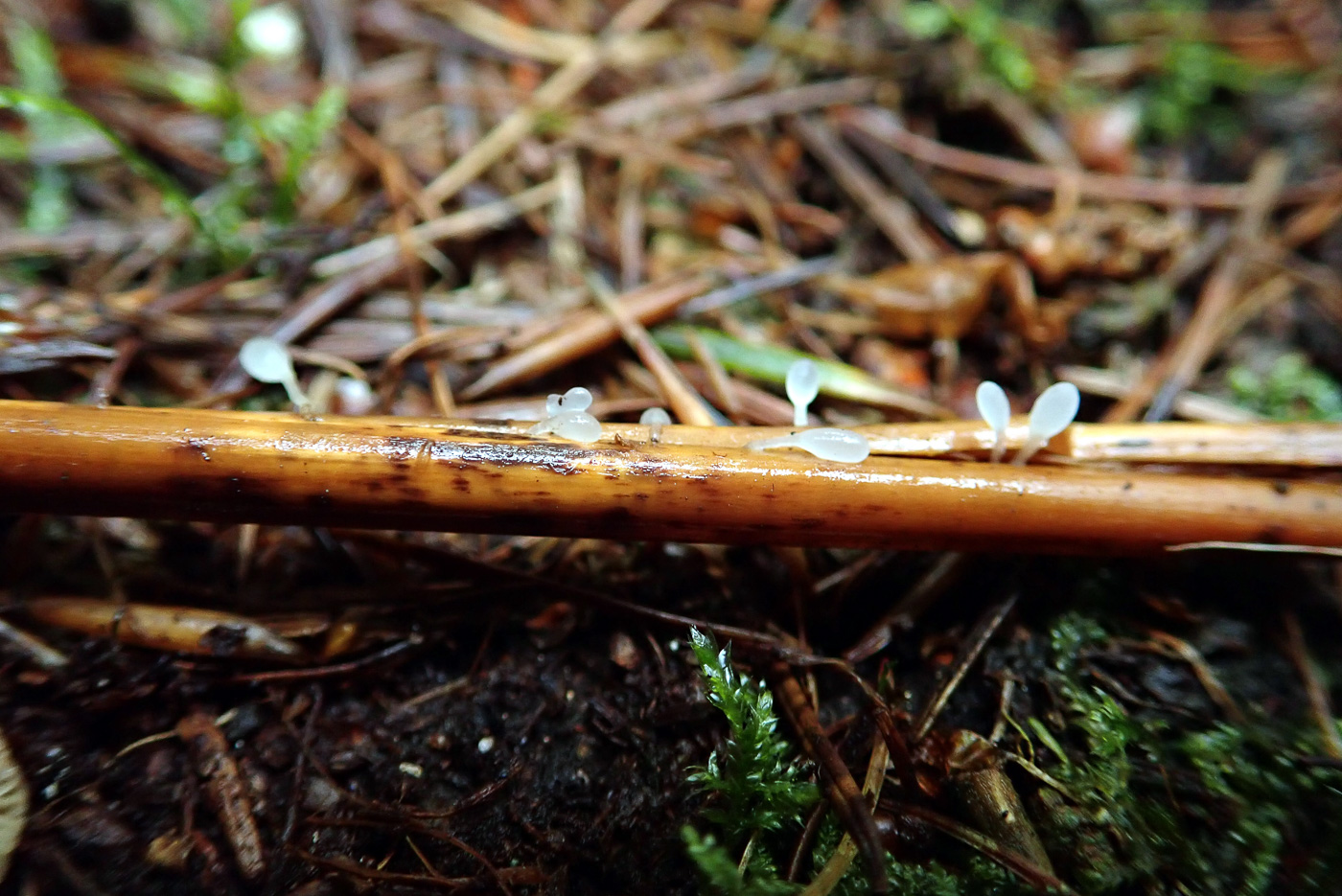
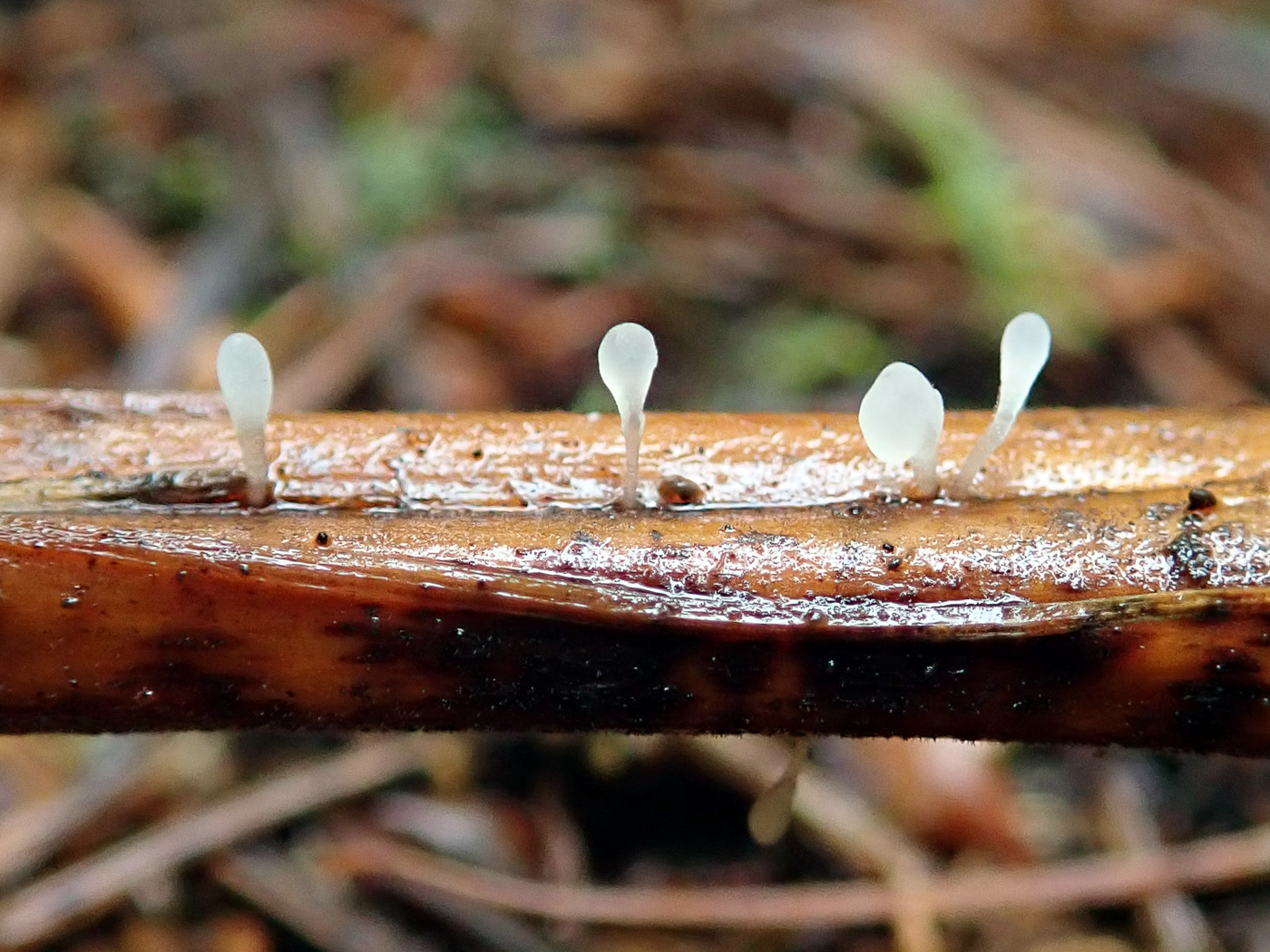 |
Typhula quisquilliaris (Bracken Club)
Oct 5, 2020. Whilst on her knees with her camera Penny Cullington noticed these tiny white stalked fungi on a dead bracken stem. The whole fruit body is under 1 cm tall, about half its height being stem, the top half widening into a clavate swollen head. Not rare but easily overlooked, this species is only found on bracken stems thus is an easy one to name if you can find it!
|

